2010
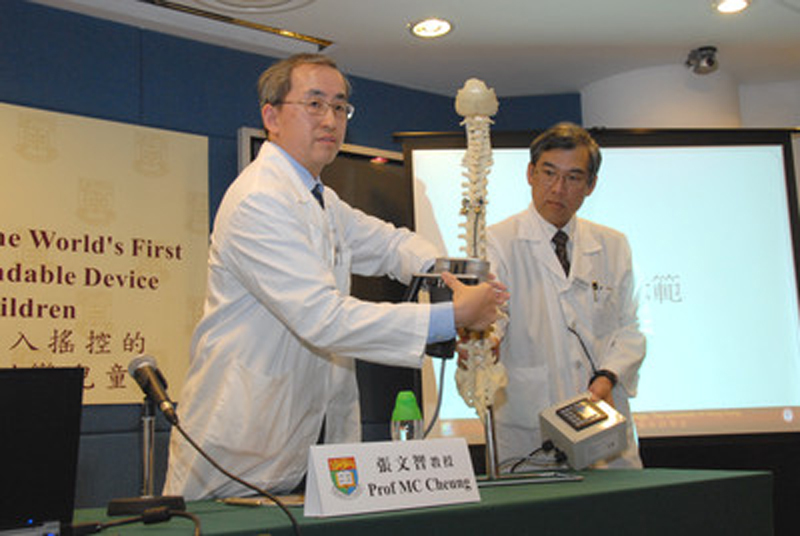
The University of Hong Kong has, for the first time in the world, applied a revolutionary new technology to treat scoliosis in children. The technology was developed in the United States, in which an implanted rod can help straighten a deformed spine, and the rod can be lengthened as necessary by remote control while the child grows. For curves developing progressively in growing children, bracing can help to slow the progression and allow the child to grow before surgery is done. However, the brace needs to be worn the whole day and can result in significant discomfort and changes in body shape. As the child grows, new braces will need to be fabricated every 12 to 18 months.
The new Spinal Bracing and Distraction System comprised of an implantable spinal instrumentation including a rod with a distraction element (actuator), which allows the rod to be lengthened non-invasively by remote control. The actuator is remotely operated and lengthened by use of an external motorized magnet. The rotation of the cylindrical rare earth magnet causes the rod to lengthen thereby further correcting the spinal curvature and allowing the spine to grow. Distraction can be performed at any time over the growth period in order to lengthen the implant to follow natural spinal growth. The distraction can also be decreased as needed with the remote control. The whole distraction process was completed in our patients in less than 30 seconds, with the child fully awake.
Source: HKUMed
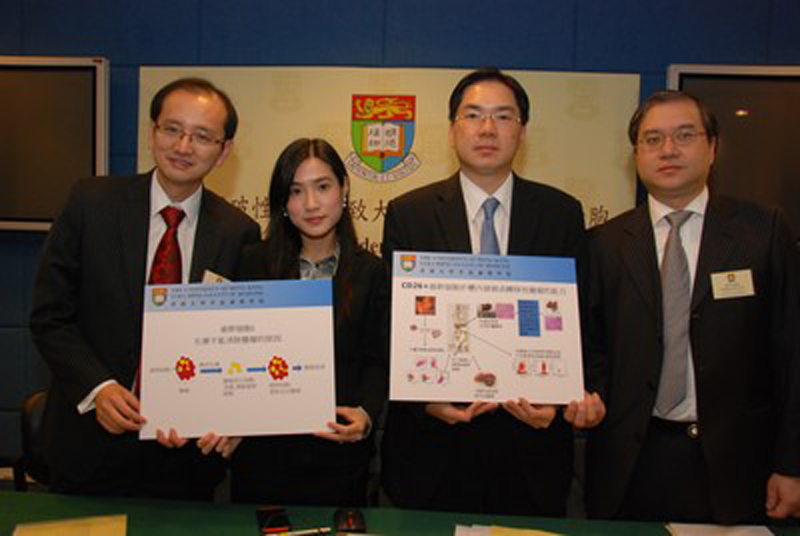
The University of Hong Kong Li Ka Shing Faculty of Medicine has conducted a study on human colorectal cancer that identified for the first time a subset of cancer stem cells (CSCs) responsible for metastasis in human colorectal cancer. Metastasis is the spread of a cancer to distant organs, a stage that leads to ultimate death in most cancer patients. The novel finding of the role of a subset of CSCs in metastasis is an important breakthrough that contributes to better prognostic prediction and treatment of cancer patients in the future. The research is published in “Cell Stem Cell”, the top journal in stem cell research. One of the key researchers, Dr Roberta Pang Wen-chi, Research Assistant Professor of the Department of Medicine, HKU says, “Identification and characterization of this subpopulation of cancer stem cells will enable us to evaluate for different molecular targeting drugs that can specifically target these cells. In the long term, it should facilitate the development of more useful, safe and specific drugs that can be used in combination with chemotherapy to completely eradicate the tumour.”
Source: HKUMed

While Influenza A remains a significant public health challenge, the rising of antiviral resistance in influenza virus making many drugs not working well leads to a even bigger threat to mankind. A research team at The University of Hong Kong achieved a groundbreaking discovery that an important viral structural protein, influenza nucleoprotein (NP), can be used as a target to kill influenza virus (including H1N1, H3N2 and H5N1). This is the first time that the research work from HKSAR led by local researchers is published in Nature Biotechnology, the top journal in this field, recognizing the capability and potential of Hong Kong as a key contributor in biotechnology and drug discovery.
Source: The University of Hong Kong

The University of Hong Kong Li Ka Shing Faculty of Medicine and Queen Mary Hospital have partnered with the National Cancer Institute of the United States to conduct a clinical study on liver cancer patients treated with thermosensitive liposomal-encapsulated doxorubicin combined with radiofrequency ablation (RFA) recently. Twenty four liver cancer patients (primary, n=9; secondary, n=15) have been treated with this novel technology of chemotherapy globally. Thermosensitive liposomal-encapsulated doxorubicin can be safely administered systemically in combination with RFA. The toxicity was limited and manageable.
Source: HKUMed

A research team at the Department of Medicine, The University of Hong Kong Li Ka Shing Faculty of Medicine and Queen Marry Hospital (QMH) has spent a decade developing oral arsenic trioxide from a research project to a prescription medication that has secured a US patent. For the first time, a drug developed entirely in Hong Kong is poised to attain global status as a prescription medication. More than a hundred leukaemia patients in Hong Kong have been treated, the majority being cured by this novel drug. The work has been done by a small team of medical researchers, with the achievement based on ingenuity, meticulous work and diligence – a typical Hong Kong success story of innovation. This work is a historic landmark in medicine in Hong Kong.
The team has shown oral arsenic to be a safe drug. With appropriate dosing, the potential toxic effects of arsenic, particularly toxicity to the heart, have been overcome. Oral arsenic has been shown to be highly active in acute promyelocytic leukaemia, and has now become a standard in the initial treatment of some patients, in the continuous treatment of patients in remission, and for patients in relapse. More than 100 patients have since been treated, with excellent results. The use of oral arsenic has replaced bone marrow transplantation as the standard treatment for these patients. Oral arsenic has also been used in the treatment of other blood cancers, including lymphomas and myeloma.
Source: The University of Hong Kong
Researchers from The University of Hong Kong published a research on the pandemic H1N1 virus. Researchers compared the ability of the pandemic H1N1 virus, the seasonal H1N1 and H3N2 influenza viruses to replicate in cells and tissue samples from the human upper and lower respiratory tract and the conjunctiva (the cells lining the surface of the eye). It was found that the pandemic H1N1 virus is more efficient than seasonal influenza H1N1 or H3N2 viruses in infecting the conjunctival surfaces of the eye, apart from infecting humans via the respiratory tract. The findings from the HKU researchers indicate that the pandemic H1N1 virus differs from seasonal influenza viruses in subtle ways and these differences may explain why the pattern of illness it causes is not identical to that caused by seasonal influenza.
Source: HKUMed
2011

Scientists at The University of Hong Kong Li Ka Shing Faculty of Medicine have taken stem cell research a few steps closer to the clinic in 2010. The team of cardiologists and scientists has successfully generated new human induced pluripotent stem cells (hiPSCs) that are free from animal products. These new hiPSCs were then used to derive different human cell types and tissues to study the potential clinical applications of stem cell therapy for treatment of critical limb ischemia – a major cause of limb amputation in elderly, as well as modeling of human genetic diseases which cause juvenile onset of ageing, such as progeria. The same technology and strategy can also be applied to more commonly encountered diseases like neurodegeneration and heart failure to provide insights into the disease development; and more importantly lead to clues for developing new therapeutic strategies, such as stem cell therapy.
Source: The University of Hong Kong
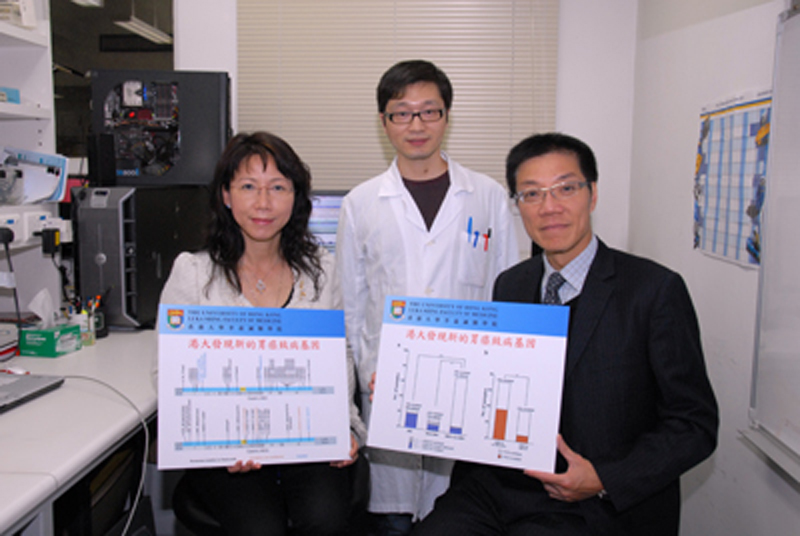
In Hong Kong, stomach cancer is the 6th most common cancer and 4th most common cause of cancer death, with over 1000 new cases and over 600 deaths recorded yearly. Cancer developed due to mutation accumulating in the DNA of stomach cells that turn it into a malignant cell. However, it is not previously known how many mutations are needed to turn a normal stomach cell into cancer. Researchers at the Department of Pathology of The University of Hong Kong Li Ka Shing Faculty of Medicine conducted a research recently, which utilized the most advanced genomic technology to unveil all gene mutations in stomach cancers and discovered a frequently mutated cancer causing gene. The research team discovered 20 stomach cancer driver genes including one, known as ARID1A, which is found mutated in 70 to 80% of specific stomach cancer subtypes.
The study by deciphering all mutations that can happen in a stomach cancer improved our understanding of how cancer develop and may provide ways for early detection and personalized treatment. Moreover, the discovery of stomach cancer driver genes provides a rich resource for development of new drugs to treat stomach cancer. The frequent mutation of chromatin modification genes including ARID1A provides opportunities to treat stomach cancer by using drugs to modulate chromatin architecture.
Source: The University of Hong Kong

The University of Hong Kong Li Ka Shing Faculty of Medicine has conducted a study on liver cancer that identified for the first time a subset of Cancer Stem Cells (CSCs) is responsible for chemoresistance, metastasis and tumour recurrence in liver cancer. Clinical data of this study shows that liver cancer patients whose tumours had high CD24+ expression had a significantly high risk of tumour recurrence and metastasis, and the survival rate of these patients is much lower. The study also finds that CD24+ maintains self-renewal of CSCs and forms tumours through activating STAT3 signals, as such, the researchers believe that through inhibiting STAT3 could control the growth of tumour and achieve better clinical outcomes for liver cancer patients.. The novel finding provides important breakthrough for understanding tumour progression and treatment of cancer patients in the future.
Source: The University of Hong Kong
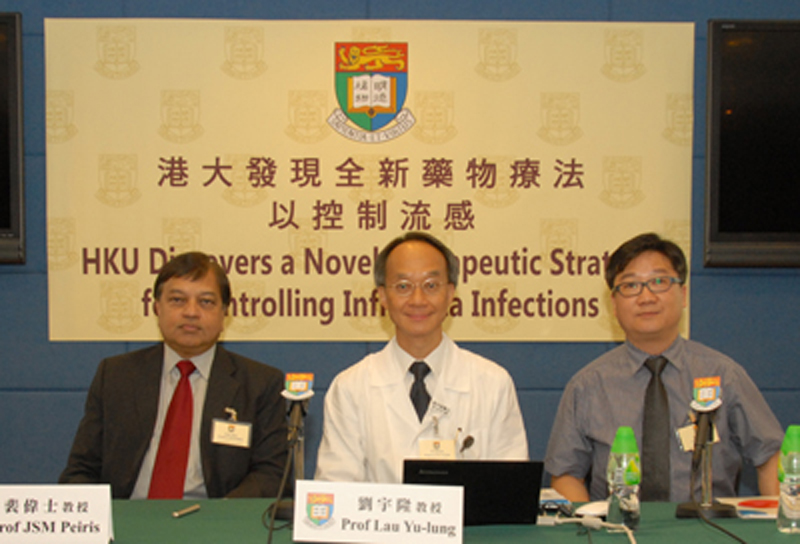
Researchers at The University of Hong Kong (HKU) Li Ka Shing Faculty of Medicine discovers that pamidronate, a drug well established for treatment of bone diseases, can effectively control influenza diseases caused by seasonal, pandemic H1N1 or avian H5N1 influenza virus by boosting one of the first line of the host immune defense, i.e. human gamma-delta T cell (γδ-T cell) immunity.
Firstly pamidronate has been commonly used for the treatment of osteoporosis and Paget’s disease for over 20 years and is known to be safe. Therefore, this "new application of an old drug" potentially offers a ready and cost-effective solution to influenza virus infections. Secondly, studies in animals may not always reflect the situation in humans and therefore it may not be possible to directly translate biomedical findings from animals to humans. But HKU used the "humanized mouse" model in this study which has reduced the gap between the mice and humans and provided a powerful and low-cost platform for preclinical study of drugs such as pamidronate.
Source: The University of Hong Kong
.jpg)
The AIDS Institute of The University of Hong Kong Li Ka Shing Faculty of Medicine collaborated with the Chinese Academy of Medical Sciences (CAMS), Tsinghua University and Tulane University to answer this question through adopting the HIV/AIDS research methodology. After several years of research, they found the epithelial cells lining the salivary gland ducts are the early target cells of SARS-CoV infection in the upper respiratory tract. These early target cells could be a significant source of viral replication and spread to other areas of the respiratory tract within 48 hours after infection.
This finding provides a clearer picture in understanding the mechanism of SARS early infection and transmission. On the other hand, the study also provides solid ground for applying the HIV/AIDS research methodology to the study of other viruses, allowing scientists to simulate the spread of SARS or other viruses alike, such as other coronavirus and highly pathogenic influenza viruses, in the upper respiratory tract in a more effective and accurate way. The study indeed has important implications for developing strategies for early diagnosis, prevention and therapy.
Source: The University of Hong Kong
Treatment using the convalescent plasma from donors who recovered from the swine flu can reduce the mortality rate from severe cases, researchers from the Infectious Diseases and Microbiology team, headed by Professor Yuen Kwok-yung, Henry Fok Professor in Infectious Diseases, Head of the Department of Microbiology and Dr Ivan Hung Fan-ngai, Clinical Assistant Professor of the Department of Medicine, The University of Hong Kong Li Ka Shing Faculty of Medicine have found.
In order to treat the severe cases, a prospective cohort study was conducted by recruiting adult patients with severe pandemic H1N1 2009 infection requiring intensive care and offering treatment with convalescent plasma with a neutralizing antibody titer of ≥ 1:160, harvested by plasmapheresis from the Red Cross Transfusion Service, from donors who recovered from the pandemic H1N1 2009 infection. The patients were divided into treatment and control (non-treatment) groups which were matched by age, sex, and disease severity scores (20 patients vs. 73 patients). Mortality in the treatment group was significantly lower than in the control group (20.0% vs. 54.8%; P<0.01). The study also demonstrated that plasma treatment significantly lowered the day 3-7 respiratory tract viral load and cytokine level when compared with the control group (P<0.05) In conclusion, this study has demonstrated that convalescent plasma treatment is crucial for patients with severe H1N1 2009 infection. The treatment effectively reduced the viral load and dampened the cytokine response with reduced mortality. It also overcomes the problems of emergence of resistant strains and late presenters.
Source: The University of Hong Kong
2012

The Department of Surgery of The University of Hong Kong Li Ka Shing Faculty of Medicine has recently conducted the world’s first genome-wide study of hepatitis B virus integration in liver cancer, which unveils recurrent integration sites in human genome and genetic mechanisms by which liver cancer is induced. The researchers observed that integration of hepatitis B virus genes into human genome is much more frequent in the tumors (86.4%) than in adjacent liver tissues (30.7%). Also, they identified a special region of the viral genome where it is cleaved and integrated into the human genome. Furthermore, three human genes were found to be the recurrent sites of viral integration.
Surgical resection is the best curative therapy for primary liver cancer, with a 5-year patient survival rate of approximately 55%. However, more than 50% of patients will develop new tumors in the rest of the liver after resection of the original tumor. Use of drugs to suppress hepatitis B virus replication may slightly reduce the recurrence rate but currently there is no effective therapy to prevent the development of such new tumors. Targeting the mechanisms identified in this study could lead to the development of novel therapeutic agents that interfere with hepatitis B virus integration into the host genome, thereby preventing cancer recurrence.
Source: The University of Hong Kong

A study conducted by researchers from The University of Hong Kong Li Ka Shing Faculty of Medicine found that aspirin given for the treatment of cardiovascular diseases in Chinese patients with previous ICH did not increase the risk of recurrent ICH. Furthermore, its use reduced the overall incidence of subsequent stroke and heart attack. The findings provide important insight for doctors faced with the treatment dilemma, and may change their prescribing practice.
The result reveals that aspirin use is not noted to be a risk factor of developing a recurrent ICH. Aspirin is protective against ischemic events and clinicians should consider prescribing aspirin to patients with standard indications despite a history of ICH.
Source: The University of Hong Kong
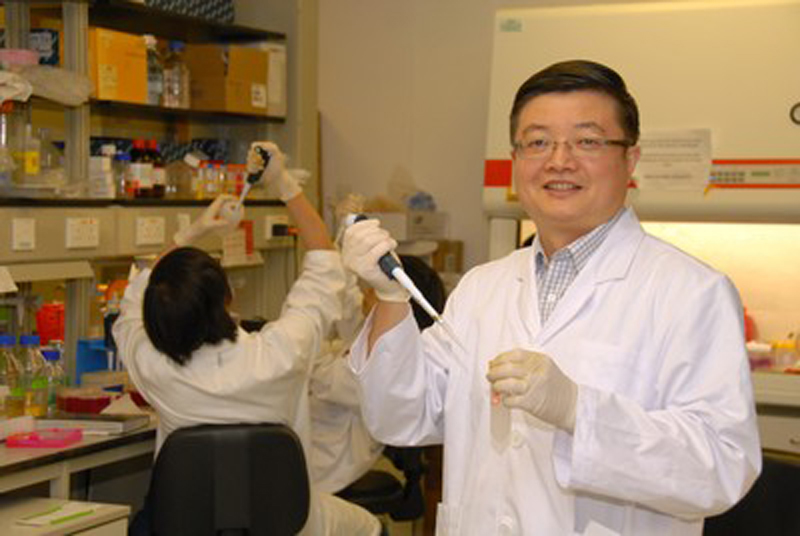
AIDS Institute of The University of Hong Kong Li Ka Shing Faculty of Medicine discovers a novel molecular mechanism of a potent anti-HIV CCR5 antagonist TD-0680 in close collaboration with Shanghai Targetdrug Co. Ltd, Nanjing University and City University of Hong Kong. This drug candidate is potent against a clinical CCR5 antagonist-resistant HIV-1, and is an attractive candidate drug for preventing HIV-1 sexual transmission once developed as a topical microbicide gel.
The discovery of the mechanism and potency of TD-0680 may not only be developed as a therapy for treating AIDS patients, but may also be used to prevent HIV sexual transmission after being formulated into vaginal or rectal microbicide gels, therefore giving people an alternative method to protect themselves from the virus, in addition to condoms.
Source: The University of Hong Kong
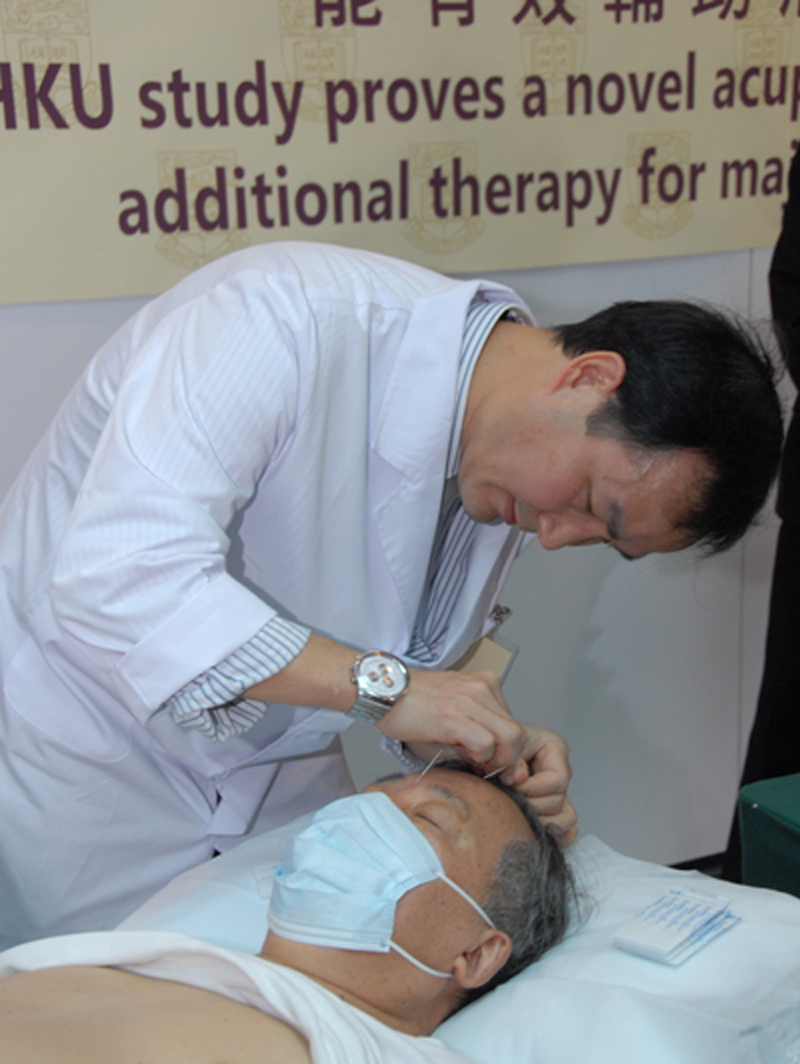
School of Chinese Medicine at The University of Hong Kong Li Ka Shing Faculty of Medicine and the Department of Psychiatry in Kowloon Hospital have completed a clinical randomised controlled trial of a novel acupuncture "dense cranial electroacupuncture stimulation (DCEAS)" in patients with MDD. The results of the study have demonstrated that DCEAS can rapidly reduce the severity of depressive symptoms, providing an additional option for depressed patients.
This clinical study was the first to apply rigorous randomised controlled design to examine the effectiveness of DCEAS. The results suggested that DCEAS is safe and effective, which can be considered as an additional treatment for depressed patients in order to achieve better clinical outcomes.
Source: The University of Hong Kong
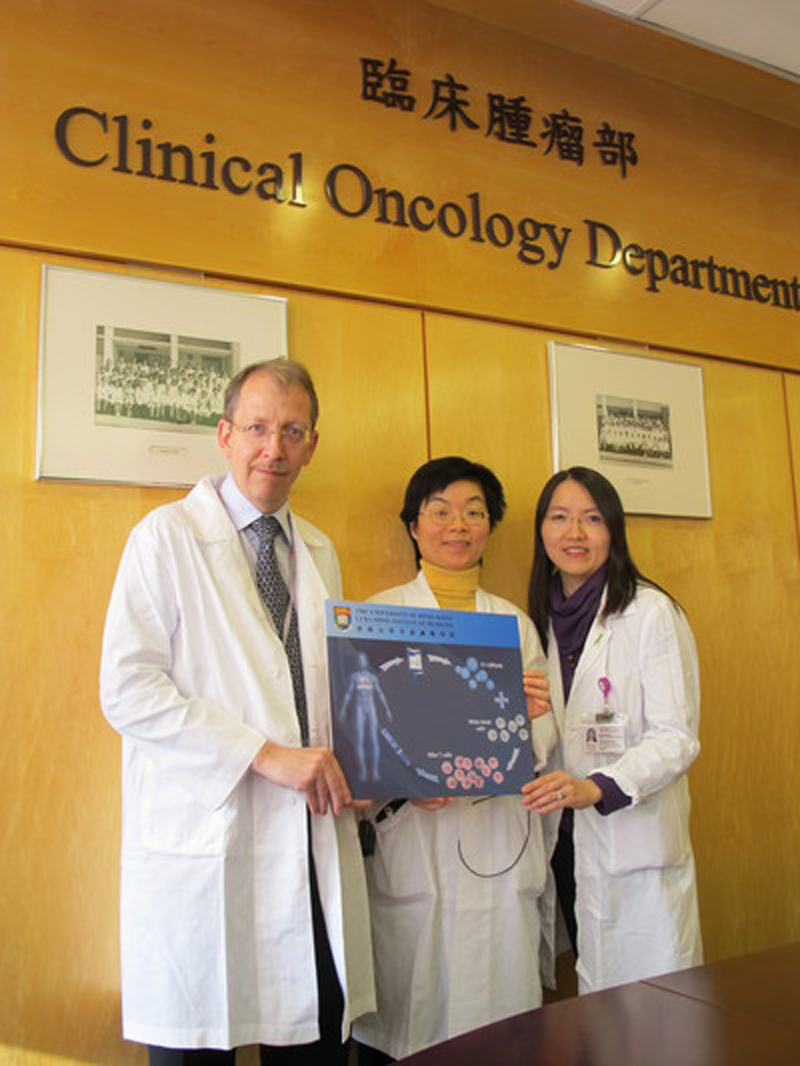
The accumulation of 10 years of collaborative research between scientists from The University of Hong Kong Li Ka Shing Faculty of Medicine and the Australian Centre for Vaccine Development at the Queensland Institute of Medical Research (QIMR) has led to a significant breakthrough in the treatment of nasopharyngeal carcinoma (NPC), an aggressive Head and Neck cancer with a high prevalence in Hong Kong. By offering targeted immune treatment, the team was able to increase the median time of patient survival from 200 to over 500 days in the phase I study, which is an encouraging result.
This is a phase I study examining the safety and tolerability of the adoptive immunotherapy (T-cell infusion) on recurrent and metastatic NPC patients, and is a joint project between the HKU and the QIMR researchers. Dr Janice Tsang Wing-hang, Clinical Assistant Professor in the Department of Clinical Oncology reported that the results of this study showed that the treatment was well-tolerated by the patients without much side effects and by enhancing the immune cells of the NPC patients, this has doubled the overall survival time of the late-stage NPC patients.
Source: The University of Hong Kong
2013
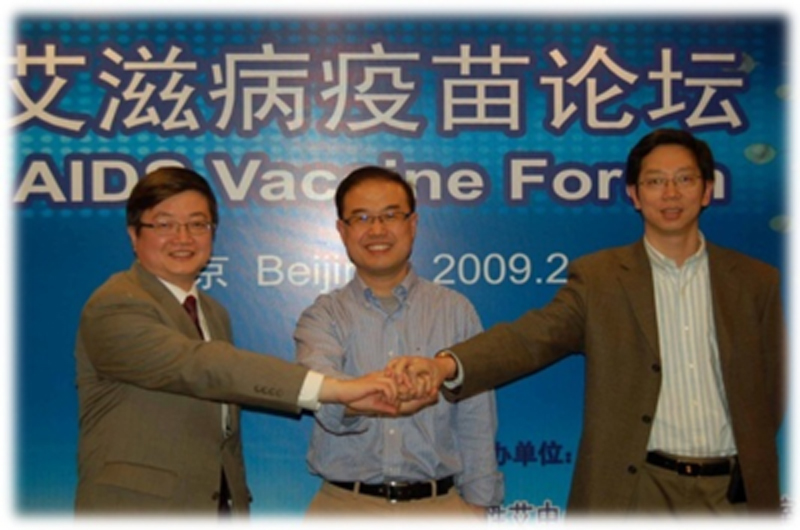
A collaborative team co-led by the AIDS Institute of the University of Hong Kong Li Ka Shing Faculty of Medicine, the Guangzhou Institute of Biomedicine and Health of Chinese Academy of Sciences and the Comprehensive AIDS Research Center of Tsinghua University has conducted a preclinical study of a novel AIDS mucosal vaccine strategy. The team discovers that the new strategy elicits high levels of HIV-specific T-cell and B-cell immunity in a monkey model system, which suppressed viral transmission and replication significantly, and delayed AIDS onsets in all rhesus monkeys vaccinated by the new strategy after pathogenic viral challenge.
During the five-year study, the team divides Chinese Rhesus monkeys into three experimental and two control groups. The novel vaccination strategy is conducted by an oral and intranasal prime with a replicating vaccinia Tiantan MVTT and followed by an intramuscular boost with a non-replicating Ad5. The result shows that the novel vaccination strategy is safe in all Chinese Rhesus monkeys. All monkeys vaccinated with the new strategy are clinical healthy. The protective effects correlated with the vaccine-induced immunity. This study hence provides a novel strategy to develop HIV vaccine by using the combination of replicating vaccinia vector and mucosal priming.
Source: The University of Hong Kong
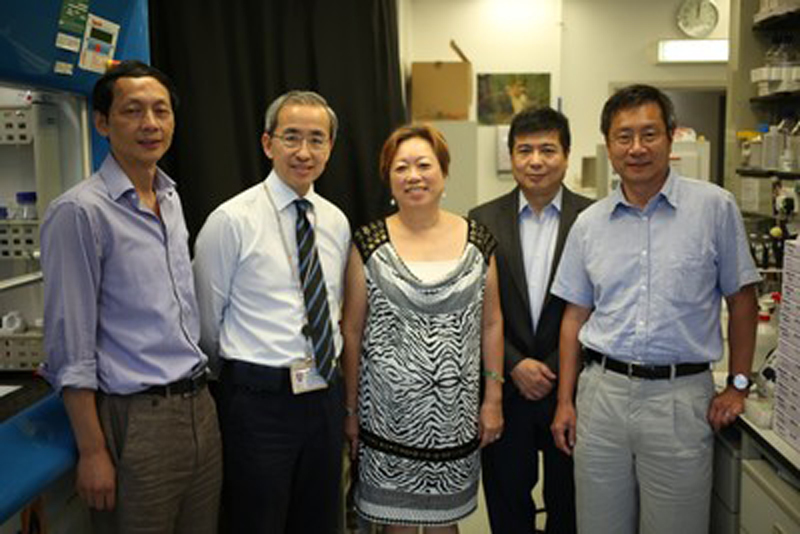
HKU scientists and clinicians announce the results of a large-scale international study with more than 4000 sample subjects in Hong Kong, Northern China, Japan and Finland, with the discovery of a new genetic variant with an enzyme called “carbohydrate sulfotransferase 3 (CHST3) associated with an increased risk to develop lumbar disc degeneration (LDD).
To take advantage of this prominent result, the research team will further perform bigger genome-wide studies and whole genome sequencing of LDD patients, aiming to “track down” more susceptibility genes as the next step. With a clear understanding of the genetic risk factors, the investigators are hopeful that their finding will help in the formulation of preventive measures, and the development of therapeutic interventions and treatments.
Source: The University of Hong Kong
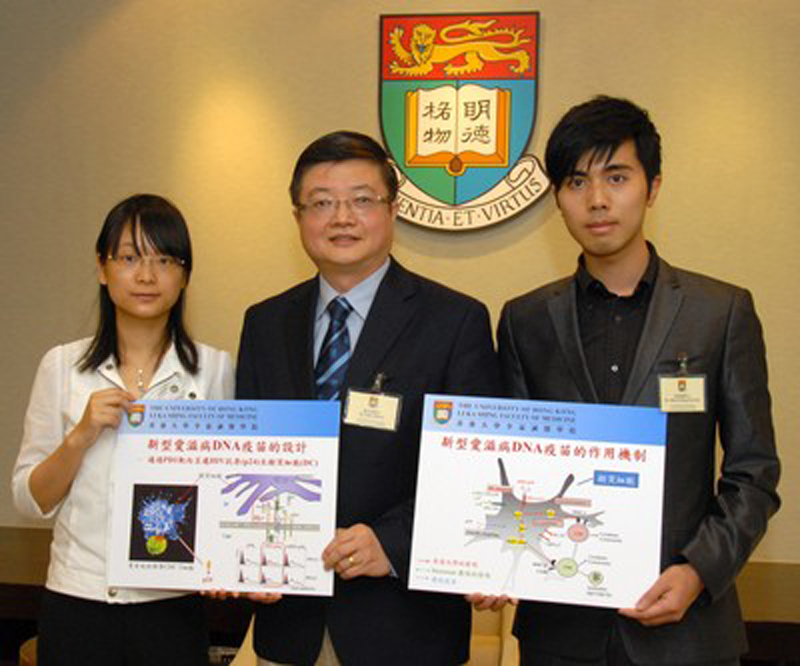
The AIDS Institute of The University of Hong Kong Li Ka Shing Faculty of Medicine lately discovers specific molecule on dendritic cells (DC) which can induce a high frequency of anti-HIV CD8+T cells. It is believed that the findings could be served as a new strategy for designing AIDS vaccine as well as other vaccines against cancer, bringing hopes of survival. The study on new vaccine has already obtained the international patent, signifying that Hong Kong researchers have the capability to invent novel AIDS vaccine.
With this pioneer discovery, we have already obtained the international patent, implying that we have the capability to invent novel AIDS vaccine in Hong Kong. If the vaccine works on humans, it will be a great leap forward not only for preventing HIV infection but also for immunotherapy for treating infected cases in the world.
Source: The University of Hong Kong
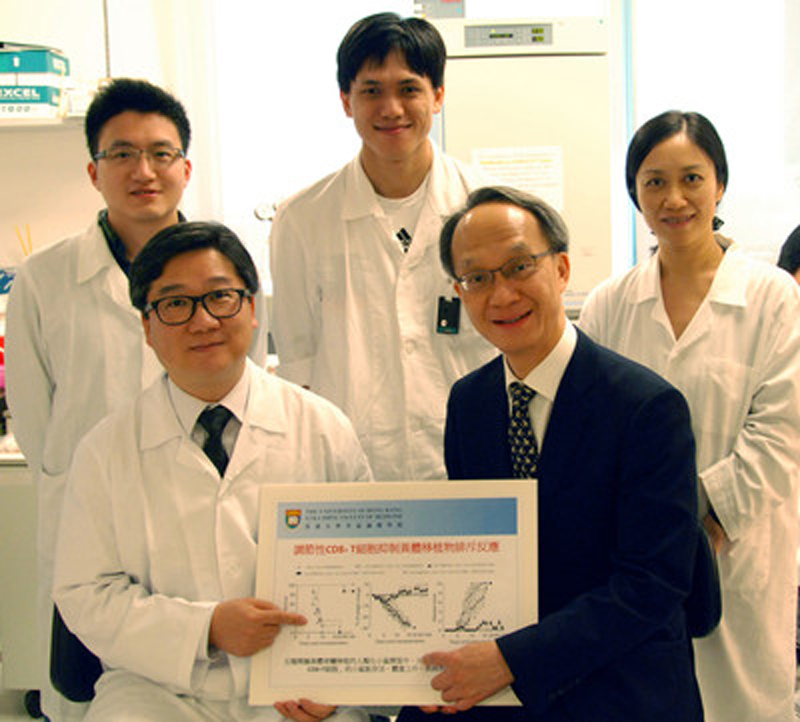
The University of Hong Kong discovers a novel cellular therapy for bone marrow transplantation (BMT) related complications, such as graft-versus-host disease (GVHD). Researchers successfully induce “antigen-specific CD8+ regulatory T cells” (Tregs), a special cell from human body, and then inject it to a “humanized mice” model equipped with complete human immune system for testing. They discover that the cell can effectively inhibit BMT-related GVHD while preserving general immunity of the host and the graft versus tumor effects
Allogeneic BMT (i. e. the bone marrow is not from the patients themselves) might trigger severe rejection. Patients have to receive long-term radioactive and immunosuppression therapy before and after BMT. It might seriously affect the treatment outcome and the patients’ quality of life. This research discovers that ‘antigen-specific CD8+ regulatory T cells’, which is able to recognize BMT recipient’s antigen, can effectively suppress the immunoreaction specific to the recipient. This finding sheds light on the treatment of BMT rejection.
Source: The University of Hong Kong

The Human Genetics Laboratory of the Department of Paediatrics and Adolescent Medicine, The University of Hong Kong Li Ka Shing Faculty of Medicine, in collaboration with scientists in the Mainland China and Thailand, discovers genetic variations in five genes frequently found among systemic lupus erythematosus (SLE) patients of Asian populations to be associated with disease risk.
Genetic factors play an important role in SLE. Scientists have found that due to genetic factors, Asians are at higher risks of SLE compared with Europeans. The mechanism and specific genes are still the areas need to unravel. The study this time identifies more genetic factors and provides a real possibility that we could predict disease severity and clinical features based on patient’s genome in the future, and to choose treatment strategies accordingly.
Source: HKUMed
2014
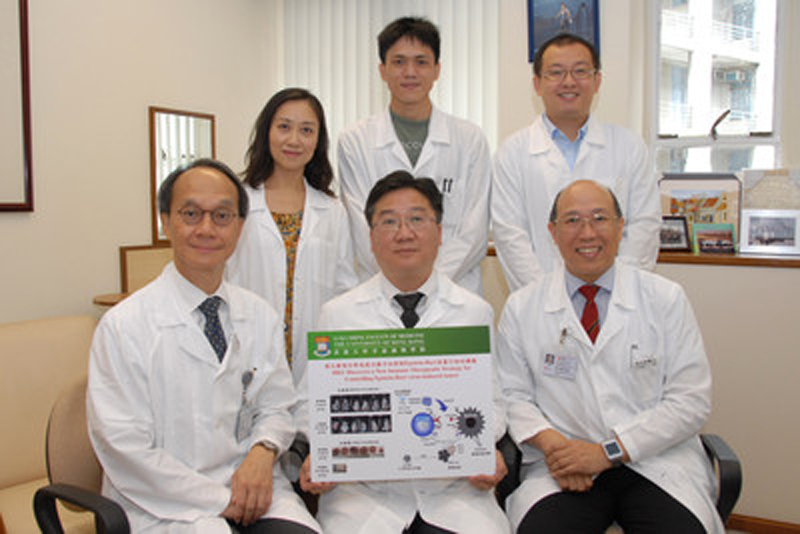
Epstein-Barr virus (EBV)-induced tumor, such as EBV-induced B cell lymphoproliferative disorders (EBV-LPD), is a serious and life-threatening condition with significant morbidity and mortality in immunocompromised patients. Currently, there are only very limited treatment options. An international research team, led by Dr Tu Wenwei, Associate Professor in Department of Paediatrics & Adolescent Medicine, Li Ka Shing Faculty of Medicine, The University of Hong Kong (HKU), has discovered that pamidronate, a drug well-established for treatment of bone diseases, can effectively control EBV-LPD by enhancing human gamma-delta T cell (γδ-T cell) immunity.
The discovery has provided the proof-of-principle for a novel immune therapeutic approach using pamidronate to control EBV-induced tumors through boosting human γδ-T cell immunity in humanised mouse model. This new immune therapeutic approach may significantly reduce the unwanted side-effects and general immunosuppression caused by currently available treatment options. New application of an ‘old drug’ potentially offers a safe and readily available option for the treatment of EBV-induced tumors because pamidronate has been already used for decades in osteoporosis treatment. The result will be further tested on human for clinical trial.
Source: The University of Hong Kong
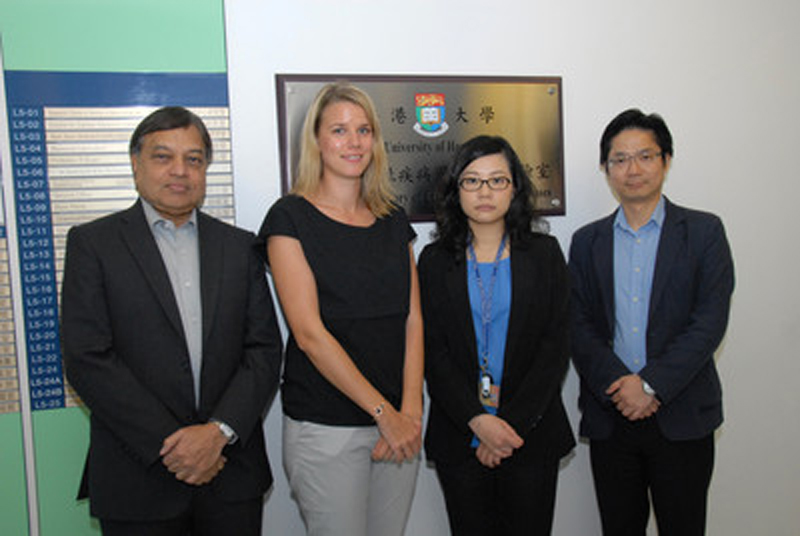
A research team, led by Dr Leo Poon, Associate Professor of the School of Public Health, Li Ka Shing Faculty of Medicine, The University of Hong Kong (HKU), in collaboration with the National Cancer Institute, National Institutes of Health, United States of America (USA), has developed a novel influenza A vaccine that can induce protective responses against distinctly different influenza A viruses in mice, including the avian H7N9 virus. The novel influenza A vaccine is able to induce T-cell immune responses against influenza A viruses of different hemagglutinin (HA) subtypes, overcoming the limitations of the current seasonal vaccines. These immune responses can provide protection against lethal challenge of influenza A viruses by reducing the amount of viruses and the duration of illness.
The vaccinia virus is useful as it is also used as a vaccine for smallpox, and is therefore already licensed for human use with over a billion doses given so far. The vaccine can be adapted for mass production in case of a worldwide influenza outbreak.
Source: School of Public Health, The University of Hong Kong
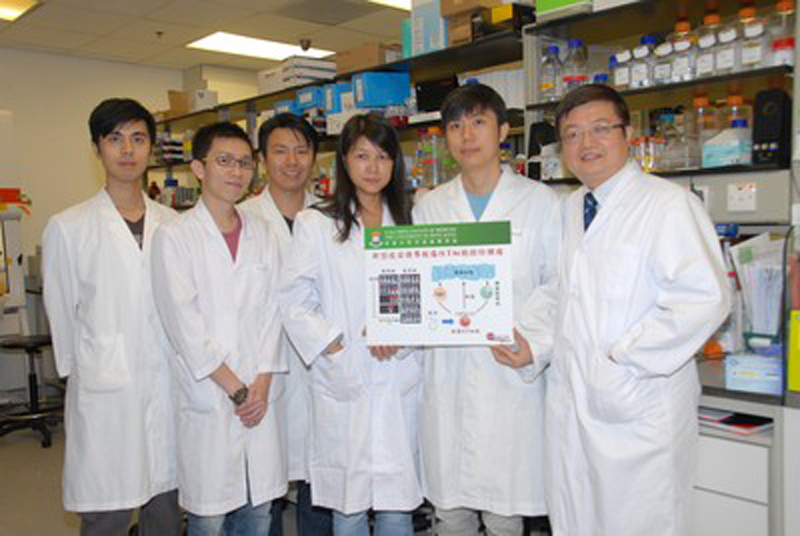
Eradicating malignant cancer cells by vaccine-elicited host immunity remains a major medical challenge. The reason behind the challenge is largely due to the lack of effective vaccination to induce immune surveillance, which requires a large number of functional killer T cells to eliminate malignant cancer cells. Researchers from Li Ka Shing Faculty of Medicine, The University of Hong Kong (HKU) present findings of a 5-year study that an effective vaccine can actually harness the immune system and reinstate immune surveillance by overcoming tumor-associated immunosuppressive environment.
The discovery has provided new insights into quantitative and qualitative requirements of vaccine-elicited functional killer T cells in cancer prevention and immunotherapy. It will encourage researchers to explore new ways of active vaccination for the development of both preventive and therapeutic strategies against cancer. It also demonstrated that a novel vaccination strategy initially invented for fighting AIDS virus is quite helpful to the search of an effective cancer immunotherapy.
Source: The University of Hong Kong

Li Ka Shing Faculty of Medicine, The University of Hong Kong (HKU), in collaboration with the University of Toronto and Queen Elizabeth Hospital, has developed a novel trans-oral NP brush biopsy test for early detection of NPC. Based on the results of the study, the new method, compared with traditional methods, is simple and effective, and can be used as an ambulatory and non-invasive mass screening tool for early detection of NPC.
Symptoms of early NPC may not be apparent and some tumors are located in the submucosa, making early detection very difficult. The new test is simple and non-invasive. Screening can be done trans-orally by family physicians or nurses in primary care clinics. High-risk individuals with a family history of NPC or with persistent positive results in Epstein Barr Virus (EBV), one of the human herpesviruses, serology tests can take this new test to detect NPC early and improve survival rates. It is hoped that the test can be applied on a large scale global screening of NPC, especially in those regions where specialists, sophisticated endoscopes and equipment to preserve tumor samples are not readily available.
Source: The University of Hong Kong
The collaborative research team formed by The University of Hong Kong (HKU), Chinese Academy of Sciences, and Fudan University has made a breakthrough in discovering a novel drug candidate for the emerging Middle East respiratory syndrome coronavirus (MERS-CoV). The team discovered an “antiviral peptide” which is capable of inhibiting MERS-CoV from infecting the cells by its interaction with the stalk of the virus’ surface Spike protein responsible for virus entry into cells.
As it takes considerable time to develop “antiviral peptide” into a drug for market use, the HKU research team also tested the anti-MERS-CoV activity of other drugs which are already available in the market. They found that another two drugs used for treating other illnesses, namely mycophenolic acid (Mycophenolate mofetil) and interferon-β1b (Betaferon), also have significant activity against MERS-CoV in cell culture experiments. The three agents will be tested in animal models and clinical trials in future.
Source: The University of Hong Kong
Every year many elderly patients were hospitalized for influenza infection and its complication, of which 10% has received the conventional intramuscular seasonal influenza vaccination in the past 9 months. This breakthrough in protection is often attributed to the falling protective antibody titre within 6 months after the winter vaccination. Elderly patients with medical comorbidities are particularly vulnerable and rendered susceptible to the summer influenza peak or just before the next annual vaccination. A team led by Professor Yuen Kwok-yung, Chair Professor of Department of Microbiology, Li Ka Shing Faculty of Medicine of The University of Hong Kong (HKU) has discovered a simple and practical way of protecting elderly patients with medical illness from seasonal influenza. By applying imiquimod before intradermal injection, the protection by flu vaccine will be enhanced, thus decreasing the risk of hospitalization.
Source: The University of Hong Kong
2015
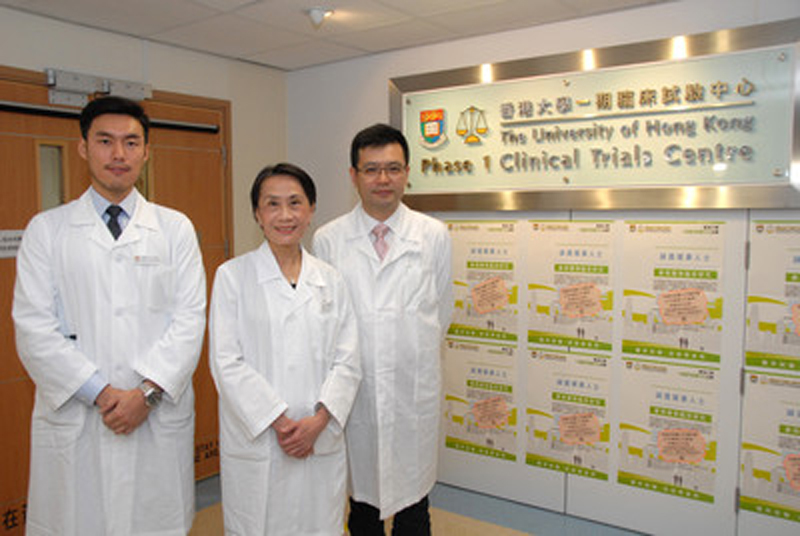
In order to support clinical trials on novel drugs for various kinds of diseases, The University of Hong Kong Phase 1 Clinical Trials Centre (Phase 1 Centre) has been established last year. The Phase 1 Centre is a dedicated, state-of-the-art clinical research facility of HKU Clinical Trials Centre (HKU-CTC), specifically designed for conducting phase 1 and early phase clinical trials. With this advanced establishment, more high impact clinical trials will be conducted in the future and more novel treatments will emerge to combat different diseases – for the well-being of Hong Kong citizens and the mankind.
Since the commencement of operation of the Phase 1 Centre in mid-2014, it has already supported three novel drug trials, in cancer and hepatitis. Currently four trials are ongoing there, and 12 other trials are under planning. The main research areas include cancers, hepatitis, immunology, diabetes and infectious diseases. So far over 70 participants have enrolled in the completed and ongoing trials. With the rapid advancement in medical research locally and worldwide, the number of phase 1 and early phase clinical trials conducted in the Phase 1 Centre is expected to keep growing in the years to come, and more new treatments will emerge.
Source: The University of Hong Kong
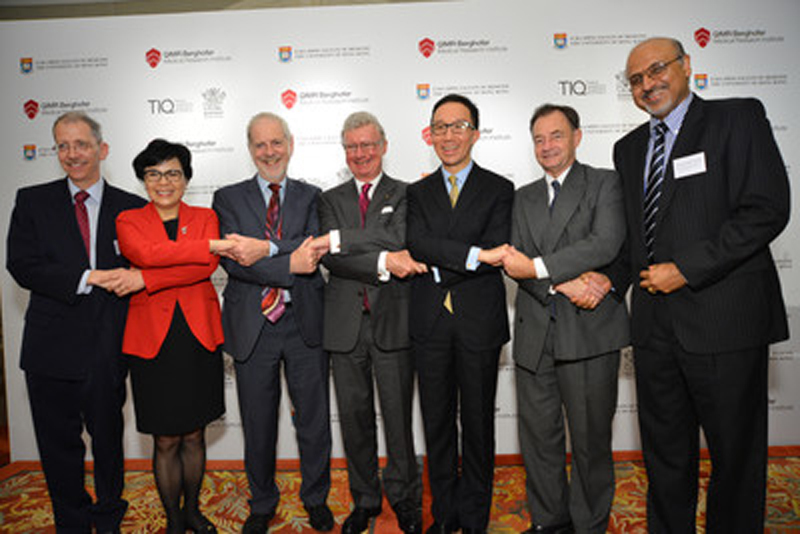
The QIMR Berghofer Medical Research Institute (QIMR Berghofer) in Australia and the Li Ka Shing Faculty of Medicine of The University of Hong Kong (HKU) have entered into an important agreement that will give patients in Hong Kong and Australia access to a ground-breaking cancer treatment. The MOU also initiates an advanced training programme for Hong Kong clinical or science graduates on the production of clinical grade “killer T-cell immunotherapies”. Scientists from the two institutions are joining forces for the second phase of a clinical trial using immunotherapy for the management of nasopharyngeal carcinoma (NPC).
In the Phase I trial, blood samples were taken from patients before treatment started and sent to QIMR Berghofer’s Brisbane laboratories. The scientists then extracted T-cells – a type of white blood cell –which were nourished in the laboratory and primed to attack cells infected with the virus, honing in on malignant cells while leaving normal cells intact. The phase I trial which started in 2009 involved late-stage NPC patients, and even though the primary endpoint of Phase I trial was safety, it was found that this cell-based therapy, on average, improved their life expectancy. The overall survival rate of immunotherapy patients in the Phase I trial was 523 days, compared to only 220 days among patients who did not receive the treatment. In the new trial, by offering this cell-based treatment in the earlier stages of the disease, it is hoped to further improve the survival rate. 30 newly diagnosed patients with metastatic NPC at the Queen Mary Hospital in Hong Kong and others in Australia will be involved in the Phase II trial.
Source: The University of Hong Kong
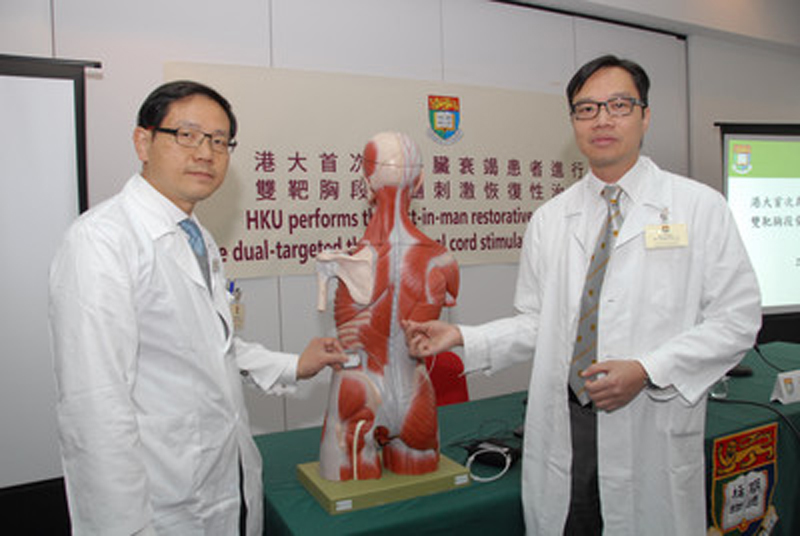
Researchers from the Li Ka Shing Faculty of Medicine, The University of Hong Kong (HKU) performed the first-in-man restorative treatment by applying the thoracic spinal cord stimulation for heart failure patients in order to advance their quality of life. Therefore, there is a need for alternative therapy for treatment of those patients with severe heart failure. Despite recent advances in the treatment of heart failure, a large proportion of patients with heart failure still suffer from severe symptoms with poor quality of life and clinical outcomes. The first-in-man initial data showed dual-targeted thoracic spinal cord stimulation was safe and improved symptoms and heart function in the patients who had severe symptomatic systolic heart failure. These findings suggest that spinal cord stimulation with an implantable device is a novel therapy in those patients with severe heart failure. Nevertheless, the results of this pilot trial need to be confirmed by further clinical trials in a large number of patients.
Source: The University of Hong Kong
The success rate for drug discovery can be doubled if genes with genetic evidence support are selected to be drug-targets, according to a recent international collaborative study, which Centre for Genomic Sciences at Li Ka Shing Faculty of Medicine, The University of Hong Kong (HKU) joined. This is the first report showing that genetic evidences from genome-wide association studies (GWAS) can benefit drug-targets selection, and will greatly benefit patients in the future.
The medical sector has long believed that genetic evidences can be used to boost drug development process, but the assumption has never been proved with concrete data. Massive pharmaceutical and genetic data from both industrial and academic communities accumulated over the past decade were used to prove this assumption. The result will influence drug development strategy, speeding up drug development pipeline, and eventually benefiting the patients. With this evidence, pharmaceutical companies should focus their drug-targets more on the genes or proteins with genetic evidences, including disease genes of GWAS and disease genes of mendelian disorders, which can significantly improve their productivity. This work mainly utilised GWASdb database, which was developed and has been maintained for five years by the bioinformatics team, and is a perfect example of how basic research can contribute to the medical and pharmaceutical industry.
Source: The University of Hong Kong
Researchers from The University of Hong Kong (HKU), Karolinska Institutet and Hong Kong University of Science and Technology find that disruption of PARP-1-Timeless interaction compromises homologous recombination (HR) repair, while PARP inhibitors cannot break the PARP-1-Timeless complex in cells. The team also identifies the novel PARP-1-Timeless complex that can promote damaged DNA repair. The findings of this study provide implications for understanding the mechanism of the clinically active PARP inhibitors and raise a new possibility to develop alternative PARP-1 target therapy for cancer treatment in the future studies.
The study shows that disruption of the interaction of PARP-1 with Timeless compromises the efficient DNA double-strand break (DSB) repair. This may provide an alternative anticancer strategy to target PARP-1 by developing new drug to block the interaction of PARP-1 with Timeless, and the detailed structural information provided in this study can greatly facilitate this process.
Source: The University of Hong Kong
Researchers from Li Ka Shing Faculty of Medicine, The University of Hong Kong (HKU) have completed an important double-blind, randomised, controlled trial, demonstrating that the topical application of imiquimod just before intradermal trivalent influenza vaccine in young healthy volunteers, significantly improved the immunogenicity against the vaccine strains. More importantly, imiquimod also increased the breadth of immunogenicity against the heterologous non-vaccine strains, including the antigenically drifted H3N2 strain.
Every year, influenza infection causes a huge disease burden with significantly increased mortality. This is the first randomised controlled trial to use this approach with trivalent seasonal influenza vaccine in healthy individuals and show the early onset of significantly improved serological evidence of protection against vaccine and non-vaccine influenza virus strains when compared with the three control groups. Notably, the study demonstrated good heterologous antibody protection against non-vaccine virus strains including the antigenicially drifted influenza A H3N2 virus. Topical imiquimod pretreatment before intradermal influenza vaccination is extremely safe. It improves the time to onset, extent and breadth of protective serological response against both vaccine influenza strains and heterologous non-vaccine-strains. This finding has important global health implications, especially at times of vaccine mismatch and during major outbreak.
Source: The University of Hong Kong
2016

The HKU Phase 1 Clinical Trials Centre, together with seven clinical specialties of its affiliated teaching hospital – Queen Mary Hospital (QMH), received official accreditation by the China Food and Drug Administration for conducting clinical drug trials. The HKU Phase 1 Centre is a dedicated, state-of-the-art clinical research facility of HKU Clinical Trials Centre, specifically designed for performing phase 1, early phase and clinical pharmacology trials. This accreditation signifies that research data and results arising from clinical trials conducted in the HKU Phase 1 Centre and the seven clinical specialties will be accepted by the CFDA for evaluation of applications for drug registration in the Mainland China, strengthening Hong Kong’s special position as a hub for drug research and development in China and worldwide.
Since 2006, HKU/QMH has been accredited by the CFDA for conducting clinical drug trials in seven clinical specialties (including anaesthesiology, cardiology, endocrinology & metabolism, haematology & bone marrow transplantation, hepatobiliary & pancreatic surgery/liver transplantation, obstetrics & gynaecology, and respiratory medicine). With the new accreditation for the HKU Phase 1 Centre and seven additional clinical specialties (including clinical immunology, gastroenterology & hepatology, nephrology, neurology, oncology, orthopaedics & traumatology, and paediatrics & adolescent medicine), HKU/QMH now is accredited by the CFDA in a total of 15 areas.
Source: The University of Hong Kong
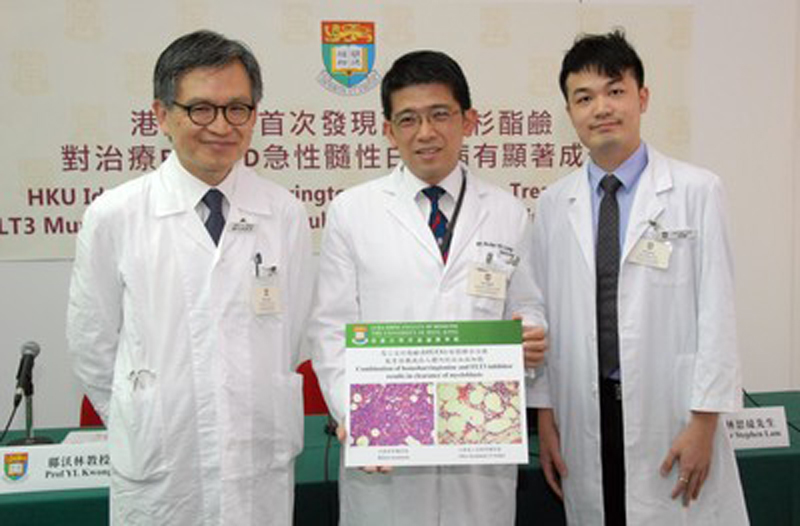
The latest study of Li Ka Shing Faculty of Medicine, The University of Hong Kong (HKU) shows that Homoharringtonine (HHT) derived from plants, in combination with FLT3 inhibitor, could eradicate leukaemia cells in patients with FLT3-ITD acute myeloid leukaemia (AML) and prolonged their survival. The treatment was associated with minimal side effects. The study has set a new paradigm for the development of novel therapeutic agents in relapsed or refractory AML based on in vitro drug screening, and was recognised internationally.
Leukaemia relapse is the major cause of treatment failure and only one-third of patients can achieve long-term remission. The research team of Department of Medicine, Li Ka Shing Faculty of Medicine, HKU, launched the study in 2012, performed molecular profiling and drug screening using leukaemia cells from AML patients and identified HHT being particularly effective in FLT3-ITD AML. Furthermore, HHT in combination with FLT3 inhibitor resulted in significant synergistic effects in suppressing leukaemia cell growth of this AML subtype. The team launched a phase II clinical trial and recruited 24 patients with relapsed or refractory FLT3-ITD AML to receive HHT and FLT3 inhibitor combination treatment. 20 out of 24 patients showed complete clearance of leukaemia cells after three weeks. Toxicity was minimal and the regimen was tolerable even in elderly and frail patients otherwise unfit for chemotherapy.
Source: The University of Hong Kong
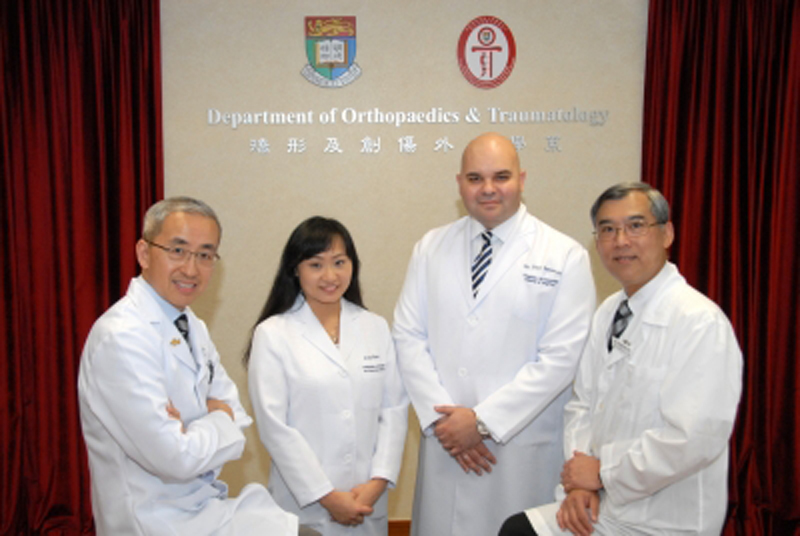
The Department of Orthopaedics and Traumatology, Li Ka Shing Faculty of Medicine, The University of Hong Kong (HKU) has carried out the largest population-based study addressing spine degeneration on magnetic resonance imaging (MRI) and LBP since 2001 and found specific patterns of vertebral marrow changes, known as “Modic changes”, that are highly associated with intervertebral disc degeneration.A HKU study conducted in 2012 found that 7 out of 10 Hong Kong adults suffered from disc degeneration, which is one of the major causes of LBP and disability. LBP can lead to diminished quality of life, decreased productivity, loss of work and wages, and psychological distress.
This large-scale study represents one of the first to date to extensively assess the clinical relevance of distinct Modic changes. The results showed that specific Modic changes types and patterns were associated with prolonged severe LBP and disability. These findings strengthen the clinical importance of Modic changes as key “imaging biomarkers” among LBP patients. This study raises awareness on the need to assess specific Modic changes types regarding their morphology and extent of involvement of the spine, which may contribute to the understanding of LBP development and severity. The study assists doctors in performing clinical assessment more accurately.
Source: The University of Hong Kong
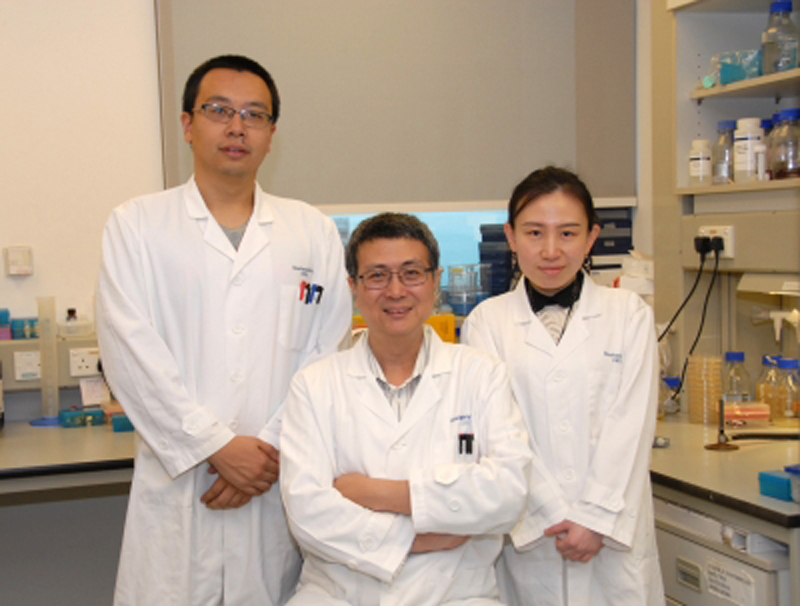
Researchers at School of Biomedical Sciences of Li Ka Shing Faculty of Medicine, The University of Hong Kong (HKU) have recently engineered the Salmonella into an anaerobe bacterium named YB1 which can only survive and thrive in the hypoxic condition, for example, hypoxic regions inside solid tumours. YB1 can effectively inhibit the growth of tumours while being safe to normal tissues. This invention has been filed patent applications in different countries through the Technology Transfer Office of HKU. A patent was recently granted by the United States Patent and Trademark Office. It is estimated that YB1 will be ready for clinical trials in a few years. The researchers hope that YB1 can be further developed into a tumour-targeting agent in the near future.
Source: The University of Hong Kong
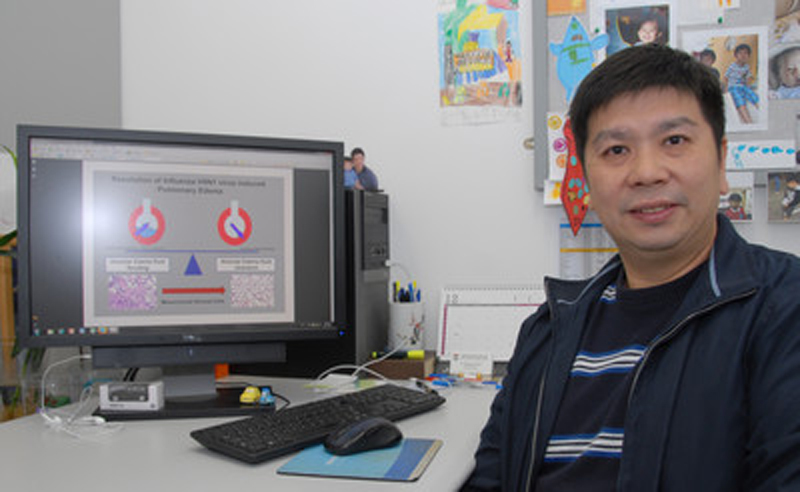
H5N1 influenza causing severe lung disease in humans was first detected in Hong Kong in 1997, but to date, effective treatment remains elusive. Researchers from Li Ka Shing Faculty of Medicine, The University of Hong Kong (HKU) have recently discovered novel mechanisms by which avian influenza H5N1 virus causes acute lung injury and leads to severe pneumonia in humans through the impairment of sodium and chloride transporter molecules in the human lung epithelium. The research team further discovers novel therapeutic strategies for treating human H5N1 disease.
This provides a novel and potent therapeutic strategy for treating human H5N1 disease. These findings may also be relevant to other viruses that may cause severe viral pneumonia by similar mechanisms, such as SARS and MERS coronaviruses and other avian influenza viruses such as H7N9 and H9N2.” “We may also be able to find simpler treatments that restore the activity of these transport molecules
Source: The University of Hong Kong
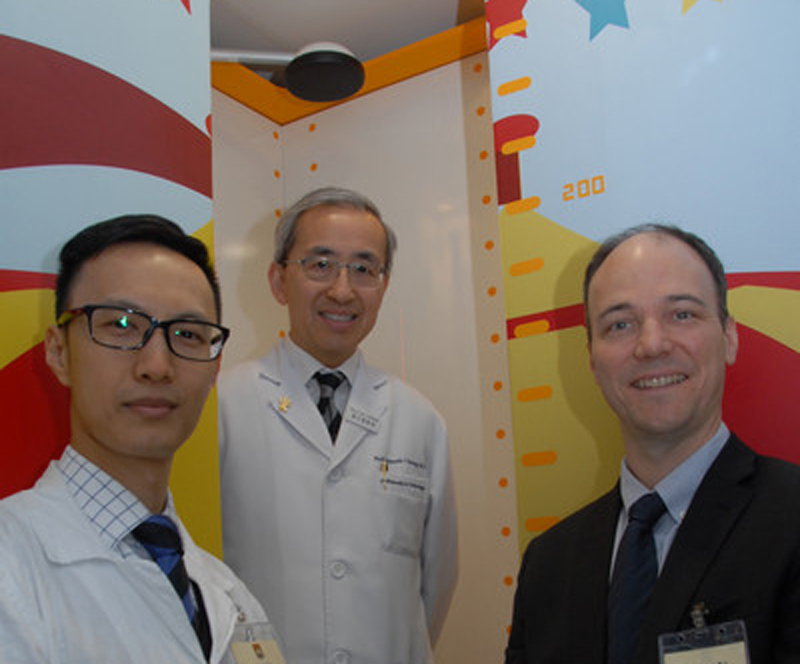
Department of Orthopaedics and Traumatology of Li Ka Shing Faculty of Medicine, The University of Hong Kong (HKU) will collaborate with a team of international experts led by Dr Stefan Parent from CHU Sainte-Justine, University of Montreal, Canada to study a new predictive model for the progression of adolescent idiopathic scoliosis (AIS) with the use of EOS Imaging System, a Nobel-Prize winning detection technology for orthopaedic imaging. This new model helps predicting the curve of spine severity at the end of skeletal development based on three-dimensional (3D) reconstructions of the spine and other maturity parameters.Experts from Canada, Hong Kong, the United States, France, Japan and Singapore join hands to study this new predictive model, which allows doctors to identify patients who are at higher risk of progression, so the patients may have early treatment to prevent further progression.
The team recruits 150 new patients diagnosed with AIS, who are 10 years old or above, and do not have previous spinal disorders. The participants have to fill in questionnaires and perform X-ray checks using the EOS Imaging System. They will receive follow-up every 6 months till maturity. The team hopes to obtain more accurate information to make decision for bracing and surgery through the research project and have more psychological preparation for patients based on individualised prediction rather than international figures.
Source: The University of Hong Kong
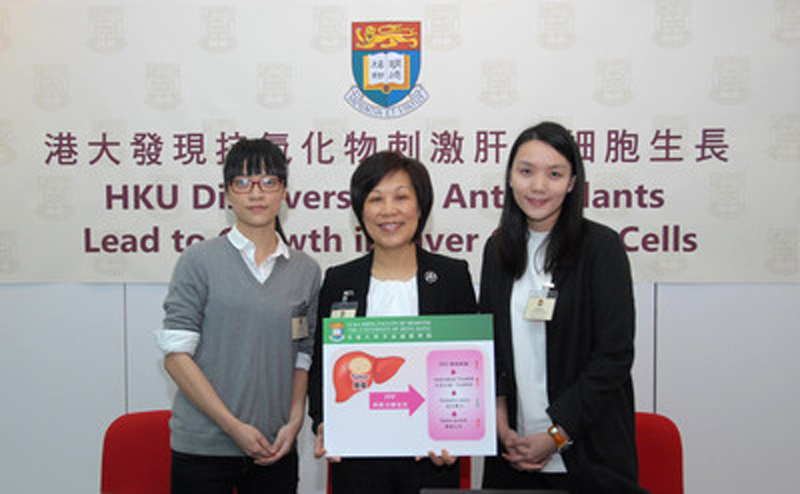
The research team at Li Ka Shing Faculty of Medicine, The University of Hong Kong (HKU) discovers that antioxidants facilitate the growth in liver cancer cells. Liver cancer patients are hence not recommended to take high dose of antioxidant supplements. The findings are applicable to other cancers having the same metabolic pathway, such as colorectal cancer and lung cancer. The above novel findings of the role of antioxidants in cancer development may shed light to new therapeutic approaches that involve blockade of antioxidant-producing systems in cancer cells.
Using liver cancer in preclinical animal as model, the study shows that excessive reactive oxygen species (ROS) or free radicals cause more oxidative stress, while excessive accumulation of oxidative stress is harmful to cancer cells and lowers the growth rate. In long term, our study can facilitate the development of safer, effective and targeted treatment that can be used in combination with chemotherapy to completely eradicate this deadly disease and benefit liver cancer patients. Liver cancer patients are advised to have a balanced diet and they should note that a high intake of antioxidant supplements may not be beneficial to health.
Source: The University of Hong Kong
2017

A study conducted by Li Ka Shing Faculty of Medicine of The University of Hong Kong (HKU) analysed 8,152 atrial fibrillation patients who had attended public hospitals in Hong Kong from 2010 to 2014. The study found for the first time that when comparing the traditional drug warfarin to the newer drug dabigatran, warfarin was significantly associated with higher risk of osteoporotic fracture, which may increase the morbidity and mortality among the elderly, compared to dabigatran.
Patients newly diagnosed with atrial fibrillation from 2010 through 2014 and prescribed dabigatran or warfarin in the Hospital Authority were matched by propensity score at 1:2 ratio and followed until 2016. Risk of osteoporotic fracture at hip and vertebrae was compared between dabigatran and warfarin users using Poisson regression. The corresponding incidence rate ratio (IRR) and absolute risk difference (ARD) with 95% confidence interval (CI) were calculated.
To the knowledge of the research team, this is the first population-based study that determined the risk of osteoporotic fracture with dabigatran versus warfarin in patients with atrial fibrillation. Osteoporotic fracture is a key clinical concern amongst patients with atrial fibrillation, as both conditions are more common in elderly than in the younger generation. More importantly, after a hip fracture, 1/3 of elderly patients died within the first year, and many remains dependent. The study conducted by HKU has demonstrated that patients with on dabigatran have a lower risk of osteoporotic fracture, which is consistent with our findings of its survival benefits in our Chinese patients with atrial fibrillation. Patients who are in need of oral anticoagulation for stroke prevention would therefore benefit from a reduction in osteoporotic fracture risk by choosing a suitable oral anticoagulant.
Source: The University of Hong Kong
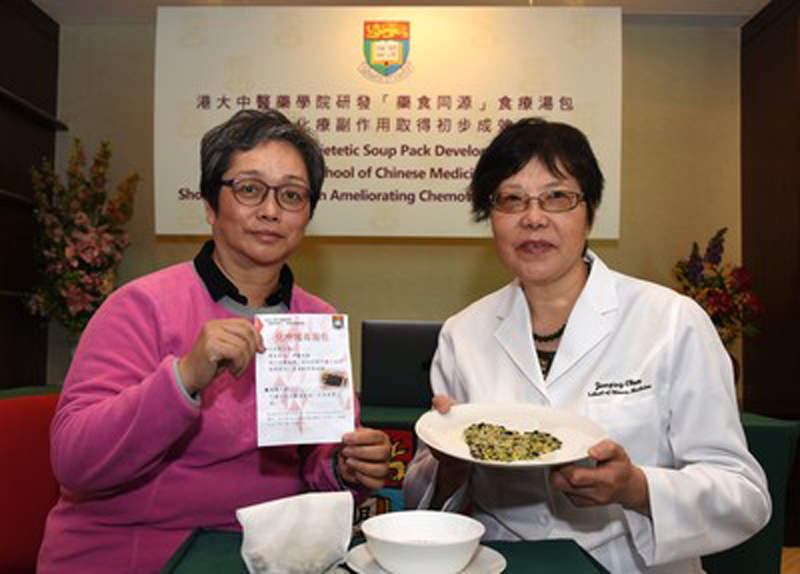
The research team led by Dr Chen Jianping, Associate Professor of School of Chinese Medicine, Li Ka Shing Faculty of Medicine, The University of Hong Kong (HKU) develops a medicinal dietetic soup pack for ameliorating chemotherapy side effects. Preliminary clinical trial and laboratory experiments results show that the soup pack may improve symptoms like chemotherapy-induced alopecia, nail and skin discoloration, and reduced white blood cell. Meanwhile, it can improve patients’ qualify of life and reduce fatigue without affecting the efficacy of chemotherapeutic drugs.
Mid-term results of the research show that the soup pack may ameliorate chemotherapy side effects. It is convenient, natural, safe to use and does not affect the efficacy of western medical treatment. It is hoped that the medicinal dietetic soup pack will become a standard treatment for cancer patients. Through ameliorating the toxicity induced by chemotherapy, the soup pack can improve the patients’ quality of life and thus reduce the rate of not completing the chemotherapy treatment. It can also reduce the financial burden of patients and significantly improve their quality of life.
Source: The University of Hong Kong

For the past 30 years, the “conventional” T2-weighted magnetic resonance imaging (MRI) has been broadly used to diagnose LBP; however, it is not highly sensitive and reliable, and as such may not be useful to identify the cause and treatment of LBP. This study, led by the Department of Orthopaedics and Traumatology, Li Ka Shing Faculty of Medicine, The University of Hong Kong (HKU), is the first to report that the Ultra-Short Time-to-Echo Disc Sign (UDS) was found to be significantly related to degenerative spine changes, LBP and disability in comparison to conventional MRI imaging.
This study is the first to report the finding and clinical relevance in humans of the UDS on MRI. The UDS is a novel, reliable and simple MRI biomarker to assess the intervertebral lumbar discs, its relationship with other findings of spine degeneration, and its implications upon LBP and disability. The UDS was found to be significantly related to degenerative spine changes, LBP and disability in comparison to conventional MRI imaging. The UDS may serve as a new imaging marker that may have potential implications in diagnostic, therapeutic and prognostic platforms in patients presenting with LBP or possibly be able to predict the development and severity of pain. The UDS may also shed light upon the pathomechanism of spinal disc changes that may become painful.
Source: The University of Hong Kong
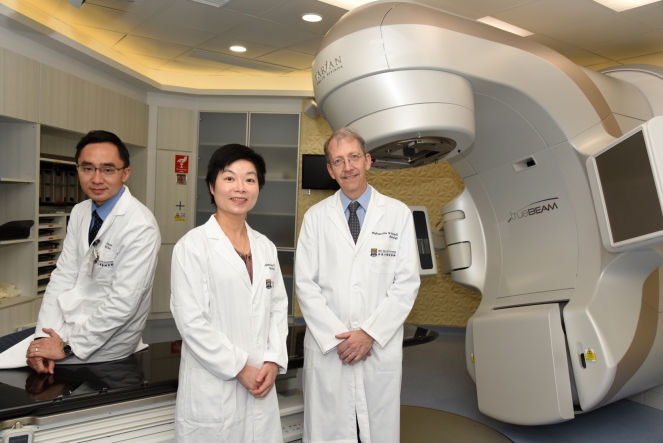
Nasopharyngeal cancer, also known as “Canton tumour”, is the malignant changes in the tissues of the nasopharynx. It is the most common head and neck cancer in Hong Kong and is more common in southern part of China than in Western countries. The University of Hong Kong (HKU) has collaborated with QIMR Berghofer Medical Research Institute in Australia since 2008 to conduct an international clinical trial of an immunotherapy treatment. With eight years of testing, it has demonstrated promising clinical responses in patients with nasopharyngeal cancer.
The Phase I clinical trial was carried out in two groups of patients in Queen Mary Hospital of Hong Kong and the Princess Alexandra Hospital in Brisbane, Australia in 2008-2016. The Phase I clinical trial tested the safety of the immunotherapy treatment. The first group consisted of terminally ill nasopharyngeal cancer patients who had become resistant to the standard treatments of chemotherapy and radiotherapy. The second group consisted of nasopharyngeal cancer patients who had previously received the standard treatments and showed no sign of the disease, but based on prior clinical experience, were at high risk of the cancer returning. The survival rates are better than expected in patients who hadn’t received the T cell treatment. It is believed that the T cell treatment delayed the recurrence of the cancer in this second group of patient.
Source: The University of Hong Kong
2018
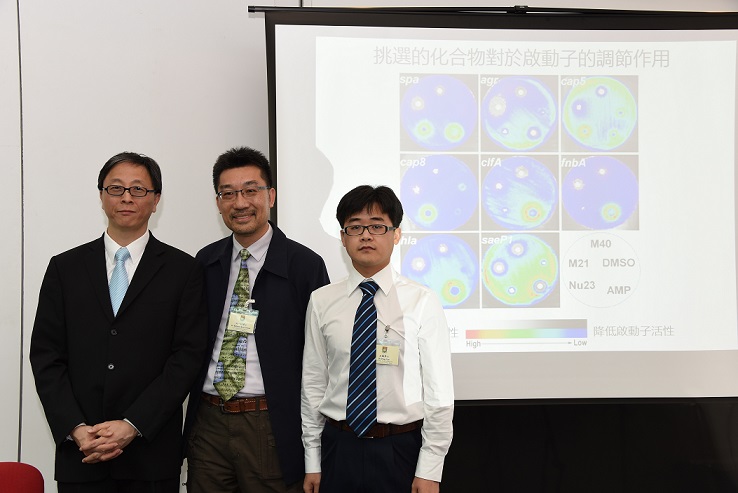
Community-associated methicillin resistant Staphylococcus aureus (CA-MRSA), which has hyper-virulent properties and is able to infect healthy individuals living in the community, has elicited much concern.
New work be the HKU Li Ka Shing Faculty of Medicine and the University of British Columbia (UBC) is offering a lead in that battle with the discovery of a lead compound that simultaneously suppresses the production of multiple virulence factors in MRSA and CA-MRSA. This follows a widely-recognized discovery in 2017 by Dr Richard Kao Yi-tsun from the Department of Microbiology, Faculty of Medicine, HKU and Professor Julian Davies from UBC of a lead compound that reduces the virulence of S. aureus by inhibiting the production of the golden pigment of the bacteria, and an explorative research project to look for new strategies to combat antimicrobial resistance that was initiated in 2009 by Professor Yuen Kwok-yung and funded by RFCID/HMRF grants from the HKSAR government. The newest discovery gives hope that it may be possible in the near future to use non-antibiotic drugs to treat bacterial infections, without the fear of instigating AMR.
Source: The University of Hong Kong
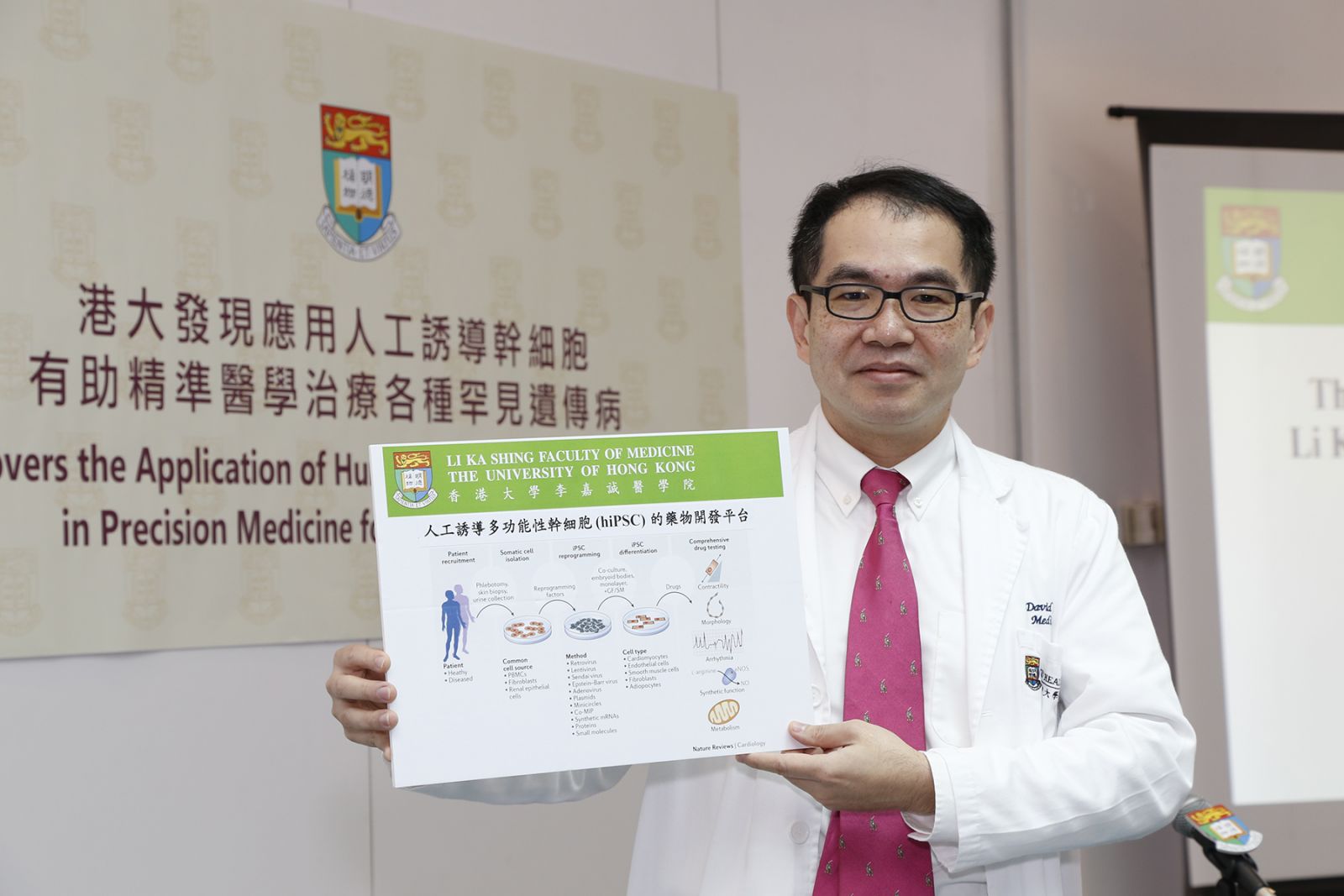
Researchers at Li Ka Shing Faculty of Medicine of The University of Hong Kong (HKU) have successfully demonstrated the use of human induced pluripotent stem cells (hiPSCs) from patients’ skin cells for therapeutic drug testing. The success of the research implies that scientists are one step closer to applying stem cells in precision medicine in treating patients suffering from various rare hereditary diseases.
The team tests a drug, PTC124, which can suppress certain genetic mutations in other hereditary disease in the patient-specific iPSC transformed heart muscle cells.
hiPSC technology and in vitro drug testing strategies provide unparalleled opportunities to realize the promise of precision medicine. This strategy may be exploited to select the patients with maximum drug responsiveness for standard clinical trials. Then, the expected drug effects may be much larger, and the required sample size would then be much smaller, making standard randomized clinical trials possible.
Source: The University of Hong Kong
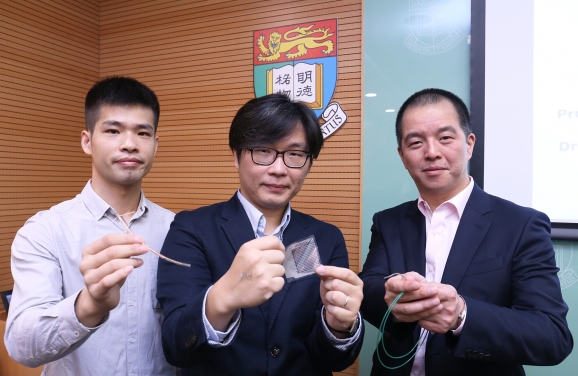
A University of Hong Kong research team led by Dr Paddy Chan Kwok-leung of the Mechanical Engineering Department, in collaboration with Professor Gilberto Leung Ka-kit (Tsang Wing-Hing Professor in Clinical Neuroscience) and Dr Anderson Tsang Chun-on of Surgery, and Professor Xu Aimin of Department of Pharmacology and Pharmacy, have developed a C-reactive protein (CRP) sensor integrated onto a medical catheter for direct CRP sensing. This organic sensor has a total thickness less than one micrometer (~1/50 of Asian human hair), which can significantly save the time for sample and data collection, from currently a few hours to 10 minutes or less. In other words, testing and curing of inflammation can be speeded up by 30 times. The real-time signal read out has a great potential in allowing the doctors to take necessary immediate actions.
Source: The University of Hong Kong

A study led by a team of the Department of Pharmacology and Pharmacy of Li Ka Shing Faculty of Medicine, The University of Hong Kong, in collaboration with Harvard Medical School, provided the first population-based evidence that the first-line anti-osteoporosis drug, alendronate, was associated with reduced risk of cardiovascular events (CVE) in patients with hip fracture, compared to non-treatment.
The study included over 30,000 patients with newly diagnosed hip fracture from 2005 through 2013. The team examined the treatment in these patients and matched the alendronate-treated and non-treated patients. Their risks of CVE were compared. The risk of cardiovascular death and heart attacks in treated patients were reduced by 67% and 45%, respectively, compared to non-treated patients. This observed beneficial tendency was observed for up to ten years after treatment.
Source: The University of Hong Kong
2019

A research team from the Department of Pharmacology and Pharmacy, LKS Faculty of Medicine, The University of Hong Kong (HKUMed), is the first one that reports on an inhalable dry powder mRNA formulation. This new technology opens up an exciting opportunity to use mRNA for treating and preventing various lung diseases. A provisional application has been filed to USPTO based on this work.
Messenger RNA (mRNA) has a huge potential as therapeutics for the treatment of a variety of diseases. Instead of using protein as a drug, mRNA therapeutics works by instructing our body to generate specific proteins in order to produce a therapeutic effect. However, the most difficult barrier to overcome is delivery, which must be addressed before the mRNA therapeutics can be used in the clinic. Our team has successfully developed a safe and effective inhaled formulation of mRNA with potential to be used to treat various lung diseases such as asthma, chronic obstructive pulmonary disease (COPD), cancer, or as inhaled vaccines to prevent respiratory infections such as influenza. Administration by inhalation can maximize local concentration in the lung, reduce systemic exposure and side effects, thereby enhancing efficacy of treatment.
Source: The University of Hong Kong

A surgical team led by the Department of Orthopaedics and Traumatology, LKS Faculty of Medicine, The University of Hong Kong (HKUMed), successfully performs the first non-fusion scoliosis surgery by vertebral body tethering in Hong Kong and China. Traditionally, severe scoliosis requires treatment by surgery with a long open wound, dissection of back muscles, and surgical fusion with the implantation of rods and screws. While successful, traditional surgery renders the spine stiff and restricts individuals from certain activities.
This new minimally invasive surgical technique is performed using keyhole incisions in the chest wall and utilises the remaining growth potential of the spine to gradually correct the patient’s spinal curvature. Its major advantage is in maintaining spinal mobility and avoids the use of an external brace or invasive fusion surgery. This new technique will benefit children with scoliosis with faster recovery rates, avoidance of large surgical wounds, and maintain spinal motion. ‟This new technique is the beginning of a new era in the surgical treatment of scoliosis. Children can look forward to normal activities without the psychological burden of bracing or effects of a long fusion surgery,” says Professor Kenneth Cheung Man-chee, Chair Professor and Head of Department of Orthopaedics and Traumatology, HKUMed.
Source: The University of Hong Kong
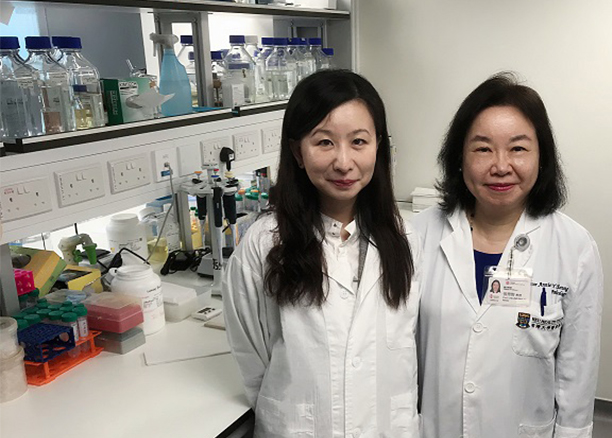
Researchers at LKS Faculty of Medicine at The University of Hong Kong have discovered a new genetic marker to guide targeted therapy for ovarian cancer patients, a major discovery that could lead to new treatment opportunities for ovarian cancer. Tumour DNA sequence enables doctors to customise treatment for the individual patient based on each patient’s unique genetic makeup. This is called precision medicine in which genetic marker can help predict the effective drug that kills tumour cells. By prescribing the more effective drug, precision medicine may reduce the cost and time of treatment. The side effects of unnecessary drug can also be avoided.
Ovarian cancer is the 7th leading cause of cancer deaths among women in Hong Kong. The disease is one of the most challenging cancers to treat. Surgery and chemotherapy are the standard of care. Patients who initially responded can become chemo-resistant. Currently, there are only a few targeted therapies with linked predictive genetic marker. This study aims to identify novel marker and the corresponding therapies. The researchers studied the tumour DNA sequencing data deposited in public databases. Among >1,000 ovarian cancer patients, 70% had deletion of the PIK3R1 gene. The results showed PIK3R1 loss promotes the growth of ovarian tumours through simultaneous activation of two important signaling pathways. The activated signaling represents a targetable therapeutic approach for ovarian cancer patients with PIK3R1 gene deletion. Drugs inhibiting these two pathways were tested on cancers with PIK3R1 loss that grew in mice. The team successfully showed that the inhibitors are highly effective to suppress cancer growth. The results also indicated stronger therapeutic benefit when the inhibitors were used in combination compared to single agents alone.
Source: The University of Hong Kong

The world has been repeatedly plagued by infectious disease outbreaks, including SARS and MERS coronaviruses, avian influenza viruses, and Zika virus. A team at the Medical Faculty of The University of Hong Kong (HKUMed) led by Professor Yuen Kwok-yung and Dr Shuofeng Yuan of the Department of Microbiology, has discovered a novel broad-spectrum antiviral drug that would be strategic for epidemic control and early treatment with better clinical outcome. US provisional patent application has been filed for this important discovery.
a bioactive lipid library was screened and AM580 was identified as a potent and broad-spectrum antiviral (respiratory or emerging RNA and DNA viruses) with high selectivity indexes in cell lines, and as a safe and effective anti-MERS and anti-influenza treatment in mouse models and human organoids. Notably, a chemical derivative of AM580, tamibarotene which is not a cytotoxic but a differentiation drug, has been used clinically for the treatment of acute promyelocytic leukemia with little side effects. With the clinical experience of tamibarotene, AM580-related compounds could be modified as a safe and broad group of antiviral therapeutics.
Source: The University of Hong Kong
2020

A research team at LKS Faculty of Medicine, The University of Hong Kong (HKUMed) discovered that tumour-derived extracellular vesicles promote liver cancer metastasis. The novel findings of the tumour-derived extracellular vesicles provide insights into promising biomarker and new therapeutic approach for liver cancer.Using the mouse model of liver cancer, the research team found that the liver cancer cell-derived extracellular vesicles (EVs) promote tumour growth and metastasis to lungs. The team further discovered that the nidogen 1 (NID1) present in EVs is crucial for the promoting effect of EVs. Functionally, EV-NID1 enhances angiogenesis and activates fibroblasts to secrete tumour necrosis factor receptor 1 (TNFR1), facilitating lung colonisation of tumour cells. EV-NID1 also augments tumour cells to proliferate, migrate and invade. Knockdown of NID1 expression in EVs drastically reduces the promoting effect of EVs. The application of anti-TNFR1 antibody effectively diminishes lung metastasis induced by liver cancer cell-derived EVs in mice. In the clinical perspective, serum EV-NID1 and TNFR1 levels are higher in liver cancer patients than control individuals.
The findings of the study have significant implications in clinical applications. Firstly, the identification of the molecular driver of liver cancer is fundamental to the design of novel therapeutic interventions to eradicate this deadly disease. Secondly, the levels of serum EV-NID1 and TNFR1 are positively associated with the tumour stages of liver cancer patients, suggesting the potential application of these molecules as non-invasive biomarkers for the early detection of liver cancer. Thirdly, the study offers promises for the new direction of liver cancer treatment by targeting oncogenic EV components and their mediated pathways to benefit liver cancer patients in the long term.
Source: The University of Hong Kong
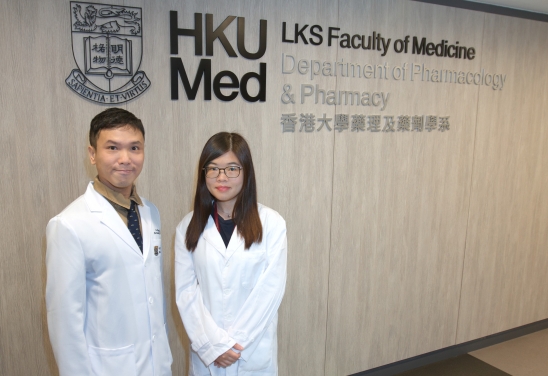
A study led by a research team of LKS Faculty of Medicine, The University of Hong Kong (HKUMed) in collaboration with Harvard Medical School, provided the first population-based evidence that a commonly used anti-osteoporosis drug, bisphosphonate, was associated with reduced risk of pneumonia and pneumonia mortality in patients with hip fracture, compared to non-treatment and other anti-osteoporosis treatment. The research team conducted a population-based study using an anonymised territory-wide healthcare database of the Hong Kong Hospital Authority. The aim was to investigate the risk of pneumonia with and without use of N-BPs in patients with hip fracture.
The study included over 50,000 patients with newly diagnosed hip fracture from 2005 through 2015. The team examined the treatment in these patients and matched the N-BP-treated and non-N-BP-treated patients by propensity scores (a statistical matching technique) to ensure their similarity. The matched patients were followed until December 31, 2016, and their risks of pneumonia and pneumonia-mortality were compared.Research findings There were 4,041 N-BP-treated patients and 11,802 non-treated patients in the final analysis. In the first year of follow-up, the team found that 6.9 per 100 persons vs. 9 per 100 persons of pneumonia being observed in N-BP-treated and non-treated patients, respectively, leading to 24% reduction in risk of pneumonia. N-BP-treated patients were also associated with 35% reduction in risk of pneumonia mortality, compared to non-treated patients. This beneficial tendency was observed when comparing N-BP-treated patients with patients treated with other anti-osteoporosis medications.
Source: The University of Hong Kong
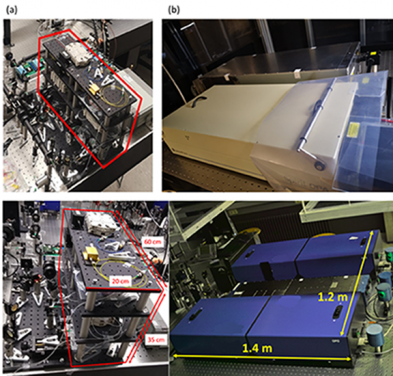
A research group led by Professor Kenneth K.Y. Wong of the Department of Electrical and Electronic Engineering at the University of Hong Kong (HKU), in collaboration with Bielefeld University in Germany, has developed a compact fibre laser microscope that brought breakthroughs to analysing molecules in cells and clinical applications. The newly innovated microscope generates far less noise than customary designs, and the compactness and stability make it suitable for use in operating rooms in hospitals.
When investigating how tumors grow, or how pharmaceuticals affect different types of cells, researchers have to understand how molecules within a cell react – and interact. This is possible with modern fluorescence microscopy. However, molecules in cell specimens had to be labelled with fluorescent substances to make them visible, and this can distort the very behavior of the molecules. Also the staining with fluorescent markers is generally unsuitable for in vivo tissues. Label-free microscopic imaging has always been a hot topic in biomedical research. The newly invented laser microscope does not require fluorescent markers to obtain a clear image of cell molecules. Instead, cell molecules with different level of characteristics are uniquely presented via a Raman Imaging System.
Source: The University of Hong Kong
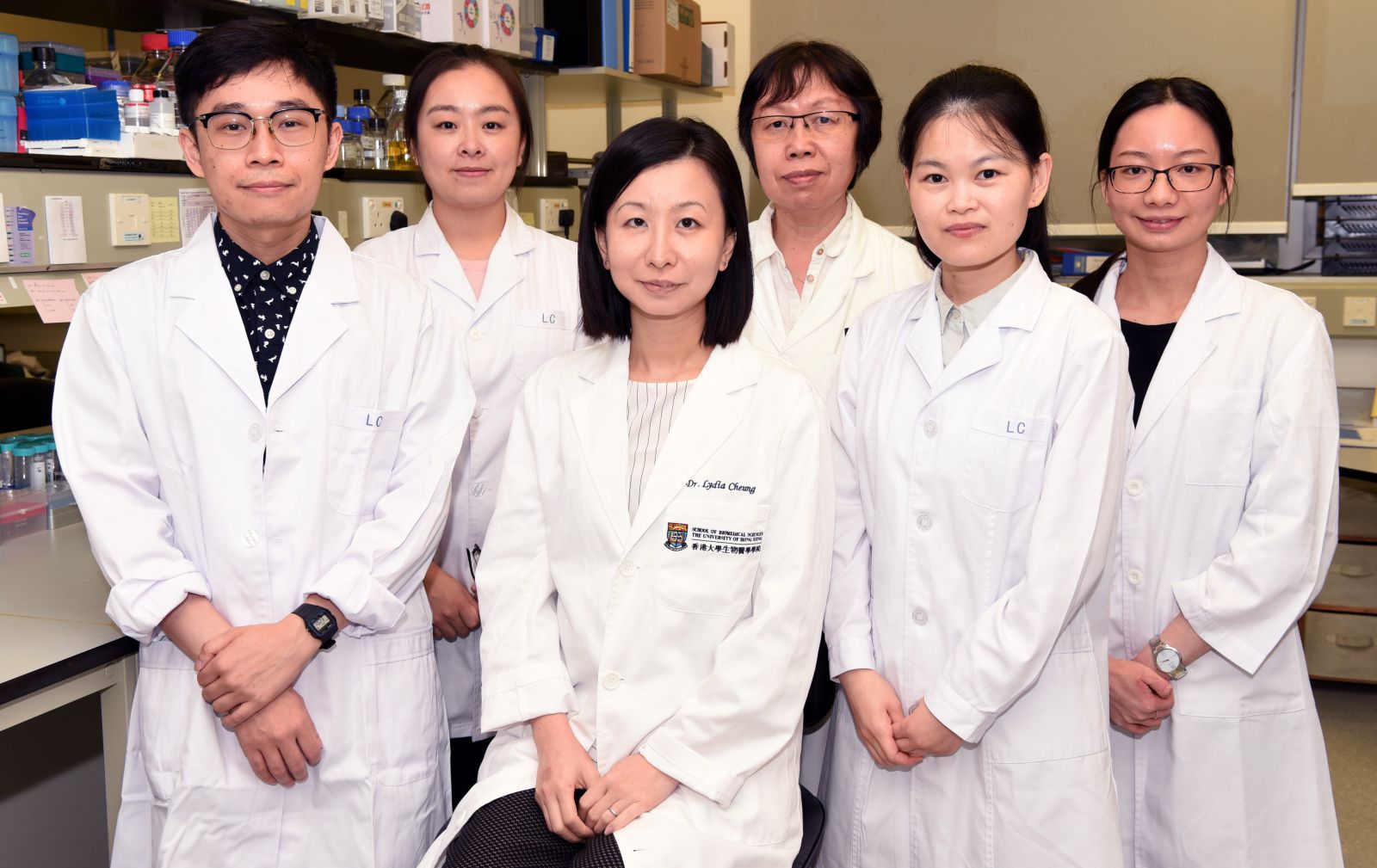
Ovarian cancer is the 6th most common cancer among women in Hong Kong. The latest figures show that 651 cases of ovarian cancer were diagnosed in 2017, with 219 deaths in the same year. The causes and the molecular events that lead to the development of the disease remain largely unknown. A study by researchers at the LKS Faculty of Medicine, The University of Hong Kong (HKUMed) has revealed a signalling pathway triggered by a protein called p85β to promote the growth and progression of ovarian cancer cells.
The research team discovered that p85β is often overexpressed in ovarian cancer cells, for example, through gene amplification. It is noteworthy that ovarian cancer patients with high levels of p85β showed worse survival outcomes, suggesting the clinical significance of p85β in the disease. In this study, it was found that p85β can enhance the growth and metastasis of ovarian cancer cells, providing an explanation of the high p85β levels in cancer cells and the associated worse prognosis. This study identified p85β as a novel protein that contributes to ovarian tumorigenesis. Cancer cells rely on p85β for growth, targeting the signal of p85β has therefore the potential to beat cancer. The findings lay the foundation for the future development of new treatments by inhibiting cancer growth at its roots.
Source: The University of Hong Kong

Researchers at the AIDS Institute, Department of Microbiology and State Key Laboratory of Emerging Infectious Diseases, LKS Faculty of Medicine of The University of Hong Kong (HKUMed), in collaboration with clinicians at Queen Mary Hospital, Pamela Youde Nethersole Eastern Hospital and Princess Margaret Hospital, conducted a study for determining the role of human immune responses in acute SARS-CoV-2 infection (within 3 weeks after infection) by investigating 17 acute and 24 convalescent COVID-19 patients as compared with healthy people in Hong Kong. The study demonstrated that acute SARS-CoV-2 infection impairs dendritic cell and T cell function, allowing the virus to evade host innate and adaptive defences for more efficient transmission and severe clinical diseases.
The major challenge for COVID-19 vaccine development is that we do not know the immune correlates of protection. In other words, we do not know what kind of vaccine-induced immune responses are needed for protection. We, therefore, aimed to learn from patients naturally infected by SARS-CoV-2. We reported earlier that significantly higher amount of neutralizing antibodies, that were induced supposedly to kill the virus, was actually found in severe COVID-19 patients in intensive care unit than that in mild patients. In this study, we further demonstrated that functionally impaired dendritic cells might underly the delayed killer T cell responses that are essential for eliminating SARS-CoV-2-infected cells. Therefore, an effective vaccine should induce balanced antibody and killer T cells for protection. Based on their findings, the research team has made two COVID-19 vaccines that have already entered the large scale of Good Manufacturing Practice (GMP) production for upcoming human trials.
Source: The University of Hong Kong
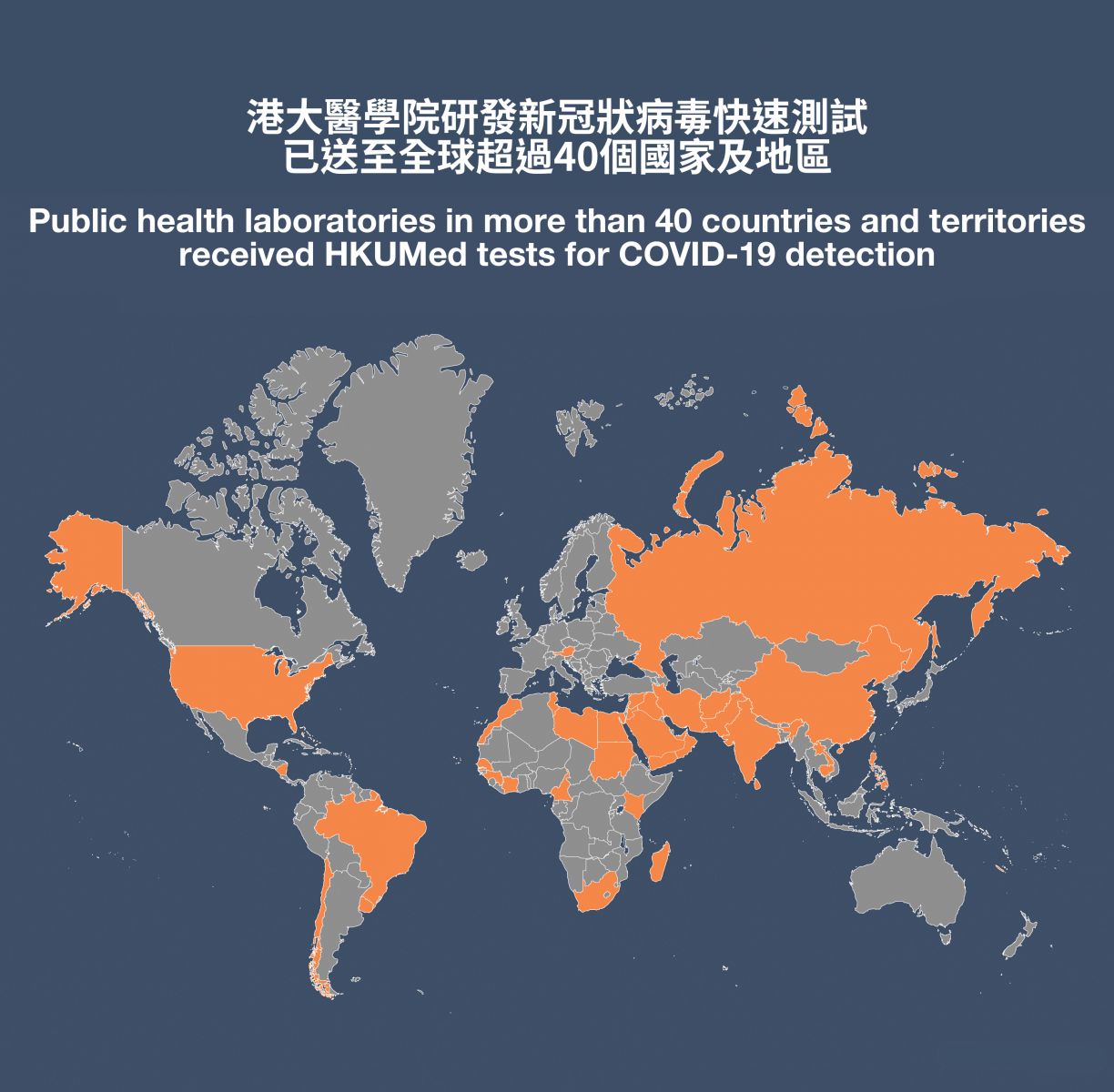
Rapid nucleic acid amplification tests that were developed by the LKS Faculty of Medicine of the University of Hong Kong (HKUMed) to detect the Coronavirus Disease 2019 (COVID-19) in patients are being used by public health care laboratories in more than 40 countries and territories. Some of these countries and territories have successfully identified confirmed cases. The tests were developed by Dr Daniel Chu Ka-wing, Professor Leo Poon Lit-man and Professor Malik Peiris from the Division of Public Health Laboratory Sciences in HKUMed’s School of Public Health in January and the reference materials and reagents have been freely provided to overseas laboratories so they can prepare for this epidemic and identify COVID-19 patients early.
This approach is highly sensitive and can detect minute amounts of viral RNA from samples within two hours. As of now, public health care laboratories in more than 40 countries and territories around the world have received reagents for the tests designed by HKUMed. Countries like Egypt, Cambodia and Nepal have successfully identified confirmed cases with these tests. The findings are currently available through the World Health Organization (WHO) and HKUMed. HKUMed’s School of Public Health is one of WHO Reference Laboratories for COVID-19 and it has been receiving samples from all over the world and providing testing on COVID-19.
Source: HKUMed
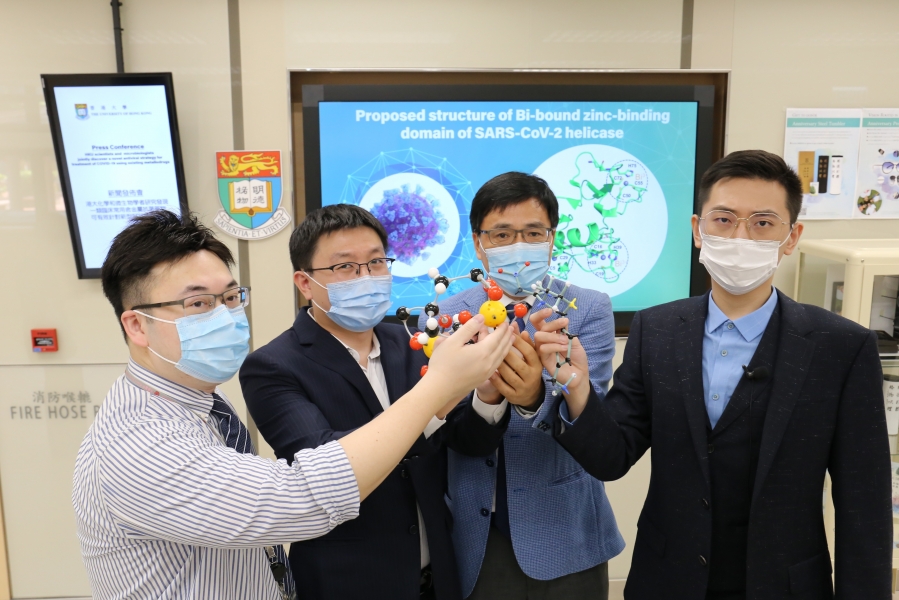
A research team led by Professor Hongzhe SUN, Norman & Cecilia Yip Professor in Bioinorganic Chemistry, Department of Chemistry, Faculty of Science, and Professor Kwok Yung YUEN, Henry Fok Professor in Infectious Diseases, Department of Microbiology, Li Ka Shing Faculty of Medicine of the University of Hong Kong (HKU), has discovered a novel antiviral strategy for treatment of COVID-19. They discovered that a class of metallodrugs currently used in the treatment of other infectious diseases is showing efficacy to potently suppress SARS-CoV-2 replication and relieve viral-associated symptoms in an animal model.
After screening a series of metallodrugs and related compounds, the research team identified ranitidine bismuth citrate (RBC), a commonly used anti-ulcer drug which contains the metal Bismuth for treatment of Helicobacter pylori-associated infection, as a potent anti-SARS-CoV-2 agent, both in vitro and in vivo. RBC has been demonstrated to greatly reduce viral loads by over 1,000-folds in SARS-CoV-2-infected cells. RBC remarkably diminishes the level of prognostic markers and other major pro-inflammatory cytokines and chemokines in severe COVID-19 cases of infected hamsters, compared to the Remdesivir-treated group and control group. RBC exhibits a low cytotoxicity with a high selectivity index at 975 (the larger the number the safer the drug), as compared to Remdesivir which has a low selectivity index at 129. The finding indicates a wide window between the drug’s cytotoxicity and antiviral activity, which allows a great flexibility in adjusting its dosages for treatment. The research findings highlight viral helicases as a druggable target, and the high clinical potential of bismuth(III) drugs and other metallodrugs for treatment of SARS-CoV-2 infections. Hopefully, following this important breakthrough, more antiviral agents from readily available clinically approved drugs could be identified for potential treatment of COVID-19 infections. They can be in the form of combination regimens (cocktails) with drugs that exhibit anti-SARS-CoV-2 activities including RBC, dexamethasone and interferon-β1b.
Source: The University of Hong Kong
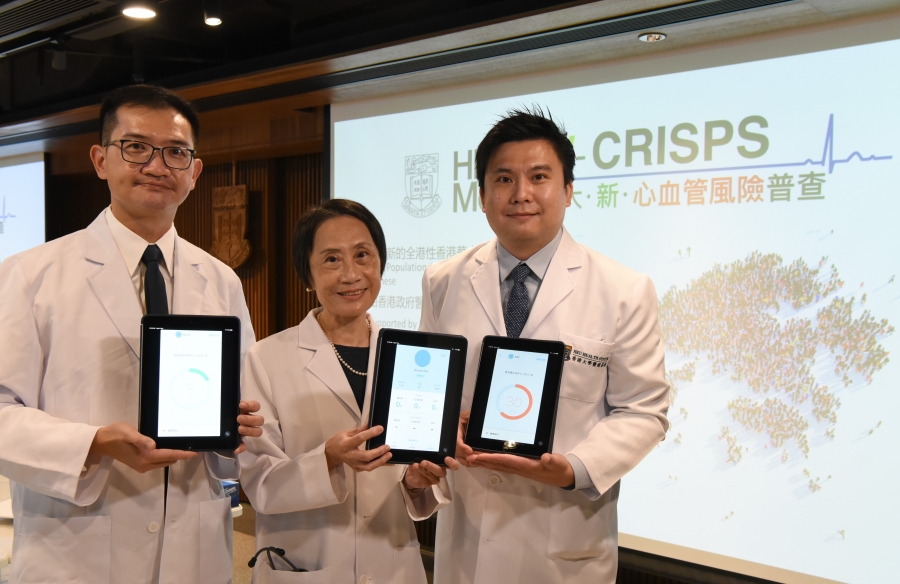
Many people with diabetes are asymptomatic and remain undiagnosed until serious complications have developed. To address this health issue, a research team at LKS Faculty of Medicine, The University of Hong Kong (HKUMed), has developed a simple risk score, using the findings of “The Hong Kong Cardiovascular Risk Factor Prevalence Study (CRISPS)”, for identifying individuals at risk of undiagnosed diabetes and encouraging early diagnosis in high-risk individuals. The Non-invasive Diabetes Score (NDS) is calculated on the basis of age, body height, body weight and high blood pressure. The research team has also developed a smartphone app “HK CRISPS Health Risk Engines” to facilitate the calculation of NDS and the prediction of heart attack/stroke and cancer.
The Hong Kong Cardiovascular Risk Factor Prevalence Study (CRISPS), led by researchers of HKUMed, was the first population-based study with comprehensive assessment for cardiovascular risk factors, including diabetes, among Hong Kong Chinese. The research, commenced in 1995-96, involved around 2,000 participants in follow-up study in the subsequent 20 years to track their development of these risk factors and cardiovascular diseases.The research team has developed a smartphone app “HK CRISPS Health Risk Engines” to facilitate the calculation of NDS. Moreover, this app also contains other risk engines for the prediction of heart attack/stroke and cancer, based on CRISPS. Users simply input basic health information and follow the in-app instructions to calculate their health risks. Health advice comes along with the results of each risk assessment. Users who are assessed to be “high risk” are advised to seek medical advice for further investigations, while other “lower risk” users are encouraged to keep up with healthy lifestyle and evaluate their health risks with this app at regular intervals. The app allows the creation of a maximum of six user accounts per smartphone. All records are kept offline and users can track their own records from the app at any time.
Source: The University of Hong Kong

A research team at LKS Faculty of Medicine, The University of Hong Kong (HKUMed) in collaboration with overseas and Mainland researchers discovered abnormal beta-amyloid deposition to be a novel disease mechanism for biliary atresia (BA). The ground-breaking finding provides insights into new diagnostic and therapeutic strategies for BA, a devastating newborn liver disease with unknown cause till now.
Source: The University of Hong Kong

A research team at the Department of Paediatrics and Adolescent Medicine, LKS Faculty of Medicine, The University of Hong Kong (HKUMed) discovered a novel gene CC2D1A that is associated with human heterotaxy, a spectrum of congenital disease that disrupts the arrangement of internal organs.
The team utilised whole exome sequencing technology to identify the disease-causing mutations in 26 patients with heterotaxy. Whole exome sequencing refers to the sequencing of all the coding regions of all genes (approximately 20,000 genes) in the human genome. The whole exome sequencing results showed that no pathogenic mutations can be identified in known genes associated with heterotaxy. Therefore, the team tried to identify new genes that have not been associated with heterotaxy. By comparing the mutations identified in patients with controls, there was a significant enrichment of CC2D1A damaging variants in patients.
Source: The University of Hong Kong

Stroke is a major cause of permanent disability and death worldwide, whereby ischaemic stroke accounts for more than 80 % of its incidence. However, treatment methods are limited and tissue plasminogen activator is the only pharmacological treatment for acute ischaemic stroke approved by the U.S. Food and Drug Administration. Thus, there is an urgent need for the development of new and effective pharmacological therapies to improve the outcome of ischaemic stroke.
The blood-brain barrier is a highly selective semipermeable membrane that restricts the entrance of the blood-borne substances into the brain thus maintaining cerebral homeostasis to allow proper function of the neurons. Blood-brain barrier-disruption after ischemic stroke is a key event that precedes various neurological disorders while the contributing factors that govern the process remain unclear. A research team from the LKS Faculty of Medicine, The University of Hong Kong (HKUMed) has discovered a new regulator of blood-brain barrier disruption in ischaemia stroke. The discovery provides insight into the new mechanism of blood-brain barrier disruption which allows the future development of effective pharmacological therapy for patients with ischemia stroke.
Source: The University of Hong Kong
2021
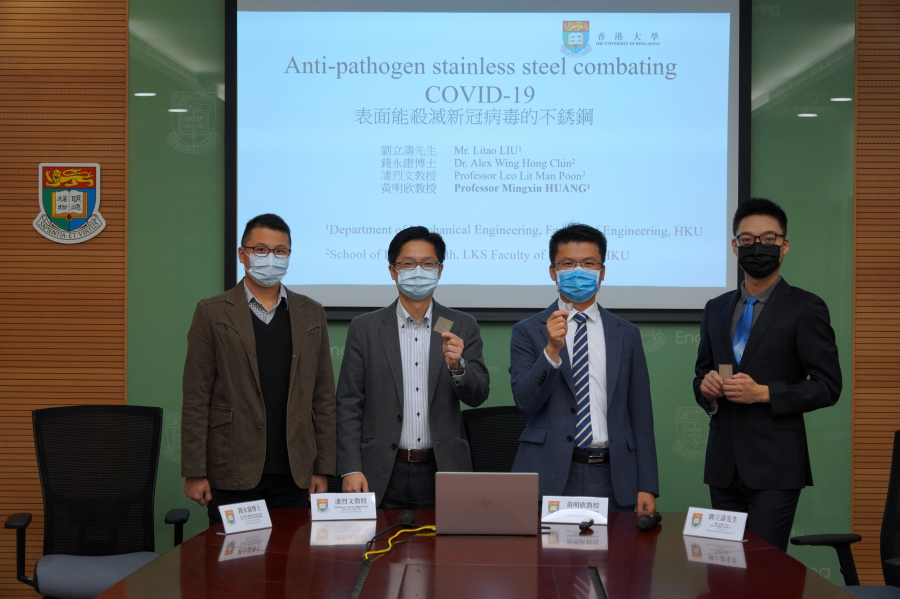
The project team led by Professor Mingxin HUANG at the Department of Mechanical Engineering of the Faculty of Engineering of the University of Hong Kong (HKU), in collaboration with Professor Leo Lit Man POON’s research team at the Centre for Immunity and Infection of the LKS Faculty of Medicine of HKU, has made significant breakthroughs in producing the first anti-COVID-19 stainless steel that kills the severe acute respiratory syndrome coronavirus 2 (SARS-Cov-2) on its surface. The anti-COVID-19 stainless steel can also inactivate the H1N1 virus and E.coli on its surface.
Source: The University of Hong Kong
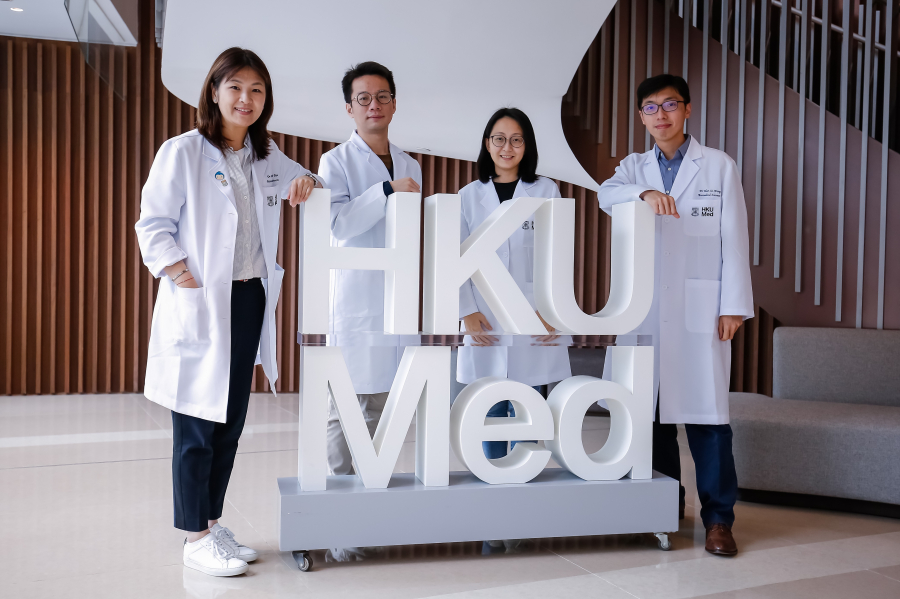
A research team of LKS Faculty of Medicine, The University of Hong Kong (HKUMed) has successfully repurposed an approved drug ifenprodil, a vasodilator, to be used in combination with the FDA-approved first-line drug sorafenib for hepatocellular carcinoma (HCC) treatment. This study leveraged on their CombiGEM-CRISPR v2.0 screening platform1 to expedite the search among the many possible drug combinations to inhibit druggable targets in the genome for treating HCC.
Source: The University of Hong Kong
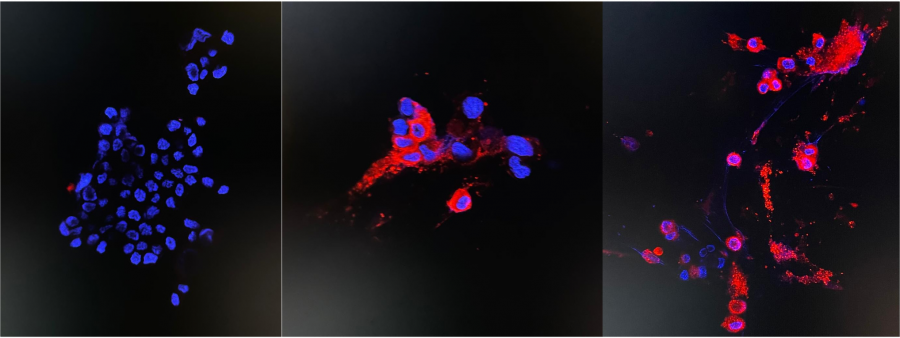
Researchers at the Department of Microbiology at The University of Hong Kong have succeeded in the isolation of SARS-CoV-2 Omicron variant from clinical specimens. This is the first known research team in Asia that has succeeded in isolating the Omicron variant. The isolated variant will enable the development and production of vaccines against Omicron, which has been designated as a "variant of concern" by the World Health Organization. The research team is now working on expanding the virus for use in assessing its transmissibility, immune evasion capability, and pathogenicity in animal models. The team is also exploring opportunities for urgent development and production of inactivated whole virus vaccines.
Source: The University of Hong Kong
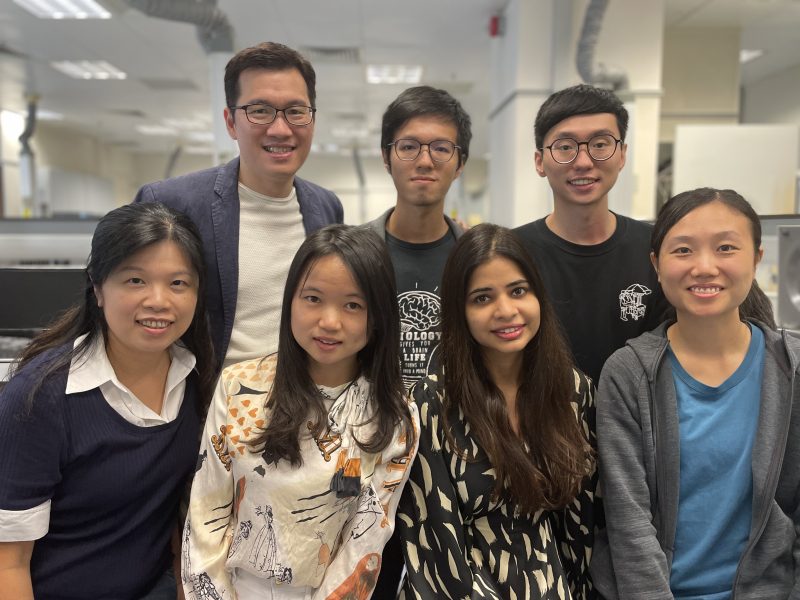
A decline in metabolism and endurance of skeletal muscle is commonly observed in obese patients, but the underlying mechanism is not well-understood. A research team led by Dr Chi Bun CHAN, Assistant Professor from School of Biological Sciences, Faculty of Science, the University of Hong Kong (HKU), uncovers a new mechanism to explain how obesity jeopardizes the functions of skeletal muscle and provides a potential treatment against the disease. The research findings have recently been published in world-leading scientific journal Autophagy.
Obesity is a metabolic disorder with increasing prevalence in modern society. Since 1970s, the global number of obese people has trebled and reached 650 million (~ 13% of the total global population) in 2016. It is widely known that obesity provokes detrimental outcomes in multiple human organs and causes numerous chronic disorders such as diabetes, hypertension, fatty liver diseases, and atherosclerosis. Fat metabolism in the skeletal muscle of obese patients is slower than that of healthy people, which scientists believe is a consequence of abnormal functions in mitochondria (the powerhouses of a cell that convert nutrients into biological energy). However, how obesity impairs the activity of mitochondria is a long unresolved question.
Source: The University of Hong Kong

Diamonds are precious stones used for jewelleries and industrial purposes. But in the not-too-distant future, diamond nanoparticles, or nanodiamonds (NDs), may become the solution to everyone’s oral health. Oral diseases such as dental caries (decay), gum diseases and fungal infections are major global health care problems, resulting in expenditures of millions of dollars every year and yet, have no established solutions. Complex microbial communities, typically occurring as disease-causing bacteria and fungi attaching to teeth surfaces and forming biofilm communities, are the main causes of infections. The National Institutes of Health states that 65-80% of all human infections are formed by biofilms. In a journal article published in Biomaterials Science titled “Biofilm inhibition in oral pathogens by nanodiamonds”, scientists from the Faculty of Engineering and the Faculty of Dentistry of the University of Hong Kong (HKU) revealed for the first time the inhibitory effect on oral pathogenic biofilms by high-pressure high-temperature (HPHT) NDs.
Source: The University of Hong Kong
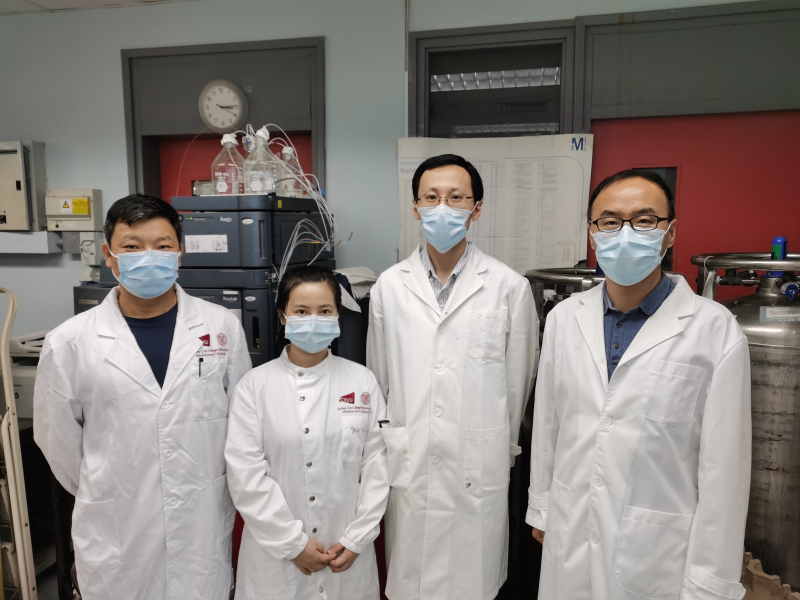
Recently, the teams led by Professor Xuechen LI from Department of Chemistry, Faculty of Science, The University of Hong Kong (HKU) and Professor Sheng CHEN from the Department of Infectious Diseases and Public Health of City University of Hong Kong (CityU), joined hands and made a breakthrough in vaccination development against lethal bacteria Acinetobacter baumannii. Their studies have been published in ACS Central Science.
Source: The University of Hong Kong

A joint research team from The Chinese University of Hong Kong (CUHK) and The University of Hong Kong (HKU) has recently developed a soft robotic manipulator for transoral laser microsurgery on head and neck cancer, guided by intra-operative magnetic resonance (MR) imaging (MRI). Researchers from the Department of Otorhinolaryngology, Head and Neck Surgery, Faculty of Medicine, CUHK (CU Medicine), together with the Department of Mechanical Engineering, Faculty of Engineering, and the Faculty of Dentistry, both from HKU, collaborated to develop this novel MR-safe system in miniature size, with compliant architecture and five degrees of freedom, which enables safe and dexterous laser ablation within the confined spaces of the oral and pharyngeal cavities. Ex-vivo tissue ablation and a cadaveric head-and-neck trial were carried out under MRI, demonstrating that the system can utilise MR thermometry to precisely monitor the tissue ablation margin and thermal diffusion during the procedure.
Source: The University of Hong Kong
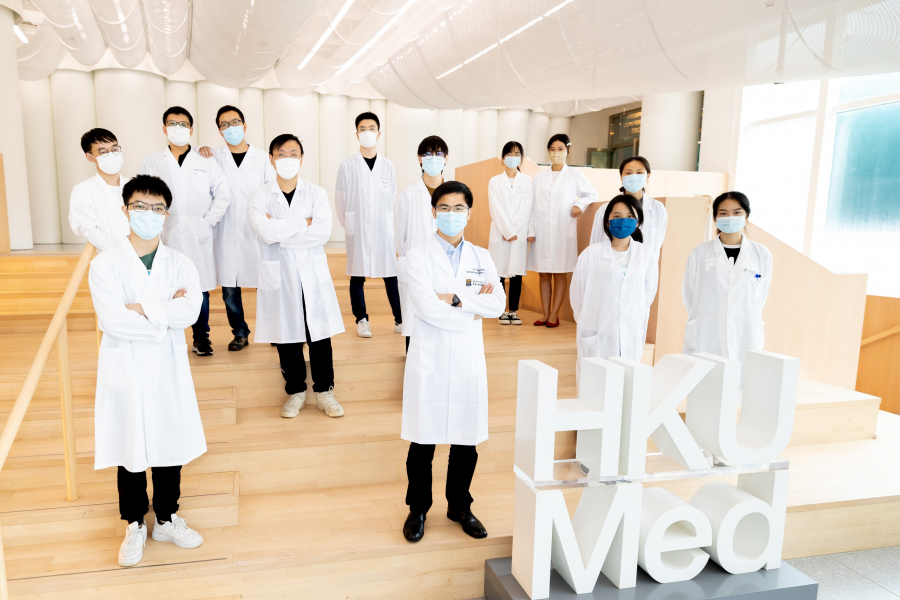
Researchers at LKS Faculty of Medicine, The University of Hong Kong (HKUMed) and collaborators from the School of Basic Medical Sciences, Fudan University, Shanghai, have developed an ‘intravenous injection plus light-triggered intraocular drug release’ strategy to achieve drug accumulation in retinoblastoma. The strategy avoids invasive intravitreal drug administration and shows promise in treating retinoblastoma and other eye diseases. The research has just been published in Advanced Science, and a Patent Cooperation Treaty (PCT) patent application has been filed based on this work.
Source: The University of Hong Kong
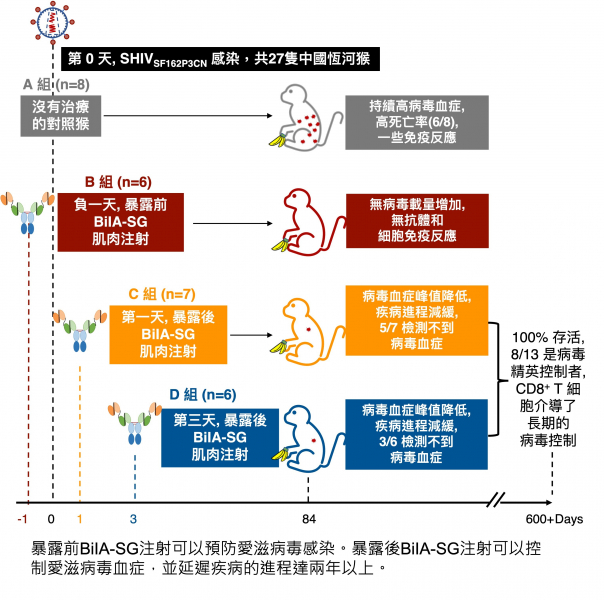
A multi-institutional research team led by scientists at the AIDS Institute and Department of Microbiology, LKS Faculty of Medicine of The University of Hong Kong (HKUMed) has identified BilA-SG, a tandem bi-specific broadly neutralising antibody, as a promising universal drug for human immunodeficiency virus-1 (HIV-1) prevention and functional cure. A single pre-exposure intramuscular injection of BilA-SG was found to be 100% effective in preventing a pathogenic virus and a similar post-exposure treatment sustained 100% survival and complete virus suppression in most of the non-human primate models for two years.
Source: The University of Hong Kong

A research team from the Department of Orthopaedics and Traumatology, LKS Faculty of Medicine, The University of Hong Kong (HKUMed) has designed a honeycomb-like nanoscale structure on titanium (Ti) alloy surface to better facilitate implant-to-bone integration. This specific surface structure can substantially accelerate the integration of Ti surface to host bone from 6-8 months to 2-4 months after surgery. This discovery, which provides insight to the design of new generation of prosthesis, bone fracture fixation device and dental implant that require speedy fusion between bone and implant, has been published in Science Advances.
Source: The University of Hong Kong

Orthopaedic surgeons at the Department of Orthopaedics and Traumatology of Li Ka Shing Faculty of Medicine, The University of Hong Kong (HKUMed) describe a unique paediatric cervical spine deformity, termed ‘Occipital-Atlantoaxial Rotatory Dislocation’ (OAARD), that could result in neck and facial deformity, permanently abnormal head and neck movement, and potential life-threatening neurological injury if left untreated. Parents and primary care physicians seeing children with a ‘wry neck’ are strongly urged to seek early specialist attention before it is too late. The HKUMed specialists also sternly advise against inappropriate physical treatment until proper assessment to avoid worsening the situation.
Source: The University of Hong Kong
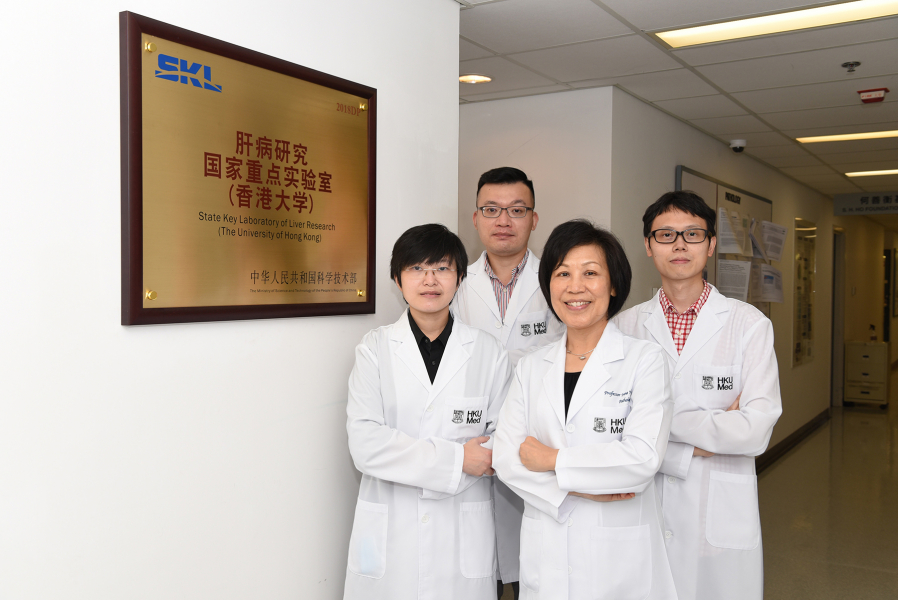
Researchers at the LKS Faculty of Medicine of The University of Hong Kong (HKUMed) have uncovered the important roles of tumour-associated macrophages and identified an important TIGIT-NECTIN2 immune checkpoint axis (interacting partners) in liver cancer, which helps to create an immunosuppressive microenvironment in promoting the growth of liver cancer, meanwhile indicating the possibility to restore the immune attack on tumour cells by inactivating the immune checkpoint. The novel and translational findings provide useful pre-clinical foundation and mechanistic insight for developing onco-immunotherapeutics in precision liver cancer treatment.
Source: The University of Hong Kong
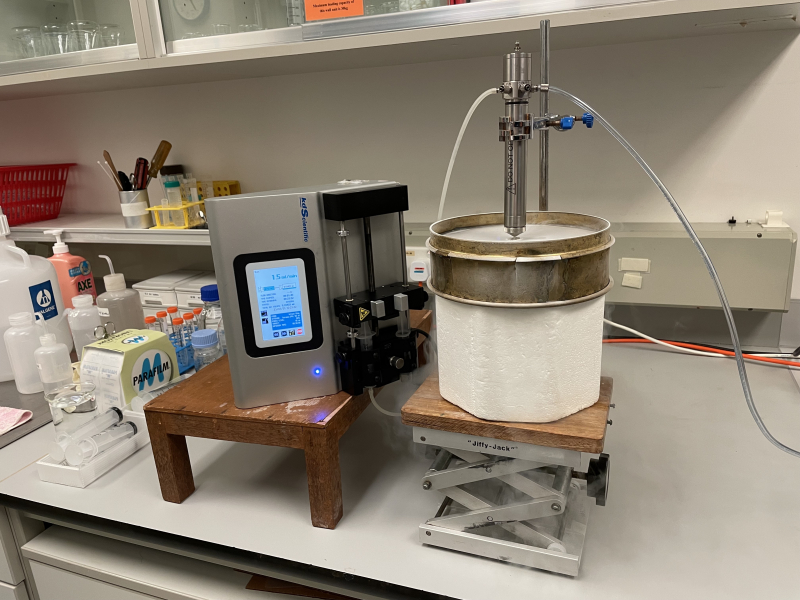
The collaborative research team formed by the Department of Pharmacology and Pharmacy and Department of Microbiology, LKS Faculty of Medicine, The University of Hong Kong (HKUMed) has developed an inhalable dry powder formulation of tamibarotene, a repurposed drug that exhibits broad-spectrum antiviral activity against SARS-CoV-2, MERS-CoV and influenza A H1N1 virus following pulmonary delivery. A provisional application has been filed to the United States Patent and Trademark Office based on this work.
Source: The University of Hong Kong

Advanced devices developed by a mechanical engineering team at the University of Hong Kong (HKU) has proven to be useful for detecting potential stroke patients and helping machines mimic human brain functions. In a collaboration with Nanjing University, Dr Paddy K.L. Chan, Associate Professor at the Department of Mechanical Engineering, developed a novel wearable electrocardiogram (ECG) sensor by integrating flexible, ultra-thin organic semiconductors into a flexible polyimide substrate. Powered by button battery, the sensor has outstanding signal amplification properties with a gain larger than 10,000, which allows it to detect electrophysiological signal, or f-wave with a frequency of 357 beats per minute (BPM), which indicates atrial fibrillation.
Source: The University of Hong Kong

A research team from the LKS Faculty of Medicine, The University of Hong Kong (HKUMed) has discovered a new regulator mediating the onset and progression of liver fibrosis. The discovery provides insight into the new mechanism of hepatic fibrogenesis that allows the future development of effective pharmacological therapy for patients with liver fibrosis. Liver fibrosis is the advanced stage of chronic liver disease that can proceed to cirrhosis and may ultimately result in liver cancer. Although both human and animal studies show that liver fibrosis is potentially reversible, no medication approved by the Food and Drug Administration (FDA) of the United States is available, suggesting the underlying mechanism are still poorly understood. Thus, there is an urgent need for the development of new and effective pharmacological therapies to improve the outcome of liver fibrosis.
Source: The University of Hong Kong
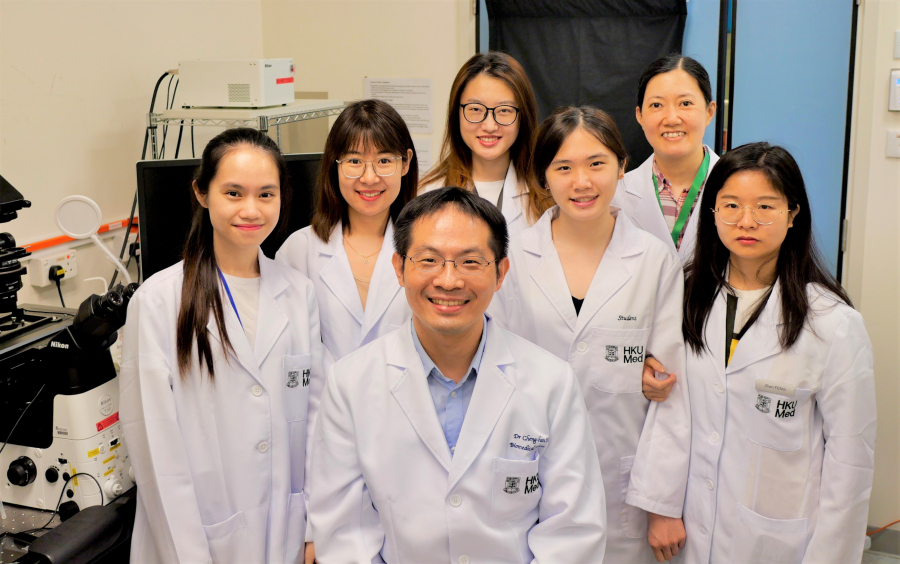
A research team of cell biologist in LKS Faculty of Medicine, The University of Hong Kong (HKUMed) has discovered how to impede invasive cell migrations by blocking the synthesis of PI(3,4)P2 lipids that are excessively produced in cancer cells. By the inhibition of PI(3,4)P2 synthesis, invasive cell migrations are effectively suppressed in various models, including in the triple-negative breast cancer cell line. This study has revealed a druggable target to suppress cancer metastasis, the malignant spread of cancer cells, which ranks highest in the cause of health-related mortality in Hong Kong.
Source: The University of Hong Kong
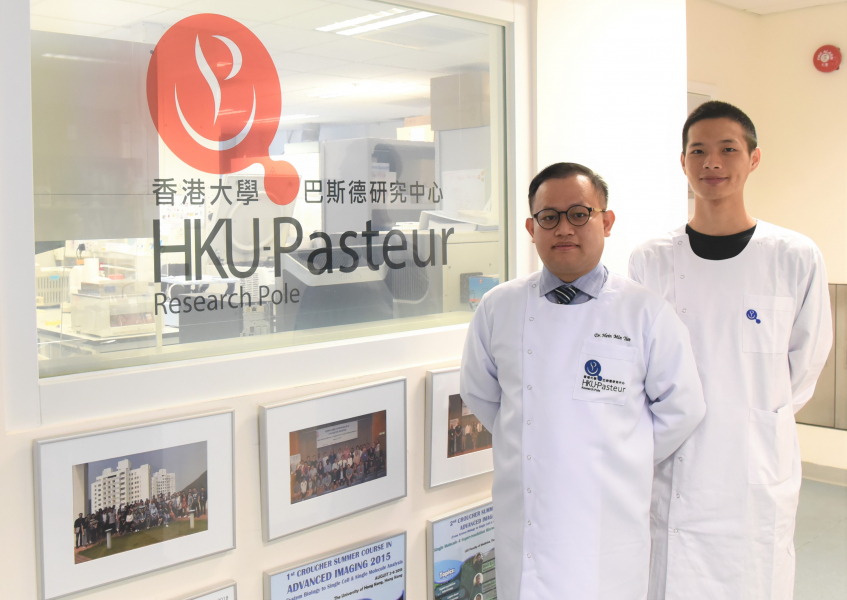
Researchers from HKU-Pasteur Research Pole (HKU-PRP) at the School of Public Health, LKS Faculty of Medicine of The University of Hong Kong (HKUMed), in collaboration with their Canadian collaborators, discovered for the first time a causal link between caesarean section birth, delayed gut microbiota development (persistently low Bacteroides, high Proteobacteria and colonised with Clostridium difficile) and peanut sensitivity in infants. In addition, the effect is also found to be almost four times as more pronounced in children of Asian descent than others.
Source: The University of Hong Kong
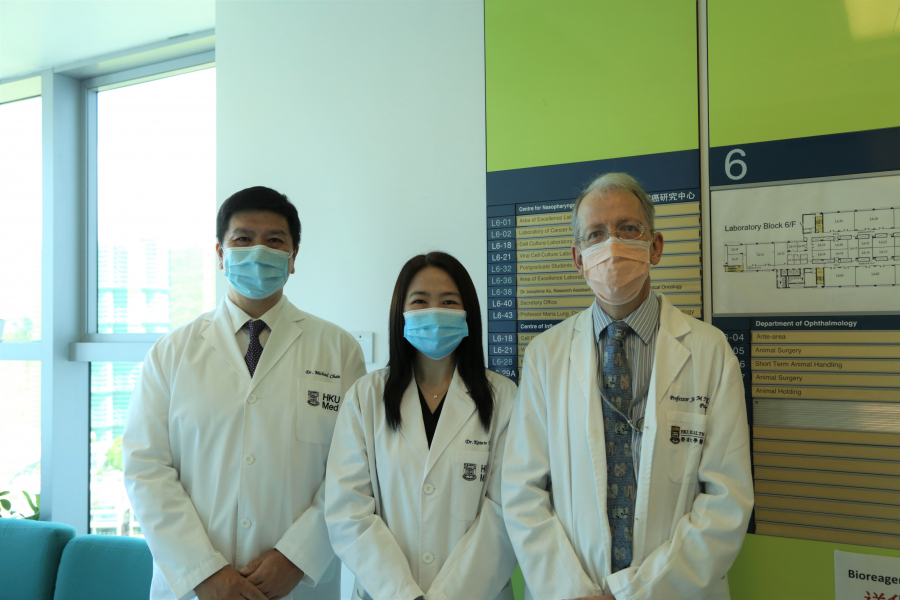
A study led by researchers from the LKS Faculty of Medicine at The University of Hong Kong (HKUMed) discovered the mechanisms of how infection with SARS-CoV-2 virus can lead to lung injury and vascular damage. It is the first study worldwide to demonstrate such mechanism. In addition, the research team found that Imatinib, an FDA-approved oral targeted therapy drug, may work as a potential treatment for COVID-19 induced vascular diseases by modulating the dysregulated immune responses induced by SARS-CoV-2 in endothelial cells.
Source: The University of Hong Kong

The research teams at the University of Hong Kong led by Professor Xuechen LI from the Research Division for Chemistry and Department of Chemistry, and Professor Yu WANG from the Department of Pharmacology and Pharmacy, reported a synthetic biotherapeutics with promising anti-tumour, insulin sensitising and hepatoprotective activities. The teams have been working on the development of synthetic compounds which can mimic the bioactivity of adiponectin over the past seven years. Finally, they developed an efficient synthetic approach to produce the adiponectin-derived glycopeptides that exhibit potent anti-tumour, insulin-sensitising and metabolic activities in various mouse models. The products hold greater potentials for clinical application in obesity and related medical complications, such as type 2 diabetes, hypertension, coronary heart disease, stroke, chronic kidney disease and cancer.
Source: The University of Hong Kong
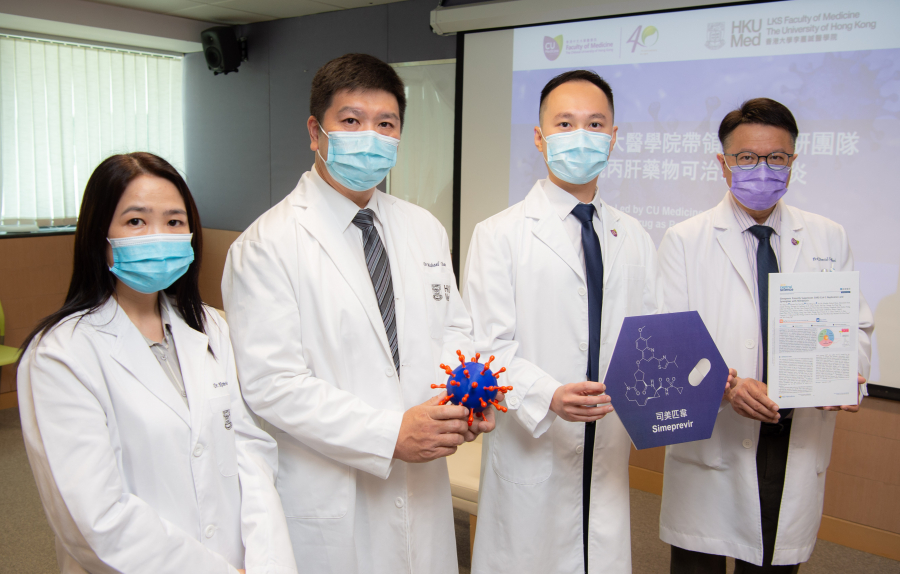
A recent global study led by researchers from the Faculty of Medicine at The Chinese University of Hong Kong (CU Medicine) and the LKS Faculty of Medicine at The University of Hong Kong (HKUMed) has discovered a hepatitis C virus drug “simeprevir” as a potent treatment for COVID-19, which can strongly suppress the replication of SARS-CoV-2. The combination of this drug with remdesivir can result in drug synergism and generate an even more effective outcome. Simeprevir is by now the only antiviral drug that can target more than one SARS-CoV-2 protein, meaning it can still function even if one of the proteins becomes mutated. The drug has great therapeutic potential and with less chance to develop drug-resistant mutants.
Source: The University of Hong Kong
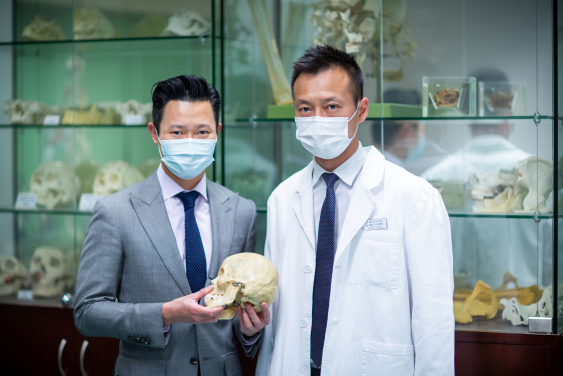
Conventional approach to most types of temporomandibular joint and muscle disorder (TMD) begins with conservative treatment options, such as non-steroidal anti-inflammatory (NSAIDs), physiotherapy, soft diet and occlusal splint etc. When clinical improvement is not observed with conventional approach, arthrocentesis will be offered to patients with joint dysfunction. Arthrocentesis has been a standard treatment since the early 1990s, which involves the application of two small needles near the TMJ, and the joint is washed thoroughly with Normal Saline with the aim to clear the inflammatory substances and fibrous adhesion of the joints, and to reduce the negative pressure inside the TMJ. Arthrocentesis is a simple and safe treatment, which normally takes around 15-20 minutes in the clinical setting, with a high efficacy of 80-85%. Clinical Assistant Professor Dr Dion Li (Principal investigator) and Clinical Associate Professor Dr Mike Leung from the Oral and Maxillofacial Surgery of HKU Faculty of Dentistry recently applied arthrocentesis and occlusal splint as an integrated treatment for TMDs. A study with arthrocentesis as the first-line treatment was also conducted and compared to the efficacy of the conventional approach. From the preliminary results (Attachment 1), the research team discovered that the integrated treatment with arthrocentesis and splint was more effective compared to conservative treatment alone.
Source: The University of Hong Kong

Mount Sinai researchers, in a collaboration with scientists at the LKS Faculty of Medicine, The University of Hong Kong (HKUMed), have found that a widely available and inexpensive drug targeting inflammatory genes has reduced morbidity and mortality in mice infected with SARS-CoV-2, the virus that causes COVID-19. In a study published in Cell, the team reported that the drug, topotecan (TPT), a specific inhibitor of Topoisomerase I (TOP1), inhibited the expression of inflammatory genes in the lungs of mice as late as four days after infection, a finding with potential implications for treatment of humans.
Source: The University of Hong Kong

In the first and largest study of its kind among Hong Kong Chinese, a research team at LKS Faculty of Medicine, The University of Hong Kong (HKUMed) has identified 531 rare and predicted deleterious variants in 108 pharmacogenes, among which 96 have never been reported in widely recognised databases. However, these variants were commonly found among Hong Kong Chinese, most of whom (93.6%) having at least one of them. Besides, almost all (99.6%) Hong Kong Chinese residents harboured at least one actionable pharmacogenetic variant, which may impact the effectiveness of drug treatment. This study demonstrates the potential of pharmacogenetics in personalised prescription of medicine for reduced risk of adverse reactions and enhanced drug efficacy.
Source: The University of Hong Kong
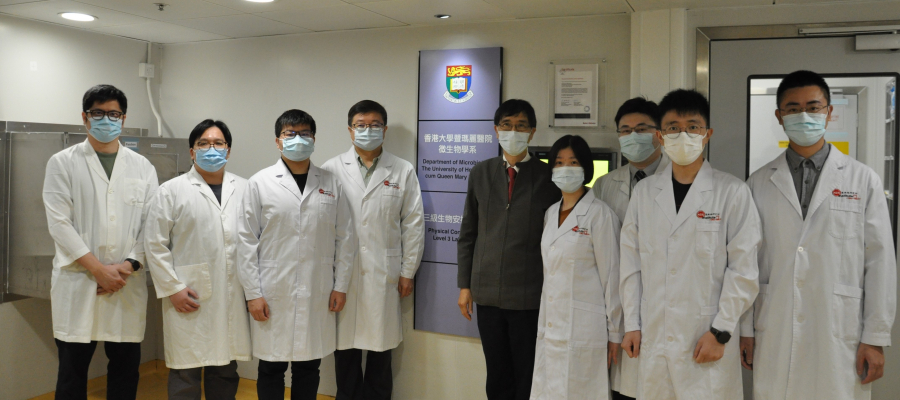
Researchers at the AIDS Institute, Department of Microbiology and State Key Laboratory of Emerging Infectious Diseases, LKS Faculty of Medicine of The University of Hong Kong (HKUMed), in collaboration with scientists at Tsinghua University and Columbia University, conducted a study for determining site-specific prevention of SARS-CoV-2 in nasal turbinate of Syrian hamsters by investigating systemic human neutralising antibodies (HuNAb) and a spike-based DNA vaccine. The study demonstrated that systemic HuNAb or vaccine failed to fully prevent SARS-CoV-2 infection in the nasal turbinate of the hamsters. Robust SARS-CoV-2 infection in the nasal turbinate may help the virus to evade systemic HuNAb.
Source: The University of Hong Kong
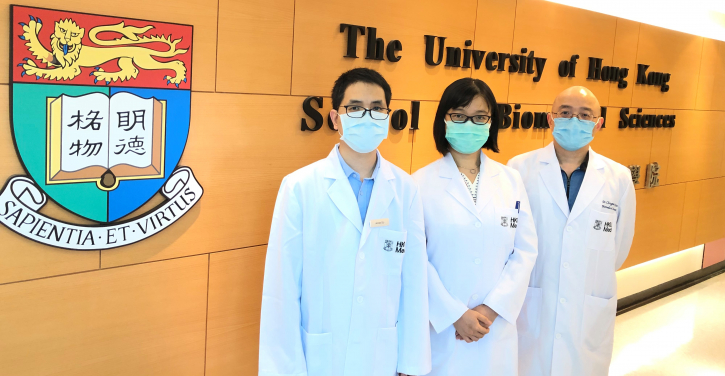
A research team at the School of Biomedical Sciences, LKS Faculty of Medicine, The University of Hong Kong (HKUMed) identified a stable Spindlin1/C11orf84 protein complex preferentially recognises a non-canonical bivalent histone H3K4me3K9me3 mark and promotes rRNA transcription. The study has opened a new therapeutic avenue to design inhibitors targeting Spindlin1/C11orf84 complex for cancer therapy.
Source: The University of Hong Kong

The Department of Medicine of LKS Faculty of Medicine, The University of Hong Kong (HKUMed) has successfully performed Chimeric Antigen Receptor T-cell (CAR-T cell) treatment for a patient with B-cell acute lymphoblastic leukaemia, who relapsed after bone marrow transplantation and was refractory to salvage chemotherapy. This is the first time that CAR-T cell therapy has been used outside clinical trials to treat blood cancer patients in Hong Kong. The treatment was carried out by the Division of Haematology, Medical Oncology and Haemopoietic Stem Cell Transplantation, Department of Medicine, HKUMed and Queen Mary Hospital. In fact, the team performed the first ever CAR-T cell therapy in Hong Kong (for a lymphoma patient) in May 2020. From then, Queen Mary Hospital is not only the first, but also the only centre in Hong Kong to perform CAR-T cell treatment for patients with blood cancers. The team believes this therapy has set the new direction for cancer treatment in future, which is expected to benefit more patients in similar conditions.
Living Medicine: CAR-T are genetically modified T cells to target and destroy cancers
In general, the curative effect of conventional therapy for recurrent acute lymphocytic leukemia or lymphoma is far from satisfactory. Repeated chemotherapy induces limited response. A few patients may be cured by haematopoietic stem cell transplantation, but there are transplant related toxicities. Some patients may still relapse after the transplant.
In recent years, the medical profession has been researching on immunotherapies with longer-lasting curative effects, including CAR-T cell therapy, which kill cancer cells through the patient’s own immune system. Under CAR-T cell therapy, normal T cells are harvested from the patient. A ‘chimeric antigen receptor’, which allows T cells to identify a specific type of cancer cells, is added to these T cells ex vivo. Genetically modified CAR-T cells are then re-infused to the patient, so that they can locate the cancer cells and eliminate them. This is the latest technology of cell therapy. CAR-T cell therapy effectively improves the chance of cure. According to the statistics of the Hong Kong Cancer Information and Statistics Center of the Hospital Authority, more than 100 patients are suitable for this treatment each year.
Source: The University of Hong Kong
A research team led by Professor Hongzhe SUN, Norman & Cecilia Yip Professor in Bioinorganic Chemistry and Chair Professor from Research Divison for Chemistry and Department of Chemistry, Faculty of Science, in collaboration with Dr Richard Yi-Ysun KAO, Associate Professor from the Department of Microbiology, Li Ka Shing Faculty of Medicine, and Dr Aixin YAN, Associate Professor from School of Biological Sciences, the University of Hong Kong (HKU), discovers that silver (Ag)-based antimicrobials can effectively combat antibiotic resistant Staphylococcus aureus by targeting multiple biological pathways via functional disruption of key proteins and can be further exploited to enhance the efficacy of conventional antibiotics as well as to resensitise methicillin-resistant Staphylococcus aureus (MRSA) to antibiotics. The study resolves the long-standing question of the molecular targets of silver in Staphylococcus aureus and offers insights into the sustainable bacterial susceptibility of silver, providing a new approach for combating antimicrobial resistance.
Source: The University of Hong Kong
Ants are omnipresent, and we often get blisters after an ant bite. But do you know the molecular mechanism behind it? A research team led by Professor Billy K C CHOW from the Research Division for Molecular and Cell Biology, Faculty of Science, the University of Hong Kong (HKU), in collaboration with Dr Jerome LEPRINCE from The Institut national de la santé et de la recherche médicale (INSERM) and Professor Michel TREILHOU from the Institut National Universitaire Champollion in France, have identified and demonstrated a novel small peptide isolated from the ant venom can initiate an immune pathway via a pseudo-allergic receptor MRGPRX2. The study has recently been published in a top journal in Allergy – The Journal of Allergy and Clinical Immunology.
Source: The University of Hong Kong
Scientists from the LKS Faculty of Medicine, The University of Hong Kong (HKUMed), contributing as part of the ‘Genetics of Osteoarthritis (GO)’ consortium to the world’s largest study of over 800,000 individuals, have identified genetic risk factors – variants associated with SOX5 and CHST3 genes, key regulators of the development of the intervertebral discs, to be implicated in spine osteoarthritis (OA). The findings are now published in CELL, a premier scientific journal. OA is the degeneration of joints, and a major cause of pain and disability in older people. There is no cure for OA because the causes are complex and the mechanisms are unclear. Therefore, identifying the risk factors for the disease is crucial and urgent to guide the development of novel treatments that will benefit patients.
Source: The University of Hong Kong
2022
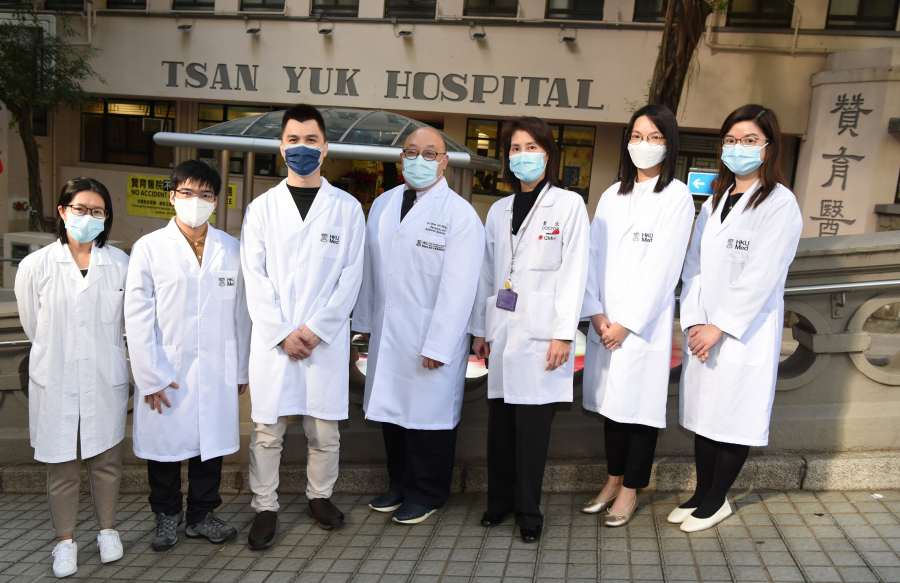
A clinical research team from the Department of Paediatrics and Adolescent Medicine and the Department of Obstetrics and Gynaecology, School of Clinical Medicine, LKS Faculty of Medicine, The University of Hong Kong (HKUMed) leads the discovery of applying amniotic fluid cells obtained during 16-24 weeks of pregnancy as a novel sample type for RNA-sequencing in prenatal diagnosis to help more families with tailored clinical management. It is the first proof-of-concept study to demonstrate the potential clinical utility of amniotic fluid cells RNA-sequencing in the literature. The ground-breaking findings have been published in the leading academic journal, npj Genomic Medicine
Source: The University of Hong Kong

Researchers from the Department of Clinical Oncology, School of Clinical Medicine, LKS Faculty of Medicine, The University of Hong Kong discovered a novel subtype of Epstein-Barr Virus (EBV)-positive nasopharyngeal carcinoma (NPC) and EBV-associated immunosuppression in the tumour-microenvironment (TME). These findings have provided novel insights into the traditional NPC pathogenesis model and highlights EBV-specific communications in the TME as potential therapeutic target in NPC. The research has been published in eBioMedicine.
Source: The University of Hong Kong
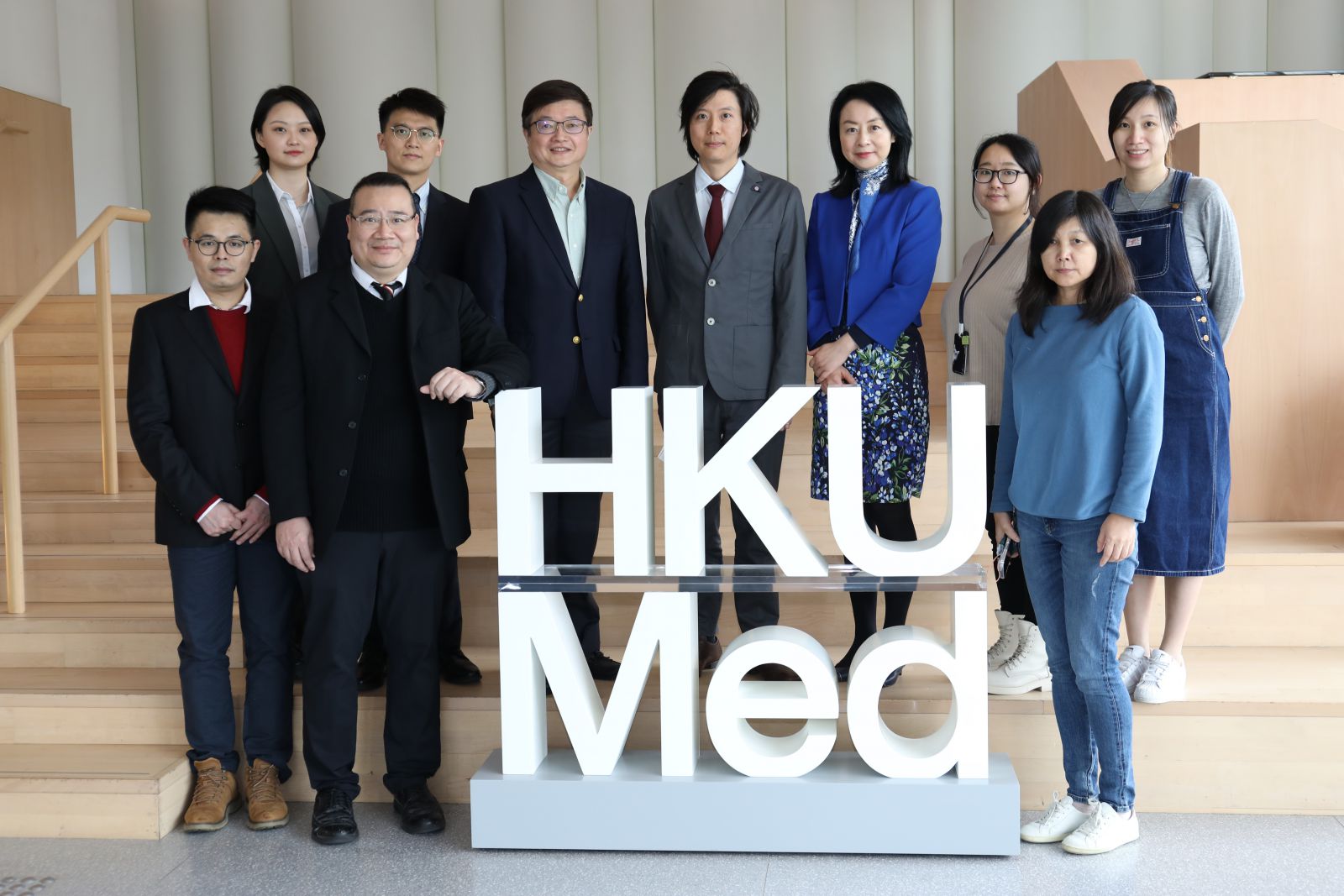
HKUMed researchers at AIDS Institute, Department of Microbiology and Department of Surgery, School of Clinical Medicine, and School of Biomedical Sciences discover the role of an isoformic programmed cell death protein 1 (PD-1), namely Δ42PD-1, in suppressing the function of killer T cells[1], which is a type of immune cells essential for killing cancer cells among hepatocellular carcinoma (HCC) patients. The study is a breakthrough because it demonstrates that Δ42PD-1 causes stronger functional loss of killer T cells, revealing a molecular mechanism underlying the failure of PD-1-targeted immune checkpoint blockade (ICB) therapy. Moreover, antibody drug targeting at Δ42PD-1 inhibits HCC progression in animal models, which is independent of the PD-1 pathway. The full research article is now published online in the journal of Gut, a top-tier academic journal.
[1] Philip M, Schietinger A. CD8(+) T cell differentiation and dysfunction in cancer. Nat Rev Immunol 2022;22:209-23.
Source: The University of Hong Kong
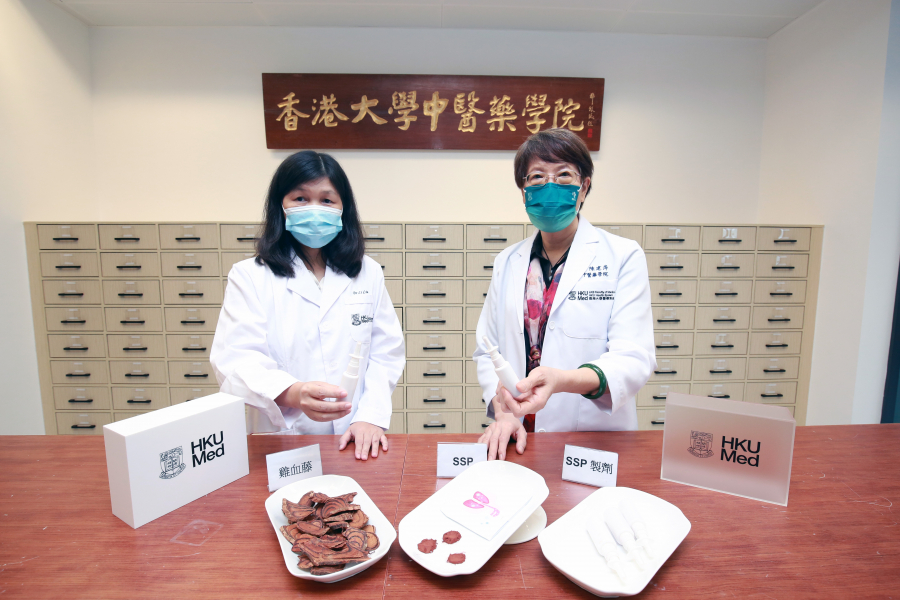
A research team comprised of members of the School of Chinese Medicine, AIDS Institute, Department of Microbiology, School of Clinical Medicine and State Key Laboratory for Emerging Infectious Diseases, the LKS Faculty of Medicine, The University of Hong Kong (HKUMed) have discovered a natural product SSP derived from a Chinese herb Spatholobus Suberectus Dunn that demonstrated broad antiviral activities against SARS-CoV-1, SARS-CoV-2, influenza, and HIV-1 as an entry blocker. Critically, it shows comparable activities against all major pandemic strains of SARS-CoV-2 variants of concern tested. Since SSP has been prepared in a cost-effective manner under safe manufacturer practices and do not cause toxicity in animals, it has great potential to be developed into a preventive drug for eliminating the spread of SARS-CoV-2. The findings are now published online in the journal Phytotherapy Research.
Source: The University of Hong Kong
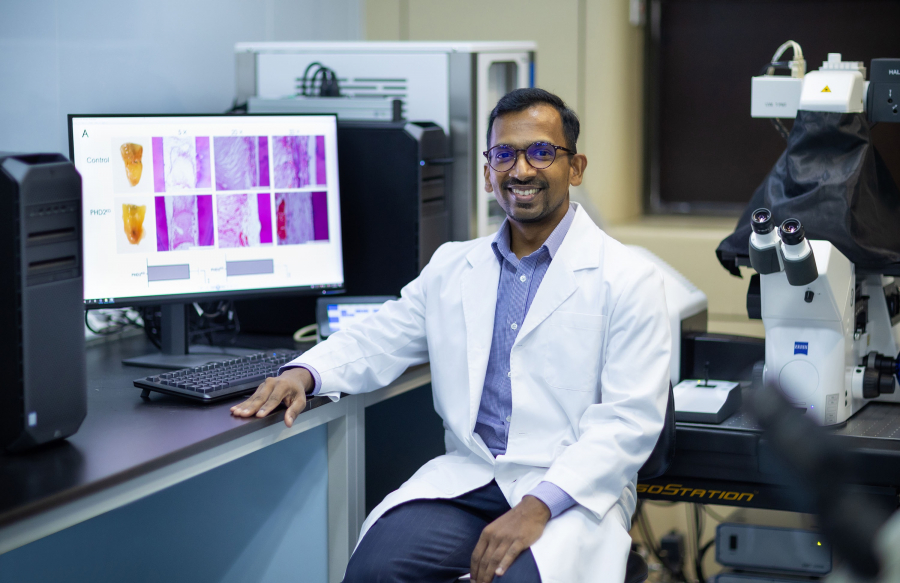
Stress is typically thought of as a negative phenomenon, but researchers at HKU Dentistry found “positive stress” that can induce good changes in tooth stem cells to make them more resistant to injury and disease. The study, published online in the Journal of Dental Research, is the first to show that adaptive mechanisms in tooth stem cells induced by preconditioning to stress can boost the tooth pulp tissue regeneration. The researchers found that oxidative stress caused by low-oxygen environment can elicit a protective response to make tooth stem cells less vulnerable to harm.
Source: The University of Hong Kong
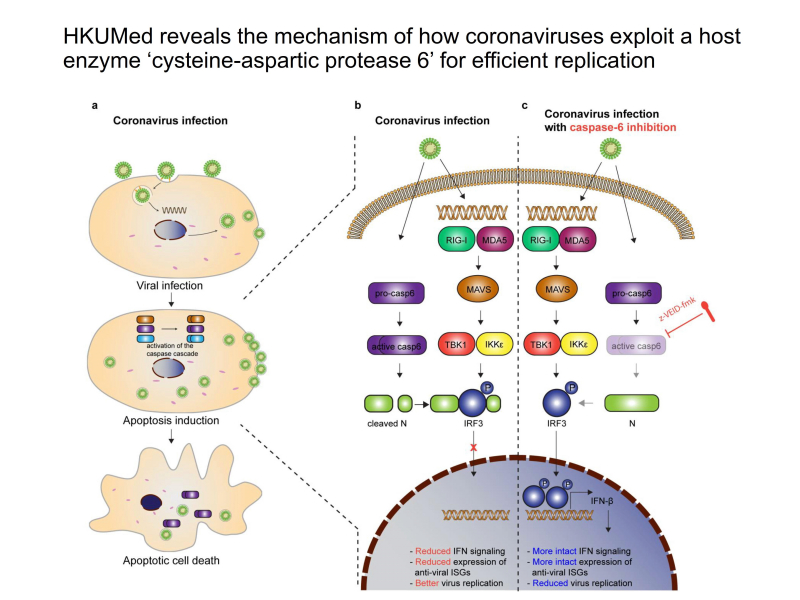
Researchers from Department of Microbiology, School of Clinical Medicine, Li Ka Shing Faculty of Medicine of The University of Hong Kong (HKUMed) revealed insights into the mechanism of how coronaviruses including SARS-CoV-2, SARS-CoV-1, and MERS-CoV exploit a host protease called ‘cysteine-aspartic protease 6’ (caspase-6) for efficient replication. The findings are peer reviewed and recently accepted for publication in the leading scientific journal Nature.
Source: The University of Hong Kong

A joint research team from the LKS Faculty of Medicine, The University of Hong Kong (HKUMed) and City University of Hong Kong (CityU) has discovered that the electrical stimulation of the eye surface can alleviate depression-like symptoms and improve cognitive function in animal models. These significant findings were recently published in Brain Stimulation and the Annals of the New York Academy of Sciences.
Source: The University of Hong Kong
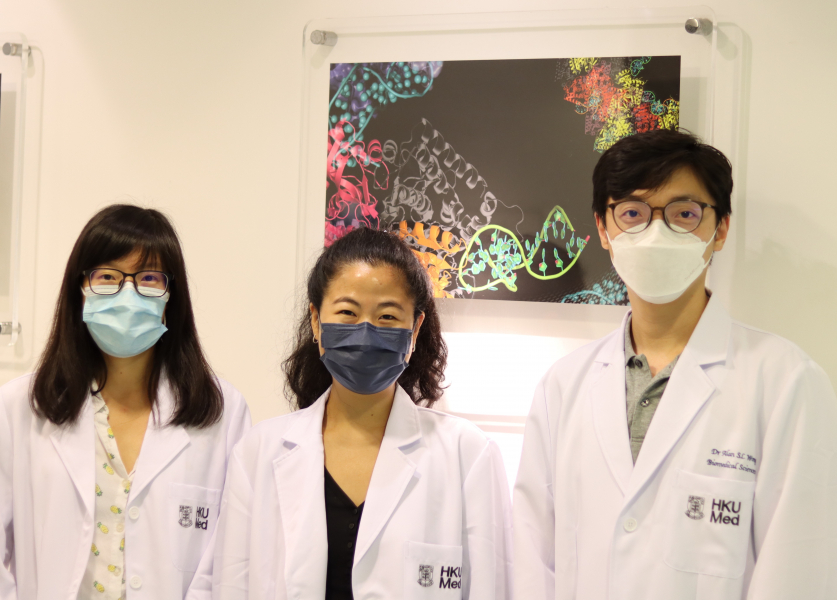
A research team from the LKS Faculty of Medicine, The University of Hong Kong (HKUMed) discovered more efficient CRISPR-Cas9 variants that could be useful for gene therapy applications. By establishing a new pipeline methodology that implements machine learning on high-throughput screening to accurately predict the activity of protein variants, the team expands the capacity to analyse up to 20 times more variants at once without the need for acquiring additional experimental data, which vastly accelerates the speed in protein engineering. The research team has successfully applied the pipeline in several Cas9 optimisations and engineered new Staphylococcus aureus Cas9 (SaCas9) variants with enhanced gene editing efficiency.
Source: The University of Hong Kong
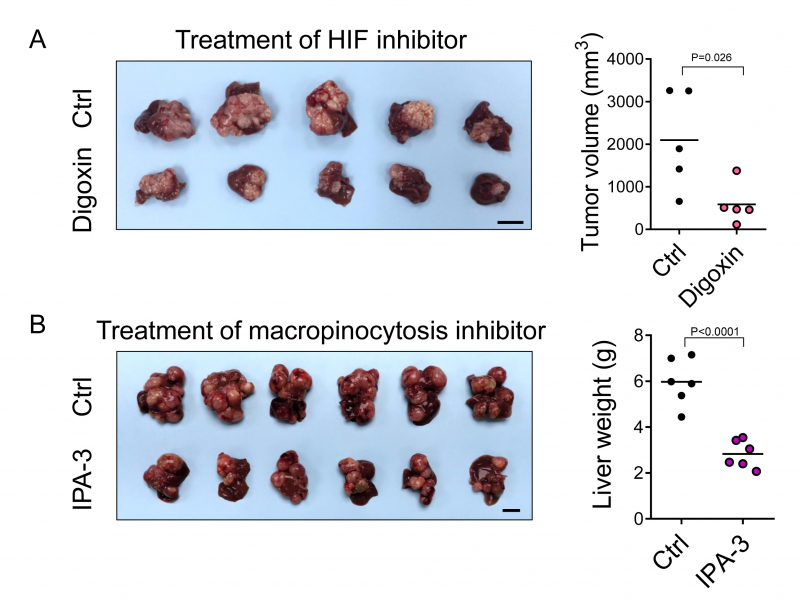
Researchers from the Department of Pathology, School of Clinical Medicine, LKS Faculty of Medicine, The University of Hong Kong (HKUMed) have identified a new metabolic mechanism in liver cancer cells, by which macropinocytosis, an endocytic process, is used to engulf extracellular proteins as fuels to support the unlimited growth of hepatocellular carcinoma (HCC) in hypoxia (oxygen deprivation). This discovery indicates that targeting macropinocytosis might represent a novel and effective therapeutic approach for HCC.
Source: The University of Hong Kong
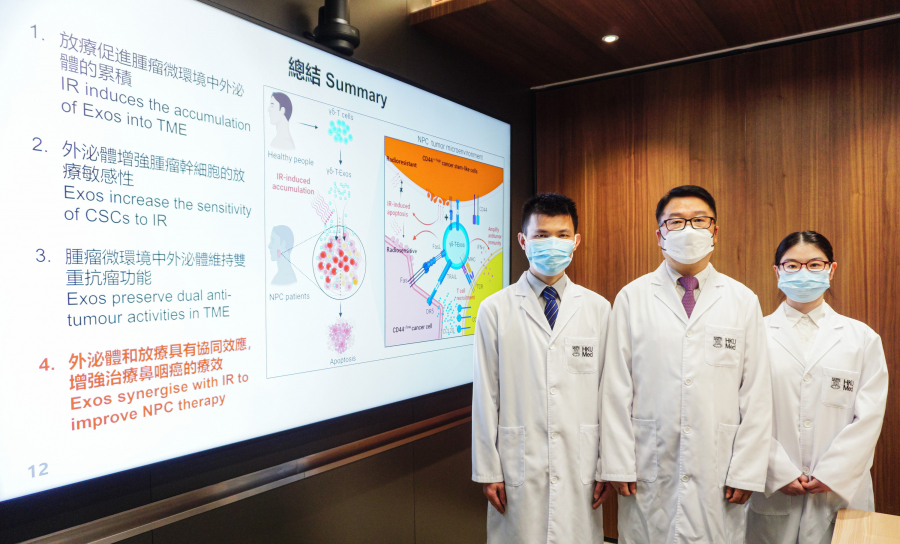
A research team at the School of Biological Sciences, the University of Hong Kong (HKU), has revealed novel cellular and molecular interactions between cancer cells and tumour-associated macrophages that promote peritoneal metastasis of ovarian cancer. These findings provide important insights into the therapeutic strategy of ovarian cancer and are now published in Advanced Science, a leading interdisciplinary open-access journal.
Source: The University of Hong Kong

A research team at the School of Biological Sciences, the University of Hong Kong (HKU), has revealed novel cellular and molecular interactions between cancer cells and tumour-associated macrophages that promote peritoneal metastasis of ovarian cancer. These findings provide important insights into the therapeutic strategy of ovarian cancer and are now published in Advanced Science, a leading interdisciplinary open-access journal.
Source: The University of Hong Kong

A research team at LKS Faculty of Medicine, The University of Hong Kong (HKUMed) has discovered a new molecular pathway to govern melanoma angiogenesis and metastasis. The findings provide new insights into how melanoma undergoes metastasis and progression through secretion of pro-angiogenic factor to induce angiogenesis that paves the way for new therapeutic opportunities.
Source: The University of Hong Kong
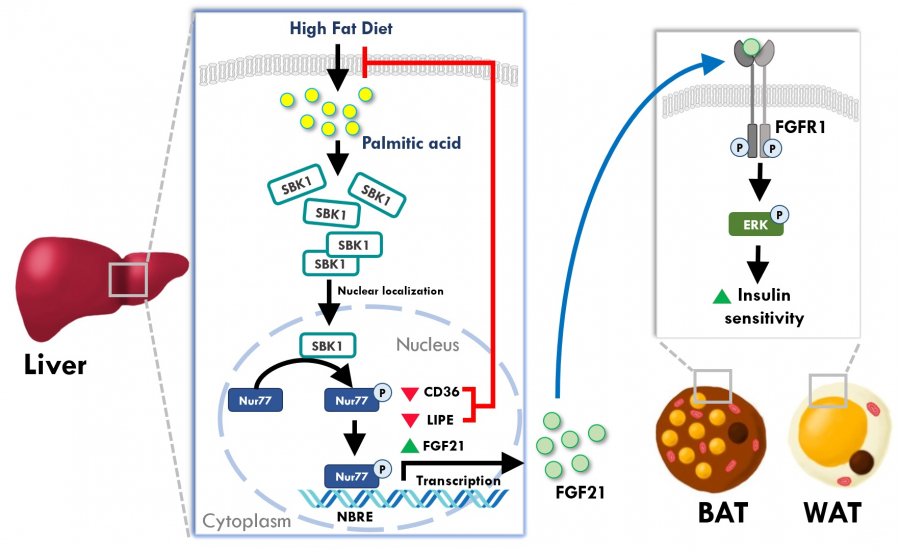
Non-alcoholic fatty liver disease (NAFLD), commonly known as fatty liver disease, is a prevalent disease frequently seen in obese people. Having high fat content in the liver is detrimental as it is strongly associated with severe health problems like diabetes, high blood pressure, and liver cancer. A research team led by Dr Chi Bun CHAN, Assistant Professor from the School of Biological Sciences, Faculty of Science, the University of Hong Kong (HKU), uncovers a new protective mechanism against this disorder.
Source: The University of Hong Kong
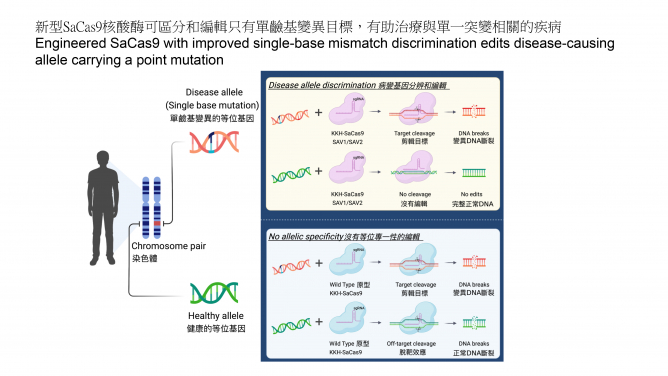
A research team of LKS Faculty of Medicine, The University of Hong Kong (HKUMed) has successfully engineered new Staphylococcus aureus Cas9 (SaCas9) variants, named KKH-SaCas9-SAV1 and SAV2, which, compared to the wild-type KKH-SaCas9, exhibit greatly enhanced targeting precision for editing only the disease-causing allele but not the normal allele. The new SaCas9 variants also reduce undesired off-target edits by more than 95% while possessing high editing activity. This study could open new possibilities to target disease-causing single-base mutations that occur in many genetic disorders.
Source: The University of Hong Kong

A research team from Department of Pharmacology and Pharmacy, LKS Faculty of Medicine, The University of Hong Kong (HKUMed), has developed a photo-responsive nanomedicine for light-controlled colorectal cancer therapy. The nanoparticles are simply made by self-assembly of a near-infrared dye and a prodrug. After intravenous injection, the nanoparticles can target colon tumours and release drugs to kill cancer cells upon light irradiation. This process can be in-situ monitored by in vivo imaging.
Source: The University of Hong Kong
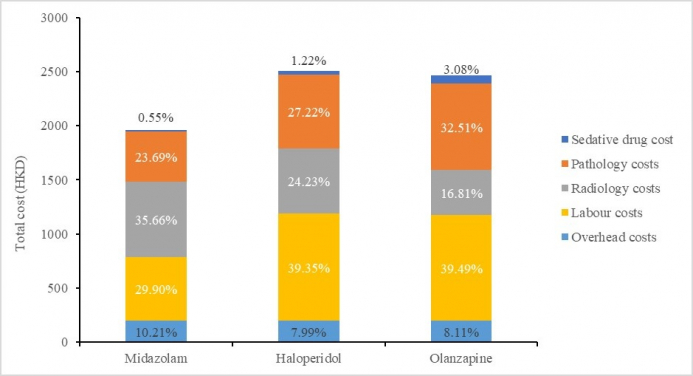
Research led by the Department of Pharmacology and Pharmacy of the LKS Faculty of Medicine, The University of Hong Kong (HKUMed) has found intramuscular (IM) olanzapine to be another cost-effective drug for treating acute agitation in addition to traditional drug options used in Accident and Emergency departments (A&E) in Hong Kong. Compared with haloperidol, which is commonly used in A&Es, olanzapine is similarly cost-effective with a relatively more benign cardiovascular profile and causes fewer extrapyramidal side effects (movement disorders).
Source: The University of Hong Kong

Researchers at AIDS Institute, Department of Microbiology, LKS Faculty of Medicine of The University of Hong Kong (HKUMed) and the State Key Laboratory of Emerging Infectious Diseases, HKU, have conducted a timely study for host immune responses in mRNA-vaccinees after acute infection by the alarming Omicron variant of SARS-CoV-2. The study demonstrated that mRNA-vaccinees had already displayed low levels of vaccine-induced neutralising antibodies and T cell responses at the time of infection. Upon vaccine breakthrough infection by the Omicron variant, mRNA-vaccinees mounted rapid broadly reactive neutralising antibodies and T cell responses, which contributed to the protection to the mRNA-vaccinees with mild clinical symptoms.
Source: The University of Hong Kong
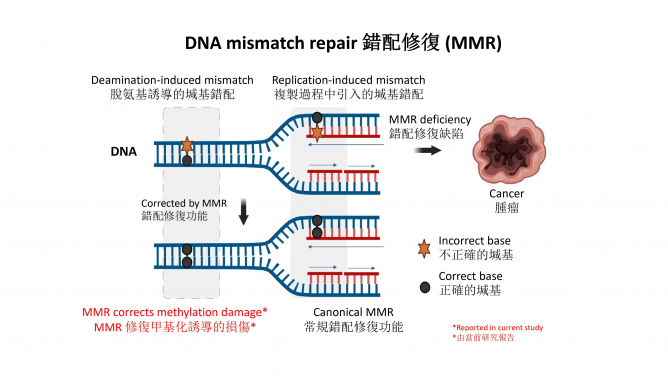
Researchers at the School of Biomedical Sciences, LKS Faculty of Medicine of The University of Hong Kong (HKUMed) discovered an unknown role of DNA mismatch repair (MMR) in maintaining the integrity of the human genome. People born with defective MMR, known as Lynch syndrome, will have a high chance of developing cancer by early adulthood.
Source: The University of Hong Kong
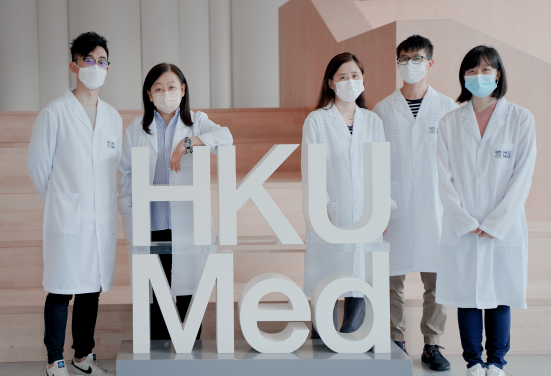
A research team at the Department of Pathology, LKS Faculty of Medicine, The University of Hong Kong (HKUMed) in collaboration with Hong Kong and Mainland researchers has revealed an unrecognised function of patient-derived circulating extracellular vesicles (EVs) in liver cancer metastasis. These ground-breaking findings giving insights into early diagnosis and new therapeutic strategy for liver cancer.
Source: The University of Hong Kong

Researchers at the Department of Microbiology and State Key Laboratory of Emerging Infectious Diseases, LKS Faculty of Medicine of The University of Hong Kong (HKUMed) have conducted a comprehensive study for identifying an effective vaccine regimen in preventing SARS-CoV-2 nasal infection. The study demonstrated that a combination of intramuscular PD1-based receptor-binding domain (RBD) DNA vaccine (PD1-RBD-DNA) prime and intranasal live attenuated influenza-based vaccine (LAIV-HK68-RBD) boost vaccination regimen induced the strongest mucosal broadly neutralising antibodies and lung resident memory CD8 T cells, which prevented live SARS-CoV-2 nasal challenges in two animal models.
Source: The University of Hong Kong
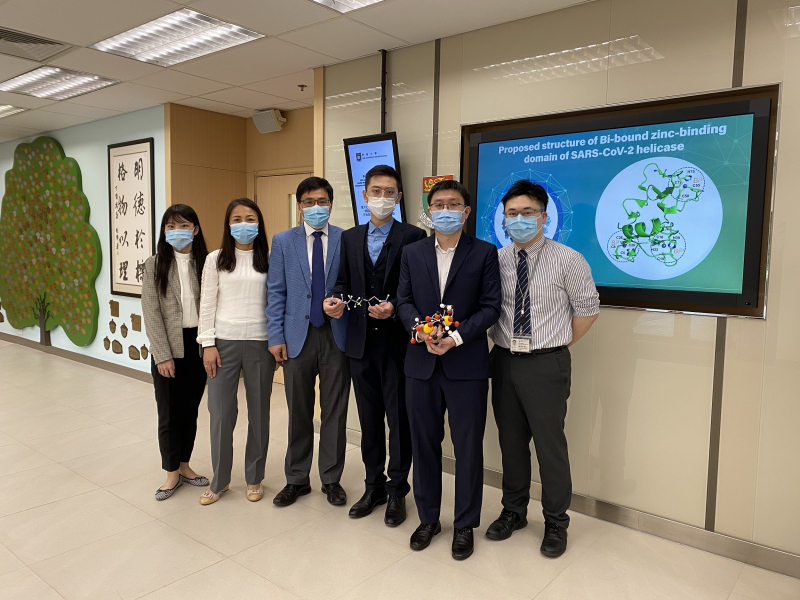
A research team led by Professor Hongzhe SUN, Norman & Cecilia Yip Professor in Bioinorganic Chemistry from the Department of Chemistry, Faculty of Science, the University of Hong Kong (HKU), in collaboration with Dr Shuofeng YUAN, Assistant Professor from the Department of Microbiology, Li Ka Shing Faculty of Medicine, discovered that orally administrated bismuth drug colloidal bismuth subcitrate (CBS) together with N-acetyl cysteine (NAC) could be a broad-spectrum anti-coronavirus cocktail therapy.
Oral administration of the cocktail suppresses the replication cycle of the virus, reduces viral loads in the lung and ameliorates virus-induced pneumonia in a hamster infection model. Not only could NAC stabilise bismuth-containing metallodrugs at stomach-like conditions but also enhance the uptake of bismuth drugs in tissues (e.g. lung) and antiviral potency through oral administration. Bismuth subsequently suppressed virus replication of a panel of clinically relevant coronaviruses, including Middle East respiratory syndrome-related coronavirus (MERS-CoV), Human coronavirus 229E (hCoV-229E) and Severe acute respiratory syndrome coronavirus 2 (SARS-CoV-2) and its alpha variant (B.1.1.7) by inactivating multiple essential viral enzymes. The findings provided insights into the development of inorganic pharmaceutics and a new therapeutic approach for viral infections.
Source: The University of Hong Kong
2023

Cells and tissue are known to undergo significant irreversible deformations during processes such as tissue formation and embryo development. A research team led by Professor Yuan LIN from the Department of Mechanical Engineering at the University of Hong Kong (HKU) has made a major new breakthrough in showing how plastic strain develops in individual cells and then propagates within the tissue. The study, titled "A Mechanism-Based Theory of Cellular and Tissue Plasticity," has been published in the Proceedings of the National Academy of Sciences (PNAS).
Source: The University of Hong Kong
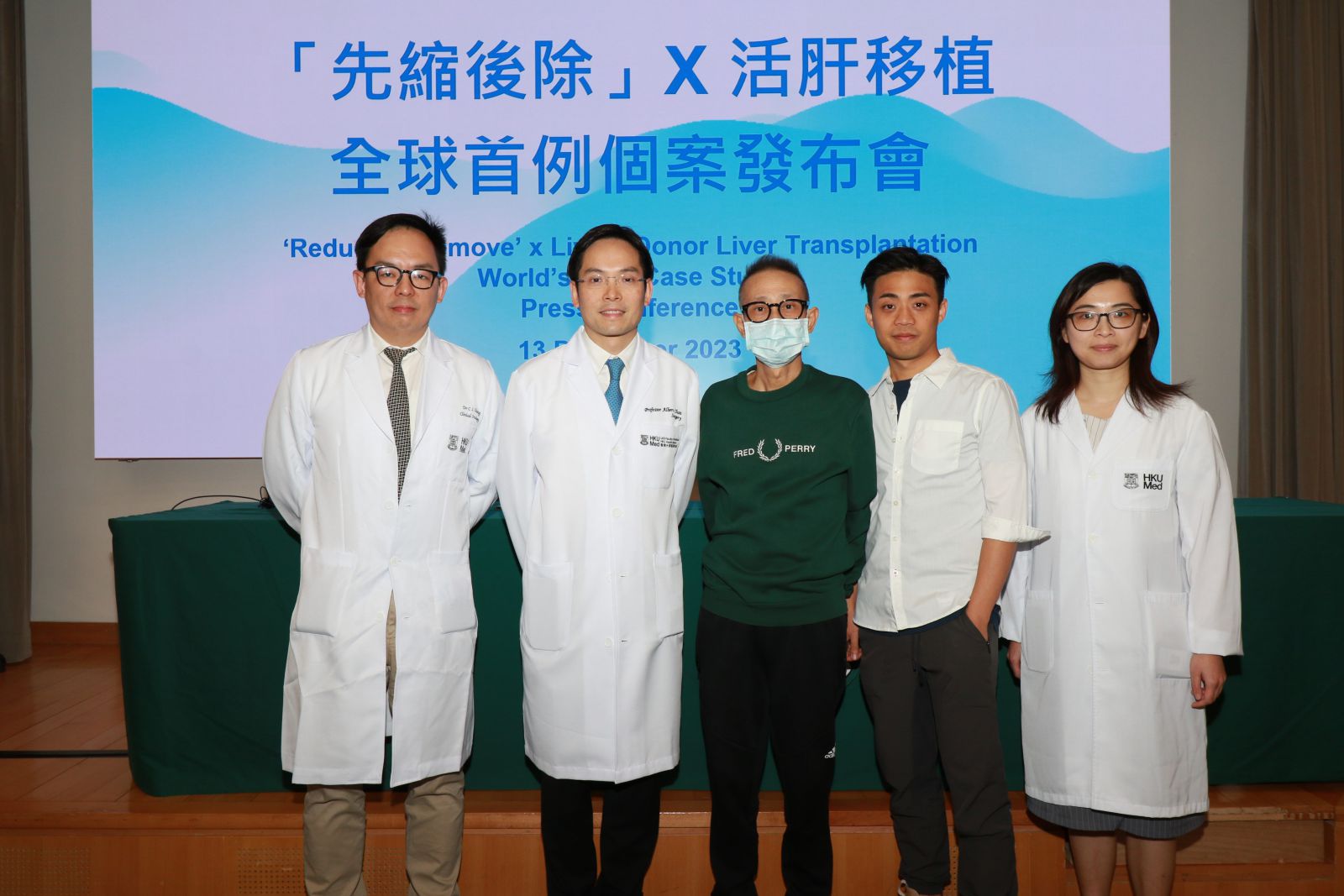
A new treatment strategy for locally advanced liver cancer, known as ‘Reduce and Remove’, was announced by the Department of Surgery and Department of Clinical Oncology, Centre of Cancer Medicine, School of Clinical Medicine, LKS Faculty of Medicine of the University of Hong Kong (HKUMed) earlier this year. This innovative approach provides a way for patients with inoperable locally advanced liver cancer to be cured. One remarkable case among patients treated with the ‘Reduce and Remove’ strategy involved the conversion of stage 4 liver cancer to stage 1 cancer, followed by the removal of the tumour through living donor liver transplantation. This novel treatment was also used for a second patient of advanced age who subsequently underwent this liver-preserving surgery. The liver transplantation case was presented at the Congress of the Asian Society of Transplantation 2023 and was recently published in Liver Cancer.
Source: The University of Hong Kong

Global consumption data show that there is an increasing trend of sedative-hypnotic prescriptions, especially in more developed affluent countries and regions, such as Hong Kong.1 Researchers in the Centre for Safe Medication Practice and Research (CSMPR) of the Department of Pharmacology and Pharmacy in the LKS Faculty of Medicine, the University of Hong Kong (HKUMed), conducted a study investigating the connection between particular sedative-hypnotics and the risk of bone fractures on over six million individuals in 11 countries/ regions. The findings revealed that the use of certain sedative-hypnotic medications was moderately associated with an increased risk of bone fractures, estimating at 30 to 40%. The study highlights the importance of carefully evaluating the benefits and risks when prescribing sedative-hypnotics, particularly for patients with a high risk of bone fracture. The findings were published in Sleep Medicine Reviews.
Source: The University of Hong Kong
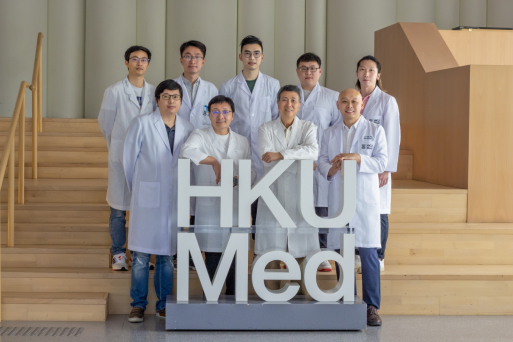
Researchers from the LKS Faculty of Medicine, the University of Hong Kong (HKUMed) and the Shenzhen Institute of Advanced Technology (SIAT) have developed a novel method for dynamic vaccine updates to combat the ever-changing SARS-CoV-2 virus, which caused the COVID-19 pandemic. The findings, published in the journal Cell Host & Microbe, revealed that a vaccine booster based on the older SARS-CoV-1 strain may provide longer-lasting and broader protection after two doses of an ancestral strain vaccine.
Source: The University of Hong Kong
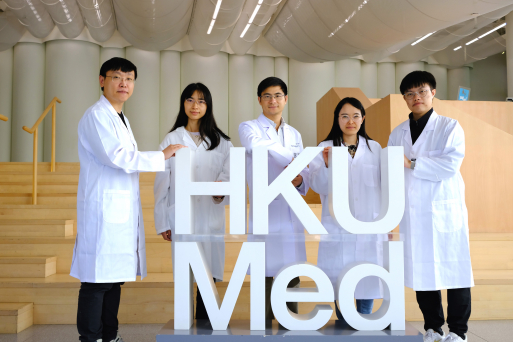
Researchers at the LKS Faculty of Medicine of the University of Hong Kong (HKUMed), and collaborators from the Zhongshan Ophthalmic Centre of Sun Yat-sen University, Guangzhou, have developed a light-activatable prodrug nanomedicine for age-related macular degeneration (AMD) therapy. Through the intravenous injection of the nanomedicine and application of light irradiation to diseased eyes, anti-angiogenic and photodynamic combination therapy can be activated, offering a minimally invasive alternative for the treatment of AMD and other ocular disorders characterised by abnormal blood vessel growth. The research has been published in Advanced Science, and a Patent Cooperation Treaty application was filed based on the research.
Source: The University of Hong Kong
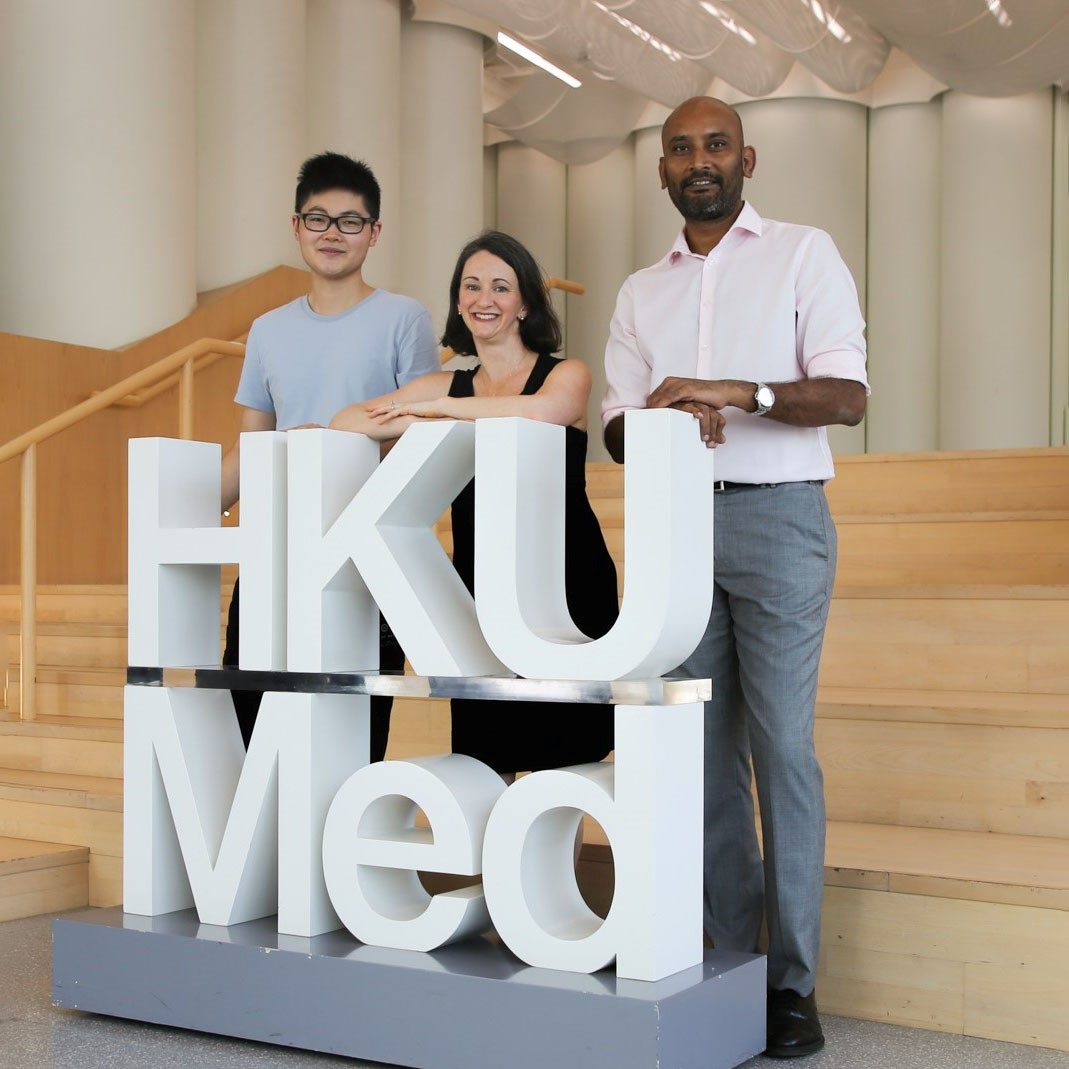
An investigation by the School of Public Health (the School), LKS Faculty of Medicine of the University of Hong Kong (HKUMed), describes the origins and evolutionary dynamics of resurgent outbreaks of highly pathogenic avian influenza H5 viruses. Led by Dr Vijaykrishna Dhanasekaran, Associate Professor of the School, the research team identified shifts in the global distribution of H5 virus outbreaks, including newly emerging epicentres. The team’s work suggests that the increasing persistence of avian influenza in wild bird populations is driving the evolution and spread of new strains. Their work underscores the need for improved mitigation and elimination strategies to limit future epizootic outbreaks. The findings were published in the highly prestigious journal Nature.
Source: The University of Hong Kong
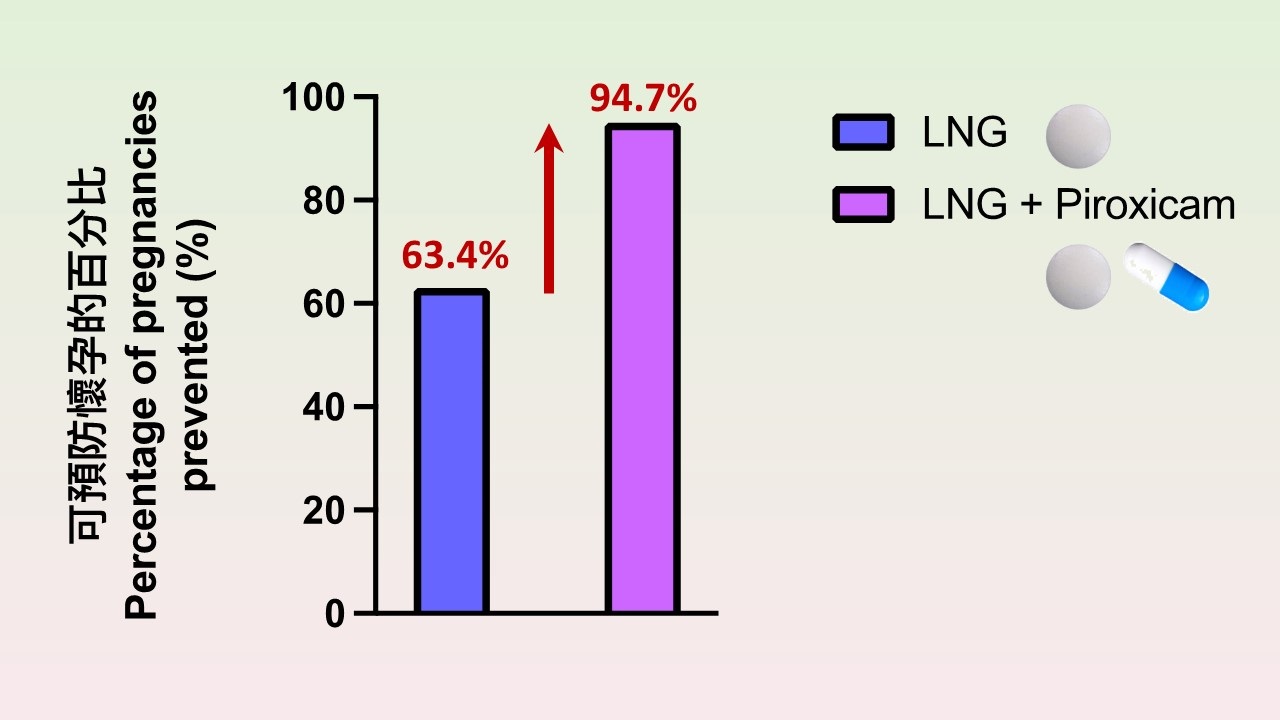
A collaborative research team, including members of LKS Faculty of Medicine of the University of Hong Kong (HKUMed), as well as The Family Planning Association of Hong Kong (FPAHK) and Sweden’s Karolinska Institutet, recently published its findings on adding an anti-inflammatory painkiller used for arthritis pain to an oral emergency contraceptive pill (also known as the morning-after pill) to increase the effectiveness of pregnancy prevention. The study was published in a recent issue of The Lancet.
Source: The University of Hong Kong

A new antibiotic drug developed by a research team led by Professor Li Xuechen from the Department of Chemistry at The University of Hong Kong (HKU) has recently gained approval from the authorities to undergo clinical trials in the Mainland.
The new drug, which has taken the research team ten years to develop and is named Kynomycin, received the "Notice of Approval for Drug Clinical Trials" from the National Medical Products Administration of China to be tested in human subjects.
The new antibiotic drug targets complex skin and soft tissue infections (cSSTI) caused by bacteria. It is a new type of cyclic lipopeptide category 1 drug with a novel chemical structure. The patent is licensed to a pharmaceutical company in the Mainland by HKU’s Technology Transfer Office through the University’s wholly-owned subsidiary, Versitech Limited.
Skin and soft tissue infections are very common bacterial infectious diseases in clinical practice, often leading to emergency visits and hospitalisation. With the emergence of clinically resistant strains and the development of bacterial pathogens that are resistant to antibiotics, treatment options have become increasingly limited.
The development of this drug aims to improve the safety and efficacy of cyclic lipopeptide antibiotics and provide a new choice for clinical treatment. After obtaining approval for this clinical trial, the drug still needs to undergo Phase I, II, and III clinical trials and be evaluated and approved by the National Medical Products Administration before it can be produced and marketed.
Source: The University of Hong Kong

An innovative technique for the evaluation of coronary artery disease has been proven clinically useful, according to a study conducted by the Department of Medicine, School of Clinical Medicine, LKS Faculty of Medicine of the University of Hong Kong (HKUMed). This new technique could provide a reliable way of identifying coronary artery disease patients who require stenting of the arteries. The findings of the study are now published in the Journal of Cardiovascular Translational Research.
Source: The University of Hong Kong

A research team comprised of members from the Department of Surgery, Department of Pharmacology and Pharmacy, Department of Anaesthesiology, Department of Family Medicine and Primary Care, School of Clinical Medicine, LKS Faculty of Medicine, the University of Hong Kong (HKUMed), and Laboratory of Data Discovery for Health (D²4H) has conducted a retrospective cohort study to explore the association between opioid prescription at discharge and persistent opioid use, postoperative health service utilisation and mortality in Hong Kong. Use of opioids at discharge in surgical patients showed clinical risks to increase persistent opioid use, unplanned health service utilisation, and mortality. The findings are now published in the British Journal of Anaesthesia.
Source: The University of Hong Kong
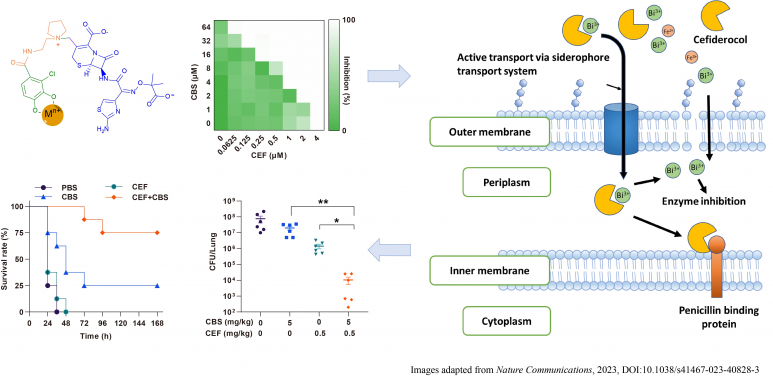
Building upon this understanding, a research team led by Professor Hongzhe SUN from the Department of Chemistry, The University of Hong Kong (HKU), introduced a ‘Dual Trojan Horse’ strategy, where a metal-based-drug and sideromycins, a class of antibiotic structurally resembling iron, work together in combating antibiotic-resistant bacteria. This approach allows these antibiotics to be delivered into bacterial cells through a pathway that mimics iron uptake. When bacteria encounter sideromycins, they are deceived into believing they are acquiring iron, prompting them to usher these compounds into their cells. This strategy not only enhances the effectiveness of sideromycins but also prolongs their lifespan, marking a significant advancement in our battle against antibiotic resistance. These promising results were successfully replicated in a live mice model, introducing an innovative strategy to combat antimicrobial resistance, offering hope in the fight against superbugs in clinic. These findings have recently been published a in Nature Communications entitled ‘Metallo-sideromycin as a dual functional complex for combating antimicrobial resistance (AMR)’.
Source: The University of Hong Kong
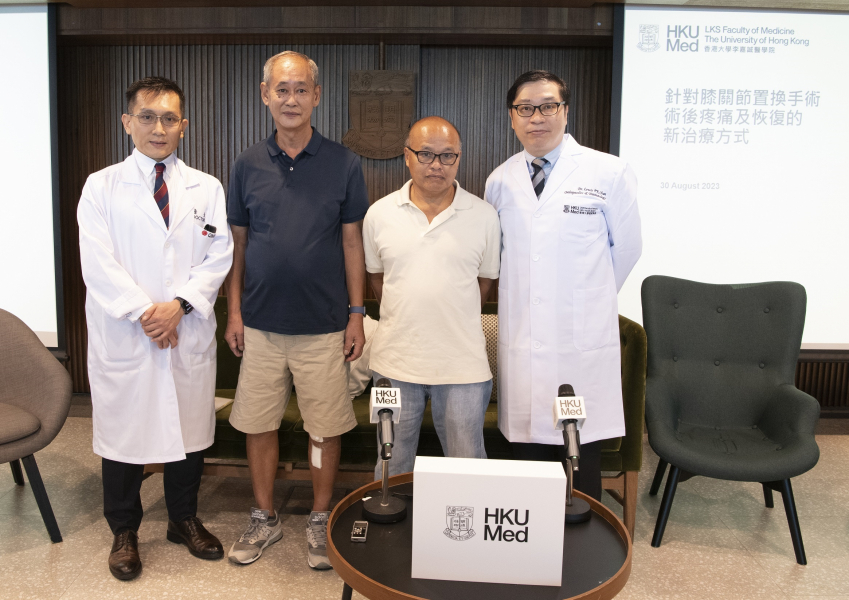
A research team from Department of Orthopaedics and Traumatology, and Department of Anaesthesiology, School of Clinical Medicine, LKS Faculty of Medicine of the University of Hong Kong (HKUMed), have evaluated whether a combination of intravenous corticosteroids (IVS) and periarticular corticosteroids (PAS) could provide new insights into pain management and postoperative rehabilitation following total knee arthroplasty. The findings were published in the Journal of Bone and Joint Surgery.
Source: The University of Hong Kong

A research team led by Professor Judy Yam Wai-ping from the Department of Pathology, School of Clinical Medicine, LKS Faculty of Medicine, the University of Hong Kong (HKUMed) has made a significant breakthrough in unveiling an unrecognised signalling pathway mediated by circulating small extracellular vesicles (sEVs) derived from liver cancer patients that promotes liver cancer metastasis. This discovery presents a potential therapeutic strategy for treating liver cancer, which has been published in Advanced Science.
Source: The University of Hong Kong
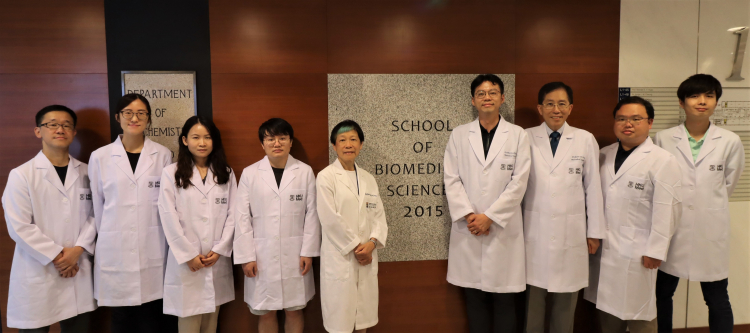
A joint research team from LKS Faculty of Medicine, the University of Hong Kong (HKUMed) and City University of Hong Kong (CityU) has generated human neural stem cells with powerful therapeutic potential for the treatment of spinal cord injury that paves the way for new therapeutic opportunities. The new findings are now published in the leading multidisciplinary science journal, Advanced Science.
Source: The University of Hong Kong

A research team from the School of Public Health, LKS Faculty of Medicine of the University of Hong Kong (HKUMed), provides genetic evidence that metformin might promote healthy ageing using a cohort study of more than 300,000 participants of European descent (UK Biobank). This proof-of-concept work supports further clinical research into the drug repositioning of metformin in healthy longevity. The findings are now published in The Lancet Healthy Longevity, a leading peer-reviewed, international journal in the field of geriatrics and gerontology.
Source: The University of Hong Kong
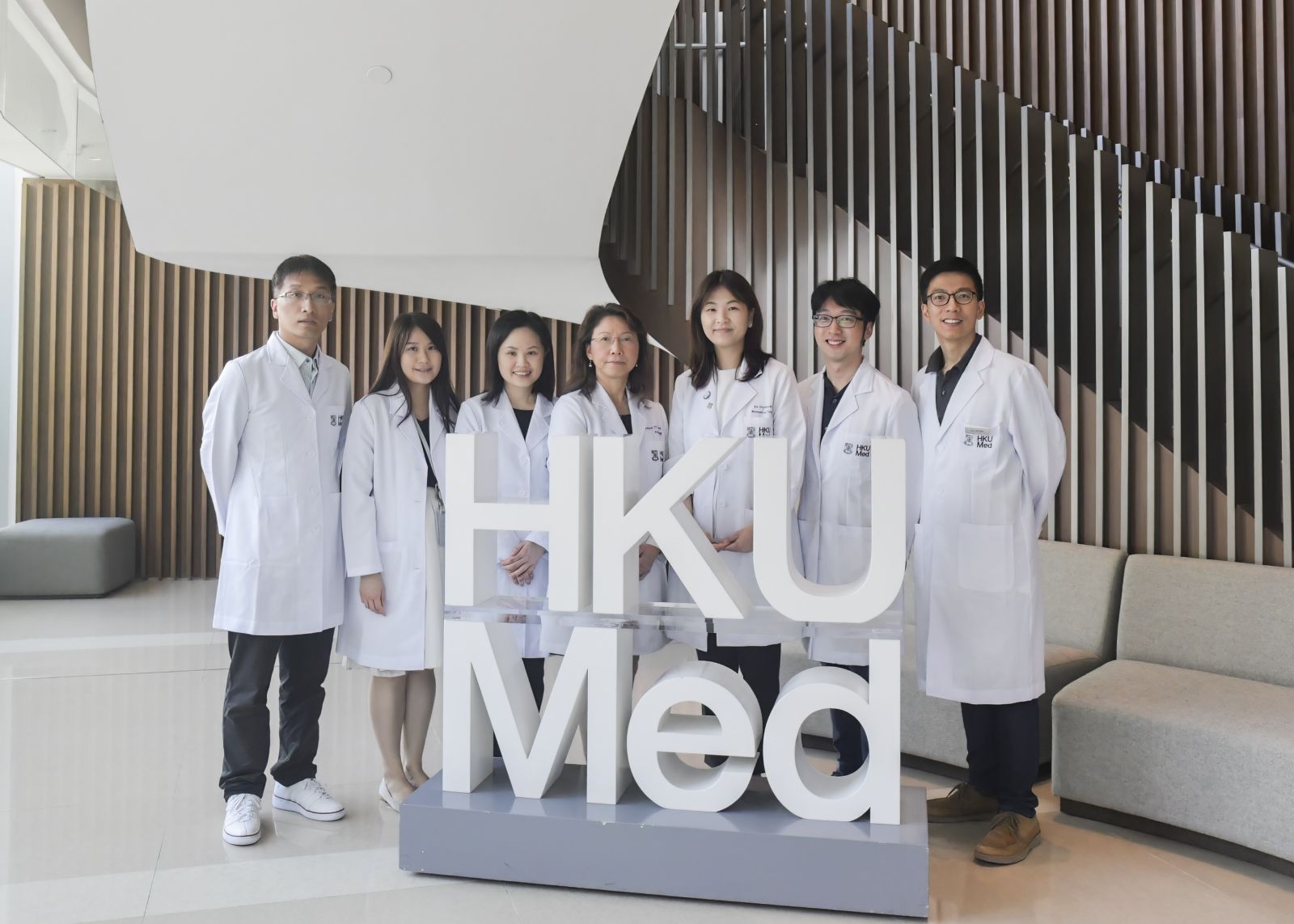
A research team led by Professor Stephanie Ma Kwai-yee from School of Biomedical Sciences, LKS Faculty of Medicine, the University of Hong Kong (HKUMed) has uncovered a novel signaling pathway by which RNA editing governs lipid metabolism to promote resistance to chemotherapy and cancer stemness in gastric cancer. The findings has been published in Nature Communications.
Source: The University of Hong Kong
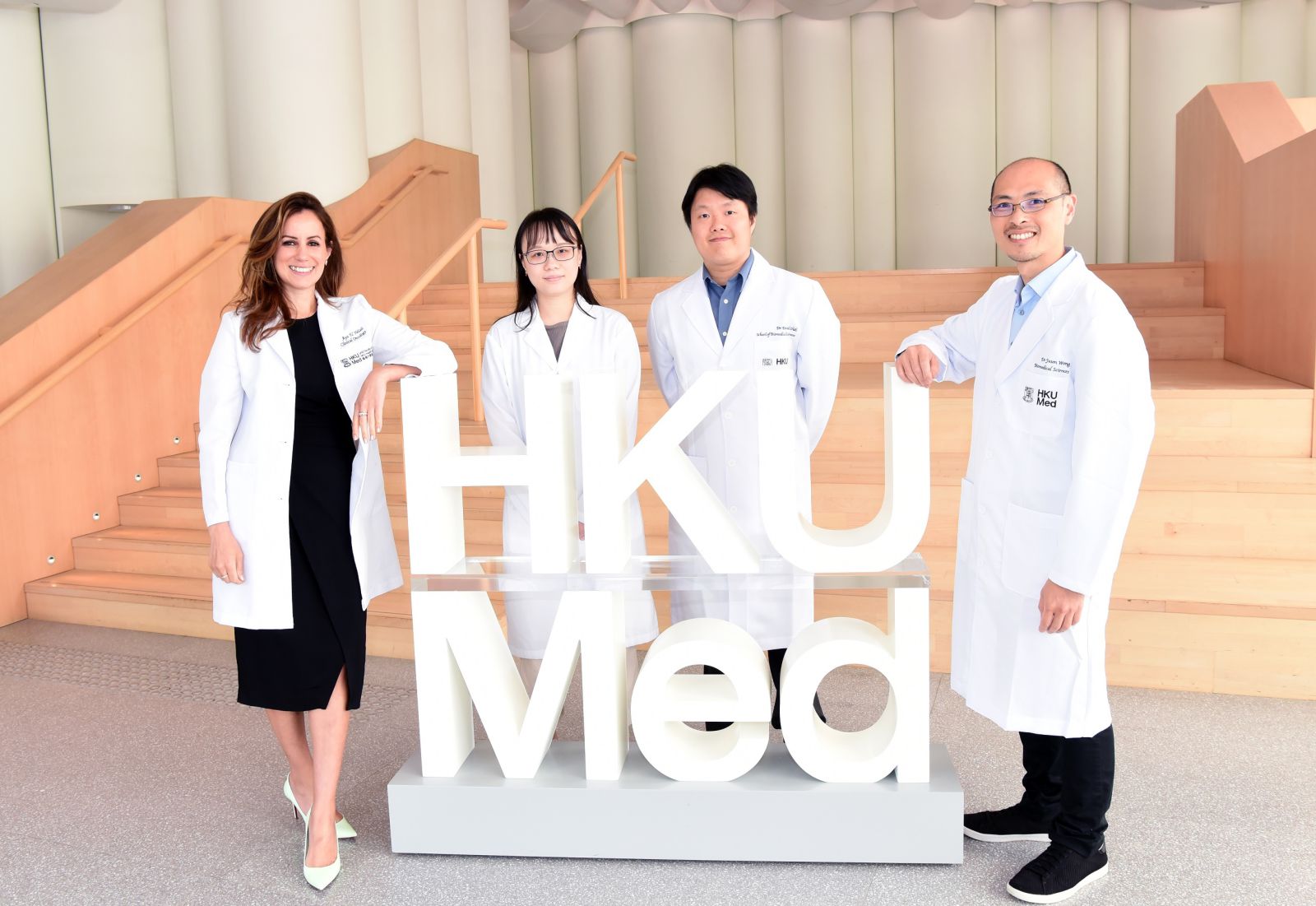
The collaborative group led by the Department of Clinical Oncology, School of Clinical Medicine, LKS Faculty of Medicine, the University of Hong Kong (HKUMed) and the Division of Clinical Pathology & Molecular Pathology, Hong Kong Sanatorium & Hospital (HKSH), have recently published their findings on the clinical importance of the Multidisciplinary Molecular Tumour Board (MTB) in delivering a Precision Cancer Medicine service. In the rapidly evolving therapeutic landscape of oncology, the MTB provides a much-needed solution; it offers a systematic precision oncology strategy for treatment selection for patients with advanced cancer. The MTB findings were published in The Lancet Regional Health - Western Pacific.
Source: The University of Hong Kong
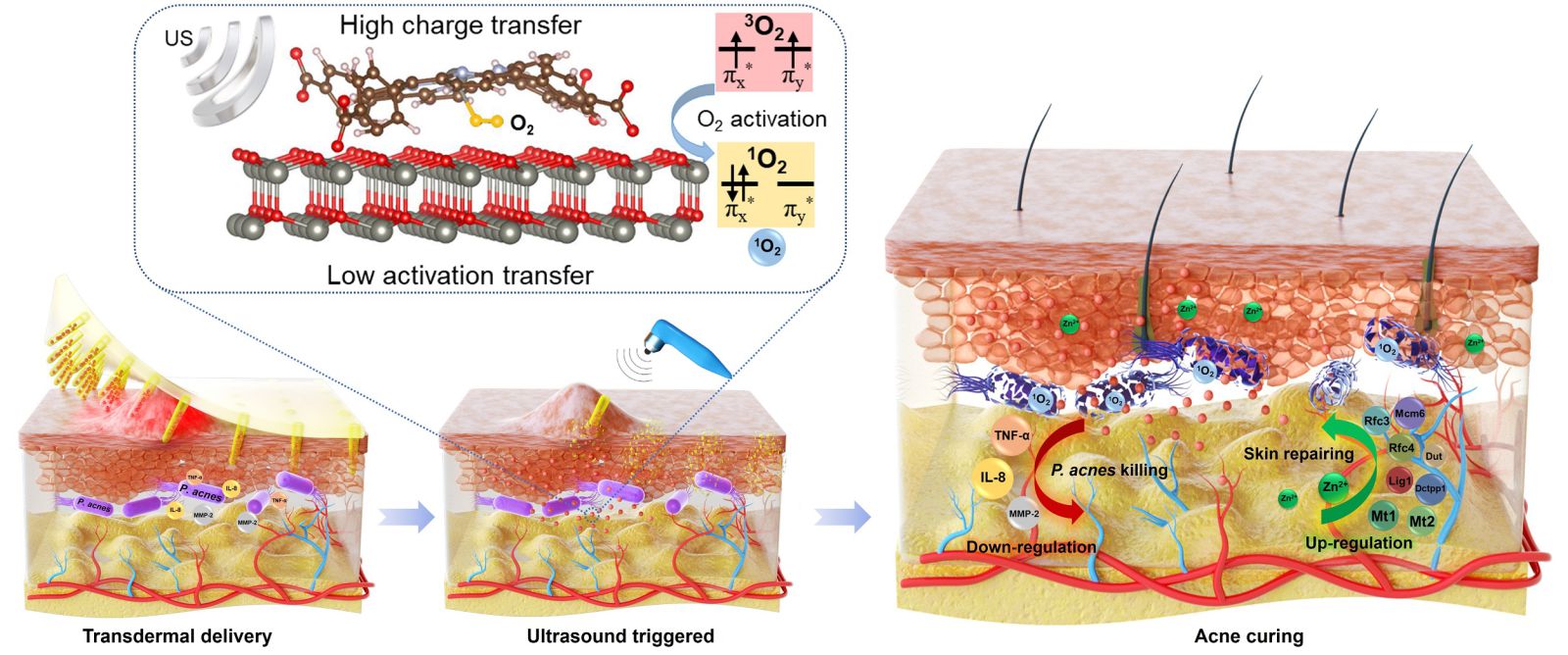
A research team led by Professor Kelvin Yeung from the Department of Orthopaedics and Traumatology, School of Clinical Medicine, LKS Faculty of Medicine, the University of Hong Kong (HKUMed) has designed a new microneedle patch to offer a highly-effective non-antibiotic approach for the treatment of skin infection. In brief, the design engineered with ultrasound-responsive zinc-based metal-organic framework (MOF) antibacterial nanoparticles promises pain-free delivery to treat bacterial infection on skin tissue and facilitate skin repair at the same time. The novel microneedle is around 50 microns in diameter, similar to a typical hair. The findings have been published in Science Advances.
Source: The University of Hong Kong
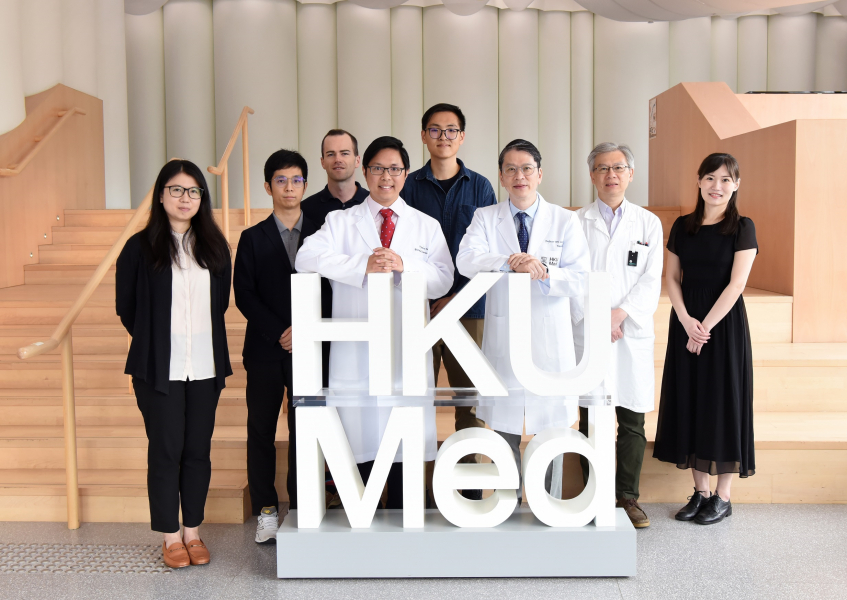
A research team led by Professor Leung Wai-keung from Department of Medicine, School of Clinical Medicine, LKS Faculty of Medicine, the University of Hong Kong (HKUMed) and the Baylor College of Medicine of the United States found that Helicobacter pylori (H. pylori) infection around the world has been steadily declining over the past four decades, thus offering a comprehensive, updated epidemiology of H. pylori infection. The study has been published in The Lancet Gastroenterology & Hepatology . In a separate study on the combination of antibiotics and acid suppressive therapies, Professor Leung’s research team discovered that the use of antibiotics could alter the micro-organisms and the virus community (virome) present in the gut. The findings have been published in the Nature Communications.
Source: The University of Hong Kong

A research team led by Dr Zhou Jie and Professor Yuen Kwok-yung from State Key Laboratory for Emerging Infectious Diseases and the Department of Microbiology, School of Clinical Medicine, LKS Faculty of Medicine, the University of Hong Kong (HKUMed), together with Professor Hans Clevers from Hubrecht Institute, the Netherlands, a pioneer of organoid technology, and Professor Jiang Shibo from Fudan University investigated the infection and replication capacity of the Omicron BA.5 and other variants in human respiratory organoids established by the team. The findings were published in the latest issue of Proceedings of the National Academy of Sciences of the United States of America.
Source: The University of Hong Kong

A research team led by Dr Gary Ying Wai CHAN from the School of Biological Sciences at The University of Hong Kong (HKU), has revealed the function of a unique enzyme, ANKLE1. ANKLE1 acts on chromatin bridges that are trapped in the midzone of the dividing cells. By cutting these bridges, ANKLE1 prevents damage to the genetic material and stops the immune system from mistakenly attacking the body’s own cells. Understanding the mechanism by which chromatin bridges are cleaved during cell division is important for developing new strategies to prevent or treat diseases such as cancer and autoinflammatory disorders. The research is highly relevant to both cancer and autoinflammation and has recently been published in Advanced Science.
Source: The University of Hong Kong
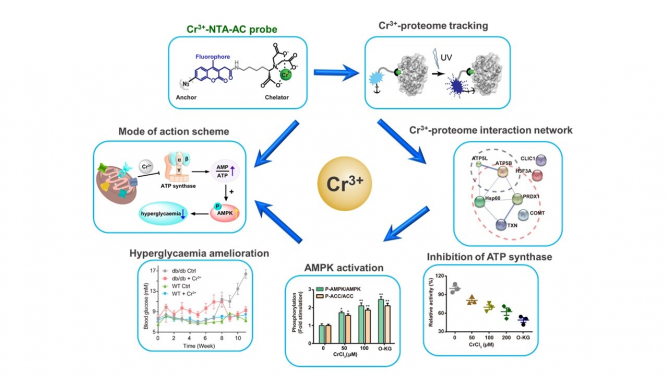
Recently, a research team led by Professor Hongzhe SUN from the Department of Chemistry, Faculty of Science, The University of Hong Kong, has published a paper in Nature Communications. The researchers found that, chromium(III) (Cr(III)), a nutritional supplement, can enhance cells’ ability to metabolise glucose by regulating ATP synthase activity. This process improves mitochondrial deformation caused by high glucose levels and significantly boosts glucose metabolism in type 2 diabetic mice. To uncover the protein targets of Cr(III) and elucidate the molecular mechanism, the team has developed a fluorescent probe for detecting transient metal-protein interactions, achieving a high spatiotemporal resolution tracking of the Cr(III) proteome in HepG2 cells. This led to the identification of Cr(III)-binding proteins within cells. The team then revealed that Cr(III) replaces magnesium ions (Mg2+) in ATP synthase, reduces ATP synthase activity, and activates the downstream AMPK pathway, resulting in improved glucose metabolism. This study provides a novel concept for hypoglycaemic research.
Source: The University of Hong Kong
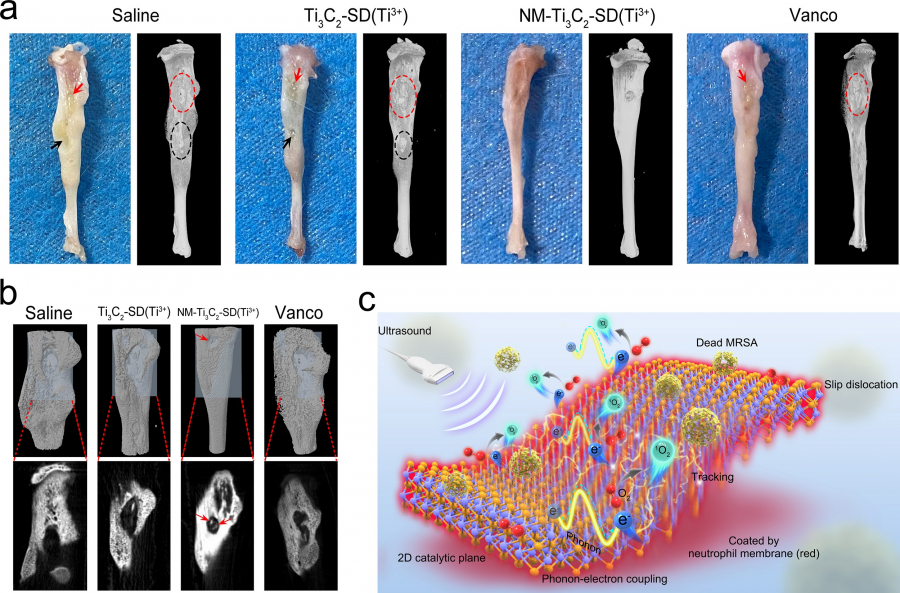
A research team led by Professor Kelvin Yeung Wai-kwok from the Department of Orthopaedics and Traumatology, School of Clinical Medicine, LKS Faculty of Medicine, the University of Hong Kong (HKUMed) has invented a non-invasive and non-antibiotics technology to effectively reduce methicillin-resistant Staphylococcus aureus (MRSA) infection in bony tissue. The novel antibacterial nano-sheets can release a substantial amount of reactive oxygen species (ROS) subject to ultrasound stimulation. With the engulfment of neutrophil membrane (NM), the nano-sheets are able to actively capture the MRSA bacteria deeply seated in bony tissue and effectively eliminate 99.72% ± 0.03%. The outcome has been published in Advanced Materials.
Source: The University of Hong Kong

A research team led by Dr Gary Ying Wai CHAN from the School of Biological Sciences at The University of Hong Kong (HKU), has uncovered a new mechanism that ensures correct DNA segregation in cell division, where improper cell division will lead to the development of cancer. The team's findings, published in the journal Cell Reports, focus on the roles of two proteins, RIF1 and protein phosphatase 1 (PP1), in resolving ultrafine DNA bridges. These bridges are formed when sister chromatids are connected by DNA joint molecules during mitosis. If these DNA bridges cannot be resolved or removed properly, they will eventually break and cause DNA damage in the daughter cells, which can lead to the development of cancer cells.
Source: The University of Hong Kong

A research team in the Department of Pharmacology and Pharmacy, LKS Faculty of Medicine, the University of Hong Kong (HKUMed) has discovered that sodium-glucose cotransporter 2 inhibitors (SGLT2i) could reduce the risks of renal and respiratory diseases, including end-stage renal disease (ESRD), obstructive airway disease (OAD) and pneumonia in a retrospective cohort study. These studies provided novel real-world evidence that SGLT2i could confer extra-glycaemic protection to patients with type 2 diabetes and potentially be a better alternative to an older class of glucose-lowering drugs, dipeptidyl peptidase-4 inhibitors (DPP4i). The discovery has been published in The Journal of Clinical Endocrinology & Metabolism and, also JAMA Network Open.
Source: The University of Hong Kong

Researchers from Department of Microbiology, School of Clinical Medicine, LKS Faculty of Medicine, the University of Hong Kong (HKUMed), has identified novel host protease determinants, that facilitate the infection of SARS-CoV-2, including the Omicron variant, which provided new targets for combating the pandemic. In addition to the host protease determinants, members from the membrane-type matrix metalloproteinase (MT-MMP) and a disintegrin and metalloproteinase (ADAM) families were found to be able to mediate SARS-CoV-2 entry, with an increase efficiency against Omicron BA.1. This finding suggests that a new treatment strategy at MMP inhibition should be explored to effectively combat Omicron BA.1 and other Omicron sublineages. The research has now been published in the international scientific journal Science Advances.
Source: The University of Hong Kong

A research team from the University of Hong Kong (HKU) led by Professor Xiang David LI from the Department of Chemistry in collaboration with Dr Yuanliang ZHAI from the HKU School of Biological Sciences and Dr Jason Wing Hon WONG and Dr Xiucong BAO from the HKU School of Biomedical Sciences recently made a key breakthrough in understanding how genetic information encoded in our DNA is 'read' and why errors in 'reading' such information can often lead to developmental defects or cancers. The findings were recently published in Science.
Source: The University of Hong Kong

A research team from LKS Faculty of Medicine, the University of Hong Kong has developed thyroid hormone (TH) - encapsulated nanoparticles modified with adipose-homing peptide, which selectively transport TH to adipose tissues. This will advance the treatment of obesity-related medical complications with TH by overcoming its severe adverse effects caused by systemic administration. The new findings are now published in Nature Communications.
Source: The University of Hong Kong

Animals instinctively find and consume water when feeling thirsty in order to restore body fluid osmolality and plasma volume to their set points. The feeling of thirst is strongly influenced by the subfornical organ, a forebrain structure that integrates circulating signals, such as osmotic pressure and sodium contents, to stimulate thirst. While Secretin (SCT), a classical gastrointestinal hormone, has been implicated as a humoral factor regulating body-fluid homeostasis. As known that the mundane behavior of drinking water is actually governed by the complex neural mechanisms of SCT in the central nervous system, but how the signalling is involved in this process was unclear.
Recently, a research team from the School of Biological Sciences at The University of Hong Kong collaborated with Jinan University and the Chinese University of Hong Kong to adopt a projection-specific gene deletion approach, demonstrating the neural mechanism for the first time, which reveals the important role of SCT Recepter in regulating drinking behaviour under thirst. This study not only expands the functional boundary of SCT, but also puts forward new insights into the regulation of the gut-brain axis in maintaining body fluid homeostasis, which provides new ideas for solving hydromineral imbalance symptoms (e.g., fatigue, headaches, arrhythmia, nausea, and vomiting etc.). Their findings have been published in the top journal Current Biology.
Source: The University of Hong Kong

An international research team comprised of members from the School of Public Health, LKS Faculty of Medicine of the University of Hong Kong (HKUMed), the Laboratory of Data Discovery for Health (D24H) and the Centre for Immunology & Infection (C2i), in collaboration with the Hong Kong Red Cross Blood Transfusion Service, provided one of the first real-world estimates of vaccine effectiveness against Omicron infections, irrespective of symptoms or severity. Via a serological survey of 5,310 blood donors and other volunteers, the researchers estimated that three doses of the Comirnaty or CoronaVac vaccines were, respectively, 48% or 30% effective in preventing Omicron infection shortly after vaccination, further improving shortly after a fourth dose. The researchers expected protection from infection also relates to protection from transmission, and this is one of the first reports suggesting vaccine-induced protection from Omicron virus transmission. However, vaccine effectiveness waned rapidly thereafter over 100 days. Moreover, the researchers estimated that more than 45% of the Hong Kong population was infected between 1 January and 31 July 2022. The findings are now available on Nature Medicine.
Source: The University of Hong Kong

Led by the Department of Clinical Oncology, School of Clinical Medicine, LKS Faculty of Medicine, the University of Hong Kong (HKUMed), an international group of the world’s top clinicians in managing nasopharyngeal carcinoma (NPC) has recently published recommendations on measuring plasma EBV DNA in managing NPC in an acute setting of serious resource and personnel constraints during the COVID-19 pandemic. The international recommendations serve as important guidelines on future management of NPC when severe disasters or disruptions arise in future. The consensus statements of these recommendations were published in the world-leading oncology research journal, The Lancet Oncology.
Source: The University of Hong Kong
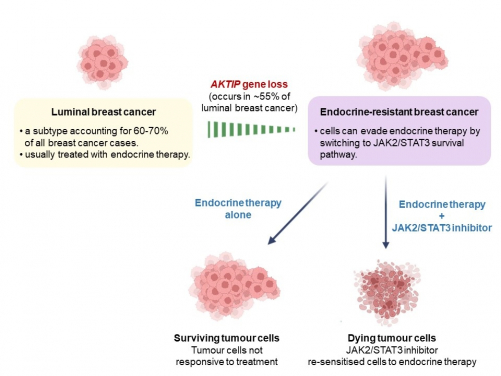
A research team from LKS Faculty of Medicine, the University of Hong Kong (HKUMed) discovered that somatic deletion of a tumour suppressor gene AKTIP promotes luminal breast cancer development and resistance to endocrine therapy. The findings are now published in Cell Reports.
Source: The University of Hong Kong
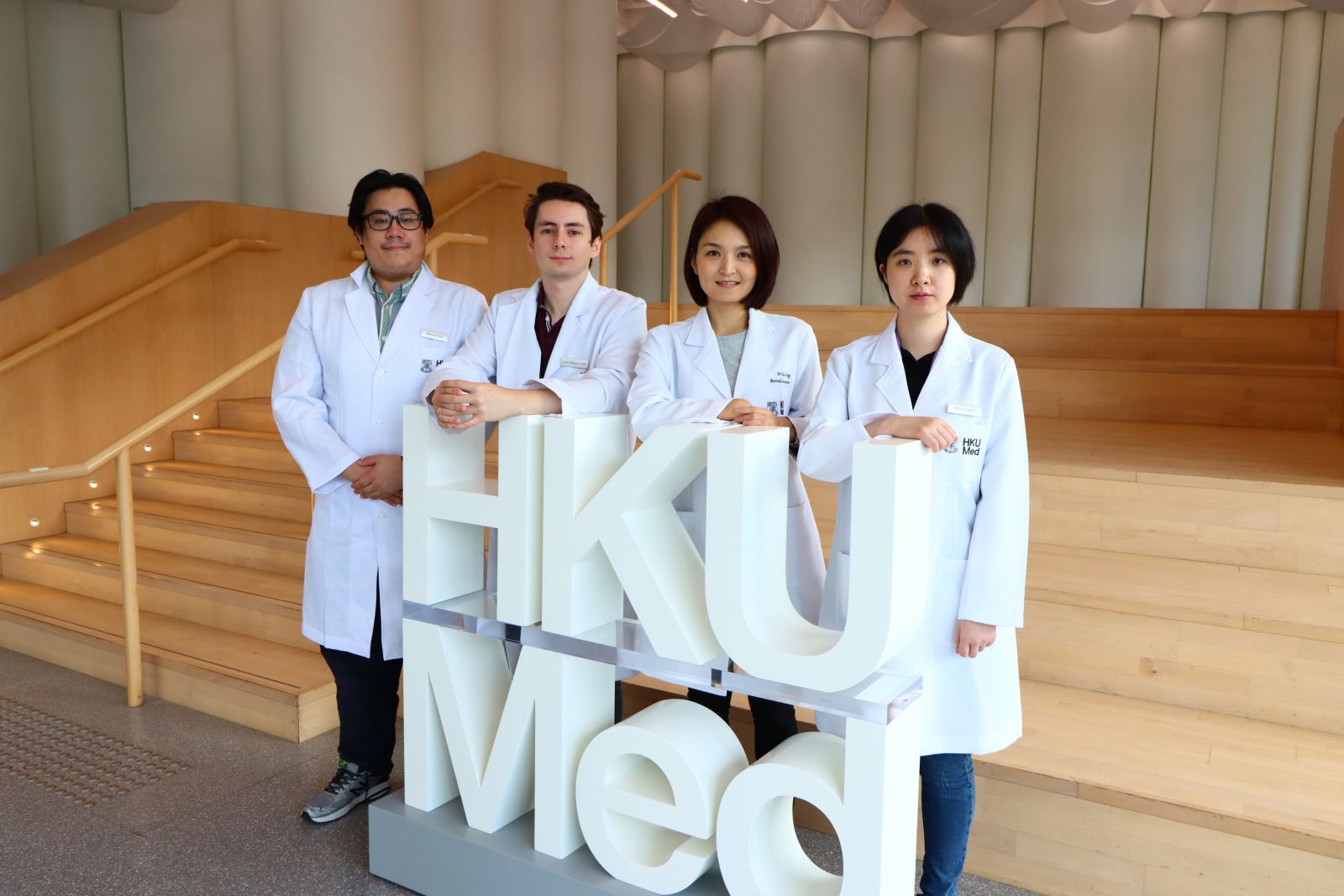
A research team from the LKS Faculty of Medicine, the University of Hong Kong (HKUMed) has identified an unexpected driver of cancer immunotherapy resistance: the harmful effect of chronic Type I Interferon signalling on tumour-killing CD8+ T cells. These findings provided new insights into the development of exhausted CD8+ T cells, which no longer effectively limit tumour growth, and highlighted a new target for immunotherapy improvement. The research has been published in Cell Reports.
Source: The University of Hong Kong
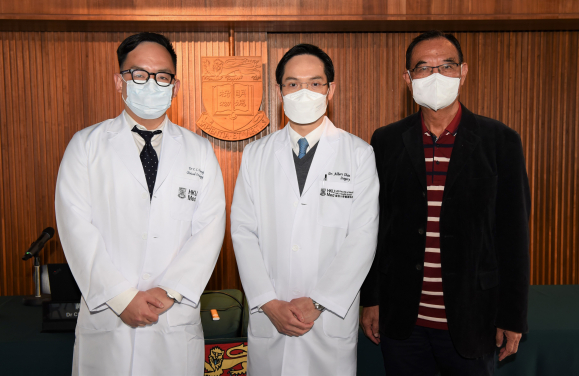
A pioneering phase II clinical study on tri-modality therapy (START-FIT), conducted by the Department of Surgery and Department of Clinical Oncology, School of Clinical Medicine, LKS Faculty of Medicine of the University of Hong Kong, has found that nearly 50% of patients with inoperable locally advanced liver cancer, can be cured through such an innovative approach. This revolutionary result has been published in The Lancet Gastroenterology and Hepatology.
Source: The University of Hong Kong
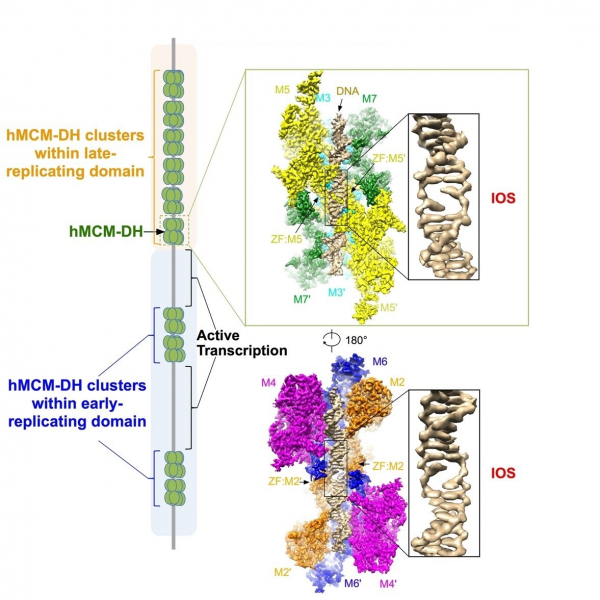
A research team led by Dr Yuanliang ZHAI from the School of Biological Sciences, The University of Hong Kong (HKU), and his collaborators from The Hong Kong University of Science and Technology (HKUST) and Institut Curie, France, has uncovered a new mechanism of the human MCM2-7 complex in regulating replication initiation, which can be used as a novel and effective anticancer strategy with the potential for selective killing of cancer cells. The findings were recently published in the Cell journal.
Source: The University of Hong Kong

Researchers at the AIDS Institute, Department of Microbiology, School of Clinical Medicine, and the State Key Laboratory of Emerging Infectious Diseases, LKS Faculty of Medicine of The University of Hong Kong (HKUMed) reveals that the timely third vaccination of either CoronaVac or BNT162b2 is critical to induce activated virus-specific memory B cells[1] and Omicron cross-reactive T cell responses, leading to significantly reduced frequencies of breakthrough infection and disease severity. Neutralising antibody potency against BA.2.12.1 and BA.4/5 was enhanced by the BA.2 breakthrough infection and bivalent booster vaccination among people who had received prior 3 doses of vaccines. The research paper is now online in the journal of The Lancet Regional Health – Western Pacific.
Source: The University of Hong Kong
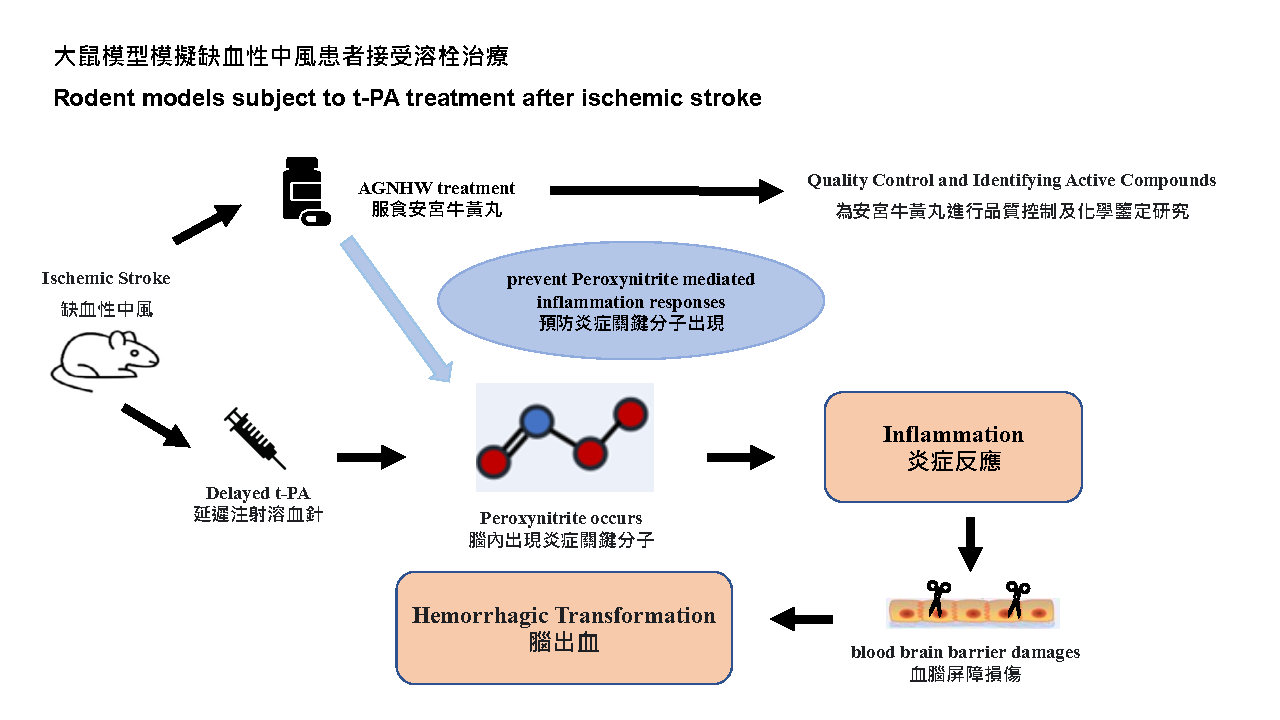
A research team led by Professor Shen Jiangang from the School of Chinese Medicine, LKS Faculty of Medicine, The University of Hong Kong (HKUMed) reveals that Angong Niuhuang Wan (AGNHW), a classical Chinese medicinal formula, could extend therapeutic window for ischemic stroke by 30 minutes and reduce hemorrhagic transformation and mortality in ischemic stroke with Thrombolytic therapy. The findings have been recently published in the scientific journal Chinese Medicine.
Source: The University of Hong Kong
2024
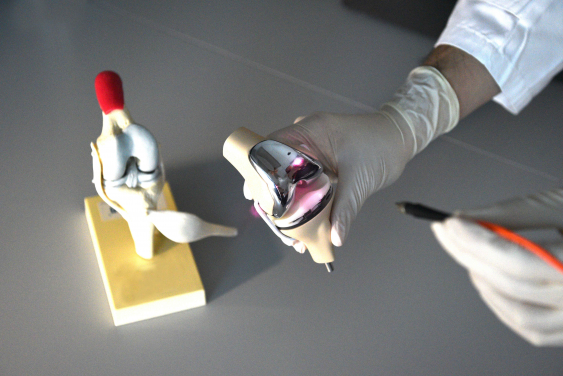
A research team led by Professor Kelvin Yeung Wai-kwok from the Department of Orthopaedics and Traumatology, School of Clinical Medicine, LKS Faculty of Medicine, the University of Hong Kong (HKUMed), has developed an innovative photocurrent-responsive implant surface to accelerate bone-to-implant integration after orthopaedic surgery. The cutting-edge coating has been shown to shorten the integration time to just two weeks, doubling the speed and expediting post-operative recovery as well as reducing the risk of rejection. The team is currently exploring the application of this technology in artificial joint replacement surgeries, including commonly performed knee replacement surgeries in Hong Kong.
Source: The University of Hong Kong
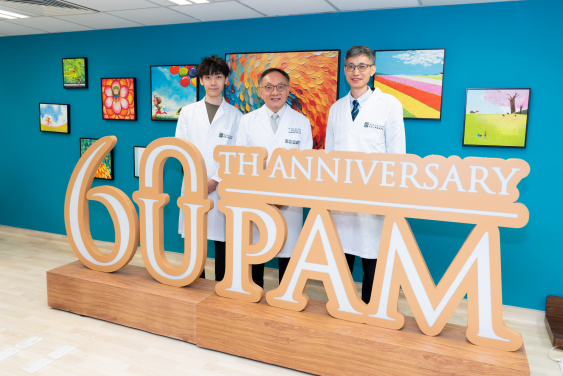
Researchers at the LKS Faculty of Medicine of the University of Hong Kong (HKUMed) have discovered a significant association between specific Epstein-Barr virus (EBV) variants and nasopharyngeal carcinoma (NPC). NPC is a cancer notably prevalent in southern China, where it is 20 times more common than in non-endemic regions of the world. The findings, published in the journal PLoS Pathogens (link to publication), provide the basis for further scientific research and have potential application to population screening and diagnostic tests.
NPC, often referred to as ‘Cantonese Cancer’, affects predominantly 30- to 60-year-old men in southern China, including Guangdong and Hong Kong, and Southeast Asia. The cause is associated with various factors, including genetics, environment and viruses. The researchers emphasise that understanding the role of EBV in NPC’s pathogenesis is crucial since the virus has 100% association with this cancer.
Source: The University of Hong Kong
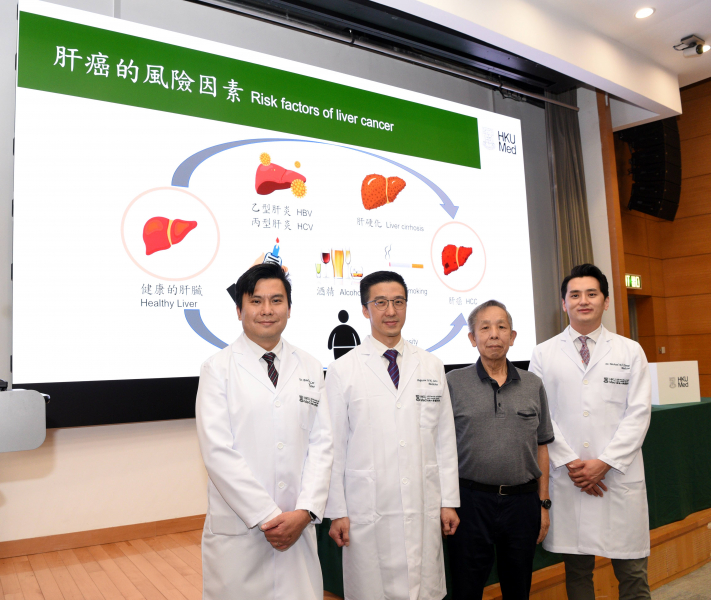
Colorectal cancer and liver cancer are the second and fifth most common cancers in Hong Kong, respectively, and both are associated with notably high mortality rates. This underscores the urgent need to develop effective strategies to combat these formidable diseases. A joint research team from the Department of Medicine and the Department of Clinical Oncology, both under the School of Clinical Medicine in the LKS Faculty of Medicine of the University of Hong Kong (HKUMed), conducted two territory-wide studies using data from the Hospital Authority, spanning up to 17 years, to identify over 140,000 patients with diabetes. The results revealed that optimal control of diabetes significantly reduced the risk of colorectal and liver cancer by 28% and 30%, respectively.
Source: The University of Hong Kong
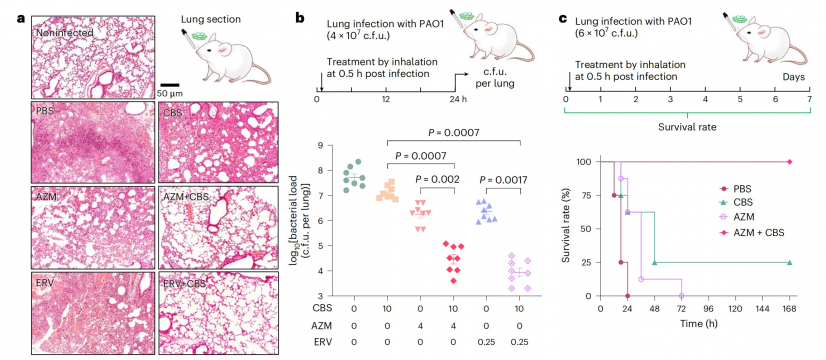
Antimicrobial resistance (AMR) bacterial infections have become a serious problem threatening human health worldwide. The overuse of antibiotics has promoted drug-resistant mutations in bacteria, causing almost all clinically used antibiotics to develop resistance in different strains. In May 2024, the World Health Organization (WHO) updated its list of drug-resistant bacteria that pose the greatest threat to human health, among which Pseudomonas aeruginosa was listed as a high-priority pathogen.
Pseudomonas aeruginosa is a particularly dangerous bacterium that can cause a wide range of infections, including pneumonia, urinary tract infections, and bloodstream infections. It is known for its ability to develop resistance to antibiotics quickly, making it challenging to treat and posing a significant risk to immunocompromised patients, such as those in hospitals or with chronic illnesses. Given the urgency of the situation, it is essential to develop new treatment strategies to combat superbug infections.
Source: The University of Hong Kong

Leveraging rapid technological advances for human health is a global trend, driving the rise of biomedical engineering research.
An interdisciplinary research team, including the Faculty of Engineering and Li Ka Shing Faculty of Medicine at The University of Hong Kong (HKU), Zhejiang University, and Guangzhou Medical University, has developed a groundbreaking continuous glucose monitoring (CGM) system which represents a major advancement in wearable health technology and is set to revolutionise diabetes management.
Source: The University of Hong Kong
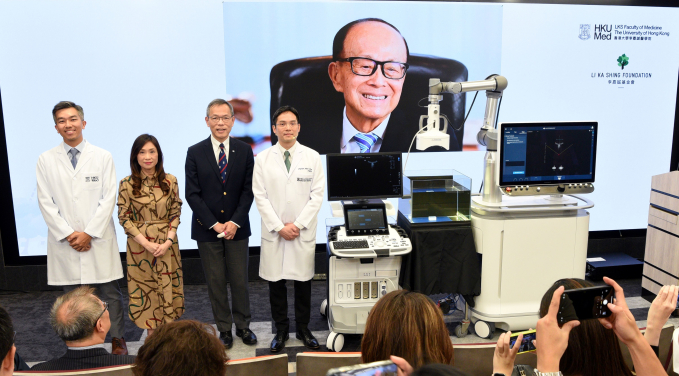
With a generous donation from the Li Ka Shing Foundation, the LKS Faculty of Medicine at the University of Hong Kong (HKUMed) will be the first institution in Asia to introduce the groundbreaking Histotripsy system, using state-of-the-art histotripsy technology for clinical trials, offering Hong Kong liver cancer patients access to non-invasive, painless and highly effective treatment.
Ten patients will be sponsored by the Foundation to receive this novel treatment as part of the initial clinical trials to be conducted at Queen Mary Hospital. The first patient is expected to undergo treatment within this week. The donation also supported six doctors and radiologists to attend specialised training at the US manufacturer HistoSonics to ensure they are comprehensively versed in the optimal utilisation of this cutting-edge technology.
Source: The University of Hong Kong
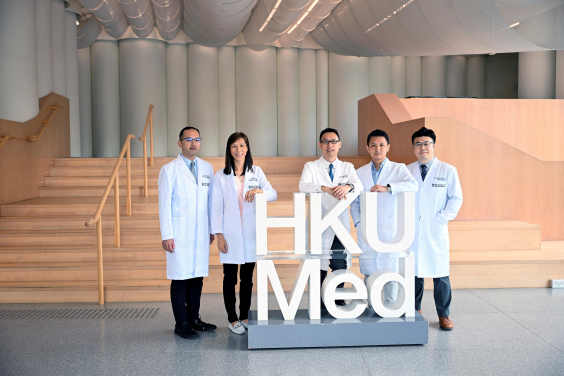
Researchers at the LKS Faculty of Medicine, the University of Hong Kong (HKUMed) revealed that critically ill patients with influenza A have a significantly higher risk of developing acute kidney injury (AKI) than those with COVID-19. The findings, published in eClinical Medicine, highlight the important differences in the impact of these two respiratory viruses on kidney health.
The study, which analysed data from a Hong Kong-wide cohort, found that influenza patients had a 49% higher risk of developing AKI than those with COVID-19. The influenza group also had a 43% higher risk of developing stage 3 AKI and a 48% increased requirement for acute dialysis.
These findings are in stark contrast to earlier reports that suggested a higher risk of AKI and more severe renal impairment among COVID-19 patients,’ said Dr Desmond Yap Yat-hin, Associate Professor from the Department of Medicine, School of Clinical Medicine, HKUMed, who led the research. ‘Our study sheds new light on the evolving landscape of COVID-19 and its impact on renal health.’
Source: The University of Hong Kong
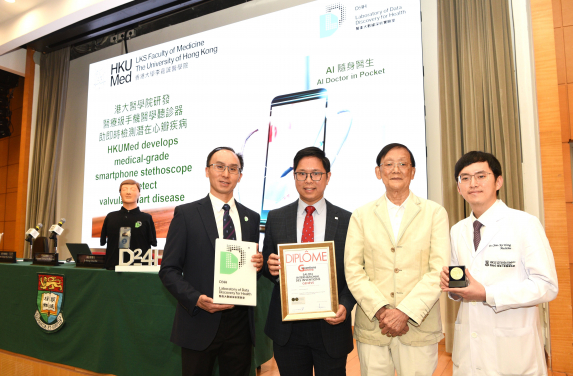
An interdisciplinary team from the Li Ka Shing Faculty of Medicine of the University of Hong Kong (HKUMed) has developed an innovative artificial intelligence (AI) software system that can turn an ordinary mobile phone into a medical-grade stethoscope, allowing anyone to use a smartphone to detect heart disease symptoms at their fingertips, and subsequently seek immediate medical attention, without the need for other specialised devices. This patented AI technology enables the detection of valvular heart disease, with an estimated accuracy of 81% – a level comparable to a doctor’s assessment using a stethoscope. This invention promotes early detection of valvular heart disease, personalised health management, heart disease screening, the use of telemedicine, and remote disease monitoring.
Source: The University of Hong Kong
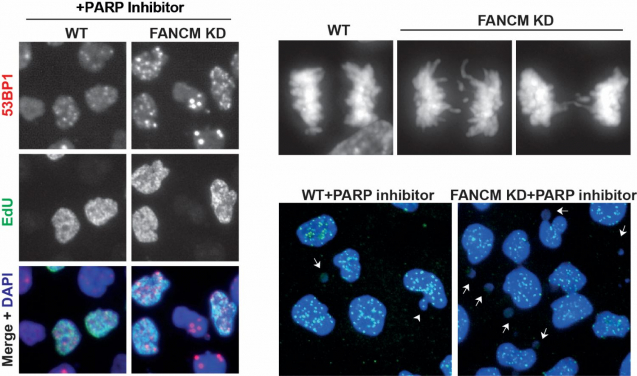
A research team led by Professor Ying Wai CHAN from the School of Biological Sciences at The University of Hong Kong (HKU) has made a significant breakthrough in understanding how cancer cells develop resistance to a class of cancer drugs known as PARP inhibitors. Their latest findings, published in Cell Reports, reveal the crucial role of a protein named FANCM in promoting resistance to these drugs.
Source: The University of Hong Kong
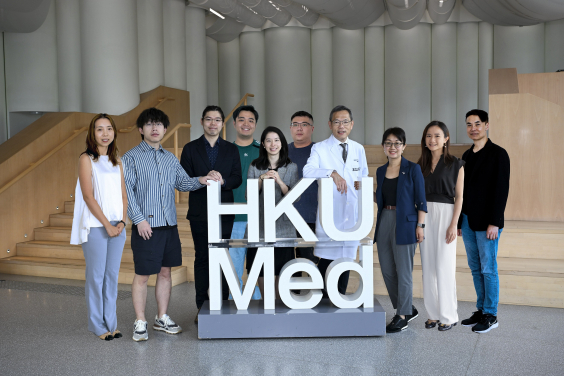
A research team from the LKS Faculty of Medicine of the University of Hong Kong (HKUMed) performed a cost-effectiveness analysis of treatment strategies for patients in Hong Kong with rheumatoid arthritis. The researchers found that for patients who had an inadequate response to the first-line therapy of methotrexate, using biosimilar disease-modifying anti-rheumatic drugs (DMARDs) is more cost-effective than the commonly used leflunomide. By adopting biosimilars, healthcare institutions in Hong Kong can optimise resource allocation, improve overall patient outcomes, and establish a more efficient and sustainable health service model. The study findings were published in JAMA Network Open journal.
Source: The University of Hong Kong
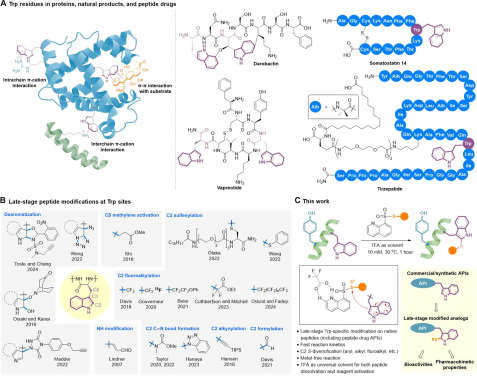
Recently, a team led by Professor Xuechen LI from the Department of Chemistry of The University of Hong Kong (HKU) developed a clickable tryptophan modification strategy. This strategy allows for the easy modification of a specific part of a peptide molecule even at the late-stage of drug development process. This late-stage diversification technique allows them to fine-tune peptides even after the core structure is established. Their findings have recently been published in Science Advances.
This approach involves a late-stage catalyst-free C2-sulfenylation reaction using S-modified quinoline-containing thiosulfonate reagents. Through this method, the researchers efficiently install a variety of functional groups onto the tryptophan (Trp) residues within the native peptide structures. The introduced groups include trifluoromethylthio, difluoromethylthio, (ethoxycarbonyl) difluoromethylthio, alkylthio and arylthiol.
Source: The University of Hong Kong

A cross-institutional research team led by the LKS Faculty of Medicine, the University of Hong Kong (HKUMed), has developed a novel cinnamaldehyde-based prodrug nanomedicine by utilising cinnamaldehyde, a common food additive, as an anti-inflammatory agent. The prodrug forms nanoparticles that deliver the therapeutic agents precisely to the inflamed sites, offering a solution for the treatment of inflammatory diseases like rheumatoid arthritis (RA). This innovative invention was awarded the ‘Gold Medal’ at the International Exhibition of Inventions of Geneva earlier this year. The research findings were published in Advanced Healthcare Materials, and a patent application was filed based on this work.
Source: The University of Hong Kong
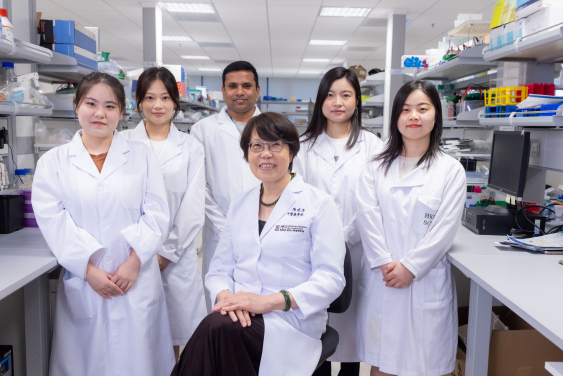
A research team from the School of Chinese Medicine, LKS Faculty of Medicine, the University of Hong Kong (HKUMed) has made a remarkable discovery that patients with non-alcoholic fatty liver disease (commonly known as fatty liver disease) exhibit excessive production of a hepatokine called ‘Fibroblast Growth Factor 21 (FGF21)’ in their liver, which may accelerate the growth of breast cancer tumours. The findings provide scientific evidence validating the traditional Chinese medicine (TCM) theory of ‘breast disease from liver dysfunction’, and shedding light on the potential mechanisms underlying TCM treatments for breast-related conditions. The findings were published in the scientific journal Cell Death and Disease
Source: The University of Hong Kong
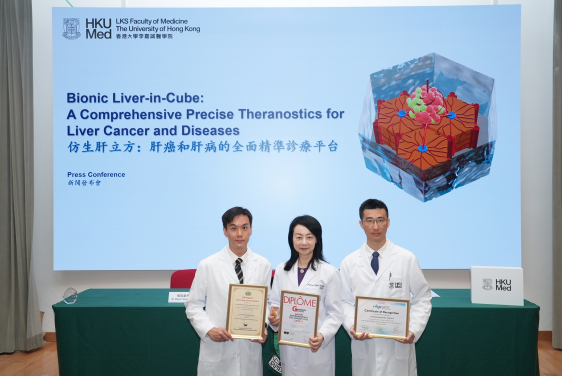
A research team from the LKS Faculty of Medicine at the University of Hong Kong (HKUMed) has developed ‘Bionic Liver-in-Cube: A Comprehensive Precise Theranostics for Liver Cancer and Diseases’ (‘Liver-in-Cube’). Using 3D bioprinting, it can mimic the liver tumour of patients for rapid evaluation of the efficacy and side effects of various traditional drugs and emerging therapies, helping doctors make accurate diagnosis and treatment decisions. The innovative invention was awarded a ‘Gold Medal’ and won the special grand prize ‘Prize of the China Invention Association’ at the International Exhibition of Inventions of Geneva earlier this year.
Source: The University of Hong Kong
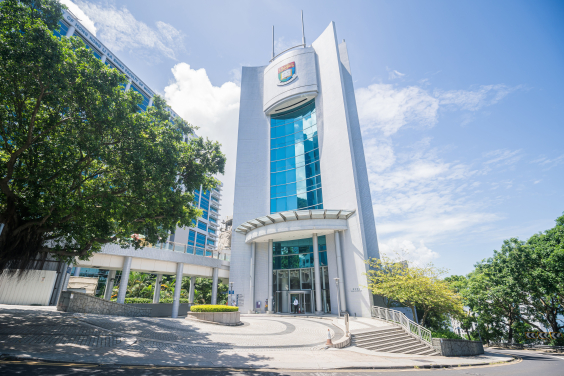
A research team led by Dr Albert Sin Chun-fung from the Department of Pathology, School of Clinical Medicine, LKS Faculty of Medicine of the University of Hong Kong (HKUMed) has achieved a significant breakthrough in characterising territory-wide cohorts of acquired haemophilia A (AHA) patients in Hong Kong and identifying their prognostic factors. This discovery provides valuable insights for improving survival rates among patients with this rare but fatal blood disorder.
The analysis revealed that the annual incidence of AHA cases in Hong Kong is twice as high as that observed in Caucasian populations. There is a higher mortality rate in the older demographic in local AHA patients, mainly because of severe infections resulting from immunosuppressive therapy.
Source: The University of Hong Kong

A collaborative research team of The University of Hong Kong (HKU), led by Professor Xiang David LI from the Department of Chemistry and Professor Chaogu ZHENG from the School of Biological Sciences, both from the Faculty of Science, along with Dr Xiucong BAO from the School of Biomedical Sciences, Li Ka Shing Faculty of Medicine, recently developed a novel chemical biology approach to label proteins from specific cells with a bifunctional amino acid probe that allows labelled proteins to be isolated and captures protein-protein interaction through photo-crosslinking.
This new method, Methionine Analog-based Cell-Specific Proteomics and Interactomics (MACSPI), uses a chemical probe to label proteins in specific cells and capture their interactions. Using this approach, the team has identified many new tissue-specific proteins and protein interactions, helping us better understand how cells work in living organisms and study various biological problems, such as organ development and disease pathogenesis. The research work was recently published in a leading multidisciplinary journal – Proceedings of the National Academy of Sciences (PNAS).
Source: The University of Hong Kong
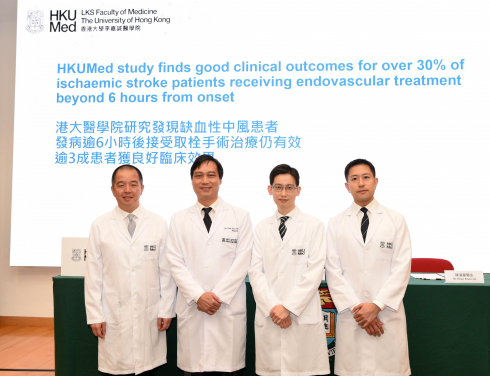
Endovascular treatment for acute ischaemic stroke patients beyond six hours from onset is still effective, according to a collaborative study conducted by the LKS Faculty of Medicine at the University of Hong Kong (HKUMed) and Queen Mary Hospital (QMH). The study, conducted over five years, found that over 30% of patients who received endovascular treatment had a good clinical outcome even after six hours of the onset of symptoms. Ischaemic stroke, a leading cause of death and disability in Hong Kong and worldwide, requires rapid and timely treatment to minimise patient harm.
In collaboration with neurologists, radiologists and neurosurgeons from HKUMed and QMH, the dedicated team has pioneered the first 24/7 intra-arterial mechanical thrombectomy for stroke in the territory since 2018. They also closely monitored the outcomes of this treatment. Over the period, more than 400 patients were treated, 13% of whom were treated six hours or more after the onset of symptoms. The study underscores the significance of ongoing research and advances in stroke treatment to improve patient outcomes and reduce the burden of this debilitating condition.
Source: The University of Hong Kong
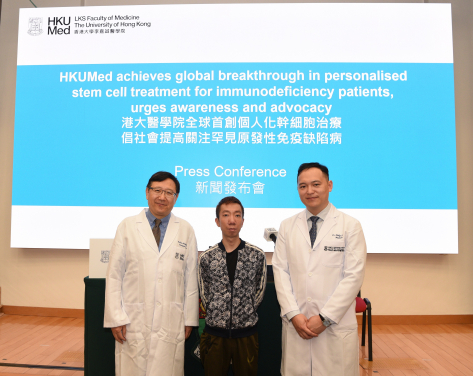
A collaborative research team, led by Dr Philip Li Hei, Professors Liu Pengtao and Chak-sing Lau from the LKS Faculty of Medicine of the University of Hong Kong (HKUMed), has pioneered a new stem cell model to help personalise treatment for patients suffering from rare forms of immunodeficiency. The research findings were published in the Journal of Allergy and Clinical Immunology.
Collaborating with partners at the Centre for Translational Stem Cell Biology (CTSCB) and the University of Cambridge, HKUMed has pioneered a new stem cell platform to help patients with primary immunodeficiencies. The research team took blood samples from patients and re-engineered the patients’ cells into Expanded Potential Stem Cells (EPSCs), which can be used as personalised disease models, enabling various therapies to be tested to identify the most effective and safest treatment options without causing unnecessary risk to the patients. The team has had remarkable success in identifying and repurposing drugs initially used to treat rheumatological conditions to treat individual STAT1-GoF patients in Hong Kong. The team’s stem cell platform has demonstrated curative potential of individualised gene therapy for these conditions.
Source: The University of Hong Kong
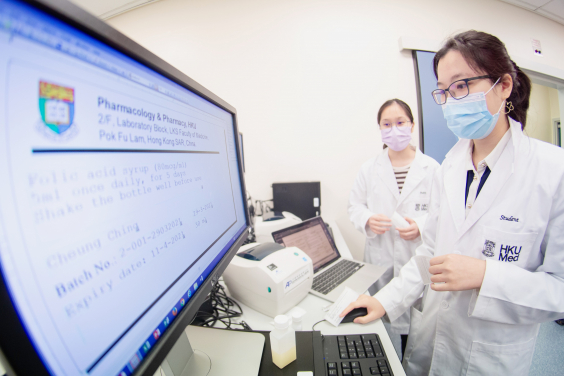
An international research team led by Professor Ian Wong Chi-kei, Head of the Department of Pharmacology and Pharmacy at LKS Faculty of Medicine of the University of Hong Kong (HKUMed) has just provided valuable evidence through a 20-year longitudinal study to address the longstanding debate concerning the potential impact of maternal diabetes on attention-deficit/hyperactivity disorder (ADHD) in children. This study, analysing real-world data from over 3.6 million mother-baby pairs in China’s Hong Kong, Taiwan, New Zealand, Finland, Iceland, Norway and Sweden, showed that maternal diabetes during pregnancy is unlikely to be a direct cause of ADHD. The findings of this groundbreaking study were published today (8 April) in Nature Medicine.
Source: The University of Hong Kong
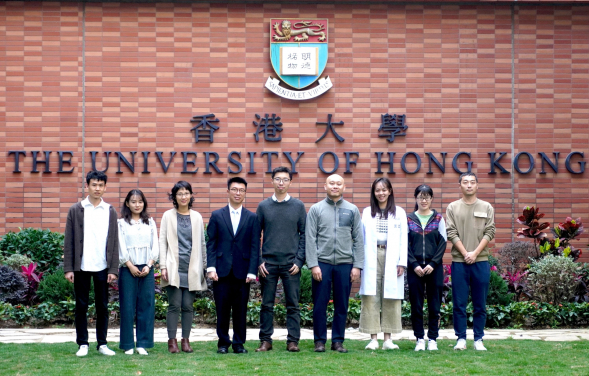
A multidisciplinary research team from the LKS Faculty of Medicine (HKUMed) and the Faculty of Engineering of the University of Hong Kong (HKU) has successfully developed an innovative screening platform to rapidly assess the impact of SARS-CoV-2 mutations on disease severity. Compared to traditional methods, this platform has achieved a speed improvement of up to 39 times. Additionally, the researchers focused on understanding how mutations affect syncytium formation, a process known as cell fusion in which infected cells fuse with uninfected cells. This research helps identify emerging viral variants that could pose a significant risk to public health. The team has also identified two FDA-approved drugs that can ease disease severity. The findings were published in Nature Biomedical Engineering [link to publication], and a patent application has been filed based on the research.
Source: The University of Hong Kong

A joint research team from the LKS Faculty of Medicine, the University of Hong Kong (HKUMed), and The Hong Kong University of Science and Technology (HKUST) has used stem cells to generate human immune cells for application in cancer immunotherapy. By replicating the natural process through which our bodies generate immune cells, this breakthrough platform is expected to significantly enhance cancer-targeting efficacy.
Source: The University of Hong Kong
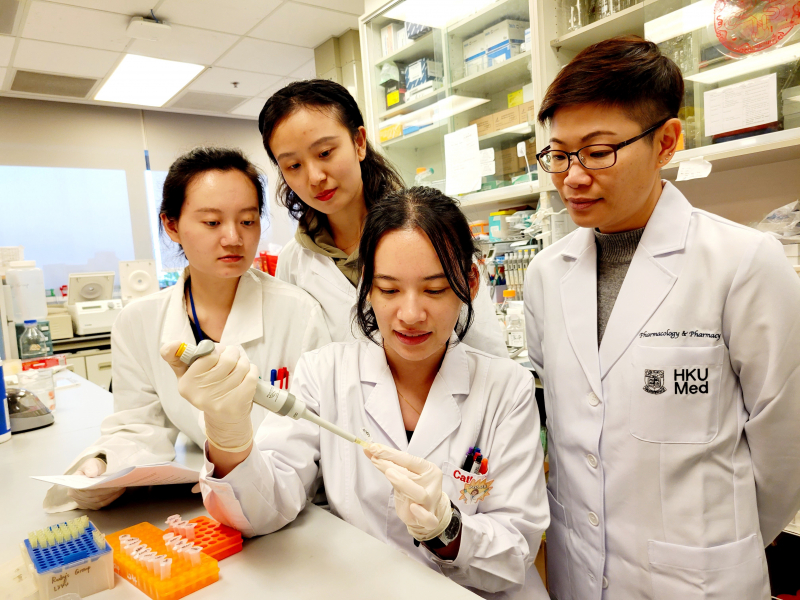
A research team from the LKS Faculty of Medicine at the University of Hong Kong (HKUMed) has successfully developed a neutralising monoclonal antibody, 6H2, which targets a harmful protein known to exacerbate damage caused by ischaemic stroke. Through pre-clinical experiments on animals, the team found that the 6H2 antibody effectively attenuates ischaemic stroke injury, offering potential for a highly effective pharmacological therapy for patients with ischemia stroke.
This remarkable breakthrough is the result of the concerted efforts of research teams from HKUMed’s Department of Pharmacology and Pharmacy, the State Key Laboratory of Pharmaceutical Biotechnology, and the Department of Medicine, School of Clinical Medicine, HKUMed, as well as the Shenzhen Institute of Advanced Technology, Chinese Academy of Sciences.
Source: The University of Hong Kong
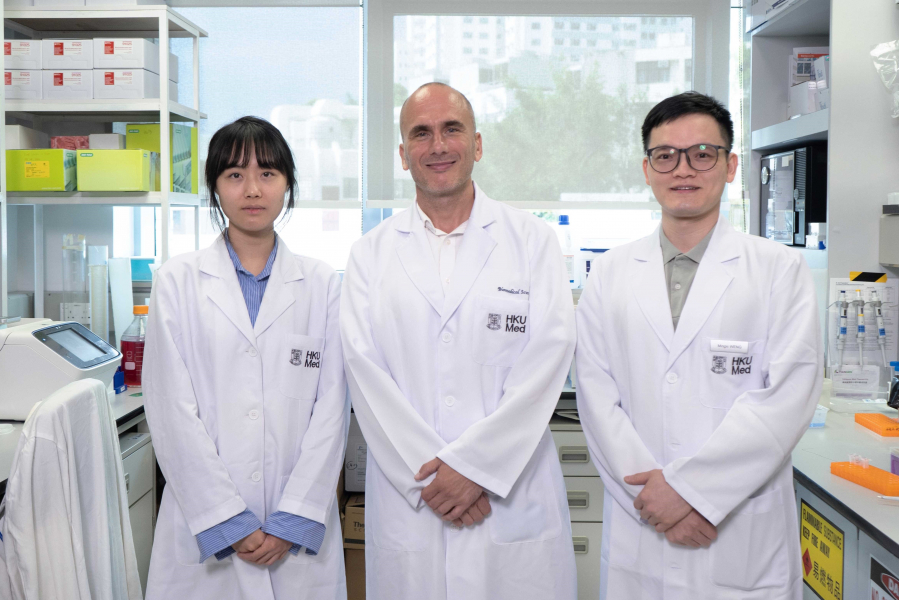
A research team from the School of Biomedical Sciences, LKS Faculty of Medicine of the University of Hong Kong (HKUMed), has achieved a breakthrough in stem cell research, offering tools that can be used for patients who require highly personalised care. The team has developed an innovative method to transform blood and skin cells into neural stem cells, overcoming the limitations of current stem cell research techniques while opening up new possibilities for studying and working towards treatments for age-related diseases, such as Alzheimer's, Parkinson's, and Amyotrophic lateral sclerosis.
Source: The University of Hong Kong

A team of researchers from The University of Hong Kong (HKU) has made a significant breakthrough in understanding how energy metabolism and bone homeostasis are regulated in mice, which could lead to novel treatments for obesity and osteoporosis.
Source: The University of Hong Kong

A research team at the LKS Faculty of Medicine, the University of Hong Kong (HKUMed), has discovered that exosomes derived from γδ-T cells not only have direct anti-tumour effects but also, when developed into a tumour vaccine, can effectively induce a tumour-specific immune response.
Source: The University of Hong Kong

A research team led by Professor Chaogu ZHENG from the School of Biological Sciences at The University of Hong Kong (HKU) recently discovered that propionate, a short-chain fatty acid (SCFA), strongly suppressed neurodegeneration in animal models of Parkinson’s disease (PD) by regulating interorgan signalling between the intestine and brain. Either inhibiting propionate breakdown or supplementing propionate through diet reversed PD-associated transcriptional aberration and enhanced energy production in the intestine, which in turn promoted neuronal health without the need of dispersing the protein aggregates. Such metabolic rescue of neurodegeneration by increasing propionate levels provides important new insights into the treatment of neurodegenerative diseases.
Source: The University of Hong Kong
.JPG)
Researchers at the AIDS Institute, Department of Microbiology, School of Clinical Medicine, and the State Key Laboratory of Emerging Infectious Diseases, LKS Faculty of Medicine of the University of Hong Kong (HKUMed), in collaboration with HKU-Shenzhen Hospital, Foshan University and The Third People’s Hospital of Shenzhen, found that PD-1-enhanced DNA vaccination can induce sustained virus-specific CD8+ T cell immunity in an AIDS monkey model. The vaccinated monkeys remained free of AIDS for six years and achieved virologic control without the need for combination antiretroviral therapy (cART), a treatment used to suppress viral replication in individuals living with human immunodeficiency virus (HIV). The study also found that polyfunctional and broadly reactive effector-memory virus-specific T cells were maintained in the protected experimental macaques for over six years. The findings provide supporting evidence that the PD-1-enhanced DNA vaccine strategy holds promise as a third-generation DNA vaccine for AIDS prevention and immunotherapy.
Source: The University of Hong Kong

An interdisciplinary research team led by Professor Jason Cheung Pui-yin from the Department of Orthopaedics and Traumatology, School of Clinical Medicine, LKS Faculty of Medicine of the University of Hong Kong (HKUMed); Dr Song You-qiang, School of Biomedical Sciences, HKUMed; and Dr Gao Bo, School of Biomedical Sciences, Faculty of Medicine, The Chinese University of Hong Kong; has achieved a global breakthrough by identifying a common underlying cause of adolescent idiopathic scoliosis (AIS), the most common form of spinal deformity, which affects millions of adolescents worldwide. The team discovered that variations in the SLC6A9 gene may cause idiopathic scoliosis, resulting in dysfunction of synaptic neurotransmission and central pattern generators (CPGs).
Source: The University of Hong Kong
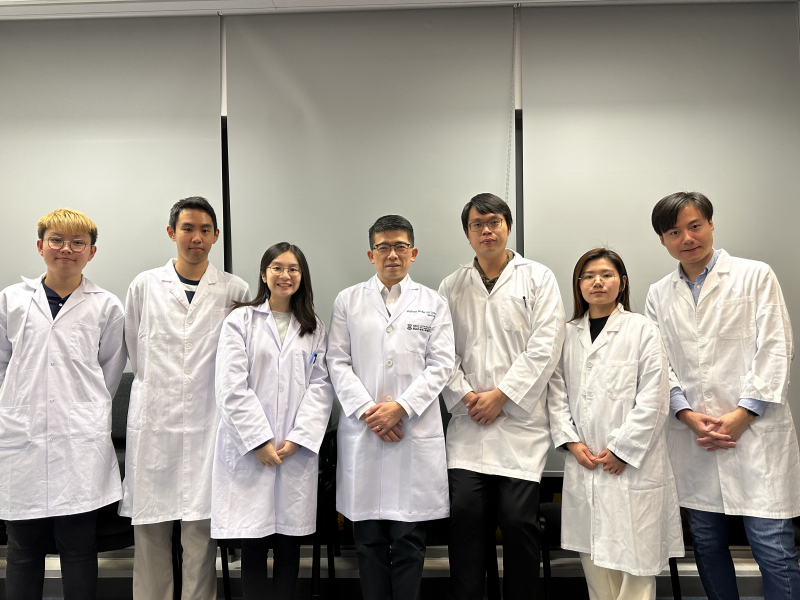
A research team led by Professor Anskar Leung Yu-hung, from the Department of Medicine, School of Clinical Medicine, LKS Faculty of Medicine, the University of Hong Kong (HKUMed), has identified PLK4 as a novel therapeutic target for acute myeloid leukaemia (AML) carrying the TP53 mutation. AML is a deadly disease, for which there is currently a lack of effective treatment options. The results may provide the mechanistic foundation for setting up clinical trials in this AML subtype with a view to improving the patient outcome. Queen Mary Hospital is one of the treatment sites in which the effect of a PLK4 inhibitor in AML patients will be tested.
Source: The University of Hong Kong
2025

A research team led by the Department of Paediatrics and Adolescent Medicine, School of Clinical Medicine, LKS Faculty of Medicine, the University of Hong Kong (HKUMed), has conducted a pioneering study that established a causal link between childhood maltreatment (CM) and various neuropsychiatric disorders. By employing genomic analysis on neuropsychiatric data from over 500,000 individuals and CM data from over 140,000 cases, the study found that CM victims face a nearly five-fold increased lifetime risk of developing schizophrenia. Furthermore, the findings indicate that CM significantly elevates the risk of multiple neuropsychiatric disorders through altered behavioral patterns, cognitive abilities, and genomic changes, providing the scientific evidence for developing more precise early intervention and prevention strategies. The study was published in The British Journal of Psychiatry.
Source: The University of Hong Kong

An international research team has identified a human protein, ANKLE1, as the first DNA-cutting enzyme (nuclease) in mammals capable of detecting and responding to physical tension in DNA. This ‘tension-sensing’ mechanism plays a vital role in maintaining genetic integrity during cell division—a process that, when disrupted, can lead to cancer and other serious diseases.
The study, published in Nature Communications, represents a major advance in the understanding of cellular DNA protection. The research was conducted through a cross-disciplinary collaboration between Professor Gary Ying Wai CHAN’s laboratory at the School of Biological Sciences, The University of Hong Kong (HKU) and Dr Artem EFREMOV’s biophysics team at Shenzhen Bay Laboratory (SZBL), with additional contributions from researchers at the Hong Kong University of Science and Technology (HKUST) and the Francis Crick Institute in London.
Source: The University of Hong Kong
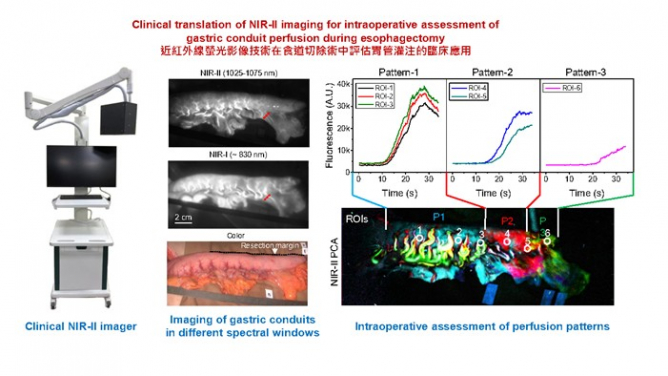
A cross-disciplinary research team led by Professor Hongjie DAI (Sapientia Eminence Professor, Chair Professor in Department of Chemistry, Department of Mechanical Engineering and School of Biomedical Sciences, Director of The Materials Institute of Life Sciences and Energy (MILES)) and Professor Simon Ying Kit LAW (Chairperson and Cheung Kung-Hai Professor in Gastrointestinal Surgery, Chair Professor in Department of Surgery, the School of Clinical Medicine, HKUMed) at The University of Hong Kong (HKU) has, for the first time, successfully applied NIR-II (1000–3000 nm) fluorescence video imaging during esophagectomy – a complex surgical procedure involving the resection of a diseased or cancerous portion of the esophagus, where the most dreaded complication, anastomotic leakage, a gastrointestinal defect at the suture line between the esophagus and the gastric conduit, affects 10-30% of patients and leads to high postoperative morbidity rate and even death. In Hong Kong, about 30 patients have already benefited from esophagectomy performed with the aid of this new fluorescence imaging and video analysis technique, with highly promising outcomes to date.
By combining high-clarity NIR-II video imaging with rapid computational video analysis, the HKU research team's pioneering technology enables operator-independent, objective delineation of boundaries between well-perfused and poorly perfused regions, providing precise guidance for resection and reconstruction to reduce the anastomotic leakage rate.
Source: The University of Hong Kong
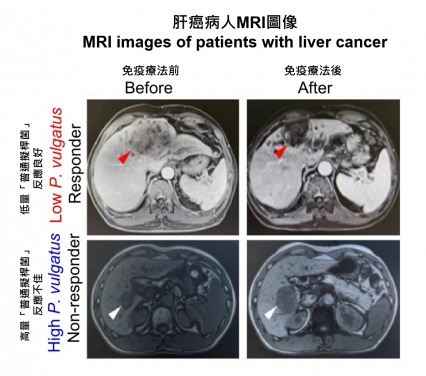
A research team led by the Department of Clinical Oncology, Centre of Cancer Medicine, School of Clinical Medicine, LKS Faculty of Medicine, the University of Hong Kong (HKUMed), has identified a critical factor contributing to the failure of liver cancer immunotherapy. The study discovered that the gut bacterium Phocaeicola vulgatus can disrupt the immune system, leading to resistance to immunotherapy in some liver cancer patients. This research reveals the significant impact of gut microbiota on cancer treatment, and proposes ‘microbiome modulation therapy’, which involves modifying gut microecology or supplementing with key metabolites to enhance the effectiveness of liver cancer immunotherapy. The findings, published in the international journal Cell Reports Medicine, offer a novel direction for improving immunotherapy efficacy.
Source: The University of Hong Kong
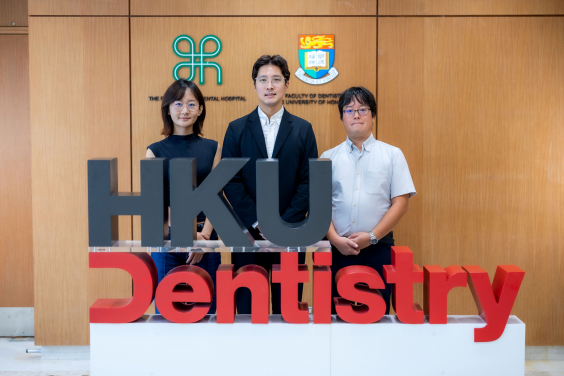
A research team led by the Faculty of Dentistry at The University of Hong Kong (HKU) has developed a novel vascularised tumour model using a non-surgical injectable hydrogel system. This innovative approach provides a powerful new platform for researching cancer and testing immune cell therapies. The breakthrough has been published in Advanced Composites and Hybrid Materials, representing a significant advancement in modelling the complex nature of tumours for oncology.
This study, led by Professor Sang Jin Lee, Assistant Professor in Biofunctional Materials from the Faculty of Dentistry, in collaboration with Professor Rio Ryohichi Sugimura, Assistant Professor from the School of Biomedical Sciences in LKS Faculty of Medicine at HKU, has established a reliable model using a fully degradable, injectable, self-crosslinking hydrogel composed of carboxymethyl chitosan (CMCTS) and oxidized hyaluronic acid (oHA) to encapsulate high-density tumour cells.
Source: The University of Hong Kong
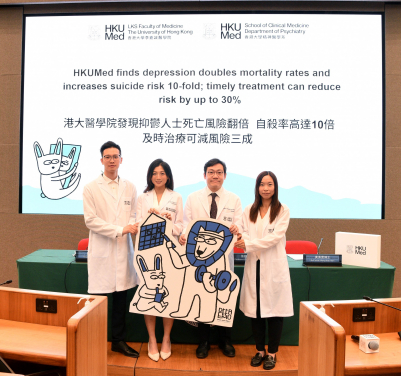
A world’s most comprehensive meta-analysis in depression and mortality, led by the Department of Psychiatry at the School of Clinical Medicine, LKS Faculty of Medicine at the University of Hong Kong (HKUMed), has found that people with depression have twice the risk of death than those without depression, and a nearly 10-fold increased risk of suicide. However, timely and effective treatment can significantly reduce these risks and improve survival rates. This study analysed data from 268 cohort studies, covering over 10 million people living with depression and nearly 2.8 billion controls, making it the largest research of its kind to date. The findings were published in the international journal World Psychiatry.
Source: The University of Hong Kong
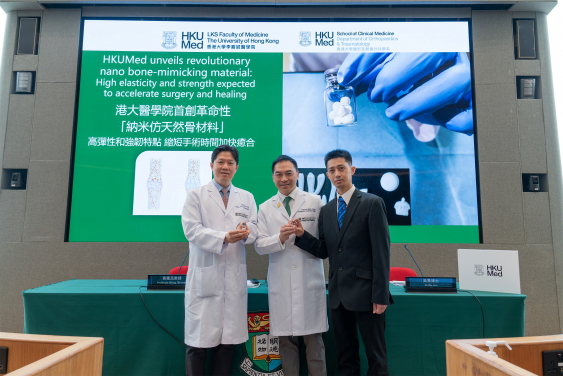
A research team from the Department of Orthopaedics and Traumatology at the University of Hong Kong’s LKS Faculty of Medicine (HKUMed) has successfully developed a novel elastic calcium phosphate material that mimics the structure of human bone. The material, dubbed ‘nano bone cement’, offers a promising alternative to traditional bone grafts in orthopaedic surgeries, which typically rely on harvesting tissue from the patient or a donor. Research and experimental results show that this innovative bone material provides robust mechanical support and accelerates healing in bone-defect cases.
The team plans to apply this technology to repair large segmental bone defects, potentially speeding up patient recovery and achieving optimal outcomes. The research findings were published in the journal Nature Communications, underscoring its scientific validity and effectiveness.
Source: The University of Hong Kong
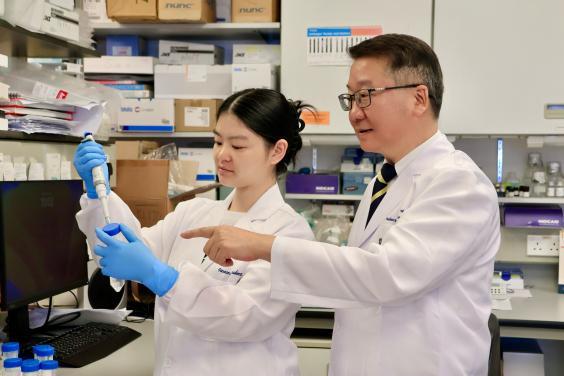
A research team at the LKS Faculty of Medicine of the University of Hong Kong (HKUMed) discovered that certain dietary fatty acids can supercharge the human immune system's ability to fight cancer. The team found that a healthy fatty acid found in olive oil and nuts, called oleic acid (OA), enhances the power of immune γδ-T cells, specialised cells known for their cancer-fighting properties. Conversely, they found that another fatty acid, called palmitic acid (PA), commonly found in palm oil and fatty meats, diminishes the ability of these immune cells to attack tumours. This groundbreaking study, published in the academic journal Signal Transduction and Targeted Therapy, offers an innovative approach using dietary OA supplementation to strengthen the antitumour immunity of γδ-T cells.
Source: The University of Hong Kong

Researchers from the Department of Microbiology, School of Clinical Medicine, LKS Faculty of Medicine of the University of Hong Kong (HKUMed) and the InnoHK Centre for Virology, Vaccinology and Therapeutics (CVVT), in collaboration with Sichuan University, have discovered a powerful bispecific inhibitor capable of combating all existing human-pathogenic coronaviruses, including those resistant to existing treatments like Paxlovid. This promising inhibitor, named TMP1, offers hope for more effective and resilient treatments against future outbreaks. A patent has been filed for further exploration in clinical applications. The study’s findings were published in the peer-reviewed scientific journal Nature Communications.
Source: The University of Hong Kong
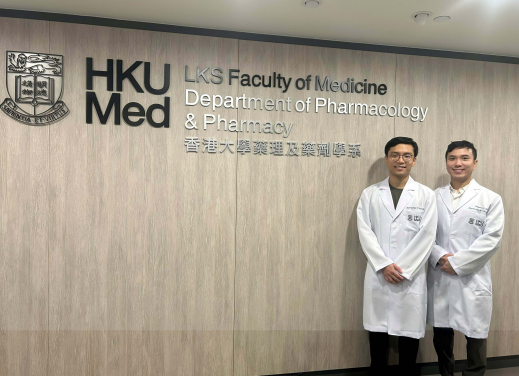
A research team in the Department of Pharmacology and Pharmacy at the LKS Faculty of Medicine of the University of Hong Kong (HKUMed), has conducted a pioneering study that found an association between walking speed and cancer risk. The researchers found that individuals who walk faster have a markedly lower overall risk of developing cancer, particularly lung cancer. This association was consistent regardless of whether walking speed was self-reported or objectively measured.
This large-scale prospective cohort study analysed data from over 430,000 UK Biobank participants and validated the findings in a Hong Kong cohort. The results suggest that the ‘quality’ of walking—specifically speed—may offer more preventive value than the ‘quantity’ of walking. Walking speed could serve as a simple indicator for cancer risk, thus aiding in developing personalised cancer-prevention strategies. The study was published in the Journal of Cachexia, Sarcopenia and Muscle.
Source: The University of Hong Kong
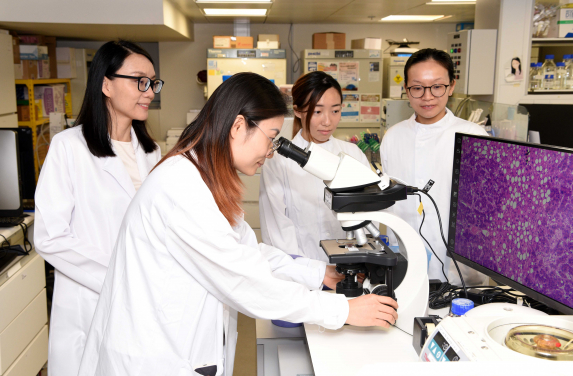
A research team from the Department of Pathology at the University of Hong Kong’s LKS Faculty of Medicine (HKUMed) has made a major breakthrough by discovering that atorvastatin, a widely used cholesterol-lowering drug could become a powerful new weapon in the fight against liver cancer. The findings demonstrate how this safe, affordable medication can exploit a hidden weakness in liver cancer cells and boosting the effectiveness of current treatments. This research was published on the Journal of Hepatology.
Source: The University of Hong Kong
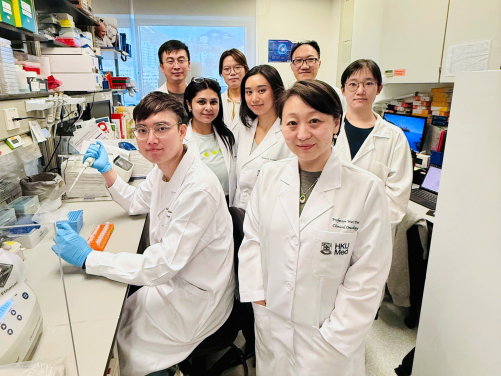
Researchers from the Department of Clinical Oncology, Centre of Cancer Medicine, School of Clinical Medicine, LKS Faculty of Medicine of the University of Hong Kong (HKUMed), have discovered that the Epstein-Barr virus (EBV), a common human virus closely linked to nasopharyngeal carcinoma (NPC), can change the 3D structure of the human genome inside cancer cells, much like assembling building blocks. This groundbreaking finding reveals the mechanism by which EBV actively promotes cancer progression and offers promising avenues for developing targeted therapies for patients, with the aim of saving more lives. The findings were published in the scientific journal Nature Communications.
Source: The University of Hong Kong

Researchers from the School of Biomedical Sciences at the LKS Faculty of Medicine, the University of Hong Kong (HKUMed), have made a significant advancement that could reshape the treatment landscape for hepatocellular carcinoma (HCC), the most common type of liver cancer, which often resists treatment and recurs. This cancer is especially prevalent in Southeast Asia and China. The research, published in the journal Science Translational Medicine, revealed a previously unknown mechanism that allows HCC to grow more aggressively and evade existing therapies. The team also developed a new small molecule inhibitor that could improve treatment options for HCC patients.
Source: The University of Hong Kong
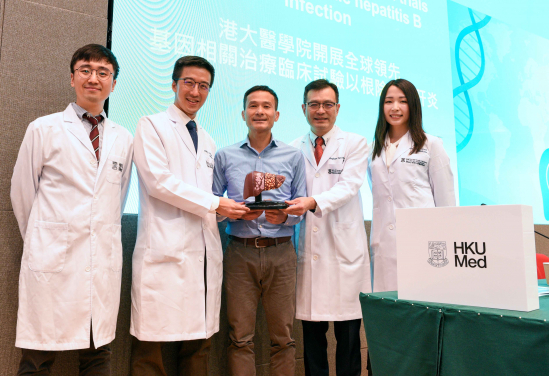
Researchers in gastroenterology and hepatology at the LKS Faculty of Medicine, the University of Hong Kong (HKUMed), have initiated multiple clinical trials exploring pioneering gene-related therapy for chronic hepatitis B infection, potentially allowing patients to discontinue long-term medication. This positions HKUMed as one of only three global sites conducting these groundbreaking trials, alongside counterparts in Europe and New Zealand.
‘The first participant in the Hong Kong trial was dosed in March this year, organised by the University of Hong Kong Clinical Trials Centre (HKU-CTC), yielding encouraging results,’ said Professor Yuen Man-fung, Li Shu Fan Medical Foundation Professor in Medicine, Chair Professor and Chief of the Division of Gastroenterology and Hepatology, and Deputy Chairperson, Department of Medicine, School of Clinical Medicine, HKUMed, who is leading this global project.
As the trials progress, they underscore Hong Kong’s status as a leader in global scientific medical research, offering hope to millions affected by chronic hepatitis B. ‘With an expected enrollment of 30 to 40 participants by the end of 2026, the future looks promising for those seeking respite from this persistent and deadly infection,’ Professor Yuen added.
Source: The University of Hong Kong

Researchers at the School of Chinese Medicine, LKS Faculty of Medicine, the University of Hong Kong (HKUMed), have made a breakthrough in the treatment of autoimmune diseases. Their study reveals that combining the active ingredient extracted from the traditional Chinese medicine Astragalus membranaceus (huang qi) with the widely used Western drug methotrexate (MTX) can effectively reduce chronic inflammation in autoimmune diseases such as systemic lupus erythematosus and Sjögren’s disease. This study provides a new solution to address the drug resistance and the side effects caused by long-term medication. The research findings were published in two leading international journals, Acta Pharmacologica Sinica and Journal of Leukocyte Biology, where they were featured as cover stories.
Source: The University of Hong Kong
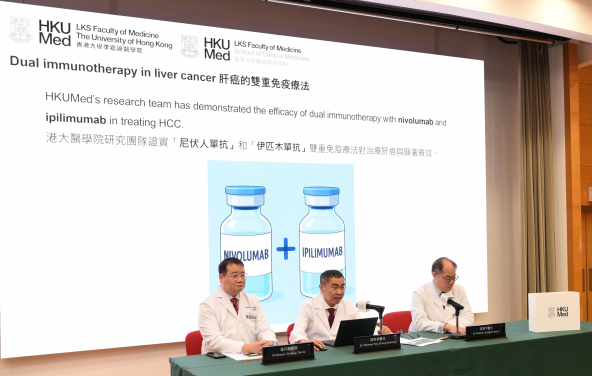
A research team from the School of Clinical Medicine of the LKS Faculty of Medicine of the University of Hong Kong (HKUMed) has pioneered the use of a ‘dual immunotherapy’ combination—nivolumab and ipilimumab (NIVO+IPI) — in the treatment of liver cancer patients since 2016. This innovative treatment has proved to significantly improve survival rates and tumour control compared to current first-line treatments, lenvatinib and sorafenib. Recently it was approved by the US Food and Drug Administration (FDA), the European Medicines Agency (EMA) and China’s National Medical Products Administration (NMPA) for global use, offering new hope to liver cancer patients worldwide. This landmark study was published in The Lancet.
Source: The University of Hong Kong
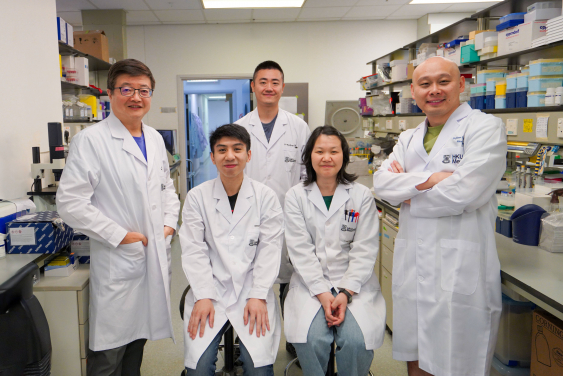
Over 40 million people worldwide are living with HIV-1, which continues to be a major global health challenge due to its ability to persist silently within immune cells, evading complete eradication. Researchers at LKS Faculty of Medicine, the University of Hong Kong (HKUMed), have identified a specific gene transcription factor, BRD9, as a potential key to unlocking the mechanisms behind HIV-1 latency. This could pave the way for AIDS to no longer be a largely incurable disease. The study has been published in the scientific journal The Proceedings of the National Academy of Sciences (PNAS).
Source: The University of Hong Kong
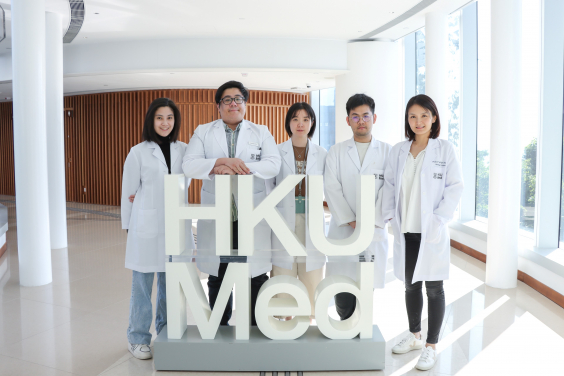
Modern unhealthy lifestyles and dietary habits have led to a yearly increase in the incidence of metabolism-related liver cancer. A research team from the LKS Faculty of Medicine at the University of Hong Kong (HKUMed), in collaboration with Peking University (PKU), found that fats in liver cancer can reprogramme immune cells, causing them to malfunction and driving resistance to current first-line liver-cancer treatments. The findings were published in the Journal of Experimental Medicine.
Source: The University of Hong Kong
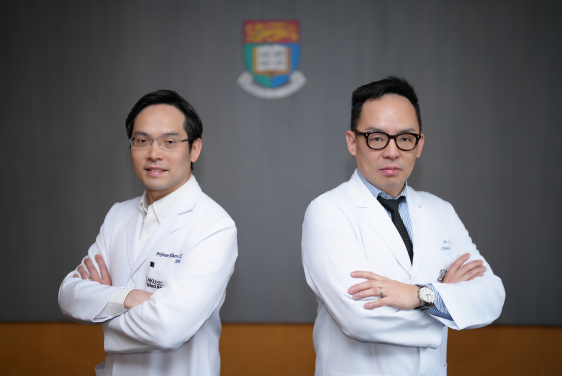
An interdisciplinary research team from the Department of Surgery and Department of Clinical Oncology, School of Clinical Medicine at the LKS Faculty of Medicine of the University of Hong Kong (HKUMed), has demonstrated a durable and lasting response to a novel treatment – combined locoregional therapy and immunotherapy (LRT-IO) – for advanced liver cancer patients. The study marks the first investigation into the long-term outcomes for patients with locally advanced liver cancer receiving this treatment. The researchers identified key factors associated with a complete response, and found that this pioneering approach is safe, effective and sustainable. The findings were recently published in the journal JAMA Oncology.
Source: The University of Hong Kong
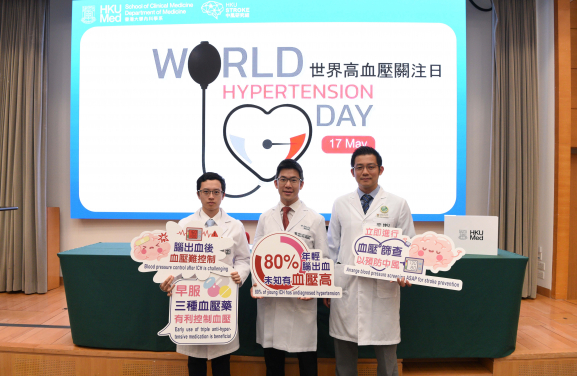
In a significant advancement for stroke care, researchers from HKU Stroke and the Department of Medicine, School of Clinical Medicine at the LKS Faculty of Medicine of the University of Hong Kong (HKUMed) have developed the TRICH score. This innovative clinical tool is designed to help physicians effectively identify intracerebral hemorrhage (ICH) patients who would benefit from early prescription of triple anti-hypertensive medication. The TRICH score addresses a critical need in hypertension care after ICH by facilitating timely and effective blood pressure control. It also has the potential to significantly reduce the risk of ICH recurrence and subsequent strokes. The findings were published in the international journal Neurology.
In addition to the TRICH Score, HKU Stroke is conducting a separate study on the use of telemedicine for hypertension management in ICH patients, further enhancing their approach to patient care.
Source: The University of Hong Kong
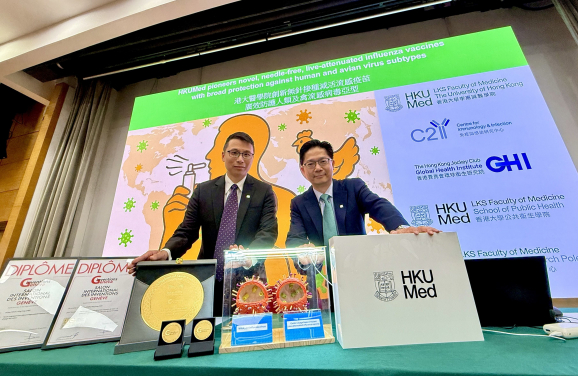
A research team led by the School of Public Health in the LKS Faculty of Medicine, the University of Hong Kong (HKUMed), in collaboration with the Centre for Immunology & Infection (C2i), has achieved a significant breakthrough in developing broadly protective, live-attenuated influenza vaccines (LAIV). These innovative LAIV platforms offer potential to develop universal influenza vaccines that induce a more robust immune response against various virus subtypes, including both human and avian strains. These achievements have resulted in multiple patents and impressive accolades at the 50th International Exhibition of Inventions Geneva 2025, including the Saudi Innovation Excellence Prize and two Gold Medals, one of which came with Congratulations of the Jury.
Source: The University of Hong Kong
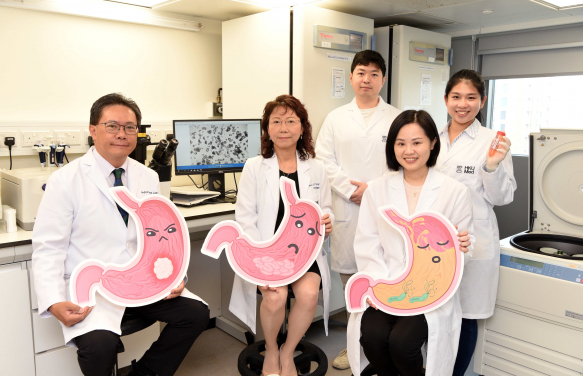
Researchers from the Department of Pathology, School of Clinical Medicine at the LKS Faculty of Medicine of the University of Hong Kong (HKUMed) have made significant advancements in understanding the earliest stages of stomach cancer, a leading cause of cancer-related deaths worldwide, through two recent innovative studies. With a prevalence rates particularly high in East Asia, including China, this cancer often stems from chronic inflammation caused by Helicobacter pylori infection, which affects approximately 15% of the Hong Kong population. This inflammation can lead to a pre-cancerous stage known as intestinal metaplasia. The innovative studies have uncovered crucial insights into the earliest changes in the stomach that contribute to the development of stomach cancer, laying the foundation for improved prevention and early detection, ultimately saving lives.
While the stomach’s acidic environment aids digestion, it can induce cancer-causing mutations in normal stomach tissues as individuals age. However, the timing and mechanisms of these early changes and how they promote the progression to cancer remain largely unknown. HKUMed researchers provided valuable insights into these processes.
Source: The University of Hong Kong

Researchers at the LKS Faculty of Medicine of the University of Hong Kong (HKUMed) have made a breakthrough in cancer treatment by developing a new therapy, called photosensitive hybrid γδ-T exosomes (hybrid γδ-T-Exos). This therapy targets and destroys cancer cells, while promoting the release of damage-associated molecular patterns (DAMPs) and boosting the subsequent antigen-specific immune response. In laboratory tests and animal studies, this innovative hybrid therapy showed a significant reduction in melanoma growth, leading to more effective and safer treatments for cancers. The findings were published in the scientific journal ACS Nano.
Source: The University of Hong Kong
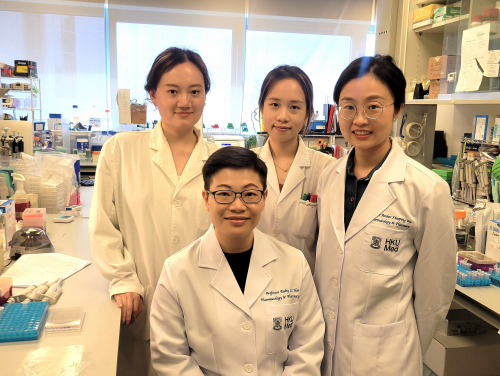
Obesity is a global health concern closely linked to a range of metabolic diseases, such as type 2 diabetes and cardiovascular diseases. A research team from the Department of Pharmacology and Pharmacy, LKS Faculty of Medicine at the University of Hong Kong (HKUMed), identified the mitochondria protein Chchd10 as a novel regulator of adipose tissue homeostasis, offering new insights into the management of obesity and its related metabolic disorders. The findings were published in Advanced Science.
Source: The University of Hong Kong
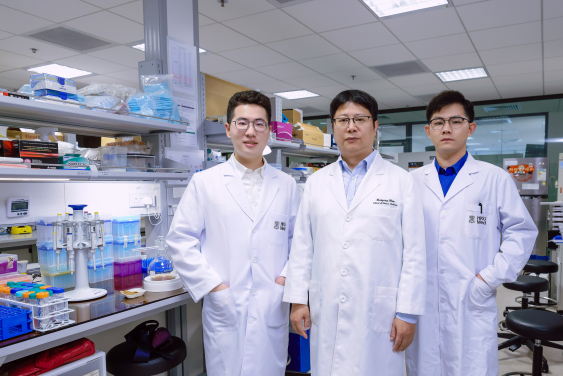
A research team from the School of Chinese Medicine in the LKS Faculty of Medicine of the University of Hong Kong (HKUMed) has discovered that C-reactive protein (CRP) can exacerbate kidney inflammation caused by diabetes, also known as diabetic kidney disease (DKD), through a Smad3-NLRP3 inflammasome-dependent mechanism. Therefore, future research targeting CRP or the Smad3-NLRP3 mechanism may provide new treatment directions for DKD. The findings were published in the scientific journal Molecular Therapy and featured as the cover story of the issue. The team is currently screening active compounds in traditional Chinese medicine that inhibit NLRP3 activation to find new treatments to reduce inflammation in patients with DKD.
Source: The University of Hong Kong

Researchers at the LKS Faculty of Medicine of the University of Hong Kong (HKUMed) have invented an oral formulation of arsenic trioxide (Oral-ATO; ARSENOL®) for the treatment of acute promyelocytic leukaemia (APL), a blood cancer with a high fatality rate. The invention and use of oral-ATO is of historic importance for medicine in Hong Kong. It is the first-ever prescription medication wholly invented and manufactured in Hong Kong, and also the first to obtain USA, European and Japanese patents. After over two decades of dedicated work, the HKU research team successfully translated this Hong Kong invention into clinical practice by incorporating oral-ATO into the treatment plan of APL patients. Extensive clinical studies of oral-ATO have demonstrated its high efficacy and safety in curing APL patients, with an overall survival (OS) rate exceeding 97%, along with a significant reduction in side-effects and treatment burden.
Source: The University of Hong Kong
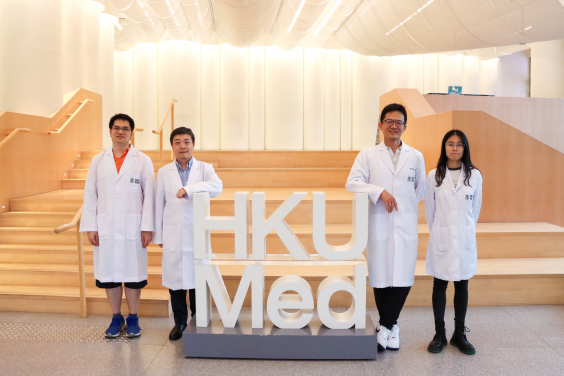
A joint research team from the LKS Faculty of Medicine (HKUMed) and the Faculty of Science at the University of Hong Kong has uncovered an unexpected interaction between chemotherapeutic agents and a crucial efficacy marker. This pioneering study, recently published in Nature Structural & Molecular Biology, sheds light on the complex interplay between taxanes—widely used chemotherapeutic drugs—and microtubule acetylation, a process vital for cancer cell sensitivity to treatment. In addition to deepening understanding of cancer biology, the study opens an avenue for innovative therapies aimed at enhancing patient outcomes and combating drug resistance, particularly for some of the most challenging malignancies, such as ovarian, breast, and lung cancers.
Source: The University of Hong Kong
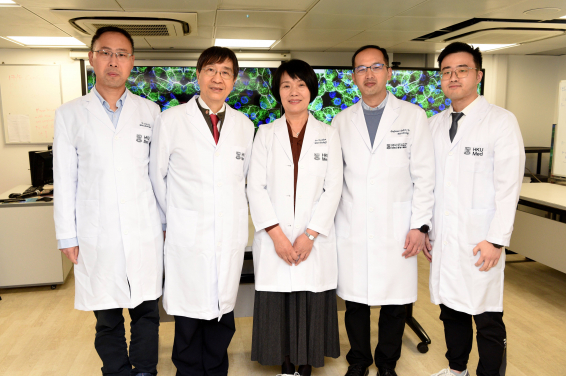
A research team led by Professor Jane Zhou Jie and Professor Yuen Kwok-Yung, from the Department of Microbiology under the School of Clinical Medicine in the LKS Faculty of Medicine of the University of Hong Kong (HKUMed), in collaboration with Professor Hans Clevers from the Hubrecht Institute, a pioneer in organoid technology, has achieved a groundbreaking milestone in virology research. The team successfully utilised human respiratory organoids (mini-organs) established by their team to propagate human rhinovirus C (HRV-C), which had previously been refractory to conventional virus cultivation. This breakthrough opens new avenues for understanding these common respiratory viruses and expediting the development of vaccines and antiviral drugs. The research findings were published in the latest issue of Nature Communications.
Source: The University of Hong Kong
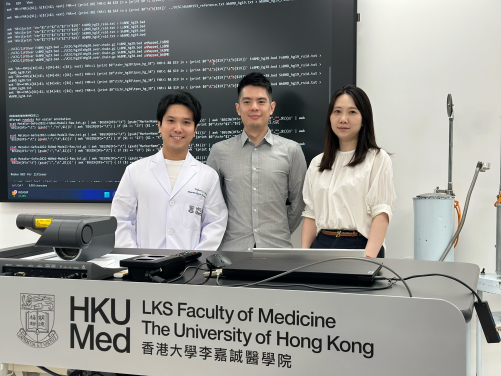
A research team in the Department of Pharmacology and Pharmacy, LKS Faculty of Medicine, the University of Hong Kong (HKUMed), found that hip fractures not only result in both physical and psychological injuries, but may also induce adverse cardiovascular events. In particular, hip fracture patients with pre-existing cardiac conditions are associated with a significantly higher risk of cardiovascular events (CVEs) and mortality, poorer prognosis, and greater health service utilisation. The research employed big data and artificial intelligence (AI) to uncover hidden clinical characteristics of hip fracture patients of different ethnicities, based on the electronic health records from Hong Kong and the United Kingdom (UK) of over 100,000 patients with hip fractures. The findings could enhance the current management of hip fracture patients and provide valuable insights into precision medicine in hip fracture patients. The study has been published in Nature Communications.
Source: The University of Hong Kong
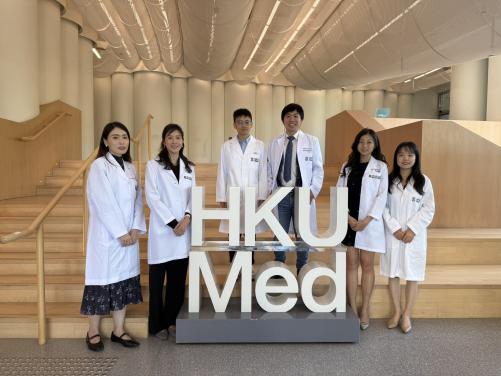
An inter-departmental research team at the LKS Faculty of Medicine of the University of Hong Kong (HKUMed) has conducted the world’s first analytic real-world cohort study on the association of clozapine, a highly efficacious antipsychotic drug, with the incidence of blood cancer. Their findings show that the risk of blood cancer associated with the use of clozapine is very low, with an average increase of less than six cases per 10,000 persons using clozapine for one year. Therefore, the clinical significance of such a risk is plausibly low. While previous preliminary Western studies have shown a potentially significant increase in risk, this study suggests that with stringent blood monitoring measures before and during clozapine use in Hong Kong and around the world, it may not be necessary to further restrict the use of clozapine or issue special warnings by the Department of Health or local drug regulatory authorities, thus facilitating early and effective treatment of mental illness. The study was published in PLOS Medicine.
Source: The University of Hong Kong
2025

A research team led by the Department of Paediatrics and Adolescent Medicine, School of Clinical Medicine, LKS Faculty of Medicine, the University of Hong Kong (HKUMed), has conducted a pioneering study that established a causal link between childhood maltreatment (CM) and various neuropsychiatric disorders. By employing genomic analysis on neuropsychiatric data from over 500,000 individuals and CM data from over 140,000 cases, the study found that CM victims face a nearly five-fold increased lifetime risk of developing schizophrenia. Furthermore, the findings indicate that CM significantly elevates the risk of multiple neuropsychiatric disorders through altered behavioral patterns, cognitive abilities, and genomic changes, providing the scientific evidence for developing more precise early intervention and prevention strategies. The study was published in The British Journal of Psychiatry.
Source: The University of Hong Kong

An international research team has identified a human protein, ANKLE1, as the first DNA-cutting enzyme (nuclease) in mammals capable of detecting and responding to physical tension in DNA. This ‘tension-sensing’ mechanism plays a vital role in maintaining genetic integrity during cell division—a process that, when disrupted, can lead to cancer and other serious diseases.
The study, published in Nature Communications, represents a major advance in the understanding of cellular DNA protection. The research was conducted through a cross-disciplinary collaboration between Professor Gary Ying Wai CHAN’s laboratory at the School of Biological Sciences, The University of Hong Kong (HKU) and Dr Artem EFREMOV’s biophysics team at Shenzhen Bay Laboratory (SZBL), with additional contributions from researchers at the Hong Kong University of Science and Technology (HKUST) and the Francis Crick Institute in London.
Source: The University of Hong Kong

A cross-disciplinary research team led by Professor Hongjie DAI (Sapientia Eminence Professor, Chair Professor in Department of Chemistry, Department of Mechanical Engineering and School of Biomedical Sciences, Director of The Materials Institute of Life Sciences and Energy (MILES)) and Professor Simon Ying Kit LAW (Chairperson and Cheung Kung-Hai Professor in Gastrointestinal Surgery, Chair Professor in Department of Surgery, the School of Clinical Medicine, HKUMed) at The University of Hong Kong (HKU) has, for the first time, successfully applied NIR-II (1000–3000 nm) fluorescence video imaging during esophagectomy – a complex surgical procedure involving the resection of a diseased or cancerous portion of the esophagus, where the most dreaded complication, anastomotic leakage, a gastrointestinal defect at the suture line between the esophagus and the gastric conduit, affects 10-30% of patients and leads to high postoperative morbidity rate and even death. In Hong Kong, about 30 patients have already benefited from esophagectomy performed with the aid of this new fluorescence imaging and video analysis technique, with highly promising outcomes to date.
By combining high-clarity NIR-II video imaging with rapid computational video analysis, the HKU research team's pioneering technology enables operator-independent, objective delineation of boundaries between well-perfused and poorly perfused regions, providing precise guidance for resection and reconstruction to reduce the anastomotic leakage rate.
Source: The University of Hong Kong

A research team led by the Department of Clinical Oncology, Centre of Cancer Medicine, School of Clinical Medicine, LKS Faculty of Medicine, the University of Hong Kong (HKUMed), has identified a critical factor contributing to the failure of liver cancer immunotherapy. The study discovered that the gut bacterium Phocaeicola vulgatus can disrupt the immune system, leading to resistance to immunotherapy in some liver cancer patients. This research reveals the significant impact of gut microbiota on cancer treatment, and proposes ‘microbiome modulation therapy’, which involves modifying gut microecology or supplementing with key metabolites to enhance the effectiveness of liver cancer immunotherapy. The findings, published in the international journal Cell Reports Medicine, offer a novel direction for improving immunotherapy efficacy.
Source: The University of Hong Kong

A research team led by the Faculty of Dentistry at The University of Hong Kong (HKU) has developed a novel vascularised tumour model using a non-surgical injectable hydrogel system. This innovative approach provides a powerful new platform for researching cancer and testing immune cell therapies. The breakthrough has been published in Advanced Composites and Hybrid Materials, representing a significant advancement in modelling the complex nature of tumours for oncology.
This study, led by Professor Sang Jin Lee, Assistant Professor in Biofunctional Materials from the Faculty of Dentistry, in collaboration with Professor Rio Ryohichi Sugimura, Assistant Professor from the School of Biomedical Sciences in LKS Faculty of Medicine at HKU, has established a reliable model using a fully degradable, injectable, self-crosslinking hydrogel composed of carboxymethyl chitosan (CMCTS) and oxidized hyaluronic acid (oHA) to encapsulate high-density tumour cells.
Source: The University of Hong Kong

A world’s most comprehensive meta-analysis in depression and mortality, led by the Department of Psychiatry at the School of Clinical Medicine, LKS Faculty of Medicine at the University of Hong Kong (HKUMed), has found that people with depression have twice the risk of death than those without depression, and a nearly 10-fold increased risk of suicide. However, timely and effective treatment can significantly reduce these risks and improve survival rates. This study analysed data from 268 cohort studies, covering over 10 million people living with depression and nearly 2.8 billion controls, making it the largest research of its kind to date. The findings were published in the international journal World Psychiatry.
Source: The University of Hong Kong

A research team from the Department of Orthopaedics and Traumatology at the University of Hong Kong’s LKS Faculty of Medicine (HKUMed) has successfully developed a novel elastic calcium phosphate material that mimics the structure of human bone. The material, dubbed ‘nano bone cement’, offers a promising alternative to traditional bone grafts in orthopaedic surgeries, which typically rely on harvesting tissue from the patient or a donor. Research and experimental results show that this innovative bone material provides robust mechanical support and accelerates healing in bone-defect cases.
The team plans to apply this technology to repair large segmental bone defects, potentially speeding up patient recovery and achieving optimal outcomes. The research findings were published in the journal Nature Communications, underscoring its scientific validity and effectiveness.
Source: The University of Hong Kong

A research team at the LKS Faculty of Medicine of the University of Hong Kong (HKUMed) discovered that certain dietary fatty acids can supercharge the human immune system's ability to fight cancer. The team found that a healthy fatty acid found in olive oil and nuts, called oleic acid (OA), enhances the power of immune γδ-T cells, specialised cells known for their cancer-fighting properties. Conversely, they found that another fatty acid, called palmitic acid (PA), commonly found in palm oil and fatty meats, diminishes the ability of these immune cells to attack tumours. This groundbreaking study, published in the academic journal Signal Transduction and Targeted Therapy, offers an innovative approach using dietary OA supplementation to strengthen the antitumour immunity of γδ-T cells.
Source: The University of Hong Kong

Researchers from the Department of Microbiology, School of Clinical Medicine, LKS Faculty of Medicine of the University of Hong Kong (HKUMed) and the InnoHK Centre for Virology, Vaccinology and Therapeutics (CVVT), in collaboration with Sichuan University, have discovered a powerful bispecific inhibitor capable of combating all existing human-pathogenic coronaviruses, including those resistant to existing treatments like Paxlovid. This promising inhibitor, named TMP1, offers hope for more effective and resilient treatments against future outbreaks. A patent has been filed for further exploration in clinical applications. The study’s findings were published in the peer-reviewed scientific journal Nature Communications.
Source: The University of Hong Kong

A research team in the Department of Pharmacology and Pharmacy at the LKS Faculty of Medicine of the University of Hong Kong (HKUMed), has conducted a pioneering study that found an association between walking speed and cancer risk. The researchers found that individuals who walk faster have a markedly lower overall risk of developing cancer, particularly lung cancer. This association was consistent regardless of whether walking speed was self-reported or objectively measured.
This large-scale prospective cohort study analysed data from over 430,000 UK Biobank participants and validated the findings in a Hong Kong cohort. The results suggest that the ‘quality’ of walking—specifically speed—may offer more preventive value than the ‘quantity’ of walking. Walking speed could serve as a simple indicator for cancer risk, thus aiding in developing personalised cancer-prevention strategies. The study was published in the Journal of Cachexia, Sarcopenia and Muscle.
Source: The University of Hong Kong

A research team from the Department of Pathology at the University of Hong Kong’s LKS Faculty of Medicine (HKUMed) has made a major breakthrough by discovering that atorvastatin, a widely used cholesterol-lowering drug could become a powerful new weapon in the fight against liver cancer. The findings demonstrate how this safe, affordable medication can exploit a hidden weakness in liver cancer cells and boosting the effectiveness of current treatments. This research was published on the Journal of Hepatology.
Source: The University of Hong Kong

Researchers from the Department of Clinical Oncology, Centre of Cancer Medicine, School of Clinical Medicine, LKS Faculty of Medicine of the University of Hong Kong (HKUMed), have discovered that the Epstein-Barr virus (EBV), a common human virus closely linked to nasopharyngeal carcinoma (NPC), can change the 3D structure of the human genome inside cancer cells, much like assembling building blocks. This groundbreaking finding reveals the mechanism by which EBV actively promotes cancer progression and offers promising avenues for developing targeted therapies for patients, with the aim of saving more lives. The findings were published in the scientific journal Nature Communications.
Source: The University of Hong Kong

Researchers from the School of Biomedical Sciences at the LKS Faculty of Medicine, the University of Hong Kong (HKUMed), have made a significant advancement that could reshape the treatment landscape for hepatocellular carcinoma (HCC), the most common type of liver cancer, which often resists treatment and recurs. This cancer is especially prevalent in Southeast Asia and China. The research, published in the journal Science Translational Medicine, revealed a previously unknown mechanism that allows HCC to grow more aggressively and evade existing therapies. The team also developed a new small molecule inhibitor that could improve treatment options for HCC patients.
Source: The University of Hong Kong

Researchers in gastroenterology and hepatology at the LKS Faculty of Medicine, the University of Hong Kong (HKUMed), have initiated multiple clinical trials exploring pioneering gene-related therapy for chronic hepatitis B infection, potentially allowing patients to discontinue long-term medication. This positions HKUMed as one of only three global sites conducting these groundbreaking trials, alongside counterparts in Europe and New Zealand.
‘The first participant in the Hong Kong trial was dosed in March this year, organised by the University of Hong Kong Clinical Trials Centre (HKU-CTC), yielding encouraging results,’ said Professor Yuen Man-fung, Li Shu Fan Medical Foundation Professor in Medicine, Chair Professor and Chief of the Division of Gastroenterology and Hepatology, and Deputy Chairperson, Department of Medicine, School of Clinical Medicine, HKUMed, who is leading this global project.
As the trials progress, they underscore Hong Kong’s status as a leader in global scientific medical research, offering hope to millions affected by chronic hepatitis B. ‘With an expected enrollment of 30 to 40 participants by the end of 2026, the future looks promising for those seeking respite from this persistent and deadly infection,’ Professor Yuen added.
Source: The University of Hong Kong

Researchers at the School of Chinese Medicine, LKS Faculty of Medicine, the University of Hong Kong (HKUMed), have made a breakthrough in the treatment of autoimmune diseases. Their study reveals that combining the active ingredient extracted from the traditional Chinese medicine Astragalus membranaceus (huang qi) with the widely used Western drug methotrexate (MTX) can effectively reduce chronic inflammation in autoimmune diseases such as systemic lupus erythematosus and Sjögren’s disease. This study provides a new solution to address the drug resistance and the side effects caused by long-term medication. The research findings were published in two leading international journals, Acta Pharmacologica Sinica and Journal of Leukocyte Biology, where they were featured as cover stories.
Source: The University of Hong Kong

A research team from the School of Clinical Medicine of the LKS Faculty of Medicine of the University of Hong Kong (HKUMed) has pioneered the use of a ‘dual immunotherapy’ combination—nivolumab and ipilimumab (NIVO+IPI) — in the treatment of liver cancer patients since 2016. This innovative treatment has proved to significantly improve survival rates and tumour control compared to current first-line treatments, lenvatinib and sorafenib. Recently it was approved by the US Food and Drug Administration (FDA), the European Medicines Agency (EMA) and China’s National Medical Products Administration (NMPA) for global use, offering new hope to liver cancer patients worldwide. This landmark study was published in The Lancet.
Source: The University of Hong Kong

Over 40 million people worldwide are living with HIV-1, which continues to be a major global health challenge due to its ability to persist silently within immune cells, evading complete eradication. Researchers at LKS Faculty of Medicine, the University of Hong Kong (HKUMed), have identified a specific gene transcription factor, BRD9, as a potential key to unlocking the mechanisms behind HIV-1 latency. This could pave the way for AIDS to no longer be a largely incurable disease. The study has been published in the scientific journal The Proceedings of the National Academy of Sciences (PNAS).
Source: The University of Hong Kong

Modern unhealthy lifestyles and dietary habits have led to a yearly increase in the incidence of metabolism-related liver cancer. A research team from the LKS Faculty of Medicine at the University of Hong Kong (HKUMed), in collaboration with Peking University (PKU), found that fats in liver cancer can reprogramme immune cells, causing them to malfunction and driving resistance to current first-line liver-cancer treatments. The findings were published in the Journal of Experimental Medicine.
Source: The University of Hong Kong

An interdisciplinary research team from the Department of Surgery and Department of Clinical Oncology, School of Clinical Medicine at the LKS Faculty of Medicine of the University of Hong Kong (HKUMed), has demonstrated a durable and lasting response to a novel treatment – combined locoregional therapy and immunotherapy (LRT-IO) – for advanced liver cancer patients. The study marks the first investigation into the long-term outcomes for patients with locally advanced liver cancer receiving this treatment. The researchers identified key factors associated with a complete response, and found that this pioneering approach is safe, effective and sustainable. The findings were recently published in the journal JAMA Oncology.
Source: The University of Hong Kong

In a significant advancement for stroke care, researchers from HKU Stroke and the Department of Medicine, School of Clinical Medicine at the LKS Faculty of Medicine of the University of Hong Kong (HKUMed) have developed the TRICH score. This innovative clinical tool is designed to help physicians effectively identify intracerebral hemorrhage (ICH) patients who would benefit from early prescription of triple anti-hypertensive medication. The TRICH score addresses a critical need in hypertension care after ICH by facilitating timely and effective blood pressure control. It also has the potential to significantly reduce the risk of ICH recurrence and subsequent strokes. The findings were published in the international journal Neurology.
In addition to the TRICH Score, HKU Stroke is conducting a separate study on the use of telemedicine for hypertension management in ICH patients, further enhancing their approach to patient care.
Source: The University of Hong Kong

A research team led by the School of Public Health in the LKS Faculty of Medicine, the University of Hong Kong (HKUMed), in collaboration with the Centre for Immunology & Infection (C2i), has achieved a significant breakthrough in developing broadly protective, live-attenuated influenza vaccines (LAIV). These innovative LAIV platforms offer potential to develop universal influenza vaccines that induce a more robust immune response against various virus subtypes, including both human and avian strains. These achievements have resulted in multiple patents and impressive accolades at the 50th International Exhibition of Inventions Geneva 2025, including the Saudi Innovation Excellence Prize and two Gold Medals, one of which came with Congratulations of the Jury.
Source: The University of Hong Kong

Researchers from the Department of Pathology, School of Clinical Medicine at the LKS Faculty of Medicine of the University of Hong Kong (HKUMed) have made significant advancements in understanding the earliest stages of stomach cancer, a leading cause of cancer-related deaths worldwide, through two recent innovative studies. With a prevalence rates particularly high in East Asia, including China, this cancer often stems from chronic inflammation caused by Helicobacter pylori infection, which affects approximately 15% of the Hong Kong population. This inflammation can lead to a pre-cancerous stage known as intestinal metaplasia. The innovative studies have uncovered crucial insights into the earliest changes in the stomach that contribute to the development of stomach cancer, laying the foundation for improved prevention and early detection, ultimately saving lives.
While the stomach’s acidic environment aids digestion, it can induce cancer-causing mutations in normal stomach tissues as individuals age. However, the timing and mechanisms of these early changes and how they promote the progression to cancer remain largely unknown. HKUMed researchers provided valuable insights into these processes.
Source: The University of Hong Kong

Researchers at the LKS Faculty of Medicine of the University of Hong Kong (HKUMed) have made a breakthrough in cancer treatment by developing a new therapy, called photosensitive hybrid γδ-T exosomes (hybrid γδ-T-Exos). This therapy targets and destroys cancer cells, while promoting the release of damage-associated molecular patterns (DAMPs) and boosting the subsequent antigen-specific immune response. In laboratory tests and animal studies, this innovative hybrid therapy showed a significant reduction in melanoma growth, leading to more effective and safer treatments for cancers. The findings were published in the scientific journal ACS Nano.
Source: The University of Hong Kong

Obesity is a global health concern closely linked to a range of metabolic diseases, such as type 2 diabetes and cardiovascular diseases. A research team from the Department of Pharmacology and Pharmacy, LKS Faculty of Medicine at the University of Hong Kong (HKUMed), identified the mitochondria protein Chchd10 as a novel regulator of adipose tissue homeostasis, offering new insights into the management of obesity and its related metabolic disorders. The findings were published in Advanced Science.
Source: The University of Hong Kong

A research team from the School of Chinese Medicine in the LKS Faculty of Medicine of the University of Hong Kong (HKUMed) has discovered that C-reactive protein (CRP) can exacerbate kidney inflammation caused by diabetes, also known as diabetic kidney disease (DKD), through a Smad3-NLRP3 inflammasome-dependent mechanism. Therefore, future research targeting CRP or the Smad3-NLRP3 mechanism may provide new treatment directions for DKD. The findings were published in the scientific journal Molecular Therapy and featured as the cover story of the issue. The team is currently screening active compounds in traditional Chinese medicine that inhibit NLRP3 activation to find new treatments to reduce inflammation in patients with DKD.
Source: The University of Hong Kong

Researchers at the LKS Faculty of Medicine of the University of Hong Kong (HKUMed) have invented an oral formulation of arsenic trioxide (Oral-ATO; ARSENOL®) for the treatment of acute promyelocytic leukaemia (APL), a blood cancer with a high fatality rate. The invention and use of oral-ATO is of historic importance for medicine in Hong Kong. It is the first-ever prescription medication wholly invented and manufactured in Hong Kong, and also the first to obtain USA, European and Japanese patents. After over two decades of dedicated work, the HKU research team successfully translated this Hong Kong invention into clinical practice by incorporating oral-ATO into the treatment plan of APL patients. Extensive clinical studies of oral-ATO have demonstrated its high efficacy and safety in curing APL patients, with an overall survival (OS) rate exceeding 97%, along with a significant reduction in side-effects and treatment burden.
Source: The University of Hong Kong

A joint research team from the LKS Faculty of Medicine (HKUMed) and the Faculty of Science at the University of Hong Kong has uncovered an unexpected interaction between chemotherapeutic agents and a crucial efficacy marker. This pioneering study, recently published in Nature Structural & Molecular Biology, sheds light on the complex interplay between taxanes—widely used chemotherapeutic drugs—and microtubule acetylation, a process vital for cancer cell sensitivity to treatment. In addition to deepening understanding of cancer biology, the study opens an avenue for innovative therapies aimed at enhancing patient outcomes and combating drug resistance, particularly for some of the most challenging malignancies, such as ovarian, breast, and lung cancers.
Source: The University of Hong Kong

A research team led by Professor Jane Zhou Jie and Professor Yuen Kwok-Yung, from the Department of Microbiology under the School of Clinical Medicine in the LKS Faculty of Medicine of the University of Hong Kong (HKUMed), in collaboration with Professor Hans Clevers from the Hubrecht Institute, a pioneer in organoid technology, has achieved a groundbreaking milestone in virology research. The team successfully utilised human respiratory organoids (mini-organs) established by their team to propagate human rhinovirus C (HRV-C), which had previously been refractory to conventional virus cultivation. This breakthrough opens new avenues for understanding these common respiratory viruses and expediting the development of vaccines and antiviral drugs. The research findings were published in the latest issue of Nature Communications.
Source: The University of Hong Kong

A research team in the Department of Pharmacology and Pharmacy, LKS Faculty of Medicine, the University of Hong Kong (HKUMed), found that hip fractures not only result in both physical and psychological injuries, but may also induce adverse cardiovascular events. In particular, hip fracture patients with pre-existing cardiac conditions are associated with a significantly higher risk of cardiovascular events (CVEs) and mortality, poorer prognosis, and greater health service utilisation. The research employed big data and artificial intelligence (AI) to uncover hidden clinical characteristics of hip fracture patients of different ethnicities, based on the electronic health records from Hong Kong and the United Kingdom (UK) of over 100,000 patients with hip fractures. The findings could enhance the current management of hip fracture patients and provide valuable insights into precision medicine in hip fracture patients. The study has been published in Nature Communications.
Source: The University of Hong Kong

An inter-departmental research team at the LKS Faculty of Medicine of the University of Hong Kong (HKUMed) has conducted the world’s first analytic real-world cohort study on the association of clozapine, a highly efficacious antipsychotic drug, with the incidence of blood cancer. Their findings show that the risk of blood cancer associated with the use of clozapine is very low, with an average increase of less than six cases per 10,000 persons using clozapine for one year. Therefore, the clinical significance of such a risk is plausibly low. While previous preliminary Western studies have shown a potentially significant increase in risk, this study suggests that with stringent blood monitoring measures before and during clozapine use in Hong Kong and around the world, it may not be necessary to further restrict the use of clozapine or issue special warnings by the Department of Health or local drug regulatory authorities, thus facilitating early and effective treatment of mental illness. The study was published in PLOS Medicine.
Source: The University of Hong Kong
2024

A research team led by Professor Kelvin Yeung Wai-kwok from the Department of Orthopaedics and Traumatology, School of Clinical Medicine, LKS Faculty of Medicine, the University of Hong Kong (HKUMed), has developed an innovative photocurrent-responsive implant surface to accelerate bone-to-implant integration after orthopaedic surgery. The cutting-edge coating has been shown to shorten the integration time to just two weeks, doubling the speed and expediting post-operative recovery as well as reducing the risk of rejection. The team is currently exploring the application of this technology in artificial joint replacement surgeries, including commonly performed knee replacement surgeries in Hong Kong.
Source: The University of Hong Kong

Researchers at the LKS Faculty of Medicine of the University of Hong Kong (HKUMed) have discovered a significant association between specific Epstein-Barr virus (EBV) variants and nasopharyngeal carcinoma (NPC). NPC is a cancer notably prevalent in southern China, where it is 20 times more common than in non-endemic regions of the world. The findings, published in the journal PLoS Pathogens (link to publication), provide the basis for further scientific research and have potential application to population screening and diagnostic tests.
NPC, often referred to as ‘Cantonese Cancer’, affects predominantly 30- to 60-year-old men in southern China, including Guangdong and Hong Kong, and Southeast Asia. The cause is associated with various factors, including genetics, environment and viruses. The researchers emphasise that understanding the role of EBV in NPC’s pathogenesis is crucial since the virus has 100% association with this cancer.
Source: The University of Hong Kong

Colorectal cancer and liver cancer are the second and fifth most common cancers in Hong Kong, respectively, and both are associated with notably high mortality rates. This underscores the urgent need to develop effective strategies to combat these formidable diseases. A joint research team from the Department of Medicine and the Department of Clinical Oncology, both under the School of Clinical Medicine in the LKS Faculty of Medicine of the University of Hong Kong (HKUMed), conducted two territory-wide studies using data from the Hospital Authority, spanning up to 17 years, to identify over 140,000 patients with diabetes. The results revealed that optimal control of diabetes significantly reduced the risk of colorectal and liver cancer by 28% and 30%, respectively.
Source: The University of Hong Kong

Antimicrobial resistance (AMR) bacterial infections have become a serious problem threatening human health worldwide. The overuse of antibiotics has promoted drug-resistant mutations in bacteria, causing almost all clinically used antibiotics to develop resistance in different strains. In May 2024, the World Health Organization (WHO) updated its list of drug-resistant bacteria that pose the greatest threat to human health, among which Pseudomonas aeruginosa was listed as a high-priority pathogen.
Pseudomonas aeruginosa is a particularly dangerous bacterium that can cause a wide range of infections, including pneumonia, urinary tract infections, and bloodstream infections. It is known for its ability to develop resistance to antibiotics quickly, making it challenging to treat and posing a significant risk to immunocompromised patients, such as those in hospitals or with chronic illnesses. Given the urgency of the situation, it is essential to develop new treatment strategies to combat superbug infections.
Source: The University of Hong Kong

Leveraging rapid technological advances for human health is a global trend, driving the rise of biomedical engineering research.
An interdisciplinary research team, including the Faculty of Engineering and Li Ka Shing Faculty of Medicine at The University of Hong Kong (HKU), Zhejiang University, and Guangzhou Medical University, has developed a groundbreaking continuous glucose monitoring (CGM) system which represents a major advancement in wearable health technology and is set to revolutionise diabetes management.
Source: The University of Hong Kong

With a generous donation from the Li Ka Shing Foundation, the LKS Faculty of Medicine at the University of Hong Kong (HKUMed) will be the first institution in Asia to introduce the groundbreaking Histotripsy system, using state-of-the-art histotripsy technology for clinical trials, offering Hong Kong liver cancer patients access to non-invasive, painless and highly effective treatment.
Ten patients will be sponsored by the Foundation to receive this novel treatment as part of the initial clinical trials to be conducted at Queen Mary Hospital. The first patient is expected to undergo treatment within this week. The donation also supported six doctors and radiologists to attend specialised training at the US manufacturer HistoSonics to ensure they are comprehensively versed in the optimal utilisation of this cutting-edge technology.
Source: The University of Hong Kong

Researchers at the LKS Faculty of Medicine, the University of Hong Kong (HKUMed) revealed that critically ill patients with influenza A have a significantly higher risk of developing acute kidney injury (AKI) than those with COVID-19. The findings, published in eClinical Medicine, highlight the important differences in the impact of these two respiratory viruses on kidney health.
The study, which analysed data from a Hong Kong-wide cohort, found that influenza patients had a 49% higher risk of developing AKI than those with COVID-19. The influenza group also had a 43% higher risk of developing stage 3 AKI and a 48% increased requirement for acute dialysis.
These findings are in stark contrast to earlier reports that suggested a higher risk of AKI and more severe renal impairment among COVID-19 patients,’ said Dr Desmond Yap Yat-hin, Associate Professor from the Department of Medicine, School of Clinical Medicine, HKUMed, who led the research. ‘Our study sheds new light on the evolving landscape of COVID-19 and its impact on renal health.’
Source: The University of Hong Kong

An interdisciplinary team from the Li Ka Shing Faculty of Medicine of the University of Hong Kong (HKUMed) has developed an innovative artificial intelligence (AI) software system that can turn an ordinary mobile phone into a medical-grade stethoscope, allowing anyone to use a smartphone to detect heart disease symptoms at their fingertips, and subsequently seek immediate medical attention, without the need for other specialised devices. This patented AI technology enables the detection of valvular heart disease, with an estimated accuracy of 81% – a level comparable to a doctor’s assessment using a stethoscope. This invention promotes early detection of valvular heart disease, personalised health management, heart disease screening, the use of telemedicine, and remote disease monitoring.
Source: The University of Hong Kong

A research team led by Professor Ying Wai CHAN from the School of Biological Sciences at The University of Hong Kong (HKU) has made a significant breakthrough in understanding how cancer cells develop resistance to a class of cancer drugs known as PARP inhibitors. Their latest findings, published in Cell Reports, reveal the crucial role of a protein named FANCM in promoting resistance to these drugs.
Source: The University of Hong Kong

A research team from the LKS Faculty of Medicine of the University of Hong Kong (HKUMed) performed a cost-effectiveness analysis of treatment strategies for patients in Hong Kong with rheumatoid arthritis. The researchers found that for patients who had an inadequate response to the first-line therapy of methotrexate, using biosimilar disease-modifying anti-rheumatic drugs (DMARDs) is more cost-effective than the commonly used leflunomide. By adopting biosimilars, healthcare institutions in Hong Kong can optimise resource allocation, improve overall patient outcomes, and establish a more efficient and sustainable health service model. The study findings were published in JAMA Network Open journal.
Source: The University of Hong Kong

Recently, a team led by Professor Xuechen LI from the Department of Chemistry of The University of Hong Kong (HKU) developed a clickable tryptophan modification strategy. This strategy allows for the easy modification of a specific part of a peptide molecule even at the late-stage of drug development process. This late-stage diversification technique allows them to fine-tune peptides even after the core structure is established. Their findings have recently been published in Science Advances.
This approach involves a late-stage catalyst-free C2-sulfenylation reaction using S-modified quinoline-containing thiosulfonate reagents. Through this method, the researchers efficiently install a variety of functional groups onto the tryptophan (Trp) residues within the native peptide structures. The introduced groups include trifluoromethylthio, difluoromethylthio, (ethoxycarbonyl) difluoromethylthio, alkylthio and arylthiol.
Source: The University of Hong Kong

A cross-institutional research team led by the LKS Faculty of Medicine, the University of Hong Kong (HKUMed), has developed a novel cinnamaldehyde-based prodrug nanomedicine by utilising cinnamaldehyde, a common food additive, as an anti-inflammatory agent. The prodrug forms nanoparticles that deliver the therapeutic agents precisely to the inflamed sites, offering a solution for the treatment of inflammatory diseases like rheumatoid arthritis (RA). This innovative invention was awarded the ‘Gold Medal’ at the International Exhibition of Inventions of Geneva earlier this year. The research findings were published in Advanced Healthcare Materials, and a patent application was filed based on this work.
Source: The University of Hong Kong

A research team from the School of Chinese Medicine, LKS Faculty of Medicine, the University of Hong Kong (HKUMed) has made a remarkable discovery that patients with non-alcoholic fatty liver disease (commonly known as fatty liver disease) exhibit excessive production of a hepatokine called ‘Fibroblast Growth Factor 21 (FGF21)’ in their liver, which may accelerate the growth of breast cancer tumours. The findings provide scientific evidence validating the traditional Chinese medicine (TCM) theory of ‘breast disease from liver dysfunction’, and shedding light on the potential mechanisms underlying TCM treatments for breast-related conditions. The findings were published in the scientific journal Cell Death and Disease
Source: The University of Hong Kong

A research team from the LKS Faculty of Medicine at the University of Hong Kong (HKUMed) has developed ‘Bionic Liver-in-Cube: A Comprehensive Precise Theranostics for Liver Cancer and Diseases’ (‘Liver-in-Cube’). Using 3D bioprinting, it can mimic the liver tumour of patients for rapid evaluation of the efficacy and side effects of various traditional drugs and emerging therapies, helping doctors make accurate diagnosis and treatment decisions. The innovative invention was awarded a ‘Gold Medal’ and won the special grand prize ‘Prize of the China Invention Association’ at the International Exhibition of Inventions of Geneva earlier this year.
Source: The University of Hong Kong

A research team led by Dr Albert Sin Chun-fung from the Department of Pathology, School of Clinical Medicine, LKS Faculty of Medicine of the University of Hong Kong (HKUMed) has achieved a significant breakthrough in characterising territory-wide cohorts of acquired haemophilia A (AHA) patients in Hong Kong and identifying their prognostic factors. This discovery provides valuable insights for improving survival rates among patients with this rare but fatal blood disorder.
The analysis revealed that the annual incidence of AHA cases in Hong Kong is twice as high as that observed in Caucasian populations. There is a higher mortality rate in the older demographic in local AHA patients, mainly because of severe infections resulting from immunosuppressive therapy.
Source: The University of Hong Kong

A collaborative research team of The University of Hong Kong (HKU), led by Professor Xiang David LI from the Department of Chemistry and Professor Chaogu ZHENG from the School of Biological Sciences, both from the Faculty of Science, along with Dr Xiucong BAO from the School of Biomedical Sciences, Li Ka Shing Faculty of Medicine, recently developed a novel chemical biology approach to label proteins from specific cells with a bifunctional amino acid probe that allows labelled proteins to be isolated and captures protein-protein interaction through photo-crosslinking.
This new method, Methionine Analog-based Cell-Specific Proteomics and Interactomics (MACSPI), uses a chemical probe to label proteins in specific cells and capture their interactions. Using this approach, the team has identified many new tissue-specific proteins and protein interactions, helping us better understand how cells work in living organisms and study various biological problems, such as organ development and disease pathogenesis. The research work was recently published in a leading multidisciplinary journal – Proceedings of the National Academy of Sciences (PNAS).
Source: The University of Hong Kong

Endovascular treatment for acute ischaemic stroke patients beyond six hours from onset is still effective, according to a collaborative study conducted by the LKS Faculty of Medicine at the University of Hong Kong (HKUMed) and Queen Mary Hospital (QMH). The study, conducted over five years, found that over 30% of patients who received endovascular treatment had a good clinical outcome even after six hours of the onset of symptoms. Ischaemic stroke, a leading cause of death and disability in Hong Kong and worldwide, requires rapid and timely treatment to minimise patient harm.
In collaboration with neurologists, radiologists and neurosurgeons from HKUMed and QMH, the dedicated team has pioneered the first 24/7 intra-arterial mechanical thrombectomy for stroke in the territory since 2018. They also closely monitored the outcomes of this treatment. Over the period, more than 400 patients were treated, 13% of whom were treated six hours or more after the onset of symptoms. The study underscores the significance of ongoing research and advances in stroke treatment to improve patient outcomes and reduce the burden of this debilitating condition.
Source: The University of Hong Kong

A collaborative research team, led by Dr Philip Li Hei, Professors Liu Pengtao and Chak-sing Lau from the LKS Faculty of Medicine of the University of Hong Kong (HKUMed), has pioneered a new stem cell model to help personalise treatment for patients suffering from rare forms of immunodeficiency. The research findings were published in the Journal of Allergy and Clinical Immunology.
Collaborating with partners at the Centre for Translational Stem Cell Biology (CTSCB) and the University of Cambridge, HKUMed has pioneered a new stem cell platform to help patients with primary immunodeficiencies. The research team took blood samples from patients and re-engineered the patients’ cells into Expanded Potential Stem Cells (EPSCs), which can be used as personalised disease models, enabling various therapies to be tested to identify the most effective and safest treatment options without causing unnecessary risk to the patients. The team has had remarkable success in identifying and repurposing drugs initially used to treat rheumatological conditions to treat individual STAT1-GoF patients in Hong Kong. The team’s stem cell platform has demonstrated curative potential of individualised gene therapy for these conditions.
Source: The University of Hong Kong

An international research team led by Professor Ian Wong Chi-kei, Head of the Department of Pharmacology and Pharmacy at LKS Faculty of Medicine of the University of Hong Kong (HKUMed) has just provided valuable evidence through a 20-year longitudinal study to address the longstanding debate concerning the potential impact of maternal diabetes on attention-deficit/hyperactivity disorder (ADHD) in children. This study, analysing real-world data from over 3.6 million mother-baby pairs in China’s Hong Kong, Taiwan, New Zealand, Finland, Iceland, Norway and Sweden, showed that maternal diabetes during pregnancy is unlikely to be a direct cause of ADHD. The findings of this groundbreaking study were published today (8 April) in Nature Medicine.
Source: The University of Hong Kong

A multidisciplinary research team from the LKS Faculty of Medicine (HKUMed) and the Faculty of Engineering of the University of Hong Kong (HKU) has successfully developed an innovative screening platform to rapidly assess the impact of SARS-CoV-2 mutations on disease severity. Compared to traditional methods, this platform has achieved a speed improvement of up to 39 times. Additionally, the researchers focused on understanding how mutations affect syncytium formation, a process known as cell fusion in which infected cells fuse with uninfected cells. This research helps identify emerging viral variants that could pose a significant risk to public health. The team has also identified two FDA-approved drugs that can ease disease severity. The findings were published in Nature Biomedical Engineering [link to publication], and a patent application has been filed based on the research.
Source: The University of Hong Kong

A joint research team from the LKS Faculty of Medicine, the University of Hong Kong (HKUMed), and The Hong Kong University of Science and Technology (HKUST) has used stem cells to generate human immune cells for application in cancer immunotherapy. By replicating the natural process through which our bodies generate immune cells, this breakthrough platform is expected to significantly enhance cancer-targeting efficacy.
Source: The University of Hong Kong

A research team from the LKS Faculty of Medicine at the University of Hong Kong (HKUMed) has successfully developed a neutralising monoclonal antibody, 6H2, which targets a harmful protein known to exacerbate damage caused by ischaemic stroke. Through pre-clinical experiments on animals, the team found that the 6H2 antibody effectively attenuates ischaemic stroke injury, offering potential for a highly effective pharmacological therapy for patients with ischemia stroke.
This remarkable breakthrough is the result of the concerted efforts of research teams from HKUMed’s Department of Pharmacology and Pharmacy, the State Key Laboratory of Pharmaceutical Biotechnology, and the Department of Medicine, School of Clinical Medicine, HKUMed, as well as the Shenzhen Institute of Advanced Technology, Chinese Academy of Sciences.
Source: The University of Hong Kong

A research team from the School of Biomedical Sciences, LKS Faculty of Medicine of the University of Hong Kong (HKUMed), has achieved a breakthrough in stem cell research, offering tools that can be used for patients who require highly personalised care. The team has developed an innovative method to transform blood and skin cells into neural stem cells, overcoming the limitations of current stem cell research techniques while opening up new possibilities for studying and working towards treatments for age-related diseases, such as Alzheimer's, Parkinson's, and Amyotrophic lateral sclerosis.
Source: The University of Hong Kong

A team of researchers from The University of Hong Kong (HKU) has made a significant breakthrough in understanding how energy metabolism and bone homeostasis are regulated in mice, which could lead to novel treatments for obesity and osteoporosis.
Source: The University of Hong Kong

A research team at the LKS Faculty of Medicine, the University of Hong Kong (HKUMed), has discovered that exosomes derived from γδ-T cells not only have direct anti-tumour effects but also, when developed into a tumour vaccine, can effectively induce a tumour-specific immune response.
Source: The University of Hong Kong

A research team led by Professor Chaogu ZHENG from the School of Biological Sciences at The University of Hong Kong (HKU) recently discovered that propionate, a short-chain fatty acid (SCFA), strongly suppressed neurodegeneration in animal models of Parkinson’s disease (PD) by regulating interorgan signalling between the intestine and brain. Either inhibiting propionate breakdown or supplementing propionate through diet reversed PD-associated transcriptional aberration and enhanced energy production in the intestine, which in turn promoted neuronal health without the need of dispersing the protein aggregates. Such metabolic rescue of neurodegeneration by increasing propionate levels provides important new insights into the treatment of neurodegenerative diseases.
Source: The University of Hong Kong
.JPG)
Researchers at the AIDS Institute, Department of Microbiology, School of Clinical Medicine, and the State Key Laboratory of Emerging Infectious Diseases, LKS Faculty of Medicine of the University of Hong Kong (HKUMed), in collaboration with HKU-Shenzhen Hospital, Foshan University and The Third People’s Hospital of Shenzhen, found that PD-1-enhanced DNA vaccination can induce sustained virus-specific CD8+ T cell immunity in an AIDS monkey model. The vaccinated monkeys remained free of AIDS for six years and achieved virologic control without the need for combination antiretroviral therapy (cART), a treatment used to suppress viral replication in individuals living with human immunodeficiency virus (HIV). The study also found that polyfunctional and broadly reactive effector-memory virus-specific T cells were maintained in the protected experimental macaques for over six years. The findings provide supporting evidence that the PD-1-enhanced DNA vaccine strategy holds promise as a third-generation DNA vaccine for AIDS prevention and immunotherapy.
Source: The University of Hong Kong

An interdisciplinary research team led by Professor Jason Cheung Pui-yin from the Department of Orthopaedics and Traumatology, School of Clinical Medicine, LKS Faculty of Medicine of the University of Hong Kong (HKUMed); Dr Song You-qiang, School of Biomedical Sciences, HKUMed; and Dr Gao Bo, School of Biomedical Sciences, Faculty of Medicine, The Chinese University of Hong Kong; has achieved a global breakthrough by identifying a common underlying cause of adolescent idiopathic scoliosis (AIS), the most common form of spinal deformity, which affects millions of adolescents worldwide. The team discovered that variations in the SLC6A9 gene may cause idiopathic scoliosis, resulting in dysfunction of synaptic neurotransmission and central pattern generators (CPGs).
Source: The University of Hong Kong

A research team led by Professor Anskar Leung Yu-hung, from the Department of Medicine, School of Clinical Medicine, LKS Faculty of Medicine, the University of Hong Kong (HKUMed), has identified PLK4 as a novel therapeutic target for acute myeloid leukaemia (AML) carrying the TP53 mutation. AML is a deadly disease, for which there is currently a lack of effective treatment options. The results may provide the mechanistic foundation for setting up clinical trials in this AML subtype with a view to improving the patient outcome. Queen Mary Hospital is one of the treatment sites in which the effect of a PLK4 inhibitor in AML patients will be tested.
Source: The University of Hong Kong
2023

Cells and tissue are known to undergo significant irreversible deformations during processes such as tissue formation and embryo development. A research team led by Professor Yuan LIN from the Department of Mechanical Engineering at the University of Hong Kong (HKU) has made a major new breakthrough in showing how plastic strain develops in individual cells and then propagates within the tissue. The study, titled "A Mechanism-Based Theory of Cellular and Tissue Plasticity," has been published in the Proceedings of the National Academy of Sciences (PNAS).
Source: The University of Hong Kong

A new treatment strategy for locally advanced liver cancer, known as ‘Reduce and Remove’, was announced by the Department of Surgery and Department of Clinical Oncology, Centre of Cancer Medicine, School of Clinical Medicine, LKS Faculty of Medicine of the University of Hong Kong (HKUMed) earlier this year. This innovative approach provides a way for patients with inoperable locally advanced liver cancer to be cured. One remarkable case among patients treated with the ‘Reduce and Remove’ strategy involved the conversion of stage 4 liver cancer to stage 1 cancer, followed by the removal of the tumour through living donor liver transplantation. This novel treatment was also used for a second patient of advanced age who subsequently underwent this liver-preserving surgery. The liver transplantation case was presented at the Congress of the Asian Society of Transplantation 2023 and was recently published in Liver Cancer.
Source: The University of Hong Kong

Global consumption data show that there is an increasing trend of sedative-hypnotic prescriptions, especially in more developed affluent countries and regions, such as Hong Kong.1 Researchers in the Centre for Safe Medication Practice and Research (CSMPR) of the Department of Pharmacology and Pharmacy in the LKS Faculty of Medicine, the University of Hong Kong (HKUMed), conducted a study investigating the connection between particular sedative-hypnotics and the risk of bone fractures on over six million individuals in 11 countries/ regions. The findings revealed that the use of certain sedative-hypnotic medications was moderately associated with an increased risk of bone fractures, estimating at 30 to 40%. The study highlights the importance of carefully evaluating the benefits and risks when prescribing sedative-hypnotics, particularly for patients with a high risk of bone fracture. The findings were published in Sleep Medicine Reviews.
Source: The University of Hong Kong

Researchers from the LKS Faculty of Medicine, the University of Hong Kong (HKUMed) and the Shenzhen Institute of Advanced Technology (SIAT) have developed a novel method for dynamic vaccine updates to combat the ever-changing SARS-CoV-2 virus, which caused the COVID-19 pandemic. The findings, published in the journal Cell Host & Microbe, revealed that a vaccine booster based on the older SARS-CoV-1 strain may provide longer-lasting and broader protection after two doses of an ancestral strain vaccine.
Source: The University of Hong Kong

Researchers at the LKS Faculty of Medicine of the University of Hong Kong (HKUMed), and collaborators from the Zhongshan Ophthalmic Centre of Sun Yat-sen University, Guangzhou, have developed a light-activatable prodrug nanomedicine for age-related macular degeneration (AMD) therapy. Through the intravenous injection of the nanomedicine and application of light irradiation to diseased eyes, anti-angiogenic and photodynamic combination therapy can be activated, offering a minimally invasive alternative for the treatment of AMD and other ocular disorders characterised by abnormal blood vessel growth. The research has been published in Advanced Science, and a Patent Cooperation Treaty application was filed based on the research.
Source: The University of Hong Kong

An investigation by the School of Public Health (the School), LKS Faculty of Medicine of the University of Hong Kong (HKUMed), describes the origins and evolutionary dynamics of resurgent outbreaks of highly pathogenic avian influenza H5 viruses. Led by Dr Vijaykrishna Dhanasekaran, Associate Professor of the School, the research team identified shifts in the global distribution of H5 virus outbreaks, including newly emerging epicentres. The team’s work suggests that the increasing persistence of avian influenza in wild bird populations is driving the evolution and spread of new strains. Their work underscores the need for improved mitigation and elimination strategies to limit future epizootic outbreaks. The findings were published in the highly prestigious journal Nature.
Source: The University of Hong Kong

A collaborative research team, including members of LKS Faculty of Medicine of the University of Hong Kong (HKUMed), as well as The Family Planning Association of Hong Kong (FPAHK) and Sweden’s Karolinska Institutet, recently published its findings on adding an anti-inflammatory painkiller used for arthritis pain to an oral emergency contraceptive pill (also known as the morning-after pill) to increase the effectiveness of pregnancy prevention. The study was published in a recent issue of The Lancet.
Source: The University of Hong Kong

A new antibiotic drug developed by a research team led by Professor Li Xuechen from the Department of Chemistry at The University of Hong Kong (HKU) has recently gained approval from the authorities to undergo clinical trials in the Mainland.
The new drug, which has taken the research team ten years to develop and is named Kynomycin, received the "Notice of Approval for Drug Clinical Trials" from the National Medical Products Administration of China to be tested in human subjects.
The new antibiotic drug targets complex skin and soft tissue infections (cSSTI) caused by bacteria. It is a new type of cyclic lipopeptide category 1 drug with a novel chemical structure. The patent is licensed to a pharmaceutical company in the Mainland by HKU’s Technology Transfer Office through the University’s wholly-owned subsidiary, Versitech Limited.
Skin and soft tissue infections are very common bacterial infectious diseases in clinical practice, often leading to emergency visits and hospitalisation. With the emergence of clinically resistant strains and the development of bacterial pathogens that are resistant to antibiotics, treatment options have become increasingly limited.
The development of this drug aims to improve the safety and efficacy of cyclic lipopeptide antibiotics and provide a new choice for clinical treatment. After obtaining approval for this clinical trial, the drug still needs to undergo Phase I, II, and III clinical trials and be evaluated and approved by the National Medical Products Administration before it can be produced and marketed.
Source: The University of Hong Kong

An innovative technique for the evaluation of coronary artery disease has been proven clinically useful, according to a study conducted by the Department of Medicine, School of Clinical Medicine, LKS Faculty of Medicine of the University of Hong Kong (HKUMed). This new technique could provide a reliable way of identifying coronary artery disease patients who require stenting of the arteries. The findings of the study are now published in the Journal of Cardiovascular Translational Research.
Source: The University of Hong Kong

A research team comprised of members from the Department of Surgery, Department of Pharmacology and Pharmacy, Department of Anaesthesiology, Department of Family Medicine and Primary Care, School of Clinical Medicine, LKS Faculty of Medicine, the University of Hong Kong (HKUMed), and Laboratory of Data Discovery for Health (D²4H) has conducted a retrospective cohort study to explore the association between opioid prescription at discharge and persistent opioid use, postoperative health service utilisation and mortality in Hong Kong. Use of opioids at discharge in surgical patients showed clinical risks to increase persistent opioid use, unplanned health service utilisation, and mortality. The findings are now published in the British Journal of Anaesthesia.
Source: The University of Hong Kong

Building upon this understanding, a research team led by Professor Hongzhe SUN from the Department of Chemistry, The University of Hong Kong (HKU), introduced a ‘Dual Trojan Horse’ strategy, where a metal-based-drug and sideromycins, a class of antibiotic structurally resembling iron, work together in combating antibiotic-resistant bacteria. This approach allows these antibiotics to be delivered into bacterial cells through a pathway that mimics iron uptake. When bacteria encounter sideromycins, they are deceived into believing they are acquiring iron, prompting them to usher these compounds into their cells. This strategy not only enhances the effectiveness of sideromycins but also prolongs their lifespan, marking a significant advancement in our battle against antibiotic resistance. These promising results were successfully replicated in a live mice model, introducing an innovative strategy to combat antimicrobial resistance, offering hope in the fight against superbugs in clinic. These findings have recently been published a in Nature Communications entitled ‘Metallo-sideromycin as a dual functional complex for combating antimicrobial resistance (AMR)’.
Source: The University of Hong Kong

A research team from Department of Orthopaedics and Traumatology, and Department of Anaesthesiology, School of Clinical Medicine, LKS Faculty of Medicine of the University of Hong Kong (HKUMed), have evaluated whether a combination of intravenous corticosteroids (IVS) and periarticular corticosteroids (PAS) could provide new insights into pain management and postoperative rehabilitation following total knee arthroplasty. The findings were published in the Journal of Bone and Joint Surgery.
Source: The University of Hong Kong

A research team led by Professor Judy Yam Wai-ping from the Department of Pathology, School of Clinical Medicine, LKS Faculty of Medicine, the University of Hong Kong (HKUMed) has made a significant breakthrough in unveiling an unrecognised signalling pathway mediated by circulating small extracellular vesicles (sEVs) derived from liver cancer patients that promotes liver cancer metastasis. This discovery presents a potential therapeutic strategy for treating liver cancer, which has been published in Advanced Science.
Source: The University of Hong Kong

A joint research team from LKS Faculty of Medicine, the University of Hong Kong (HKUMed) and City University of Hong Kong (CityU) has generated human neural stem cells with powerful therapeutic potential for the treatment of spinal cord injury that paves the way for new therapeutic opportunities. The new findings are now published in the leading multidisciplinary science journal, Advanced Science.
Source: The University of Hong Kong

A research team from the School of Public Health, LKS Faculty of Medicine of the University of Hong Kong (HKUMed), provides genetic evidence that metformin might promote healthy ageing using a cohort study of more than 300,000 participants of European descent (UK Biobank). This proof-of-concept work supports further clinical research into the drug repositioning of metformin in healthy longevity. The findings are now published in The Lancet Healthy Longevity, a leading peer-reviewed, international journal in the field of geriatrics and gerontology.
Source: The University of Hong Kong

A research team led by Professor Stephanie Ma Kwai-yee from School of Biomedical Sciences, LKS Faculty of Medicine, the University of Hong Kong (HKUMed) has uncovered a novel signaling pathway by which RNA editing governs lipid metabolism to promote resistance to chemotherapy and cancer stemness in gastric cancer. The findings has been published in Nature Communications.
Source: The University of Hong Kong

The collaborative group led by the Department of Clinical Oncology, School of Clinical Medicine, LKS Faculty of Medicine, the University of Hong Kong (HKUMed) and the Division of Clinical Pathology & Molecular Pathology, Hong Kong Sanatorium & Hospital (HKSH), have recently published their findings on the clinical importance of the Multidisciplinary Molecular Tumour Board (MTB) in delivering a Precision Cancer Medicine service. In the rapidly evolving therapeutic landscape of oncology, the MTB provides a much-needed solution; it offers a systematic precision oncology strategy for treatment selection for patients with advanced cancer. The MTB findings were published in The Lancet Regional Health - Western Pacific.
Source: The University of Hong Kong

A research team led by Professor Kelvin Yeung from the Department of Orthopaedics and Traumatology, School of Clinical Medicine, LKS Faculty of Medicine, the University of Hong Kong (HKUMed) has designed a new microneedle patch to offer a highly-effective non-antibiotic approach for the treatment of skin infection. In brief, the design engineered with ultrasound-responsive zinc-based metal-organic framework (MOF) antibacterial nanoparticles promises pain-free delivery to treat bacterial infection on skin tissue and facilitate skin repair at the same time. The novel microneedle is around 50 microns in diameter, similar to a typical hair. The findings have been published in Science Advances.
Source: The University of Hong Kong

A research team led by Professor Leung Wai-keung from Department of Medicine, School of Clinical Medicine, LKS Faculty of Medicine, the University of Hong Kong (HKUMed) and the Baylor College of Medicine of the United States found that Helicobacter pylori (H. pylori) infection around the world has been steadily declining over the past four decades, thus offering a comprehensive, updated epidemiology of H. pylori infection. The study has been published in The Lancet Gastroenterology & Hepatology . In a separate study on the combination of antibiotics and acid suppressive therapies, Professor Leung’s research team discovered that the use of antibiotics could alter the micro-organisms and the virus community (virome) present in the gut. The findings have been published in the Nature Communications.
Source: The University of Hong Kong

A research team led by Dr Zhou Jie and Professor Yuen Kwok-yung from State Key Laboratory for Emerging Infectious Diseases and the Department of Microbiology, School of Clinical Medicine, LKS Faculty of Medicine, the University of Hong Kong (HKUMed), together with Professor Hans Clevers from Hubrecht Institute, the Netherlands, a pioneer of organoid technology, and Professor Jiang Shibo from Fudan University investigated the infection and replication capacity of the Omicron BA.5 and other variants in human respiratory organoids established by the team. The findings were published in the latest issue of Proceedings of the National Academy of Sciences of the United States of America.
Source: The University of Hong Kong

A research team led by Dr Gary Ying Wai CHAN from the School of Biological Sciences at The University of Hong Kong (HKU), has revealed the function of a unique enzyme, ANKLE1. ANKLE1 acts on chromatin bridges that are trapped in the midzone of the dividing cells. By cutting these bridges, ANKLE1 prevents damage to the genetic material and stops the immune system from mistakenly attacking the body’s own cells. Understanding the mechanism by which chromatin bridges are cleaved during cell division is important for developing new strategies to prevent or treat diseases such as cancer and autoinflammatory disorders. The research is highly relevant to both cancer and autoinflammation and has recently been published in Advanced Science.
Source: The University of Hong Kong

Recently, a research team led by Professor Hongzhe SUN from the Department of Chemistry, Faculty of Science, The University of Hong Kong, has published a paper in Nature Communications. The researchers found that, chromium(III) (Cr(III)), a nutritional supplement, can enhance cells’ ability to metabolise glucose by regulating ATP synthase activity. This process improves mitochondrial deformation caused by high glucose levels and significantly boosts glucose metabolism in type 2 diabetic mice. To uncover the protein targets of Cr(III) and elucidate the molecular mechanism, the team has developed a fluorescent probe for detecting transient metal-protein interactions, achieving a high spatiotemporal resolution tracking of the Cr(III) proteome in HepG2 cells. This led to the identification of Cr(III)-binding proteins within cells. The team then revealed that Cr(III) replaces magnesium ions (Mg2+) in ATP synthase, reduces ATP synthase activity, and activates the downstream AMPK pathway, resulting in improved glucose metabolism. This study provides a novel concept for hypoglycaemic research.
Source: The University of Hong Kong

A research team led by Professor Kelvin Yeung Wai-kwok from the Department of Orthopaedics and Traumatology, School of Clinical Medicine, LKS Faculty of Medicine, the University of Hong Kong (HKUMed) has invented a non-invasive and non-antibiotics technology to effectively reduce methicillin-resistant Staphylococcus aureus (MRSA) infection in bony tissue. The novel antibacterial nano-sheets can release a substantial amount of reactive oxygen species (ROS) subject to ultrasound stimulation. With the engulfment of neutrophil membrane (NM), the nano-sheets are able to actively capture the MRSA bacteria deeply seated in bony tissue and effectively eliminate 99.72% ± 0.03%. The outcome has been published in Advanced Materials.
Source: The University of Hong Kong

A research team led by Dr Gary Ying Wai CHAN from the School of Biological Sciences at The University of Hong Kong (HKU), has uncovered a new mechanism that ensures correct DNA segregation in cell division, where improper cell division will lead to the development of cancer. The team's findings, published in the journal Cell Reports, focus on the roles of two proteins, RIF1 and protein phosphatase 1 (PP1), in resolving ultrafine DNA bridges. These bridges are formed when sister chromatids are connected by DNA joint molecules during mitosis. If these DNA bridges cannot be resolved or removed properly, they will eventually break and cause DNA damage in the daughter cells, which can lead to the development of cancer cells.
Source: The University of Hong Kong

A research team in the Department of Pharmacology and Pharmacy, LKS Faculty of Medicine, the University of Hong Kong (HKUMed) has discovered that sodium-glucose cotransporter 2 inhibitors (SGLT2i) could reduce the risks of renal and respiratory diseases, including end-stage renal disease (ESRD), obstructive airway disease (OAD) and pneumonia in a retrospective cohort study. These studies provided novel real-world evidence that SGLT2i could confer extra-glycaemic protection to patients with type 2 diabetes and potentially be a better alternative to an older class of glucose-lowering drugs, dipeptidyl peptidase-4 inhibitors (DPP4i). The discovery has been published in The Journal of Clinical Endocrinology & Metabolism and, also JAMA Network Open.
Source: The University of Hong Kong

Researchers from Department of Microbiology, School of Clinical Medicine, LKS Faculty of Medicine, the University of Hong Kong (HKUMed), has identified novel host protease determinants, that facilitate the infection of SARS-CoV-2, including the Omicron variant, which provided new targets for combating the pandemic. In addition to the host protease determinants, members from the membrane-type matrix metalloproteinase (MT-MMP) and a disintegrin and metalloproteinase (ADAM) families were found to be able to mediate SARS-CoV-2 entry, with an increase efficiency against Omicron BA.1. This finding suggests that a new treatment strategy at MMP inhibition should be explored to effectively combat Omicron BA.1 and other Omicron sublineages. The research has now been published in the international scientific journal Science Advances.
Source: The University of Hong Kong

A research team from the University of Hong Kong (HKU) led by Professor Xiang David LI from the Department of Chemistry in collaboration with Dr Yuanliang ZHAI from the HKU School of Biological Sciences and Dr Jason Wing Hon WONG and Dr Xiucong BAO from the HKU School of Biomedical Sciences recently made a key breakthrough in understanding how genetic information encoded in our DNA is 'read' and why errors in 'reading' such information can often lead to developmental defects or cancers. The findings were recently published in Science.
Source: The University of Hong Kong

A research team from LKS Faculty of Medicine, the University of Hong Kong has developed thyroid hormone (TH) - encapsulated nanoparticles modified with adipose-homing peptide, which selectively transport TH to adipose tissues. This will advance the treatment of obesity-related medical complications with TH by overcoming its severe adverse effects caused by systemic administration. The new findings are now published in Nature Communications.
Source: The University of Hong Kong

Animals instinctively find and consume water when feeling thirsty in order to restore body fluid osmolality and plasma volume to their set points. The feeling of thirst is strongly influenced by the subfornical organ, a forebrain structure that integrates circulating signals, such as osmotic pressure and sodium contents, to stimulate thirst. While Secretin (SCT), a classical gastrointestinal hormone, has been implicated as a humoral factor regulating body-fluid homeostasis. As known that the mundane behavior of drinking water is actually governed by the complex neural mechanisms of SCT in the central nervous system, but how the signalling is involved in this process was unclear.
Recently, a research team from the School of Biological Sciences at The University of Hong Kong collaborated with Jinan University and the Chinese University of Hong Kong to adopt a projection-specific gene deletion approach, demonstrating the neural mechanism for the first time, which reveals the important role of SCT Recepter in regulating drinking behaviour under thirst. This study not only expands the functional boundary of SCT, but also puts forward new insights into the regulation of the gut-brain axis in maintaining body fluid homeostasis, which provides new ideas for solving hydromineral imbalance symptoms (e.g., fatigue, headaches, arrhythmia, nausea, and vomiting etc.). Their findings have been published in the top journal Current Biology.
Source: The University of Hong Kong

An international research team comprised of members from the School of Public Health, LKS Faculty of Medicine of the University of Hong Kong (HKUMed), the Laboratory of Data Discovery for Health (D24H) and the Centre for Immunology & Infection (C2i), in collaboration with the Hong Kong Red Cross Blood Transfusion Service, provided one of the first real-world estimates of vaccine effectiveness against Omicron infections, irrespective of symptoms or severity. Via a serological survey of 5,310 blood donors and other volunteers, the researchers estimated that three doses of the Comirnaty or CoronaVac vaccines were, respectively, 48% or 30% effective in preventing Omicron infection shortly after vaccination, further improving shortly after a fourth dose. The researchers expected protection from infection also relates to protection from transmission, and this is one of the first reports suggesting vaccine-induced protection from Omicron virus transmission. However, vaccine effectiveness waned rapidly thereafter over 100 days. Moreover, the researchers estimated that more than 45% of the Hong Kong population was infected between 1 January and 31 July 2022. The findings are now available on Nature Medicine.
Source: The University of Hong Kong

Led by the Department of Clinical Oncology, School of Clinical Medicine, LKS Faculty of Medicine, the University of Hong Kong (HKUMed), an international group of the world’s top clinicians in managing nasopharyngeal carcinoma (NPC) has recently published recommendations on measuring plasma EBV DNA in managing NPC in an acute setting of serious resource and personnel constraints during the COVID-19 pandemic. The international recommendations serve as important guidelines on future management of NPC when severe disasters or disruptions arise in future. The consensus statements of these recommendations were published in the world-leading oncology research journal, The Lancet Oncology.
Source: The University of Hong Kong

A research team from LKS Faculty of Medicine, the University of Hong Kong (HKUMed) discovered that somatic deletion of a tumour suppressor gene AKTIP promotes luminal breast cancer development and resistance to endocrine therapy. The findings are now published in Cell Reports.
Source: The University of Hong Kong

A research team from the LKS Faculty of Medicine, the University of Hong Kong (HKUMed) has identified an unexpected driver of cancer immunotherapy resistance: the harmful effect of chronic Type I Interferon signalling on tumour-killing CD8+ T cells. These findings provided new insights into the development of exhausted CD8+ T cells, which no longer effectively limit tumour growth, and highlighted a new target for immunotherapy improvement. The research has been published in Cell Reports.
Source: The University of Hong Kong

A pioneering phase II clinical study on tri-modality therapy (START-FIT), conducted by the Department of Surgery and Department of Clinical Oncology, School of Clinical Medicine, LKS Faculty of Medicine of the University of Hong Kong, has found that nearly 50% of patients with inoperable locally advanced liver cancer, can be cured through such an innovative approach. This revolutionary result has been published in The Lancet Gastroenterology and Hepatology.
Source: The University of Hong Kong

A research team led by Dr Yuanliang ZHAI from the School of Biological Sciences, The University of Hong Kong (HKU), and his collaborators from The Hong Kong University of Science and Technology (HKUST) and Institut Curie, France, has uncovered a new mechanism of the human MCM2-7 complex in regulating replication initiation, which can be used as a novel and effective anticancer strategy with the potential for selective killing of cancer cells. The findings were recently published in the Cell journal.
Source: The University of Hong Kong

Researchers at the AIDS Institute, Department of Microbiology, School of Clinical Medicine, and the State Key Laboratory of Emerging Infectious Diseases, LKS Faculty of Medicine of The University of Hong Kong (HKUMed) reveals that the timely third vaccination of either CoronaVac or BNT162b2 is critical to induce activated virus-specific memory B cells[1] and Omicron cross-reactive T cell responses, leading to significantly reduced frequencies of breakthrough infection and disease severity. Neutralising antibody potency against BA.2.12.1 and BA.4/5 was enhanced by the BA.2 breakthrough infection and bivalent booster vaccination among people who had received prior 3 doses of vaccines. The research paper is now online in the journal of The Lancet Regional Health – Western Pacific.
Source: The University of Hong Kong

A research team led by Professor Shen Jiangang from the School of Chinese Medicine, LKS Faculty of Medicine, The University of Hong Kong (HKUMed) reveals that Angong Niuhuang Wan (AGNHW), a classical Chinese medicinal formula, could extend therapeutic window for ischemic stroke by 30 minutes and reduce hemorrhagic transformation and mortality in ischemic stroke with Thrombolytic therapy. The findings have been recently published in the scientific journal Chinese Medicine.
Source: The University of Hong Kong
2022

A clinical research team from the Department of Paediatrics and Adolescent Medicine and the Department of Obstetrics and Gynaecology, School of Clinical Medicine, LKS Faculty of Medicine, The University of Hong Kong (HKUMed) leads the discovery of applying amniotic fluid cells obtained during 16-24 weeks of pregnancy as a novel sample type for RNA-sequencing in prenatal diagnosis to help more families with tailored clinical management. It is the first proof-of-concept study to demonstrate the potential clinical utility of amniotic fluid cells RNA-sequencing in the literature. The ground-breaking findings have been published in the leading academic journal, npj Genomic Medicine
Source: The University of Hong Kong

Researchers from the Department of Clinical Oncology, School of Clinical Medicine, LKS Faculty of Medicine, The University of Hong Kong discovered a novel subtype of Epstein-Barr Virus (EBV)-positive nasopharyngeal carcinoma (NPC) and EBV-associated immunosuppression in the tumour-microenvironment (TME). These findings have provided novel insights into the traditional NPC pathogenesis model and highlights EBV-specific communications in the TME as potential therapeutic target in NPC. The research has been published in eBioMedicine.
Source: The University of Hong Kong

HKUMed researchers at AIDS Institute, Department of Microbiology and Department of Surgery, School of Clinical Medicine, and School of Biomedical Sciences discover the role of an isoformic programmed cell death protein 1 (PD-1), namely Δ42PD-1, in suppressing the function of killer T cells[1], which is a type of immune cells essential for killing cancer cells among hepatocellular carcinoma (HCC) patients. The study is a breakthrough because it demonstrates that Δ42PD-1 causes stronger functional loss of killer T cells, revealing a molecular mechanism underlying the failure of PD-1-targeted immune checkpoint blockade (ICB) therapy. Moreover, antibody drug targeting at Δ42PD-1 inhibits HCC progression in animal models, which is independent of the PD-1 pathway. The full research article is now published online in the journal of Gut, a top-tier academic journal.
[1] Philip M, Schietinger A. CD8(+) T cell differentiation and dysfunction in cancer. Nat Rev Immunol 2022;22:209-23.
Source: The University of Hong Kong

A research team comprised of members of the School of Chinese Medicine, AIDS Institute, Department of Microbiology, School of Clinical Medicine and State Key Laboratory for Emerging Infectious Diseases, the LKS Faculty of Medicine, The University of Hong Kong (HKUMed) have discovered a natural product SSP derived from a Chinese herb Spatholobus Suberectus Dunn that demonstrated broad antiviral activities against SARS-CoV-1, SARS-CoV-2, influenza, and HIV-1 as an entry blocker. Critically, it shows comparable activities against all major pandemic strains of SARS-CoV-2 variants of concern tested. Since SSP has been prepared in a cost-effective manner under safe manufacturer practices and do not cause toxicity in animals, it has great potential to be developed into a preventive drug for eliminating the spread of SARS-CoV-2. The findings are now published online in the journal Phytotherapy Research.
Source: The University of Hong Kong

Stress is typically thought of as a negative phenomenon, but researchers at HKU Dentistry found “positive stress” that can induce good changes in tooth stem cells to make them more resistant to injury and disease. The study, published online in the Journal of Dental Research, is the first to show that adaptive mechanisms in tooth stem cells induced by preconditioning to stress can boost the tooth pulp tissue regeneration. The researchers found that oxidative stress caused by low-oxygen environment can elicit a protective response to make tooth stem cells less vulnerable to harm.
Source: The University of Hong Kong

Researchers from Department of Microbiology, School of Clinical Medicine, Li Ka Shing Faculty of Medicine of The University of Hong Kong (HKUMed) revealed insights into the mechanism of how coronaviruses including SARS-CoV-2, SARS-CoV-1, and MERS-CoV exploit a host protease called ‘cysteine-aspartic protease 6’ (caspase-6) for efficient replication. The findings are peer reviewed and recently accepted for publication in the leading scientific journal Nature.
Source: The University of Hong Kong

A joint research team from the LKS Faculty of Medicine, The University of Hong Kong (HKUMed) and City University of Hong Kong (CityU) has discovered that the electrical stimulation of the eye surface can alleviate depression-like symptoms and improve cognitive function in animal models. These significant findings were recently published in Brain Stimulation and the Annals of the New York Academy of Sciences.
Source: The University of Hong Kong

A research team from the LKS Faculty of Medicine, The University of Hong Kong (HKUMed) discovered more efficient CRISPR-Cas9 variants that could be useful for gene therapy applications. By establishing a new pipeline methodology that implements machine learning on high-throughput screening to accurately predict the activity of protein variants, the team expands the capacity to analyse up to 20 times more variants at once without the need for acquiring additional experimental data, which vastly accelerates the speed in protein engineering. The research team has successfully applied the pipeline in several Cas9 optimisations and engineered new Staphylococcus aureus Cas9 (SaCas9) variants with enhanced gene editing efficiency.
Source: The University of Hong Kong

Researchers from the Department of Pathology, School of Clinical Medicine, LKS Faculty of Medicine, The University of Hong Kong (HKUMed) have identified a new metabolic mechanism in liver cancer cells, by which macropinocytosis, an endocytic process, is used to engulf extracellular proteins as fuels to support the unlimited growth of hepatocellular carcinoma (HCC) in hypoxia (oxygen deprivation). This discovery indicates that targeting macropinocytosis might represent a novel and effective therapeutic approach for HCC.
Source: The University of Hong Kong

A research team at the School of Biological Sciences, the University of Hong Kong (HKU), has revealed novel cellular and molecular interactions between cancer cells and tumour-associated macrophages that promote peritoneal metastasis of ovarian cancer. These findings provide important insights into the therapeutic strategy of ovarian cancer and are now published in Advanced Science, a leading interdisciplinary open-access journal.
Source: The University of Hong Kong

A research team at the School of Biological Sciences, the University of Hong Kong (HKU), has revealed novel cellular and molecular interactions between cancer cells and tumour-associated macrophages that promote peritoneal metastasis of ovarian cancer. These findings provide important insights into the therapeutic strategy of ovarian cancer and are now published in Advanced Science, a leading interdisciplinary open-access journal.
Source: The University of Hong Kong

A research team at LKS Faculty of Medicine, The University of Hong Kong (HKUMed) has discovered a new molecular pathway to govern melanoma angiogenesis and metastasis. The findings provide new insights into how melanoma undergoes metastasis and progression through secretion of pro-angiogenic factor to induce angiogenesis that paves the way for new therapeutic opportunities.
Source: The University of Hong Kong

Non-alcoholic fatty liver disease (NAFLD), commonly known as fatty liver disease, is a prevalent disease frequently seen in obese people. Having high fat content in the liver is detrimental as it is strongly associated with severe health problems like diabetes, high blood pressure, and liver cancer. A research team led by Dr Chi Bun CHAN, Assistant Professor from the School of Biological Sciences, Faculty of Science, the University of Hong Kong (HKU), uncovers a new protective mechanism against this disorder.
Source: The University of Hong Kong

A research team of LKS Faculty of Medicine, The University of Hong Kong (HKUMed) has successfully engineered new Staphylococcus aureus Cas9 (SaCas9) variants, named KKH-SaCas9-SAV1 and SAV2, which, compared to the wild-type KKH-SaCas9, exhibit greatly enhanced targeting precision for editing only the disease-causing allele but not the normal allele. The new SaCas9 variants also reduce undesired off-target edits by more than 95% while possessing high editing activity. This study could open new possibilities to target disease-causing single-base mutations that occur in many genetic disorders.
Source: The University of Hong Kong

A research team from Department of Pharmacology and Pharmacy, LKS Faculty of Medicine, The University of Hong Kong (HKUMed), has developed a photo-responsive nanomedicine for light-controlled colorectal cancer therapy. The nanoparticles are simply made by self-assembly of a near-infrared dye and a prodrug. After intravenous injection, the nanoparticles can target colon tumours and release drugs to kill cancer cells upon light irradiation. This process can be in-situ monitored by in vivo imaging.
Source: The University of Hong Kong

Research led by the Department of Pharmacology and Pharmacy of the LKS Faculty of Medicine, The University of Hong Kong (HKUMed) has found intramuscular (IM) olanzapine to be another cost-effective drug for treating acute agitation in addition to traditional drug options used in Accident and Emergency departments (A&E) in Hong Kong. Compared with haloperidol, which is commonly used in A&Es, olanzapine is similarly cost-effective with a relatively more benign cardiovascular profile and causes fewer extrapyramidal side effects (movement disorders).
Source: The University of Hong Kong

Researchers at AIDS Institute, Department of Microbiology, LKS Faculty of Medicine of The University of Hong Kong (HKUMed) and the State Key Laboratory of Emerging Infectious Diseases, HKU, have conducted a timely study for host immune responses in mRNA-vaccinees after acute infection by the alarming Omicron variant of SARS-CoV-2. The study demonstrated that mRNA-vaccinees had already displayed low levels of vaccine-induced neutralising antibodies and T cell responses at the time of infection. Upon vaccine breakthrough infection by the Omicron variant, mRNA-vaccinees mounted rapid broadly reactive neutralising antibodies and T cell responses, which contributed to the protection to the mRNA-vaccinees with mild clinical symptoms.
Source: The University of Hong Kong

Researchers at the School of Biomedical Sciences, LKS Faculty of Medicine of The University of Hong Kong (HKUMed) discovered an unknown role of DNA mismatch repair (MMR) in maintaining the integrity of the human genome. People born with defective MMR, known as Lynch syndrome, will have a high chance of developing cancer by early adulthood.
Source: The University of Hong Kong

A research team at the Department of Pathology, LKS Faculty of Medicine, The University of Hong Kong (HKUMed) in collaboration with Hong Kong and Mainland researchers has revealed an unrecognised function of patient-derived circulating extracellular vesicles (EVs) in liver cancer metastasis. These ground-breaking findings giving insights into early diagnosis and new therapeutic strategy for liver cancer.
Source: The University of Hong Kong

Researchers at the Department of Microbiology and State Key Laboratory of Emerging Infectious Diseases, LKS Faculty of Medicine of The University of Hong Kong (HKUMed) have conducted a comprehensive study for identifying an effective vaccine regimen in preventing SARS-CoV-2 nasal infection. The study demonstrated that a combination of intramuscular PD1-based receptor-binding domain (RBD) DNA vaccine (PD1-RBD-DNA) prime and intranasal live attenuated influenza-based vaccine (LAIV-HK68-RBD) boost vaccination regimen induced the strongest mucosal broadly neutralising antibodies and lung resident memory CD8 T cells, which prevented live SARS-CoV-2 nasal challenges in two animal models.
Source: The University of Hong Kong

A research team led by Professor Hongzhe SUN, Norman & Cecilia Yip Professor in Bioinorganic Chemistry from the Department of Chemistry, Faculty of Science, the University of Hong Kong (HKU), in collaboration with Dr Shuofeng YUAN, Assistant Professor from the Department of Microbiology, Li Ka Shing Faculty of Medicine, discovered that orally administrated bismuth drug colloidal bismuth subcitrate (CBS) together with N-acetyl cysteine (NAC) could be a broad-spectrum anti-coronavirus cocktail therapy.
Oral administration of the cocktail suppresses the replication cycle of the virus, reduces viral loads in the lung and ameliorates virus-induced pneumonia in a hamster infection model. Not only could NAC stabilise bismuth-containing metallodrugs at stomach-like conditions but also enhance the uptake of bismuth drugs in tissues (e.g. lung) and antiviral potency through oral administration. Bismuth subsequently suppressed virus replication of a panel of clinically relevant coronaviruses, including Middle East respiratory syndrome-related coronavirus (MERS-CoV), Human coronavirus 229E (hCoV-229E) and Severe acute respiratory syndrome coronavirus 2 (SARS-CoV-2) and its alpha variant (B.1.1.7) by inactivating multiple essential viral enzymes. The findings provided insights into the development of inorganic pharmaceutics and a new therapeutic approach for viral infections.
Source: The University of Hong Kong
2021

The project team led by Professor Mingxin HUANG at the Department of Mechanical Engineering of the Faculty of Engineering of the University of Hong Kong (HKU), in collaboration with Professor Leo Lit Man POON’s research team at the Centre for Immunity and Infection of the LKS Faculty of Medicine of HKU, has made significant breakthroughs in producing the first anti-COVID-19 stainless steel that kills the severe acute respiratory syndrome coronavirus 2 (SARS-Cov-2) on its surface. The anti-COVID-19 stainless steel can also inactivate the H1N1 virus and E.coli on its surface.
Source: The University of Hong Kong

A research team of LKS Faculty of Medicine, The University of Hong Kong (HKUMed) has successfully repurposed an approved drug ifenprodil, a vasodilator, to be used in combination with the FDA-approved first-line drug sorafenib for hepatocellular carcinoma (HCC) treatment. This study leveraged on their CombiGEM-CRISPR v2.0 screening platform1 to expedite the search among the many possible drug combinations to inhibit druggable targets in the genome for treating HCC.
Source: The University of Hong Kong

Researchers at the Department of Microbiology at The University of Hong Kong have succeeded in the isolation of SARS-CoV-2 Omicron variant from clinical specimens. This is the first known research team in Asia that has succeeded in isolating the Omicron variant. The isolated variant will enable the development and production of vaccines against Omicron, which has been designated as a "variant of concern" by the World Health Organization. The research team is now working on expanding the virus for use in assessing its transmissibility, immune evasion capability, and pathogenicity in animal models. The team is also exploring opportunities for urgent development and production of inactivated whole virus vaccines.
Source: The University of Hong Kong

A decline in metabolism and endurance of skeletal muscle is commonly observed in obese patients, but the underlying mechanism is not well-understood. A research team led by Dr Chi Bun CHAN, Assistant Professor from School of Biological Sciences, Faculty of Science, the University of Hong Kong (HKU), uncovers a new mechanism to explain how obesity jeopardizes the functions of skeletal muscle and provides a potential treatment against the disease. The research findings have recently been published in world-leading scientific journal Autophagy.
Obesity is a metabolic disorder with increasing prevalence in modern society. Since 1970s, the global number of obese people has trebled and reached 650 million (~ 13% of the total global population) in 2016. It is widely known that obesity provokes detrimental outcomes in multiple human organs and causes numerous chronic disorders such as diabetes, hypertension, fatty liver diseases, and atherosclerosis. Fat metabolism in the skeletal muscle of obese patients is slower than that of healthy people, which scientists believe is a consequence of abnormal functions in mitochondria (the powerhouses of a cell that convert nutrients into biological energy). However, how obesity impairs the activity of mitochondria is a long unresolved question.
Source: The University of Hong Kong

Diamonds are precious stones used for jewelleries and industrial purposes. But in the not-too-distant future, diamond nanoparticles, or nanodiamonds (NDs), may become the solution to everyone’s oral health. Oral diseases such as dental caries (decay), gum diseases and fungal infections are major global health care problems, resulting in expenditures of millions of dollars every year and yet, have no established solutions. Complex microbial communities, typically occurring as disease-causing bacteria and fungi attaching to teeth surfaces and forming biofilm communities, are the main causes of infections. The National Institutes of Health states that 65-80% of all human infections are formed by biofilms. In a journal article published in Biomaterials Science titled “Biofilm inhibition in oral pathogens by nanodiamonds”, scientists from the Faculty of Engineering and the Faculty of Dentistry of the University of Hong Kong (HKU) revealed for the first time the inhibitory effect on oral pathogenic biofilms by high-pressure high-temperature (HPHT) NDs.
Source: The University of Hong Kong

Recently, the teams led by Professor Xuechen LI from Department of Chemistry, Faculty of Science, The University of Hong Kong (HKU) and Professor Sheng CHEN from the Department of Infectious Diseases and Public Health of City University of Hong Kong (CityU), joined hands and made a breakthrough in vaccination development against lethal bacteria Acinetobacter baumannii. Their studies have been published in ACS Central Science.
Source: The University of Hong Kong

A joint research team from The Chinese University of Hong Kong (CUHK) and The University of Hong Kong (HKU) has recently developed a soft robotic manipulator for transoral laser microsurgery on head and neck cancer, guided by intra-operative magnetic resonance (MR) imaging (MRI). Researchers from the Department of Otorhinolaryngology, Head and Neck Surgery, Faculty of Medicine, CUHK (CU Medicine), together with the Department of Mechanical Engineering, Faculty of Engineering, and the Faculty of Dentistry, both from HKU, collaborated to develop this novel MR-safe system in miniature size, with compliant architecture and five degrees of freedom, which enables safe and dexterous laser ablation within the confined spaces of the oral and pharyngeal cavities. Ex-vivo tissue ablation and a cadaveric head-and-neck trial were carried out under MRI, demonstrating that the system can utilise MR thermometry to precisely monitor the tissue ablation margin and thermal diffusion during the procedure.
Source: The University of Hong Kong

Researchers at LKS Faculty of Medicine, The University of Hong Kong (HKUMed) and collaborators from the School of Basic Medical Sciences, Fudan University, Shanghai, have developed an ‘intravenous injection plus light-triggered intraocular drug release’ strategy to achieve drug accumulation in retinoblastoma. The strategy avoids invasive intravitreal drug administration and shows promise in treating retinoblastoma and other eye diseases. The research has just been published in Advanced Science, and a Patent Cooperation Treaty (PCT) patent application has been filed based on this work.
Source: The University of Hong Kong

A multi-institutional research team led by scientists at the AIDS Institute and Department of Microbiology, LKS Faculty of Medicine of The University of Hong Kong (HKUMed) has identified BilA-SG, a tandem bi-specific broadly neutralising antibody, as a promising universal drug for human immunodeficiency virus-1 (HIV-1) prevention and functional cure. A single pre-exposure intramuscular injection of BilA-SG was found to be 100% effective in preventing a pathogenic virus and a similar post-exposure treatment sustained 100% survival and complete virus suppression in most of the non-human primate models for two years.
Source: The University of Hong Kong

A research team from the Department of Orthopaedics and Traumatology, LKS Faculty of Medicine, The University of Hong Kong (HKUMed) has designed a honeycomb-like nanoscale structure on titanium (Ti) alloy surface to better facilitate implant-to-bone integration. This specific surface structure can substantially accelerate the integration of Ti surface to host bone from 6-8 months to 2-4 months after surgery. This discovery, which provides insight to the design of new generation of prosthesis, bone fracture fixation device and dental implant that require speedy fusion between bone and implant, has been published in Science Advances.
Source: The University of Hong Kong

Orthopaedic surgeons at the Department of Orthopaedics and Traumatology of Li Ka Shing Faculty of Medicine, The University of Hong Kong (HKUMed) describe a unique paediatric cervical spine deformity, termed ‘Occipital-Atlantoaxial Rotatory Dislocation’ (OAARD), that could result in neck and facial deformity, permanently abnormal head and neck movement, and potential life-threatening neurological injury if left untreated. Parents and primary care physicians seeing children with a ‘wry neck’ are strongly urged to seek early specialist attention before it is too late. The HKUMed specialists also sternly advise against inappropriate physical treatment until proper assessment to avoid worsening the situation.
Source: The University of Hong Kong

Researchers at the LKS Faculty of Medicine of The University of Hong Kong (HKUMed) have uncovered the important roles of tumour-associated macrophages and identified an important TIGIT-NECTIN2 immune checkpoint axis (interacting partners) in liver cancer, which helps to create an immunosuppressive microenvironment in promoting the growth of liver cancer, meanwhile indicating the possibility to restore the immune attack on tumour cells by inactivating the immune checkpoint. The novel and translational findings provide useful pre-clinical foundation and mechanistic insight for developing onco-immunotherapeutics in precision liver cancer treatment.
Source: The University of Hong Kong

The collaborative research team formed by the Department of Pharmacology and Pharmacy and Department of Microbiology, LKS Faculty of Medicine, The University of Hong Kong (HKUMed) has developed an inhalable dry powder formulation of tamibarotene, a repurposed drug that exhibits broad-spectrum antiviral activity against SARS-CoV-2, MERS-CoV and influenza A H1N1 virus following pulmonary delivery. A provisional application has been filed to the United States Patent and Trademark Office based on this work.
Source: The University of Hong Kong

Advanced devices developed by a mechanical engineering team at the University of Hong Kong (HKU) has proven to be useful for detecting potential stroke patients and helping machines mimic human brain functions. In a collaboration with Nanjing University, Dr Paddy K.L. Chan, Associate Professor at the Department of Mechanical Engineering, developed a novel wearable electrocardiogram (ECG) sensor by integrating flexible, ultra-thin organic semiconductors into a flexible polyimide substrate. Powered by button battery, the sensor has outstanding signal amplification properties with a gain larger than 10,000, which allows it to detect electrophysiological signal, or f-wave with a frequency of 357 beats per minute (BPM), which indicates atrial fibrillation.
Source: The University of Hong Kong

A research team from the LKS Faculty of Medicine, The University of Hong Kong (HKUMed) has discovered a new regulator mediating the onset and progression of liver fibrosis. The discovery provides insight into the new mechanism of hepatic fibrogenesis that allows the future development of effective pharmacological therapy for patients with liver fibrosis. Liver fibrosis is the advanced stage of chronic liver disease that can proceed to cirrhosis and may ultimately result in liver cancer. Although both human and animal studies show that liver fibrosis is potentially reversible, no medication approved by the Food and Drug Administration (FDA) of the United States is available, suggesting the underlying mechanism are still poorly understood. Thus, there is an urgent need for the development of new and effective pharmacological therapies to improve the outcome of liver fibrosis.
Source: The University of Hong Kong

A research team of cell biologist in LKS Faculty of Medicine, The University of Hong Kong (HKUMed) has discovered how to impede invasive cell migrations by blocking the synthesis of PI(3,4)P2 lipids that are excessively produced in cancer cells. By the inhibition of PI(3,4)P2 synthesis, invasive cell migrations are effectively suppressed in various models, including in the triple-negative breast cancer cell line. This study has revealed a druggable target to suppress cancer metastasis, the malignant spread of cancer cells, which ranks highest in the cause of health-related mortality in Hong Kong.
Source: The University of Hong Kong

Researchers from HKU-Pasteur Research Pole (HKU-PRP) at the School of Public Health, LKS Faculty of Medicine of The University of Hong Kong (HKUMed), in collaboration with their Canadian collaborators, discovered for the first time a causal link between caesarean section birth, delayed gut microbiota development (persistently low Bacteroides, high Proteobacteria and colonised with Clostridium difficile) and peanut sensitivity in infants. In addition, the effect is also found to be almost four times as more pronounced in children of Asian descent than others.
Source: The University of Hong Kong

A study led by researchers from the LKS Faculty of Medicine at The University of Hong Kong (HKUMed) discovered the mechanisms of how infection with SARS-CoV-2 virus can lead to lung injury and vascular damage. It is the first study worldwide to demonstrate such mechanism. In addition, the research team found that Imatinib, an FDA-approved oral targeted therapy drug, may work as a potential treatment for COVID-19 induced vascular diseases by modulating the dysregulated immune responses induced by SARS-CoV-2 in endothelial cells.
Source: The University of Hong Kong

The research teams at the University of Hong Kong led by Professor Xuechen LI from the Research Division for Chemistry and Department of Chemistry, and Professor Yu WANG from the Department of Pharmacology and Pharmacy, reported a synthetic biotherapeutics with promising anti-tumour, insulin sensitising and hepatoprotective activities. The teams have been working on the development of synthetic compounds which can mimic the bioactivity of adiponectin over the past seven years. Finally, they developed an efficient synthetic approach to produce the adiponectin-derived glycopeptides that exhibit potent anti-tumour, insulin-sensitising and metabolic activities in various mouse models. The products hold greater potentials for clinical application in obesity and related medical complications, such as type 2 diabetes, hypertension, coronary heart disease, stroke, chronic kidney disease and cancer.
Source: The University of Hong Kong

A recent global study led by researchers from the Faculty of Medicine at The Chinese University of Hong Kong (CU Medicine) and the LKS Faculty of Medicine at The University of Hong Kong (HKUMed) has discovered a hepatitis C virus drug “simeprevir” as a potent treatment for COVID-19, which can strongly suppress the replication of SARS-CoV-2. The combination of this drug with remdesivir can result in drug synergism and generate an even more effective outcome. Simeprevir is by now the only antiviral drug that can target more than one SARS-CoV-2 protein, meaning it can still function even if one of the proteins becomes mutated. The drug has great therapeutic potential and with less chance to develop drug-resistant mutants.
Source: The University of Hong Kong

Conventional approach to most types of temporomandibular joint and muscle disorder (TMD) begins with conservative treatment options, such as non-steroidal anti-inflammatory (NSAIDs), physiotherapy, soft diet and occlusal splint etc. When clinical improvement is not observed with conventional approach, arthrocentesis will be offered to patients with joint dysfunction. Arthrocentesis has been a standard treatment since the early 1990s, which involves the application of two small needles near the TMJ, and the joint is washed thoroughly with Normal Saline with the aim to clear the inflammatory substances and fibrous adhesion of the joints, and to reduce the negative pressure inside the TMJ. Arthrocentesis is a simple and safe treatment, which normally takes around 15-20 minutes in the clinical setting, with a high efficacy of 80-85%. Clinical Assistant Professor Dr Dion Li (Principal investigator) and Clinical Associate Professor Dr Mike Leung from the Oral and Maxillofacial Surgery of HKU Faculty of Dentistry recently applied arthrocentesis and occlusal splint as an integrated treatment for TMDs. A study with arthrocentesis as the first-line treatment was also conducted and compared to the efficacy of the conventional approach. From the preliminary results (Attachment 1), the research team discovered that the integrated treatment with arthrocentesis and splint was more effective compared to conservative treatment alone.
Source: The University of Hong Kong

Mount Sinai researchers, in a collaboration with scientists at the LKS Faculty of Medicine, The University of Hong Kong (HKUMed), have found that a widely available and inexpensive drug targeting inflammatory genes has reduced morbidity and mortality in mice infected with SARS-CoV-2, the virus that causes COVID-19. In a study published in Cell, the team reported that the drug, topotecan (TPT), a specific inhibitor of Topoisomerase I (TOP1), inhibited the expression of inflammatory genes in the lungs of mice as late as four days after infection, a finding with potential implications for treatment of humans.
Source: The University of Hong Kong

In the first and largest study of its kind among Hong Kong Chinese, a research team at LKS Faculty of Medicine, The University of Hong Kong (HKUMed) has identified 531 rare and predicted deleterious variants in 108 pharmacogenes, among which 96 have never been reported in widely recognised databases. However, these variants were commonly found among Hong Kong Chinese, most of whom (93.6%) having at least one of them. Besides, almost all (99.6%) Hong Kong Chinese residents harboured at least one actionable pharmacogenetic variant, which may impact the effectiveness of drug treatment. This study demonstrates the potential of pharmacogenetics in personalised prescription of medicine for reduced risk of adverse reactions and enhanced drug efficacy.
Source: The University of Hong Kong

Researchers at the AIDS Institute, Department of Microbiology and State Key Laboratory of Emerging Infectious Diseases, LKS Faculty of Medicine of The University of Hong Kong (HKUMed), in collaboration with scientists at Tsinghua University and Columbia University, conducted a study for determining site-specific prevention of SARS-CoV-2 in nasal turbinate of Syrian hamsters by investigating systemic human neutralising antibodies (HuNAb) and a spike-based DNA vaccine. The study demonstrated that systemic HuNAb or vaccine failed to fully prevent SARS-CoV-2 infection in the nasal turbinate of the hamsters. Robust SARS-CoV-2 infection in the nasal turbinate may help the virus to evade systemic HuNAb.
Source: The University of Hong Kong

A research team at the School of Biomedical Sciences, LKS Faculty of Medicine, The University of Hong Kong (HKUMed) identified a stable Spindlin1/C11orf84 protein complex preferentially recognises a non-canonical bivalent histone H3K4me3K9me3 mark and promotes rRNA transcription. The study has opened a new therapeutic avenue to design inhibitors targeting Spindlin1/C11orf84 complex for cancer therapy.
Source: The University of Hong Kong

The Department of Medicine of LKS Faculty of Medicine, The University of Hong Kong (HKUMed) has successfully performed Chimeric Antigen Receptor T-cell (CAR-T cell) treatment for a patient with B-cell acute lymphoblastic leukaemia, who relapsed after bone marrow transplantation and was refractory to salvage chemotherapy. This is the first time that CAR-T cell therapy has been used outside clinical trials to treat blood cancer patients in Hong Kong. The treatment was carried out by the Division of Haematology, Medical Oncology and Haemopoietic Stem Cell Transplantation, Department of Medicine, HKUMed and Queen Mary Hospital. In fact, the team performed the first ever CAR-T cell therapy in Hong Kong (for a lymphoma patient) in May 2020. From then, Queen Mary Hospital is not only the first, but also the only centre in Hong Kong to perform CAR-T cell treatment for patients with blood cancers. The team believes this therapy has set the new direction for cancer treatment in future, which is expected to benefit more patients in similar conditions.
Living Medicine: CAR-T are genetically modified T cells to target and destroy cancers
In general, the curative effect of conventional therapy for recurrent acute lymphocytic leukemia or lymphoma is far from satisfactory. Repeated chemotherapy induces limited response. A few patients may be cured by haematopoietic stem cell transplantation, but there are transplant related toxicities. Some patients may still relapse after the transplant.
In recent years, the medical profession has been researching on immunotherapies with longer-lasting curative effects, including CAR-T cell therapy, which kill cancer cells through the patient’s own immune system. Under CAR-T cell therapy, normal T cells are harvested from the patient. A ‘chimeric antigen receptor’, which allows T cells to identify a specific type of cancer cells, is added to these T cells ex vivo. Genetically modified CAR-T cells are then re-infused to the patient, so that they can locate the cancer cells and eliminate them. This is the latest technology of cell therapy. CAR-T cell therapy effectively improves the chance of cure. According to the statistics of the Hong Kong Cancer Information and Statistics Center of the Hospital Authority, more than 100 patients are suitable for this treatment each year.
Source: The University of Hong Kong
A research team led by Professor Hongzhe SUN, Norman & Cecilia Yip Professor in Bioinorganic Chemistry and Chair Professor from Research Divison for Chemistry and Department of Chemistry, Faculty of Science, in collaboration with Dr Richard Yi-Ysun KAO, Associate Professor from the Department of Microbiology, Li Ka Shing Faculty of Medicine, and Dr Aixin YAN, Associate Professor from School of Biological Sciences, the University of Hong Kong (HKU), discovers that silver (Ag)-based antimicrobials can effectively combat antibiotic resistant Staphylococcus aureus by targeting multiple biological pathways via functional disruption of key proteins and can be further exploited to enhance the efficacy of conventional antibiotics as well as to resensitise methicillin-resistant Staphylococcus aureus (MRSA) to antibiotics. The study resolves the long-standing question of the molecular targets of silver in Staphylococcus aureus and offers insights into the sustainable bacterial susceptibility of silver, providing a new approach for combating antimicrobial resistance.
Source: The University of Hong Kong
Ants are omnipresent, and we often get blisters after an ant bite. But do you know the molecular mechanism behind it? A research team led by Professor Billy K C CHOW from the Research Division for Molecular and Cell Biology, Faculty of Science, the University of Hong Kong (HKU), in collaboration with Dr Jerome LEPRINCE from The Institut national de la santé et de la recherche médicale (INSERM) and Professor Michel TREILHOU from the Institut National Universitaire Champollion in France, have identified and demonstrated a novel small peptide isolated from the ant venom can initiate an immune pathway via a pseudo-allergic receptor MRGPRX2. The study has recently been published in a top journal in Allergy – The Journal of Allergy and Clinical Immunology.
Source: The University of Hong Kong
Scientists from the LKS Faculty of Medicine, The University of Hong Kong (HKUMed), contributing as part of the ‘Genetics of Osteoarthritis (GO)’ consortium to the world’s largest study of over 800,000 individuals, have identified genetic risk factors – variants associated with SOX5 and CHST3 genes, key regulators of the development of the intervertebral discs, to be implicated in spine osteoarthritis (OA). The findings are now published in CELL, a premier scientific journal. OA is the degeneration of joints, and a major cause of pain and disability in older people. There is no cure for OA because the causes are complex and the mechanisms are unclear. Therefore, identifying the risk factors for the disease is crucial and urgent to guide the development of novel treatments that will benefit patients.
Source: The University of Hong Kong
2020

A research team at LKS Faculty of Medicine, The University of Hong Kong (HKUMed) discovered that tumour-derived extracellular vesicles promote liver cancer metastasis. The novel findings of the tumour-derived extracellular vesicles provide insights into promising biomarker and new therapeutic approach for liver cancer.Using the mouse model of liver cancer, the research team found that the liver cancer cell-derived extracellular vesicles (EVs) promote tumour growth and metastasis to lungs. The team further discovered that the nidogen 1 (NID1) present in EVs is crucial for the promoting effect of EVs. Functionally, EV-NID1 enhances angiogenesis and activates fibroblasts to secrete tumour necrosis factor receptor 1 (TNFR1), facilitating lung colonisation of tumour cells. EV-NID1 also augments tumour cells to proliferate, migrate and invade. Knockdown of NID1 expression in EVs drastically reduces the promoting effect of EVs. The application of anti-TNFR1 antibody effectively diminishes lung metastasis induced by liver cancer cell-derived EVs in mice. In the clinical perspective, serum EV-NID1 and TNFR1 levels are higher in liver cancer patients than control individuals.
The findings of the study have significant implications in clinical applications. Firstly, the identification of the molecular driver of liver cancer is fundamental to the design of novel therapeutic interventions to eradicate this deadly disease. Secondly, the levels of serum EV-NID1 and TNFR1 are positively associated with the tumour stages of liver cancer patients, suggesting the potential application of these molecules as non-invasive biomarkers for the early detection of liver cancer. Thirdly, the study offers promises for the new direction of liver cancer treatment by targeting oncogenic EV components and their mediated pathways to benefit liver cancer patients in the long term.
Source: The University of Hong Kong

A study led by a research team of LKS Faculty of Medicine, The University of Hong Kong (HKUMed) in collaboration with Harvard Medical School, provided the first population-based evidence that a commonly used anti-osteoporosis drug, bisphosphonate, was associated with reduced risk of pneumonia and pneumonia mortality in patients with hip fracture, compared to non-treatment and other anti-osteoporosis treatment. The research team conducted a population-based study using an anonymised territory-wide healthcare database of the Hong Kong Hospital Authority. The aim was to investigate the risk of pneumonia with and without use of N-BPs in patients with hip fracture.
The study included over 50,000 patients with newly diagnosed hip fracture from 2005 through 2015. The team examined the treatment in these patients and matched the N-BP-treated and non-N-BP-treated patients by propensity scores (a statistical matching technique) to ensure their similarity. The matched patients were followed until December 31, 2016, and their risks of pneumonia and pneumonia-mortality were compared.Research findings There were 4,041 N-BP-treated patients and 11,802 non-treated patients in the final analysis. In the first year of follow-up, the team found that 6.9 per 100 persons vs. 9 per 100 persons of pneumonia being observed in N-BP-treated and non-treated patients, respectively, leading to 24% reduction in risk of pneumonia. N-BP-treated patients were also associated with 35% reduction in risk of pneumonia mortality, compared to non-treated patients. This beneficial tendency was observed when comparing N-BP-treated patients with patients treated with other anti-osteoporosis medications.
Source: The University of Hong Kong

A research group led by Professor Kenneth K.Y. Wong of the Department of Electrical and Electronic Engineering at the University of Hong Kong (HKU), in collaboration with Bielefeld University in Germany, has developed a compact fibre laser microscope that brought breakthroughs to analysing molecules in cells and clinical applications. The newly innovated microscope generates far less noise than customary designs, and the compactness and stability make it suitable for use in operating rooms in hospitals.
When investigating how tumors grow, or how pharmaceuticals affect different types of cells, researchers have to understand how molecules within a cell react – and interact. This is possible with modern fluorescence microscopy. However, molecules in cell specimens had to be labelled with fluorescent substances to make them visible, and this can distort the very behavior of the molecules. Also the staining with fluorescent markers is generally unsuitable for in vivo tissues. Label-free microscopic imaging has always been a hot topic in biomedical research. The newly invented laser microscope does not require fluorescent markers to obtain a clear image of cell molecules. Instead, cell molecules with different level of characteristics are uniquely presented via a Raman Imaging System.
Source: The University of Hong Kong

Ovarian cancer is the 6th most common cancer among women in Hong Kong. The latest figures show that 651 cases of ovarian cancer were diagnosed in 2017, with 219 deaths in the same year. The causes and the molecular events that lead to the development of the disease remain largely unknown. A study by researchers at the LKS Faculty of Medicine, The University of Hong Kong (HKUMed) has revealed a signalling pathway triggered by a protein called p85β to promote the growth and progression of ovarian cancer cells.
The research team discovered that p85β is often overexpressed in ovarian cancer cells, for example, through gene amplification. It is noteworthy that ovarian cancer patients with high levels of p85β showed worse survival outcomes, suggesting the clinical significance of p85β in the disease. In this study, it was found that p85β can enhance the growth and metastasis of ovarian cancer cells, providing an explanation of the high p85β levels in cancer cells and the associated worse prognosis. This study identified p85β as a novel protein that contributes to ovarian tumorigenesis. Cancer cells rely on p85β for growth, targeting the signal of p85β has therefore the potential to beat cancer. The findings lay the foundation for the future development of new treatments by inhibiting cancer growth at its roots.
Source: The University of Hong Kong

Researchers at the AIDS Institute, Department of Microbiology and State Key Laboratory of Emerging Infectious Diseases, LKS Faculty of Medicine of The University of Hong Kong (HKUMed), in collaboration with clinicians at Queen Mary Hospital, Pamela Youde Nethersole Eastern Hospital and Princess Margaret Hospital, conducted a study for determining the role of human immune responses in acute SARS-CoV-2 infection (within 3 weeks after infection) by investigating 17 acute and 24 convalescent COVID-19 patients as compared with healthy people in Hong Kong. The study demonstrated that acute SARS-CoV-2 infection impairs dendritic cell and T cell function, allowing the virus to evade host innate and adaptive defences for more efficient transmission and severe clinical diseases.
The major challenge for COVID-19 vaccine development is that we do not know the immune correlates of protection. In other words, we do not know what kind of vaccine-induced immune responses are needed for protection. We, therefore, aimed to learn from patients naturally infected by SARS-CoV-2. We reported earlier that significantly higher amount of neutralizing antibodies, that were induced supposedly to kill the virus, was actually found in severe COVID-19 patients in intensive care unit than that in mild patients. In this study, we further demonstrated that functionally impaired dendritic cells might underly the delayed killer T cell responses that are essential for eliminating SARS-CoV-2-infected cells. Therefore, an effective vaccine should induce balanced antibody and killer T cells for protection. Based on their findings, the research team has made two COVID-19 vaccines that have already entered the large scale of Good Manufacturing Practice (GMP) production for upcoming human trials.
Source: The University of Hong Kong

Rapid nucleic acid amplification tests that were developed by the LKS Faculty of Medicine of the University of Hong Kong (HKUMed) to detect the Coronavirus Disease 2019 (COVID-19) in patients are being used by public health care laboratories in more than 40 countries and territories. Some of these countries and territories have successfully identified confirmed cases. The tests were developed by Dr Daniel Chu Ka-wing, Professor Leo Poon Lit-man and Professor Malik Peiris from the Division of Public Health Laboratory Sciences in HKUMed’s School of Public Health in January and the reference materials and reagents have been freely provided to overseas laboratories so they can prepare for this epidemic and identify COVID-19 patients early.
This approach is highly sensitive and can detect minute amounts of viral RNA from samples within two hours. As of now, public health care laboratories in more than 40 countries and territories around the world have received reagents for the tests designed by HKUMed. Countries like Egypt, Cambodia and Nepal have successfully identified confirmed cases with these tests. The findings are currently available through the World Health Organization (WHO) and HKUMed. HKUMed’s School of Public Health is one of WHO Reference Laboratories for COVID-19 and it has been receiving samples from all over the world and providing testing on COVID-19.
Source: HKUMed

A research team led by Professor Hongzhe SUN, Norman & Cecilia Yip Professor in Bioinorganic Chemistry, Department of Chemistry, Faculty of Science, and Professor Kwok Yung YUEN, Henry Fok Professor in Infectious Diseases, Department of Microbiology, Li Ka Shing Faculty of Medicine of the University of Hong Kong (HKU), has discovered a novel antiviral strategy for treatment of COVID-19. They discovered that a class of metallodrugs currently used in the treatment of other infectious diseases is showing efficacy to potently suppress SARS-CoV-2 replication and relieve viral-associated symptoms in an animal model.
After screening a series of metallodrugs and related compounds, the research team identified ranitidine bismuth citrate (RBC), a commonly used anti-ulcer drug which contains the metal Bismuth for treatment of Helicobacter pylori-associated infection, as a potent anti-SARS-CoV-2 agent, both in vitro and in vivo. RBC has been demonstrated to greatly reduce viral loads by over 1,000-folds in SARS-CoV-2-infected cells. RBC remarkably diminishes the level of prognostic markers and other major pro-inflammatory cytokines and chemokines in severe COVID-19 cases of infected hamsters, compared to the Remdesivir-treated group and control group. RBC exhibits a low cytotoxicity with a high selectivity index at 975 (the larger the number the safer the drug), as compared to Remdesivir which has a low selectivity index at 129. The finding indicates a wide window between the drug’s cytotoxicity and antiviral activity, which allows a great flexibility in adjusting its dosages for treatment. The research findings highlight viral helicases as a druggable target, and the high clinical potential of bismuth(III) drugs and other metallodrugs for treatment of SARS-CoV-2 infections. Hopefully, following this important breakthrough, more antiviral agents from readily available clinically approved drugs could be identified for potential treatment of COVID-19 infections. They can be in the form of combination regimens (cocktails) with drugs that exhibit anti-SARS-CoV-2 activities including RBC, dexamethasone and interferon-β1b.
Source: The University of Hong Kong

Many people with diabetes are asymptomatic and remain undiagnosed until serious complications have developed. To address this health issue, a research team at LKS Faculty of Medicine, The University of Hong Kong (HKUMed), has developed a simple risk score, using the findings of “The Hong Kong Cardiovascular Risk Factor Prevalence Study (CRISPS)”, for identifying individuals at risk of undiagnosed diabetes and encouraging early diagnosis in high-risk individuals. The Non-invasive Diabetes Score (NDS) is calculated on the basis of age, body height, body weight and high blood pressure. The research team has also developed a smartphone app “HK CRISPS Health Risk Engines” to facilitate the calculation of NDS and the prediction of heart attack/stroke and cancer.
The Hong Kong Cardiovascular Risk Factor Prevalence Study (CRISPS), led by researchers of HKUMed, was the first population-based study with comprehensive assessment for cardiovascular risk factors, including diabetes, among Hong Kong Chinese. The research, commenced in 1995-96, involved around 2,000 participants in follow-up study in the subsequent 20 years to track their development of these risk factors and cardiovascular diseases.The research team has developed a smartphone app “HK CRISPS Health Risk Engines” to facilitate the calculation of NDS. Moreover, this app also contains other risk engines for the prediction of heart attack/stroke and cancer, based on CRISPS. Users simply input basic health information and follow the in-app instructions to calculate their health risks. Health advice comes along with the results of each risk assessment. Users who are assessed to be “high risk” are advised to seek medical advice for further investigations, while other “lower risk” users are encouraged to keep up with healthy lifestyle and evaluate their health risks with this app at regular intervals. The app allows the creation of a maximum of six user accounts per smartphone. All records are kept offline and users can track their own records from the app at any time.
Source: The University of Hong Kong

A research team at LKS Faculty of Medicine, The University of Hong Kong (HKUMed) in collaboration with overseas and Mainland researchers discovered abnormal beta-amyloid deposition to be a novel disease mechanism for biliary atresia (BA). The ground-breaking finding provides insights into new diagnostic and therapeutic strategies for BA, a devastating newborn liver disease with unknown cause till now.
Source: The University of Hong Kong

A research team at the Department of Paediatrics and Adolescent Medicine, LKS Faculty of Medicine, The University of Hong Kong (HKUMed) discovered a novel gene CC2D1A that is associated with human heterotaxy, a spectrum of congenital disease that disrupts the arrangement of internal organs.
The team utilised whole exome sequencing technology to identify the disease-causing mutations in 26 patients with heterotaxy. Whole exome sequencing refers to the sequencing of all the coding regions of all genes (approximately 20,000 genes) in the human genome. The whole exome sequencing results showed that no pathogenic mutations can be identified in known genes associated with heterotaxy. Therefore, the team tried to identify new genes that have not been associated with heterotaxy. By comparing the mutations identified in patients with controls, there was a significant enrichment of CC2D1A damaging variants in patients.
Source: The University of Hong Kong

Stroke is a major cause of permanent disability and death worldwide, whereby ischaemic stroke accounts for more than 80 % of its incidence. However, treatment methods are limited and tissue plasminogen activator is the only pharmacological treatment for acute ischaemic stroke approved by the U.S. Food and Drug Administration. Thus, there is an urgent need for the development of new and effective pharmacological therapies to improve the outcome of ischaemic stroke.
The blood-brain barrier is a highly selective semipermeable membrane that restricts the entrance of the blood-borne substances into the brain thus maintaining cerebral homeostasis to allow proper function of the neurons. Blood-brain barrier-disruption after ischemic stroke is a key event that precedes various neurological disorders while the contributing factors that govern the process remain unclear. A research team from the LKS Faculty of Medicine, The University of Hong Kong (HKUMed) has discovered a new regulator of blood-brain barrier disruption in ischaemia stroke. The discovery provides insight into the new mechanism of blood-brain barrier disruption which allows the future development of effective pharmacological therapy for patients with ischemia stroke.
Source: The University of Hong Kong
2019

A research team from the Department of Pharmacology and Pharmacy, LKS Faculty of Medicine, The University of Hong Kong (HKUMed), is the first one that reports on an inhalable dry powder mRNA formulation. This new technology opens up an exciting opportunity to use mRNA for treating and preventing various lung diseases. A provisional application has been filed to USPTO based on this work.
Messenger RNA (mRNA) has a huge potential as therapeutics for the treatment of a variety of diseases. Instead of using protein as a drug, mRNA therapeutics works by instructing our body to generate specific proteins in order to produce a therapeutic effect. However, the most difficult barrier to overcome is delivery, which must be addressed before the mRNA therapeutics can be used in the clinic. Our team has successfully developed a safe and effective inhaled formulation of mRNA with potential to be used to treat various lung diseases such as asthma, chronic obstructive pulmonary disease (COPD), cancer, or as inhaled vaccines to prevent respiratory infections such as influenza. Administration by inhalation can maximize local concentration in the lung, reduce systemic exposure and side effects, thereby enhancing efficacy of treatment.
Source: The University of Hong Kong

A surgical team led by the Department of Orthopaedics and Traumatology, LKS Faculty of Medicine, The University of Hong Kong (HKUMed), successfully performs the first non-fusion scoliosis surgery by vertebral body tethering in Hong Kong and China. Traditionally, severe scoliosis requires treatment by surgery with a long open wound, dissection of back muscles, and surgical fusion with the implantation of rods and screws. While successful, traditional surgery renders the spine stiff and restricts individuals from certain activities.
This new minimally invasive surgical technique is performed using keyhole incisions in the chest wall and utilises the remaining growth potential of the spine to gradually correct the patient’s spinal curvature. Its major advantage is in maintaining spinal mobility and avoids the use of an external brace or invasive fusion surgery. This new technique will benefit children with scoliosis with faster recovery rates, avoidance of large surgical wounds, and maintain spinal motion. ‟This new technique is the beginning of a new era in the surgical treatment of scoliosis. Children can look forward to normal activities without the psychological burden of bracing or effects of a long fusion surgery,” says Professor Kenneth Cheung Man-chee, Chair Professor and Head of Department of Orthopaedics and Traumatology, HKUMed.
Source: The University of Hong Kong

Researchers at LKS Faculty of Medicine at The University of Hong Kong have discovered a new genetic marker to guide targeted therapy for ovarian cancer patients, a major discovery that could lead to new treatment opportunities for ovarian cancer. Tumour DNA sequence enables doctors to customise treatment for the individual patient based on each patient’s unique genetic makeup. This is called precision medicine in which genetic marker can help predict the effective drug that kills tumour cells. By prescribing the more effective drug, precision medicine may reduce the cost and time of treatment. The side effects of unnecessary drug can also be avoided.
Ovarian cancer is the 7th leading cause of cancer deaths among women in Hong Kong. The disease is one of the most challenging cancers to treat. Surgery and chemotherapy are the standard of care. Patients who initially responded can become chemo-resistant. Currently, there are only a few targeted therapies with linked predictive genetic marker. This study aims to identify novel marker and the corresponding therapies. The researchers studied the tumour DNA sequencing data deposited in public databases. Among >1,000 ovarian cancer patients, 70% had deletion of the PIK3R1 gene. The results showed PIK3R1 loss promotes the growth of ovarian tumours through simultaneous activation of two important signaling pathways. The activated signaling represents a targetable therapeutic approach for ovarian cancer patients with PIK3R1 gene deletion. Drugs inhibiting these two pathways were tested on cancers with PIK3R1 loss that grew in mice. The team successfully showed that the inhibitors are highly effective to suppress cancer growth. The results also indicated stronger therapeutic benefit when the inhibitors were used in combination compared to single agents alone.
Source: The University of Hong Kong

The world has been repeatedly plagued by infectious disease outbreaks, including SARS and MERS coronaviruses, avian influenza viruses, and Zika virus. A team at the Medical Faculty of The University of Hong Kong (HKUMed) led by Professor Yuen Kwok-yung and Dr Shuofeng Yuan of the Department of Microbiology, has discovered a novel broad-spectrum antiviral drug that would be strategic for epidemic control and early treatment with better clinical outcome. US provisional patent application has been filed for this important discovery.
a bioactive lipid library was screened and AM580 was identified as a potent and broad-spectrum antiviral (respiratory or emerging RNA and DNA viruses) with high selectivity indexes in cell lines, and as a safe and effective anti-MERS and anti-influenza treatment in mouse models and human organoids. Notably, a chemical derivative of AM580, tamibarotene which is not a cytotoxic but a differentiation drug, has been used clinically for the treatment of acute promyelocytic leukemia with little side effects. With the clinical experience of tamibarotene, AM580-related compounds could be modified as a safe and broad group of antiviral therapeutics.
Source: The University of Hong Kong
2018

Community-associated methicillin resistant Staphylococcus aureus (CA-MRSA), which has hyper-virulent properties and is able to infect healthy individuals living in the community, has elicited much concern.
New work be the HKU Li Ka Shing Faculty of Medicine and the University of British Columbia (UBC) is offering a lead in that battle with the discovery of a lead compound that simultaneously suppresses the production of multiple virulence factors in MRSA and CA-MRSA. This follows a widely-recognized discovery in 2017 by Dr Richard Kao Yi-tsun from the Department of Microbiology, Faculty of Medicine, HKU and Professor Julian Davies from UBC of a lead compound that reduces the virulence of S. aureus by inhibiting the production of the golden pigment of the bacteria, and an explorative research project to look for new strategies to combat antimicrobial resistance that was initiated in 2009 by Professor Yuen Kwok-yung and funded by RFCID/HMRF grants from the HKSAR government. The newest discovery gives hope that it may be possible in the near future to use non-antibiotic drugs to treat bacterial infections, without the fear of instigating AMR.
Source: The University of Hong Kong

Researchers at Li Ka Shing Faculty of Medicine of The University of Hong Kong (HKU) have successfully demonstrated the use of human induced pluripotent stem cells (hiPSCs) from patients’ skin cells for therapeutic drug testing. The success of the research implies that scientists are one step closer to applying stem cells in precision medicine in treating patients suffering from various rare hereditary diseases.
The team tests a drug, PTC124, which can suppress certain genetic mutations in other hereditary disease in the patient-specific iPSC transformed heart muscle cells.
hiPSC technology and in vitro drug testing strategies provide unparalleled opportunities to realize the promise of precision medicine. This strategy may be exploited to select the patients with maximum drug responsiveness for standard clinical trials. Then, the expected drug effects may be much larger, and the required sample size would then be much smaller, making standard randomized clinical trials possible.
Source: The University of Hong Kong

A University of Hong Kong research team led by Dr Paddy Chan Kwok-leung of the Mechanical Engineering Department, in collaboration with Professor Gilberto Leung Ka-kit (Tsang Wing-Hing Professor in Clinical Neuroscience) and Dr Anderson Tsang Chun-on of Surgery, and Professor Xu Aimin of Department of Pharmacology and Pharmacy, have developed a C-reactive protein (CRP) sensor integrated onto a medical catheter for direct CRP sensing. This organic sensor has a total thickness less than one micrometer (~1/50 of Asian human hair), which can significantly save the time for sample and data collection, from currently a few hours to 10 minutes or less. In other words, testing and curing of inflammation can be speeded up by 30 times. The real-time signal read out has a great potential in allowing the doctors to take necessary immediate actions.
Source: The University of Hong Kong

A study led by a team of the Department of Pharmacology and Pharmacy of Li Ka Shing Faculty of Medicine, The University of Hong Kong, in collaboration with Harvard Medical School, provided the first population-based evidence that the first-line anti-osteoporosis drug, alendronate, was associated with reduced risk of cardiovascular events (CVE) in patients with hip fracture, compared to non-treatment.
The study included over 30,000 patients with newly diagnosed hip fracture from 2005 through 2013. The team examined the treatment in these patients and matched the alendronate-treated and non-treated patients. Their risks of CVE were compared. The risk of cardiovascular death and heart attacks in treated patients were reduced by 67% and 45%, respectively, compared to non-treated patients. This observed beneficial tendency was observed for up to ten years after treatment.
Source: The University of Hong Kong
2017

A study conducted by Li Ka Shing Faculty of Medicine of The University of Hong Kong (HKU) analysed 8,152 atrial fibrillation patients who had attended public hospitals in Hong Kong from 2010 to 2014. The study found for the first time that when comparing the traditional drug warfarin to the newer drug dabigatran, warfarin was significantly associated with higher risk of osteoporotic fracture, which may increase the morbidity and mortality among the elderly, compared to dabigatran.
Patients newly diagnosed with atrial fibrillation from 2010 through 2014 and prescribed dabigatran or warfarin in the Hospital Authority were matched by propensity score at 1:2 ratio and followed until 2016. Risk of osteoporotic fracture at hip and vertebrae was compared between dabigatran and warfarin users using Poisson regression. The corresponding incidence rate ratio (IRR) and absolute risk difference (ARD) with 95% confidence interval (CI) were calculated.
To the knowledge of the research team, this is the first population-based study that determined the risk of osteoporotic fracture with dabigatran versus warfarin in patients with atrial fibrillation. Osteoporotic fracture is a key clinical concern amongst patients with atrial fibrillation, as both conditions are more common in elderly than in the younger generation. More importantly, after a hip fracture, 1/3 of elderly patients died within the first year, and many remains dependent. The study conducted by HKU has demonstrated that patients with on dabigatran have a lower risk of osteoporotic fracture, which is consistent with our findings of its survival benefits in our Chinese patients with atrial fibrillation. Patients who are in need of oral anticoagulation for stroke prevention would therefore benefit from a reduction in osteoporotic fracture risk by choosing a suitable oral anticoagulant.
Source: The University of Hong Kong

The research team led by Dr Chen Jianping, Associate Professor of School of Chinese Medicine, Li Ka Shing Faculty of Medicine, The University of Hong Kong (HKU) develops a medicinal dietetic soup pack for ameliorating chemotherapy side effects. Preliminary clinical trial and laboratory experiments results show that the soup pack may improve symptoms like chemotherapy-induced alopecia, nail and skin discoloration, and reduced white blood cell. Meanwhile, it can improve patients’ qualify of life and reduce fatigue without affecting the efficacy of chemotherapeutic drugs.
Mid-term results of the research show that the soup pack may ameliorate chemotherapy side effects. It is convenient, natural, safe to use and does not affect the efficacy of western medical treatment. It is hoped that the medicinal dietetic soup pack will become a standard treatment for cancer patients. Through ameliorating the toxicity induced by chemotherapy, the soup pack can improve the patients’ quality of life and thus reduce the rate of not completing the chemotherapy treatment. It can also reduce the financial burden of patients and significantly improve their quality of life.
Source: The University of Hong Kong

For the past 30 years, the “conventional” T2-weighted magnetic resonance imaging (MRI) has been broadly used to diagnose LBP; however, it is not highly sensitive and reliable, and as such may not be useful to identify the cause and treatment of LBP. This study, led by the Department of Orthopaedics and Traumatology, Li Ka Shing Faculty of Medicine, The University of Hong Kong (HKU), is the first to report that the Ultra-Short Time-to-Echo Disc Sign (UDS) was found to be significantly related to degenerative spine changes, LBP and disability in comparison to conventional MRI imaging.
This study is the first to report the finding and clinical relevance in humans of the UDS on MRI. The UDS is a novel, reliable and simple MRI biomarker to assess the intervertebral lumbar discs, its relationship with other findings of spine degeneration, and its implications upon LBP and disability. The UDS was found to be significantly related to degenerative spine changes, LBP and disability in comparison to conventional MRI imaging. The UDS may serve as a new imaging marker that may have potential implications in diagnostic, therapeutic and prognostic platforms in patients presenting with LBP or possibly be able to predict the development and severity of pain. The UDS may also shed light upon the pathomechanism of spinal disc changes that may become painful.
Source: The University of Hong Kong

Nasopharyngeal cancer, also known as “Canton tumour”, is the malignant changes in the tissues of the nasopharynx. It is the most common head and neck cancer in Hong Kong and is more common in southern part of China than in Western countries. The University of Hong Kong (HKU) has collaborated with QIMR Berghofer Medical Research Institute in Australia since 2008 to conduct an international clinical trial of an immunotherapy treatment. With eight years of testing, it has demonstrated promising clinical responses in patients with nasopharyngeal cancer.
The Phase I clinical trial was carried out in two groups of patients in Queen Mary Hospital of Hong Kong and the Princess Alexandra Hospital in Brisbane, Australia in 2008-2016. The Phase I clinical trial tested the safety of the immunotherapy treatment. The first group consisted of terminally ill nasopharyngeal cancer patients who had become resistant to the standard treatments of chemotherapy and radiotherapy. The second group consisted of nasopharyngeal cancer patients who had previously received the standard treatments and showed no sign of the disease, but based on prior clinical experience, were at high risk of the cancer returning. The survival rates are better than expected in patients who hadn’t received the T cell treatment. It is believed that the T cell treatment delayed the recurrence of the cancer in this second group of patient.
Source: The University of Hong Kong
2016

The HKU Phase 1 Clinical Trials Centre, together with seven clinical specialties of its affiliated teaching hospital – Queen Mary Hospital (QMH), received official accreditation by the China Food and Drug Administration for conducting clinical drug trials. The HKU Phase 1 Centre is a dedicated, state-of-the-art clinical research facility of HKU Clinical Trials Centre, specifically designed for performing phase 1, early phase and clinical pharmacology trials. This accreditation signifies that research data and results arising from clinical trials conducted in the HKU Phase 1 Centre and the seven clinical specialties will be accepted by the CFDA for evaluation of applications for drug registration in the Mainland China, strengthening Hong Kong’s special position as a hub for drug research and development in China and worldwide.
Since 2006, HKU/QMH has been accredited by the CFDA for conducting clinical drug trials in seven clinical specialties (including anaesthesiology, cardiology, endocrinology & metabolism, haematology & bone marrow transplantation, hepatobiliary & pancreatic surgery/liver transplantation, obstetrics & gynaecology, and respiratory medicine). With the new accreditation for the HKU Phase 1 Centre and seven additional clinical specialties (including clinical immunology, gastroenterology & hepatology, nephrology, neurology, oncology, orthopaedics & traumatology, and paediatrics & adolescent medicine), HKU/QMH now is accredited by the CFDA in a total of 15 areas.
Source: The University of Hong Kong

The latest study of Li Ka Shing Faculty of Medicine, The University of Hong Kong (HKU) shows that Homoharringtonine (HHT) derived from plants, in combination with FLT3 inhibitor, could eradicate leukaemia cells in patients with FLT3-ITD acute myeloid leukaemia (AML) and prolonged their survival. The treatment was associated with minimal side effects. The study has set a new paradigm for the development of novel therapeutic agents in relapsed or refractory AML based on in vitro drug screening, and was recognised internationally.
Leukaemia relapse is the major cause of treatment failure and only one-third of patients can achieve long-term remission. The research team of Department of Medicine, Li Ka Shing Faculty of Medicine, HKU, launched the study in 2012, performed molecular profiling and drug screening using leukaemia cells from AML patients and identified HHT being particularly effective in FLT3-ITD AML. Furthermore, HHT in combination with FLT3 inhibitor resulted in significant synergistic effects in suppressing leukaemia cell growth of this AML subtype. The team launched a phase II clinical trial and recruited 24 patients with relapsed or refractory FLT3-ITD AML to receive HHT and FLT3 inhibitor combination treatment. 20 out of 24 patients showed complete clearance of leukaemia cells after three weeks. Toxicity was minimal and the regimen was tolerable even in elderly and frail patients otherwise unfit for chemotherapy.
Source: The University of Hong Kong

The Department of Orthopaedics and Traumatology, Li Ka Shing Faculty of Medicine, The University of Hong Kong (HKU) has carried out the largest population-based study addressing spine degeneration on magnetic resonance imaging (MRI) and LBP since 2001 and found specific patterns of vertebral marrow changes, known as “Modic changes”, that are highly associated with intervertebral disc degeneration.A HKU study conducted in 2012 found that 7 out of 10 Hong Kong adults suffered from disc degeneration, which is one of the major causes of LBP and disability. LBP can lead to diminished quality of life, decreased productivity, loss of work and wages, and psychological distress.
This large-scale study represents one of the first to date to extensively assess the clinical relevance of distinct Modic changes. The results showed that specific Modic changes types and patterns were associated with prolonged severe LBP and disability. These findings strengthen the clinical importance of Modic changes as key “imaging biomarkers” among LBP patients. This study raises awareness on the need to assess specific Modic changes types regarding their morphology and extent of involvement of the spine, which may contribute to the understanding of LBP development and severity. The study assists doctors in performing clinical assessment more accurately.
Source: The University of Hong Kong

Researchers at School of Biomedical Sciences of Li Ka Shing Faculty of Medicine, The University of Hong Kong (HKU) have recently engineered the Salmonella into an anaerobe bacterium named YB1 which can only survive and thrive in the hypoxic condition, for example, hypoxic regions inside solid tumours. YB1 can effectively inhibit the growth of tumours while being safe to normal tissues. This invention has been filed patent applications in different countries through the Technology Transfer Office of HKU. A patent was recently granted by the United States Patent and Trademark Office. It is estimated that YB1 will be ready for clinical trials in a few years. The researchers hope that YB1 can be further developed into a tumour-targeting agent in the near future.
Source: The University of Hong Kong

H5N1 influenza causing severe lung disease in humans was first detected in Hong Kong in 1997, but to date, effective treatment remains elusive. Researchers from Li Ka Shing Faculty of Medicine, The University of Hong Kong (HKU) have recently discovered novel mechanisms by which avian influenza H5N1 virus causes acute lung injury and leads to severe pneumonia in humans through the impairment of sodium and chloride transporter molecules in the human lung epithelium. The research team further discovers novel therapeutic strategies for treating human H5N1 disease.
This provides a novel and potent therapeutic strategy for treating human H5N1 disease. These findings may also be relevant to other viruses that may cause severe viral pneumonia by similar mechanisms, such as SARS and MERS coronaviruses and other avian influenza viruses such as H7N9 and H9N2.” “We may also be able to find simpler treatments that restore the activity of these transport molecules
Source: The University of Hong Kong

Department of Orthopaedics and Traumatology of Li Ka Shing Faculty of Medicine, The University of Hong Kong (HKU) will collaborate with a team of international experts led by Dr Stefan Parent from CHU Sainte-Justine, University of Montreal, Canada to study a new predictive model for the progression of adolescent idiopathic scoliosis (AIS) with the use of EOS Imaging System, a Nobel-Prize winning detection technology for orthopaedic imaging. This new model helps predicting the curve of spine severity at the end of skeletal development based on three-dimensional (3D) reconstructions of the spine and other maturity parameters.Experts from Canada, Hong Kong, the United States, France, Japan and Singapore join hands to study this new predictive model, which allows doctors to identify patients who are at higher risk of progression, so the patients may have early treatment to prevent further progression.
The team recruits 150 new patients diagnosed with AIS, who are 10 years old or above, and do not have previous spinal disorders. The participants have to fill in questionnaires and perform X-ray checks using the EOS Imaging System. They will receive follow-up every 6 months till maturity. The team hopes to obtain more accurate information to make decision for bracing and surgery through the research project and have more psychological preparation for patients based on individualised prediction rather than international figures.
Source: The University of Hong Kong

The research team at Li Ka Shing Faculty of Medicine, The University of Hong Kong (HKU) discovers that antioxidants facilitate the growth in liver cancer cells. Liver cancer patients are hence not recommended to take high dose of antioxidant supplements. The findings are applicable to other cancers having the same metabolic pathway, such as colorectal cancer and lung cancer. The above novel findings of the role of antioxidants in cancer development may shed light to new therapeutic approaches that involve blockade of antioxidant-producing systems in cancer cells.
Using liver cancer in preclinical animal as model, the study shows that excessive reactive oxygen species (ROS) or free radicals cause more oxidative stress, while excessive accumulation of oxidative stress is harmful to cancer cells and lowers the growth rate. In long term, our study can facilitate the development of safer, effective and targeted treatment that can be used in combination with chemotherapy to completely eradicate this deadly disease and benefit liver cancer patients. Liver cancer patients are advised to have a balanced diet and they should note that a high intake of antioxidant supplements may not be beneficial to health.
Source: The University of Hong Kong
2015

In order to support clinical trials on novel drugs for various kinds of diseases, The University of Hong Kong Phase 1 Clinical Trials Centre (Phase 1 Centre) has been established last year. The Phase 1 Centre is a dedicated, state-of-the-art clinical research facility of HKU Clinical Trials Centre (HKU-CTC), specifically designed for conducting phase 1 and early phase clinical trials. With this advanced establishment, more high impact clinical trials will be conducted in the future and more novel treatments will emerge to combat different diseases – for the well-being of Hong Kong citizens and the mankind.
Since the commencement of operation of the Phase 1 Centre in mid-2014, it has already supported three novel drug trials, in cancer and hepatitis. Currently four trials are ongoing there, and 12 other trials are under planning. The main research areas include cancers, hepatitis, immunology, diabetes and infectious diseases. So far over 70 participants have enrolled in the completed and ongoing trials. With the rapid advancement in medical research locally and worldwide, the number of phase 1 and early phase clinical trials conducted in the Phase 1 Centre is expected to keep growing in the years to come, and more new treatments will emerge.
Source: The University of Hong Kong

The QIMR Berghofer Medical Research Institute (QIMR Berghofer) in Australia and the Li Ka Shing Faculty of Medicine of The University of Hong Kong (HKU) have entered into an important agreement that will give patients in Hong Kong and Australia access to a ground-breaking cancer treatment. The MOU also initiates an advanced training programme for Hong Kong clinical or science graduates on the production of clinical grade “killer T-cell immunotherapies”. Scientists from the two institutions are joining forces for the second phase of a clinical trial using immunotherapy for the management of nasopharyngeal carcinoma (NPC).
In the Phase I trial, blood samples were taken from patients before treatment started and sent to QIMR Berghofer’s Brisbane laboratories. The scientists then extracted T-cells – a type of white blood cell –which were nourished in the laboratory and primed to attack cells infected with the virus, honing in on malignant cells while leaving normal cells intact. The phase I trial which started in 2009 involved late-stage NPC patients, and even though the primary endpoint of Phase I trial was safety, it was found that this cell-based therapy, on average, improved their life expectancy. The overall survival rate of immunotherapy patients in the Phase I trial was 523 days, compared to only 220 days among patients who did not receive the treatment. In the new trial, by offering this cell-based treatment in the earlier stages of the disease, it is hoped to further improve the survival rate. 30 newly diagnosed patients with metastatic NPC at the Queen Mary Hospital in Hong Kong and others in Australia will be involved in the Phase II trial.
Source: The University of Hong Kong

Researchers from the Li Ka Shing Faculty of Medicine, The University of Hong Kong (HKU) performed the first-in-man restorative treatment by applying the thoracic spinal cord stimulation for heart failure patients in order to advance their quality of life. Therefore, there is a need for alternative therapy for treatment of those patients with severe heart failure. Despite recent advances in the treatment of heart failure, a large proportion of patients with heart failure still suffer from severe symptoms with poor quality of life and clinical outcomes. The first-in-man initial data showed dual-targeted thoracic spinal cord stimulation was safe and improved symptoms and heart function in the patients who had severe symptomatic systolic heart failure. These findings suggest that spinal cord stimulation with an implantable device is a novel therapy in those patients with severe heart failure. Nevertheless, the results of this pilot trial need to be confirmed by further clinical trials in a large number of patients.
Source: The University of Hong Kong
The success rate for drug discovery can be doubled if genes with genetic evidence support are selected to be drug-targets, according to a recent international collaborative study, which Centre for Genomic Sciences at Li Ka Shing Faculty of Medicine, The University of Hong Kong (HKU) joined. This is the first report showing that genetic evidences from genome-wide association studies (GWAS) can benefit drug-targets selection, and will greatly benefit patients in the future.
The medical sector has long believed that genetic evidences can be used to boost drug development process, but the assumption has never been proved with concrete data. Massive pharmaceutical and genetic data from both industrial and academic communities accumulated over the past decade were used to prove this assumption. The result will influence drug development strategy, speeding up drug development pipeline, and eventually benefiting the patients. With this evidence, pharmaceutical companies should focus their drug-targets more on the genes or proteins with genetic evidences, including disease genes of GWAS and disease genes of mendelian disorders, which can significantly improve their productivity. This work mainly utilised GWASdb database, which was developed and has been maintained for five years by the bioinformatics team, and is a perfect example of how basic research can contribute to the medical and pharmaceutical industry.
Source: The University of Hong Kong
Researchers from The University of Hong Kong (HKU), Karolinska Institutet and Hong Kong University of Science and Technology find that disruption of PARP-1-Timeless interaction compromises homologous recombination (HR) repair, while PARP inhibitors cannot break the PARP-1-Timeless complex in cells. The team also identifies the novel PARP-1-Timeless complex that can promote damaged DNA repair. The findings of this study provide implications for understanding the mechanism of the clinically active PARP inhibitors and raise a new possibility to develop alternative PARP-1 target therapy for cancer treatment in the future studies.
The study shows that disruption of the interaction of PARP-1 with Timeless compromises the efficient DNA double-strand break (DSB) repair. This may provide an alternative anticancer strategy to target PARP-1 by developing new drug to block the interaction of PARP-1 with Timeless, and the detailed structural information provided in this study can greatly facilitate this process.
Source: The University of Hong Kong
Researchers from Li Ka Shing Faculty of Medicine, The University of Hong Kong (HKU) have completed an important double-blind, randomised, controlled trial, demonstrating that the topical application of imiquimod just before intradermal trivalent influenza vaccine in young healthy volunteers, significantly improved the immunogenicity against the vaccine strains. More importantly, imiquimod also increased the breadth of immunogenicity against the heterologous non-vaccine strains, including the antigenically drifted H3N2 strain.
Every year, influenza infection causes a huge disease burden with significantly increased mortality. This is the first randomised controlled trial to use this approach with trivalent seasonal influenza vaccine in healthy individuals and show the early onset of significantly improved serological evidence of protection against vaccine and non-vaccine influenza virus strains when compared with the three control groups. Notably, the study demonstrated good heterologous antibody protection against non-vaccine virus strains including the antigenicially drifted influenza A H3N2 virus. Topical imiquimod pretreatment before intradermal influenza vaccination is extremely safe. It improves the time to onset, extent and breadth of protective serological response against both vaccine influenza strains and heterologous non-vaccine-strains. This finding has important global health implications, especially at times of vaccine mismatch and during major outbreak.
Source: The University of Hong Kong
2014

Epstein-Barr virus (EBV)-induced tumor, such as EBV-induced B cell lymphoproliferative disorders (EBV-LPD), is a serious and life-threatening condition with significant morbidity and mortality in immunocompromised patients. Currently, there are only very limited treatment options. An international research team, led by Dr Tu Wenwei, Associate Professor in Department of Paediatrics & Adolescent Medicine, Li Ka Shing Faculty of Medicine, The University of Hong Kong (HKU), has discovered that pamidronate, a drug well-established for treatment of bone diseases, can effectively control EBV-LPD by enhancing human gamma-delta T cell (γδ-T cell) immunity.
The discovery has provided the proof-of-principle for a novel immune therapeutic approach using pamidronate to control EBV-induced tumors through boosting human γδ-T cell immunity in humanised mouse model. This new immune therapeutic approach may significantly reduce the unwanted side-effects and general immunosuppression caused by currently available treatment options. New application of an ‘old drug’ potentially offers a safe and readily available option for the treatment of EBV-induced tumors because pamidronate has been already used for decades in osteoporosis treatment. The result will be further tested on human for clinical trial.
Source: The University of Hong Kong

A research team, led by Dr Leo Poon, Associate Professor of the School of Public Health, Li Ka Shing Faculty of Medicine, The University of Hong Kong (HKU), in collaboration with the National Cancer Institute, National Institutes of Health, United States of America (USA), has developed a novel influenza A vaccine that can induce protective responses against distinctly different influenza A viruses in mice, including the avian H7N9 virus. The novel influenza A vaccine is able to induce T-cell immune responses against influenza A viruses of different hemagglutinin (HA) subtypes, overcoming the limitations of the current seasonal vaccines. These immune responses can provide protection against lethal challenge of influenza A viruses by reducing the amount of viruses and the duration of illness.
The vaccinia virus is useful as it is also used as a vaccine for smallpox, and is therefore already licensed for human use with over a billion doses given so far. The vaccine can be adapted for mass production in case of a worldwide influenza outbreak.
Source: School of Public Health, The University of Hong Kong

Eradicating malignant cancer cells by vaccine-elicited host immunity remains a major medical challenge. The reason behind the challenge is largely due to the lack of effective vaccination to induce immune surveillance, which requires a large number of functional killer T cells to eliminate malignant cancer cells. Researchers from Li Ka Shing Faculty of Medicine, The University of Hong Kong (HKU) present findings of a 5-year study that an effective vaccine can actually harness the immune system and reinstate immune surveillance by overcoming tumor-associated immunosuppressive environment.
The discovery has provided new insights into quantitative and qualitative requirements of vaccine-elicited functional killer T cells in cancer prevention and immunotherapy. It will encourage researchers to explore new ways of active vaccination for the development of both preventive and therapeutic strategies against cancer. It also demonstrated that a novel vaccination strategy initially invented for fighting AIDS virus is quite helpful to the search of an effective cancer immunotherapy.
Source: The University of Hong Kong

Li Ka Shing Faculty of Medicine, The University of Hong Kong (HKU), in collaboration with the University of Toronto and Queen Elizabeth Hospital, has developed a novel trans-oral NP brush biopsy test for early detection of NPC. Based on the results of the study, the new method, compared with traditional methods, is simple and effective, and can be used as an ambulatory and non-invasive mass screening tool for early detection of NPC.
Symptoms of early NPC may not be apparent and some tumors are located in the submucosa, making early detection very difficult. The new test is simple and non-invasive. Screening can be done trans-orally by family physicians or nurses in primary care clinics. High-risk individuals with a family history of NPC or with persistent positive results in Epstein Barr Virus (EBV), one of the human herpesviruses, serology tests can take this new test to detect NPC early and improve survival rates. It is hoped that the test can be applied on a large scale global screening of NPC, especially in those regions where specialists, sophisticated endoscopes and equipment to preserve tumor samples are not readily available.
Source: The University of Hong Kong
The collaborative research team formed by The University of Hong Kong (HKU), Chinese Academy of Sciences, and Fudan University has made a breakthrough in discovering a novel drug candidate for the emerging Middle East respiratory syndrome coronavirus (MERS-CoV). The team discovered an “antiviral peptide” which is capable of inhibiting MERS-CoV from infecting the cells by its interaction with the stalk of the virus’ surface Spike protein responsible for virus entry into cells.
As it takes considerable time to develop “antiviral peptide” into a drug for market use, the HKU research team also tested the anti-MERS-CoV activity of other drugs which are already available in the market. They found that another two drugs used for treating other illnesses, namely mycophenolic acid (Mycophenolate mofetil) and interferon-β1b (Betaferon), also have significant activity against MERS-CoV in cell culture experiments. The three agents will be tested in animal models and clinical trials in future.
Source: The University of Hong Kong
Every year many elderly patients were hospitalized for influenza infection and its complication, of which 10% has received the conventional intramuscular seasonal influenza vaccination in the past 9 months. This breakthrough in protection is often attributed to the falling protective antibody titre within 6 months after the winter vaccination. Elderly patients with medical comorbidities are particularly vulnerable and rendered susceptible to the summer influenza peak or just before the next annual vaccination. A team led by Professor Yuen Kwok-yung, Chair Professor of Department of Microbiology, Li Ka Shing Faculty of Medicine of The University of Hong Kong (HKU) has discovered a simple and practical way of protecting elderly patients with medical illness from seasonal influenza. By applying imiquimod before intradermal injection, the protection by flu vaccine will be enhanced, thus decreasing the risk of hospitalization.
Source: The University of Hong Kong
2013

A collaborative team co-led by the AIDS Institute of the University of Hong Kong Li Ka Shing Faculty of Medicine, the Guangzhou Institute of Biomedicine and Health of Chinese Academy of Sciences and the Comprehensive AIDS Research Center of Tsinghua University has conducted a preclinical study of a novel AIDS mucosal vaccine strategy. The team discovers that the new strategy elicits high levels of HIV-specific T-cell and B-cell immunity in a monkey model system, which suppressed viral transmission and replication significantly, and delayed AIDS onsets in all rhesus monkeys vaccinated by the new strategy after pathogenic viral challenge.
During the five-year study, the team divides Chinese Rhesus monkeys into three experimental and two control groups. The novel vaccination strategy is conducted by an oral and intranasal prime with a replicating vaccinia Tiantan MVTT and followed by an intramuscular boost with a non-replicating Ad5. The result shows that the novel vaccination strategy is safe in all Chinese Rhesus monkeys. All monkeys vaccinated with the new strategy are clinical healthy. The protective effects correlated with the vaccine-induced immunity. This study hence provides a novel strategy to develop HIV vaccine by using the combination of replicating vaccinia vector and mucosal priming.
Source: The University of Hong Kong

HKU scientists and clinicians announce the results of a large-scale international study with more than 4000 sample subjects in Hong Kong, Northern China, Japan and Finland, with the discovery of a new genetic variant with an enzyme called “carbohydrate sulfotransferase 3 (CHST3) associated with an increased risk to develop lumbar disc degeneration (LDD).
To take advantage of this prominent result, the research team will further perform bigger genome-wide studies and whole genome sequencing of LDD patients, aiming to “track down” more susceptibility genes as the next step. With a clear understanding of the genetic risk factors, the investigators are hopeful that their finding will help in the formulation of preventive measures, and the development of therapeutic interventions and treatments.
Source: The University of Hong Kong

The AIDS Institute of The University of Hong Kong Li Ka Shing Faculty of Medicine lately discovers specific molecule on dendritic cells (DC) which can induce a high frequency of anti-HIV CD8+T cells. It is believed that the findings could be served as a new strategy for designing AIDS vaccine as well as other vaccines against cancer, bringing hopes of survival. The study on new vaccine has already obtained the international patent, signifying that Hong Kong researchers have the capability to invent novel AIDS vaccine.
With this pioneer discovery, we have already obtained the international patent, implying that we have the capability to invent novel AIDS vaccine in Hong Kong. If the vaccine works on humans, it will be a great leap forward not only for preventing HIV infection but also for immunotherapy for treating infected cases in the world.
Source: The University of Hong Kong

The University of Hong Kong discovers a novel cellular therapy for bone marrow transplantation (BMT) related complications, such as graft-versus-host disease (GVHD). Researchers successfully induce “antigen-specific CD8+ regulatory T cells” (Tregs), a special cell from human body, and then inject it to a “humanized mice” model equipped with complete human immune system for testing. They discover that the cell can effectively inhibit BMT-related GVHD while preserving general immunity of the host and the graft versus tumor effects
Allogeneic BMT (i. e. the bone marrow is not from the patients themselves) might trigger severe rejection. Patients have to receive long-term radioactive and immunosuppression therapy before and after BMT. It might seriously affect the treatment outcome and the patients’ quality of life. This research discovers that ‘antigen-specific CD8+ regulatory T cells’, which is able to recognize BMT recipient’s antigen, can effectively suppress the immunoreaction specific to the recipient. This finding sheds light on the treatment of BMT rejection.
Source: The University of Hong Kong

The Human Genetics Laboratory of the Department of Paediatrics and Adolescent Medicine, The University of Hong Kong Li Ka Shing Faculty of Medicine, in collaboration with scientists in the Mainland China and Thailand, discovers genetic variations in five genes frequently found among systemic lupus erythematosus (SLE) patients of Asian populations to be associated with disease risk.
Genetic factors play an important role in SLE. Scientists have found that due to genetic factors, Asians are at higher risks of SLE compared with Europeans. The mechanism and specific genes are still the areas need to unravel. The study this time identifies more genetic factors and provides a real possibility that we could predict disease severity and clinical features based on patient’s genome in the future, and to choose treatment strategies accordingly.
Source: HKUMed
2012

The Department of Surgery of The University of Hong Kong Li Ka Shing Faculty of Medicine has recently conducted the world’s first genome-wide study of hepatitis B virus integration in liver cancer, which unveils recurrent integration sites in human genome and genetic mechanisms by which liver cancer is induced. The researchers observed that integration of hepatitis B virus genes into human genome is much more frequent in the tumors (86.4%) than in adjacent liver tissues (30.7%). Also, they identified a special region of the viral genome where it is cleaved and integrated into the human genome. Furthermore, three human genes were found to be the recurrent sites of viral integration.
Surgical resection is the best curative therapy for primary liver cancer, with a 5-year patient survival rate of approximately 55%. However, more than 50% of patients will develop new tumors in the rest of the liver after resection of the original tumor. Use of drugs to suppress hepatitis B virus replication may slightly reduce the recurrence rate but currently there is no effective therapy to prevent the development of such new tumors. Targeting the mechanisms identified in this study could lead to the development of novel therapeutic agents that interfere with hepatitis B virus integration into the host genome, thereby preventing cancer recurrence.
Source: The University of Hong Kong

A study conducted by researchers from The University of Hong Kong Li Ka Shing Faculty of Medicine found that aspirin given for the treatment of cardiovascular diseases in Chinese patients with previous ICH did not increase the risk of recurrent ICH. Furthermore, its use reduced the overall incidence of subsequent stroke and heart attack. The findings provide important insight for doctors faced with the treatment dilemma, and may change their prescribing practice.
The result reveals that aspirin use is not noted to be a risk factor of developing a recurrent ICH. Aspirin is protective against ischemic events and clinicians should consider prescribing aspirin to patients with standard indications despite a history of ICH.
Source: The University of Hong Kong

AIDS Institute of The University of Hong Kong Li Ka Shing Faculty of Medicine discovers a novel molecular mechanism of a potent anti-HIV CCR5 antagonist TD-0680 in close collaboration with Shanghai Targetdrug Co. Ltd, Nanjing University and City University of Hong Kong. This drug candidate is potent against a clinical CCR5 antagonist-resistant HIV-1, and is an attractive candidate drug for preventing HIV-1 sexual transmission once developed as a topical microbicide gel.
The discovery of the mechanism and potency of TD-0680 may not only be developed as a therapy for treating AIDS patients, but may also be used to prevent HIV sexual transmission after being formulated into vaginal or rectal microbicide gels, therefore giving people an alternative method to protect themselves from the virus, in addition to condoms.
Source: The University of Hong Kong

School of Chinese Medicine at The University of Hong Kong Li Ka Shing Faculty of Medicine and the Department of Psychiatry in Kowloon Hospital have completed a clinical randomised controlled trial of a novel acupuncture "dense cranial electroacupuncture stimulation (DCEAS)" in patients with MDD. The results of the study have demonstrated that DCEAS can rapidly reduce the severity of depressive symptoms, providing an additional option for depressed patients.
This clinical study was the first to apply rigorous randomised controlled design to examine the effectiveness of DCEAS. The results suggested that DCEAS is safe and effective, which can be considered as an additional treatment for depressed patients in order to achieve better clinical outcomes.
Source: The University of Hong Kong

The accumulation of 10 years of collaborative research between scientists from The University of Hong Kong Li Ka Shing Faculty of Medicine and the Australian Centre for Vaccine Development at the Queensland Institute of Medical Research (QIMR) has led to a significant breakthrough in the treatment of nasopharyngeal carcinoma (NPC), an aggressive Head and Neck cancer with a high prevalence in Hong Kong. By offering targeted immune treatment, the team was able to increase the median time of patient survival from 200 to over 500 days in the phase I study, which is an encouraging result.
This is a phase I study examining the safety and tolerability of the adoptive immunotherapy (T-cell infusion) on recurrent and metastatic NPC patients, and is a joint project between the HKU and the QIMR researchers. Dr Janice Tsang Wing-hang, Clinical Assistant Professor in the Department of Clinical Oncology reported that the results of this study showed that the treatment was well-tolerated by the patients without much side effects and by enhancing the immune cells of the NPC patients, this has doubled the overall survival time of the late-stage NPC patients.
Source: The University of Hong Kong
2011

Scientists at The University of Hong Kong Li Ka Shing Faculty of Medicine have taken stem cell research a few steps closer to the clinic in 2010. The team of cardiologists and scientists has successfully generated new human induced pluripotent stem cells (hiPSCs) that are free from animal products. These new hiPSCs were then used to derive different human cell types and tissues to study the potential clinical applications of stem cell therapy for treatment of critical limb ischemia – a major cause of limb amputation in elderly, as well as modeling of human genetic diseases which cause juvenile onset of ageing, such as progeria. The same technology and strategy can also be applied to more commonly encountered diseases like neurodegeneration and heart failure to provide insights into the disease development; and more importantly lead to clues for developing new therapeutic strategies, such as stem cell therapy.
Source: The University of Hong Kong

In Hong Kong, stomach cancer is the 6th most common cancer and 4th most common cause of cancer death, with over 1000 new cases and over 600 deaths recorded yearly. Cancer developed due to mutation accumulating in the DNA of stomach cells that turn it into a malignant cell. However, it is not previously known how many mutations are needed to turn a normal stomach cell into cancer. Researchers at the Department of Pathology of The University of Hong Kong Li Ka Shing Faculty of Medicine conducted a research recently, which utilized the most advanced genomic technology to unveil all gene mutations in stomach cancers and discovered a frequently mutated cancer causing gene. The research team discovered 20 stomach cancer driver genes including one, known as ARID1A, which is found mutated in 70 to 80% of specific stomach cancer subtypes.
The study by deciphering all mutations that can happen in a stomach cancer improved our understanding of how cancer develop and may provide ways for early detection and personalized treatment. Moreover, the discovery of stomach cancer driver genes provides a rich resource for development of new drugs to treat stomach cancer. The frequent mutation of chromatin modification genes including ARID1A provides opportunities to treat stomach cancer by using drugs to modulate chromatin architecture.
Source: The University of Hong Kong

The University of Hong Kong Li Ka Shing Faculty of Medicine has conducted a study on liver cancer that identified for the first time a subset of Cancer Stem Cells (CSCs) is responsible for chemoresistance, metastasis and tumour recurrence in liver cancer. Clinical data of this study shows that liver cancer patients whose tumours had high CD24+ expression had a significantly high risk of tumour recurrence and metastasis, and the survival rate of these patients is much lower. The study also finds that CD24+ maintains self-renewal of CSCs and forms tumours through activating STAT3 signals, as such, the researchers believe that through inhibiting STAT3 could control the growth of tumour and achieve better clinical outcomes for liver cancer patients.. The novel finding provides important breakthrough for understanding tumour progression and treatment of cancer patients in the future.
Source: The University of Hong Kong

Researchers at The University of Hong Kong (HKU) Li Ka Shing Faculty of Medicine discovers that pamidronate, a drug well established for treatment of bone diseases, can effectively control influenza diseases caused by seasonal, pandemic H1N1 or avian H5N1 influenza virus by boosting one of the first line of the host immune defense, i.e. human gamma-delta T cell (γδ-T cell) immunity.
Firstly pamidronate has been commonly used for the treatment of osteoporosis and Paget’s disease for over 20 years and is known to be safe. Therefore, this "new application of an old drug" potentially offers a ready and cost-effective solution to influenza virus infections. Secondly, studies in animals may not always reflect the situation in humans and therefore it may not be possible to directly translate biomedical findings from animals to humans. But HKU used the "humanized mouse" model in this study which has reduced the gap between the mice and humans and provided a powerful and low-cost platform for preclinical study of drugs such as pamidronate.
Source: The University of Hong Kong
.jpg)
The AIDS Institute of The University of Hong Kong Li Ka Shing Faculty of Medicine collaborated with the Chinese Academy of Medical Sciences (CAMS), Tsinghua University and Tulane University to answer this question through adopting the HIV/AIDS research methodology. After several years of research, they found the epithelial cells lining the salivary gland ducts are the early target cells of SARS-CoV infection in the upper respiratory tract. These early target cells could be a significant source of viral replication and spread to other areas of the respiratory tract within 48 hours after infection.
This finding provides a clearer picture in understanding the mechanism of SARS early infection and transmission. On the other hand, the study also provides solid ground for applying the HIV/AIDS research methodology to the study of other viruses, allowing scientists to simulate the spread of SARS or other viruses alike, such as other coronavirus and highly pathogenic influenza viruses, in the upper respiratory tract in a more effective and accurate way. The study indeed has important implications for developing strategies for early diagnosis, prevention and therapy.
Source: The University of Hong Kong
Treatment using the convalescent plasma from donors who recovered from the swine flu can reduce the mortality rate from severe cases, researchers from the Infectious Diseases and Microbiology team, headed by Professor Yuen Kwok-yung, Henry Fok Professor in Infectious Diseases, Head of the Department of Microbiology and Dr Ivan Hung Fan-ngai, Clinical Assistant Professor of the Department of Medicine, The University of Hong Kong Li Ka Shing Faculty of Medicine have found.
In order to treat the severe cases, a prospective cohort study was conducted by recruiting adult patients with severe pandemic H1N1 2009 infection requiring intensive care and offering treatment with convalescent plasma with a neutralizing antibody titer of ≥ 1:160, harvested by plasmapheresis from the Red Cross Transfusion Service, from donors who recovered from the pandemic H1N1 2009 infection. The patients were divided into treatment and control (non-treatment) groups which were matched by age, sex, and disease severity scores (20 patients vs. 73 patients). Mortality in the treatment group was significantly lower than in the control group (20.0% vs. 54.8%; P<0.01). The study also demonstrated that plasma treatment significantly lowered the day 3-7 respiratory tract viral load and cytokine level when compared with the control group (P<0.05) In conclusion, this study has demonstrated that convalescent plasma treatment is crucial for patients with severe H1N1 2009 infection. The treatment effectively reduced the viral load and dampened the cytokine response with reduced mortality. It also overcomes the problems of emergence of resistant strains and late presenters.
Source: The University of Hong Kong
2010

The University of Hong Kong has, for the first time in the world, applied a revolutionary new technology to treat scoliosis in children. The technology was developed in the United States, in which an implanted rod can help straighten a deformed spine, and the rod can be lengthened as necessary by remote control while the child grows. For curves developing progressively in growing children, bracing can help to slow the progression and allow the child to grow before surgery is done. However, the brace needs to be worn the whole day and can result in significant discomfort and changes in body shape. As the child grows, new braces will need to be fabricated every 12 to 18 months.
The new Spinal Bracing and Distraction System comprised of an implantable spinal instrumentation including a rod with a distraction element (actuator), which allows the rod to be lengthened non-invasively by remote control. The actuator is remotely operated and lengthened by use of an external motorized magnet. The rotation of the cylindrical rare earth magnet causes the rod to lengthen thereby further correcting the spinal curvature and allowing the spine to grow. Distraction can be performed at any time over the growth period in order to lengthen the implant to follow natural spinal growth. The distraction can also be decreased as needed with the remote control. The whole distraction process was completed in our patients in less than 30 seconds, with the child fully awake.
Source: HKUMed

The University of Hong Kong Li Ka Shing Faculty of Medicine has conducted a study on human colorectal cancer that identified for the first time a subset of cancer stem cells (CSCs) responsible for metastasis in human colorectal cancer. Metastasis is the spread of a cancer to distant organs, a stage that leads to ultimate death in most cancer patients. The novel finding of the role of a subset of CSCs in metastasis is an important breakthrough that contributes to better prognostic prediction and treatment of cancer patients in the future. The research is published in “Cell Stem Cell”, the top journal in stem cell research. One of the key researchers, Dr Roberta Pang Wen-chi, Research Assistant Professor of the Department of Medicine, HKU says, “Identification and characterization of this subpopulation of cancer stem cells will enable us to evaluate for different molecular targeting drugs that can specifically target these cells. In the long term, it should facilitate the development of more useful, safe and specific drugs that can be used in combination with chemotherapy to completely eradicate the tumour.”
Source: HKUMed

While Influenza A remains a significant public health challenge, the rising of antiviral resistance in influenza virus making many drugs not working well leads to a even bigger threat to mankind. A research team at The University of Hong Kong achieved a groundbreaking discovery that an important viral structural protein, influenza nucleoprotein (NP), can be used as a target to kill influenza virus (including H1N1, H3N2 and H5N1). This is the first time that the research work from HKSAR led by local researchers is published in Nature Biotechnology, the top journal in this field, recognizing the capability and potential of Hong Kong as a key contributor in biotechnology and drug discovery.
Source: The University of Hong Kong

The University of Hong Kong Li Ka Shing Faculty of Medicine and Queen Mary Hospital have partnered with the National Cancer Institute of the United States to conduct a clinical study on liver cancer patients treated with thermosensitive liposomal-encapsulated doxorubicin combined with radiofrequency ablation (RFA) recently. Twenty four liver cancer patients (primary, n=9; secondary, n=15) have been treated with this novel technology of chemotherapy globally. Thermosensitive liposomal-encapsulated doxorubicin can be safely administered systemically in combination with RFA. The toxicity was limited and manageable.
Source: HKUMed

A research team at the Department of Medicine, The University of Hong Kong Li Ka Shing Faculty of Medicine and Queen Marry Hospital (QMH) has spent a decade developing oral arsenic trioxide from a research project to a prescription medication that has secured a US patent. For the first time, a drug developed entirely in Hong Kong is poised to attain global status as a prescription medication. More than a hundred leukaemia patients in Hong Kong have been treated, the majority being cured by this novel drug. The work has been done by a small team of medical researchers, with the achievement based on ingenuity, meticulous work and diligence – a typical Hong Kong success story of innovation. This work is a historic landmark in medicine in Hong Kong.
The team has shown oral arsenic to be a safe drug. With appropriate dosing, the potential toxic effects of arsenic, particularly toxicity to the heart, have been overcome. Oral arsenic has been shown to be highly active in acute promyelocytic leukaemia, and has now become a standard in the initial treatment of some patients, in the continuous treatment of patients in remission, and for patients in relapse. More than 100 patients have since been treated, with excellent results. The use of oral arsenic has replaced bone marrow transplantation as the standard treatment for these patients. Oral arsenic has also been used in the treatment of other blood cancers, including lymphomas and myeloma.
Source: The University of Hong Kong
Researchers from The University of Hong Kong published a research on the pandemic H1N1 virus. Researchers compared the ability of the pandemic H1N1 virus, the seasonal H1N1 and H3N2 influenza viruses to replicate in cells and tissue samples from the human upper and lower respiratory tract and the conjunctiva (the cells lining the surface of the eye). It was found that the pandemic H1N1 virus is more efficient than seasonal influenza H1N1 or H3N2 viruses in infecting the conjunctival surfaces of the eye, apart from infecting humans via the respiratory tract. The findings from the HKU researchers indicate that the pandemic H1N1 virus differs from seasonal influenza viruses in subtle ways and these differences may explain why the pattern of illness it causes is not identical to that caused by seasonal influenza.
Source: HKUMed
